3.1: Components of a Speech
3.1.1: Introduction
The introduction of your speech establishes your speech’s purpose, previews your key points and tells your audience why they should listen.
Learning Objective
Discuss why crafting a strong introduction is important when preparing a speech
Key Points
- Your introduction should immediately capture your audience’s attention and interest.
- Introduce yourself and who you are in your introduction to establish your credibility and authority to be speaking on your given subject.
- Your introduction should give your audience a preview of what they can expect to hear for the duration of your speech.
- When preparing your speech, it’s actually easier to write your introduction last, after you have written the rest of your speech.
- When preparing your speech, it’s actually easier to write your introduction last, after you have written the rest of your speech.
Key Terms
- audience
-
A group of people within hearing; specifically a group of people listening to a performance, speech etc.; the crowd seeing a stage performance.
- anecdote
-
An account or story which supports an argument, but which is not supported by scientific or statistical analysis.
Example
- In June 2005, Apple Computer CEO Steve Jobs gave the commencement address at Stanford University’s graduation. His introduction to his speech consisted of only six sentences and accomplished all of the key points to creating a solid introduction. Examine how each sentence fulfills all the key principles of crafting an effective speech introduction: “I am honored to be with you today at your commencement from one of the finest universities in the world. ” Jobs opens with a humble statement of gratitude while referencing his audience and the occasion. “I never graduated from college. Truth be told, this is the closest I’ve ever gotten to a college graduation. ” Jobs instantly becomes relatable to his audience by sharing a personal reference to the subject about which he intends to speak. “Today I want to tell you three stories from my life. That’s it. No big deal. Just three stories. ” Jobs clearly outlines how he has organized his speech and what his audience can expect. He also gives the audience a preview of how he will present his speech, using personal anecdotes. His attention-getter is in the simplicity of his speech outline.
Your Introduction: Set the Tone for Your Speech

Introduction
Aziza Brahim and Memona Mohamed during a press conference presentation of the movie “Wilaya” at the 10th Human Rights film festival in San Sebastian, Spain.
“Begin at the beginning. ” While this might be a line from the fantastical world of Lewis Carroll’s Alice in Wonderland, it’s an excellent piece of advice when thinking about the introduction to your speech. The introduction is the first part of your speech that will ultimately set the tone for the rest of your speech.
With the introduction, you have the power to capture your audience’s attention and interest while simultaneously giving them an understanding of what they’re about to hear for the next five, ten or even sixty minutes. An introduction can make or break a speech, because if you can’t capture your audience’s attention right at the beginning, how will they possibly remain interested for the duration of your speech?
Capture Your Audience’s Attention
When crafting your speech, you’ll want to select an attention-getter to use in your introduction to instantly capture your audience’s attention right from the beginning of your speech. There are a variety of attention-getting techniques you can use, including humor, sharing an anecdote or quotation, or referencing historical or current events.
Using references is a simple and effective way to grab your audience’s attention. You may make reference to the event at which you’re speaking or share a personal reference to the topic about which you’re speaking. It’s important to remember that you want to select an attention-getter that is appropriate to your topic, your audience and the venue or occasion at which you are speaking.
State Your Purpose
When beginning your speech and as you capture your audience’s attention, you’ll want to express exactly why they should listen to you. You may be giving a speech arguing a certain point. You might be giving an informational speech about a specific topic. Your speech could even be spoken at a special event such as an awards banquet, wedding or political event. Regardless of the context of your speech, it is important to establish the purpose of your speech to your audience so your audience knows why they should listen to you.
Your introduction is not just an introduction of about what you plan to speak, but an introduction of who you are and why you are the appropriate individual to speak about your subject. In some speeches, you may be preceded by someone who will introduce you to your audience. If not, it’s important to establish your credibility and authority as the speech-giver to your audience.
Outline Your Agenda
It is helpful for your audience to know about what you plan to speak. Use your introduction as an opportunity to share your train of thought with your audience. You don’t have to break your speech organization down into minute detail; that’s what the body of your speech will accomplish. Give your audience an overview of your main points so they have an idea of what to expect as your continue with your speech.
Writing Your Introduction
As counterintuitive as this may seem, you actually want to write your introduction last. Since the introduction is often used as an outline for the key points of your speech, it’s helpful to have written the entire speech to be able to distill your speech into its major points and arguments. Once you have your entire speech written minus your introduction, it’s much easier to see just which points emerge as your major points.
You’ll also want to make sure that you write your introduction word for word. While extemporaneous speeches don’t give you this kind of freedom, writing your introduction verbatim, or word for word, is vital for any prepared remarks. By writing it down word for word, you can quickly see if you’ve left out any of your major points as you set up your speech outline. You can also see if you have the right attention-getter suitable to your topic, audience and venue. Finally, since your introduction sets the tone for the rest of your speech, preparing it word for word allows you to begin your speech with confidence.
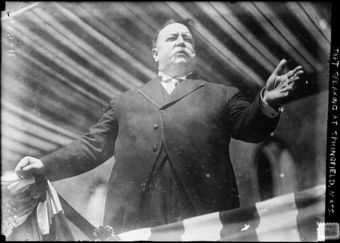
.President William Howard Taft introducing the Springfield Municipal Group in Springfield, Massachusetts.
Your introduction should immediately capture your audience’s attention and interest.
3.1.2: Body
The body of your speech is the point at which you go into full detail about each of your main points. The body is where you tell your story.
Learning Objective
Describe how to craft a strong body for a speech that entertains, informs, or argues a point
Key Points
- Organize your thoughts into a cohesive, logical flow of ideas.
- Each main point of your speech should support your speech’s purpose.
- Use a variety of examples to illustrate the main points of your speech, from research, facts and figures, to personal anecdotes and references.
- Don’t be afraid to let your personality come through; know your audience and tailor your approach accordingly. The body of your speech should be creative and engaging.
- Don’t stray too far from your outline; you will quickly lose your audience’s interest if you begin wandering off topic into points or anecdotes that don’t support your speech’s purpose or objective. You don’t want to appear disorganized or sound overly verbose.
Key Term
- brainstorming
-
A method of problem solving in which individuals or members of a group contribute ideas spontaneously.
Example
- Let’s say you have to write a speech on the rise of social media. Your professor wants you to argue a specific position about whether social media is beneficial or harmful to social interaction. After researching social media platforms, history, and applications, you decide to argue that social media is a beneficial tool. Your purpose is to persuade your audience that social media does more good than harm. You outline three main points: 1) that social media is popular and widespread; 2) that social media connects humans to one another faster than ever before; and 3) that social media often does social good. To illustrate your first point, you give a historical overview of the rise of social media while sharing facts, figures, and charts on social media’s growth and popularity. To explain your second point, you share anecdotes on how social media helped connect victims of natural disasters or crises to relief, aid, and real-time information. To support your third main point, you tell a personal story of how you contributed to a worthy charity after seeing a compelling viral video on Facebook promoting that charity’s efforts.
Your Speech Body: Deliver Your Main Points

Body of the Speech
Commander Naval Reserve Force Vice Adm. John G. Cotton is silhouetted in front of a Powerpoint slide, mapping out the Naval Reserve Force’s future.
Once you’ve captured the attention of your audience with an smashing introduction, it’s time to move into the meat-and-potatoes of your speech: the body. The body should take up about three-quarters of your entire speech time, since this is where you will go into detail about your main points.
Organize Your Content
Establish Your Purpose
Typically, there are three general reasons why you might be giving a speech: to entertain, to inform, or to argue a point. Each of these purposes requires a slightly different approach in order to successfully communicate its objectives to an audience. Once you’ve established your purpose, you can formulate a strategy for achieving that purpose with your main points. To illustrate each main point, you will need to use a series of examples.
Determine Your Main Points
Once you have your purpose established, it’s time to decide what main points you will use to achieve that purpose. You’ll want to start by brainstorming a list of all possible main points to support your purpose. Once you’ve completed this list, begin to assign them weights and priorities. Consider which points more effectively communicate your purpose than others. You may want to nest some points under others, thereby creating a natural hierarchy of main points and sub-points.
Equally important is determining exactly what does not belong in your speech or is irrelevant to your subject. Ultimately, you’ll want to boil down your main points to no more than three or four points. While this may seem minimalistic, know that your audience will only be able to remember so much, and you don’t want to overwhelm them with too much information. Three or four main points allow you to develop complete arguments in order to support your purpose, while still enabling your audience to follow your logic.
Decide How You Will Tell Your Story
You’ll want to have compelling evidence to support each main point of your speech. This evidence can be in the form of researched data, facts and figures, or even personal anecdotes and references. You may cite quotations and historical or current events to further bolster your arguments. Depending on your subject, audience and venue, humor may also be appropriate to weave throughout your speech.
If the purpose of your speech is to inform, you will rely heavily on data, statistics and research to illustrate your points. You may even use an accompanying presentation, video, chart, or images to help support your purpose.
If the purpose of your speech is to argue, you may find yourself using a combination of research and anecdotes to get your points across. You may also use accompanying media to illustrate your points; however, your data should be tailored to best argue your particular case. This is not to say that you should manipulate your data; rather, present only the information that your audience needs to see and hear to support whatever argument you are trying to make.
If the purpose of your speech is to entertain, you’ll rely more heavily on anecdotes than on hard research to get your points across. Humor is more than appropriate in this situation, but use it in moderation: you don’t want to jeopardize your credibility in front of your audience.
No matter the purpose or order of your main points, it’s important that you remember to stick to the outline of your speech. If you begin to wander off topic by sharing too many anecdotes, or presenting extraneous data, your audience may not be able to keep up and you will quickly begin to lose their interest.
Writing the Body
Once you’ve brainstormed and refined the main points of your speech, you can begin to write the body of your speech. The easiest strategy is to create an outline of your main points and list the supporting evidence you’ll provide for each main point. Depending on how comfortable you are with memorization, this may be all you need when you get up in front of your audience.
Many professional speakers do not rely on anything other than a brief outline of their speech, either memorizing what they plan to say in advance or simply speaking extemporaneously with only a basic guide. If this is one of your first speeches, and the situation allows, you may want to write your complete body word for word.
3.1.3: Conclusion
The conclusion of your speech summarizes your purpose and main points while leaving a lasting impression with your audience.
Learning Objective
Discuss the best practices for writing a strong conclusion for a speech
Key Points
- Use your conclusion as an opportunity to summarize the main points of your speech.
- Don’t repeat your main points word for word; rather, paraphrase the key themes and arguments you have just presented.
- Consider ending your speech with an additional anecdote or quotation that captures the theme of your speech.
- Don’t introduce any new points or supportive evidence into your conclusion as it will confuse your audience.
- Use trigger phrases such as “in conclusion” or “in summary” to prepare your audience for the end of your speech.
- Write your conclusion at the same time as the introduction (after you write the body) so that the introduction and conclusion complement one another.
Key Term
- summarize
-
To give a recapitulation of the salient facts; to recapitulate or review
Example
- On August 28, 1963, Dr. Martin Luther King, Jr. addressed hundreds of thousands of supporters in Washington D.C. about necessity of civil rights in America. Dr. King’s speech has often been recognized as one of the most memorable and important speeches of the twentieth century. What makes his speech so memorable is how he concluded it: “And when this happens, when we allow freedom to ring, when we let it ring from every village and every hamlet, from every state and every city, we will be able to speed up that day when all of God’s children, black men and white men, Jews and Gentiles, Protestants and Catholics, will be able to join hands and sing in the words of the old Negro spiritual: ‘Free at last! Free at last! Thank God Almighty, we are free at last! ‘” By using both a powerful call to action combined with the lyric of slave-era spiritual, Dr. King expressed his argument for civil rights with passion, emotion, and fervor.
Your Conclusion: Leave a Lasting Impression

Concluding Your Speech
The conclusion of your speech summarizes your main points and purpose while leaving a lasting impression on your audience.
If your body is the meat and potatoes of your speech, then the conclusion is the icing on the cake. Your conclusion is delivered at the end of the speech and is often what most people remember immediately after your speech has ended. As important as your introduction is for grabbing the audience’s attention, the conclusion is doubly important as it leaves the audience with a lasting impression.
Summarize Your Main Points
The purpose of the conclusion is to summarize your main points and to prepare the audience for the end of your speech. You’ll want to recapture the essence of your speech: your main points and the purpose of why you spoke. It is especially important to remember that the conclusion of your speech is not the time to introduce new points or new supporting evidence; doing so will only confuse the audience. Try to think of your conclusion like tying a bow or a ribbon: it’s the final touch that makes your project stand out.
Paraphrasing Versus Repeating
While summarizing your main points is important, be wary of simply repeating your main points word for word. You’ll want to paraphrase your main points rather than directly repeat them from your speech’s body. Paraphrasing allows you to capture the essence of your speech, unlike rote repetition of identical sentences you may have spoken just minutes earlier.
End on a High Note
Your conclusion is the last thing your audience hears from you. Just as an introduction can make or break a speech, you always want to end your speech on a high note with something memorable. The conclusion is where you’ll insert your take-away message: what do you want the audience to remember after you’ve finished speaking? What do you want them to recall in the days or weeks after your speech?
To create a memorable ending, you may want to share a quotation or anecdote. It’s important to remain relatable and credible to the audience up until your final word, so be sure to craft your conclusion in a way that is still appropriate to the topic, audience, and venue.
Writing Your Conclusion
Like the introduction, you’ll want to write your conclusion last. The introduction and conclusion of your speech serve as bookends to your speech’s body, so it only makes sense that you’ll want to craft them after you’ve written your body.
Review your speech’s body and ensure that you’ve touched upon all the main points you wish to discuss, then rephrase those main points in your conclusion. Determine the take-home message that you want to leave with your audience and either include it word for word in your conclusion or use it as a guiding theme for how you’ll end your speech. If you have any final anecdotes or quotations to share that either drive home a particular point or capture the theme of your speech, include it here.
While there is no set time or sentence limit for your conclusion, make sure you don’t finish your speech so suddenly that your audience is caught off guard when the speech ends. Using trigger phrases such as “in conclusion” or “in summary” signify to your audience that the speech is about to end and that they should pay special attention to your final thoughts.
3.1.4: Transitions
Transitions allow your speech to flow smoothly from one section or point to another.
Learning Objective
List the different types of transitions used in speeches
Key Points
- Transitions are used to show the linkage or connection between main points.
- Types of transitions include temporal, equality, causality, compare and contrast, and summary.
- After you determine the main points of your speech, order them logically and then determine how you will transition from one point to the next.
Key Terms
- segue
-
To make a smooth transition from one theme to another.
- transition
-
The process of change from one form, state, style, or place to another.
Transitions: Find the Right Flow of Ideas

Giving a Public Speech
Your speech should flow logically and smoothly from one point to the next.
As you craft your speech, you will need to transition from one point to the next to fully articulate your purpose or objectives. When read aloud, your speech should flow smoothly from introduction to body, from main point to main point and then finally into your conclusion. Transitions are essential in order to help your audience follow along your line of reasoning.
Types of Transitions
There are different types of transitions often used in speeches, including:
- Temporal- using words like before and after
- Equality-highlighting points of equal importance like in addition or moreover
- Causality- using words that show cause and effect
- Compare and Contrast- using words and phrases that compare one part of the speech to the next, like contrarily or on the other hand
- Introductions and summaries are also types of transitions to let listeners know what a person will be speaking about and offering a way to understand the important parts of a speech
The Art of the Segue
To move from one point and into the next, you’ll want to segue into your new point. Sometimes your points may share similar themes or concepts – order your points in such a way as to capitalize on those similarities. You can also use opposition to present opposing main points. If you have multiple pieces of supporting evidence, you may need to transition between examples so that your audience knows you are furthering a point with another example, anecdote or set of researched data.
However you decide to transition, you’ll want to use triggering keywords that let your audience know you’re moving on to a new point. Ordinal words like “next,” “second and “third” give your audience the heads up that you’re about to proceed in a new or continued direction of thought.
Writing Transitions
After you have identified your main points and outlined what evidence you’ll use to support them, begin to prioritize and sort your main points so they follow in the most logical order. From there, you’ll be able to pinpoint how you’ll want to transition your speech from one point to the next. Try to think of transitions as a way to connect the dots of your speech’s purpose.
3.2: Steps of Preparing a Speech
3.2.1: Choosing a Topic
When choosing your speech topic, brainstorm to generate many ideas, and distill those ideas to find your singular topic.
Learning Objective
Discuss different strategies for choosing a speech topic
Key Points
- Before you can begin writing your speech, you must first establish the main topic about which you plan to speak.
- Brainstorm early and often! You can try a variety of techniques to get your mental juices flowing, from clustering to free writing. Even just talking through your ideas with another person as a sounding board is a great way to get ideas.
- Once you start to get an idea of your topic, do a little preliminary research. See what others may have written or said about your general topic; reading their ideas may help give you some new ideas or directions of your own.
Key Terms
- topic
-
Subject; theme; a category or general area of interest.
- brainstorming
-
A method of problem solving in which individuals or members of a group contribute ideas spontaneously.
- distill
-
To extract the essence of; concentrate; purify.
Example
- Let’s say you need to write a speech related to the history of television. Using clustering as a brainstorming technique, write the word “television” in a central circle. From that, begin to write a few spokes shooting off from that main circle, such as “great moments in television history. ” From each of those spokes, add additional smaller spokes, such as “the moon landing,” “the rise of 24-hour news coverage cycle,” and “Star Trek: The Original Series shows the first interracial kiss” under your “great moments in television history” spoke. From there, begin to refine and hone your ideas. To guide how you want to build your argument, you may want to do a quick internet search to get a feel for what others have said about some of your final topic choices.
Choose Your Topic

Clustering
An example of an idea cluster for the subject “gardening.”
As you begin to prepare for any speech, it’s important to pin down exactly about what you plan to talk. You might have been given a specific topic by a professor or supervisor, or you may be simply invited to speak at an event where the topic is up to you. Knowing how to carefully select your topic is an important first step in preparing for a successful speech.
Start by thinking about your venue. Where will you be giving your speech? To whom will you be speaking? (We’ll get to analyzing your audience in the next section. ) Then, start to think about what you know about the topic, and move towards those subjects or tangents about which you don’t know. It’s helpful to speak about a topic with which you are already familiar, but sometimes you may be called into situations where you have no prior knowledge about a given subject.
In either instance, it’s helpful to approach your topic through brainstorming.
Brainstorming
One of the best ways to help solidify your speech topic is to brainstorm. You can brainstorm by yourself, or you might want to bring in a few friends, colleagues or classmates to help you come up with ideas in a group setting. You can brainstorm using a number of different exercises.
Word Association
Start with a broad topic idea. What words, topics, or other subjects do you associate with that first topic? Now what words, topics, or other subjects do you associate with the following word? Continue this chain of word association to give you a broad spectrum of ideas.
Clustering
Also known as mind-mapping, clustering gives your word association a visual form. Start with your main idea and draw a circle around it, thinking of it like the hub of a wheel. Now, begin to write other associated ideas, topics, or subcategories related to that main topic around the hub, and connect them as separate spokes. From each spoke, begin to jot down other associated ideas and thoughts. As your cluster begins to grow, you might want to connect smaller spokes to one another and create new links between subjects.
Freewriting
This is probably the simplest brainstorm method of all. Set a timer and begin writing whatever thoughts or ideas come to mind about your particular subject. You might find it easier to type your freewriting instead of writing it by hand, so you can keep up with your thoughts faster. Whatever you do, don’t stop writing.
Another way of freewriting is to record yourself talking for a set period of time and then transcribing your key points to go back to and clarify later. Once your time is up, go back and highlight or circle relevant points or topics that stick out for you. You’ll refine these later.
Distill Your Ideas into One Topic
Once you’ve brainstormed your many ideas, it’s time to refine your ideas and distill them into one topic. Look for themes, patterns, and commonalities when going through your brainstorming notes. Use these themes to help guide you toward a singular topic.
Do a Little Homework
While you will definitely research your topic, you might want to do some “presearch” – that is, a little research before the real research. Do a quick scan to see what others have said or written about your topic. This might give you even more ideas of how to refine and distill your topic, or more appropriately adapt it to your audience or venue.
3.2.2: Analyzing the Who, Why, and Where
Knowing and understanding your audience is one of the most important parts of developing an effective speech.
Learning Objective
Indicate the factors speakers should keep in mind when assessing their audience
Key Points
- Take into account the demographics of your audience: gender, age, industry, the event at which you’re speaking, common interests, culture and ethnicity, and how much they already may or may not know about your speech topic.
- Never stereotype your audience based on any of their demographics.
- Be mindful of gestures, colloquialisms, idioms, or other ethnocentric expressions (slang, mannerisms, etc. ) you might make during your speech. It’s important to recognize what is accepted in one culture may be offensive in another.
Key Terms
- ethnocentrism
-
The tendency to look at the world primarily from the perspective of one’s own culture.
- demographic
-
A demographic criterion: a characteristic used to classify people for statistical purposes, such as age, race, or gender.
- stereotype
-
A conventional, formulaic, and oversimplified conception, opinion, or image.
Example
- Remember, context is key. If you were speaking to a large audience composed mostly of men, you might think talking about pregnancy and women’s health would be inappropriate. But let’s assume that this audience is actually at an obstetrics conference, where these subjects would be more than appropriate. That’s why it’s imperative to do your homework about your audience.
Analyze Your Audience

Knowing the Audience
A speaker should consider the audience in order to craft an effective and successful speech.
Once you’ve established your topic, it’s time to focus on whom you’re speaking to. Next to identifying your topic, understanding your audience is one of the most important things you can do in preparing for your speech.
Understanding Your Demographics
Think about your audience: what do they look like? What might they have in common? What might you have in common with them? These are important things to consider as you begin to get a sense of just who will be sitting in front of you when you deliver your speech.
Consider the gender of your audience: male, female, or a mix? Are they older, younger? Would you consider them your peers? Have you met any of them before? Think about all the possible demographics of your audience including gender, age, national origin, ethnicity, culture, and occupation. But remember: just because you might be speaking to one group of people, that doesn’t mean you should stereotype that group. In fact, if you do end up stereotyping your audience, you’re more likely to lose them than engage them.
Also think about the knowledge that your audience brings to your presentation. They might be extremely well-versed in or they might not have the faintest idea about your topic. The more you can tailor your speech to your audience, the more effective and persuasive your speech will be.
Tempering Ethnocentrism
You should know that in any situation, you bring with you your own unique world-view and set of biases. You should especially be aware of your unique world-view and biases in your speech because they may negatively impact people of different cultures, ages, genders, etc.
The same goes for the use of gestures or mannerisms. Some everyday gestures may actually be offensive to other cultures. For example, at any Disney theme park, all the workers, when giving directions to tourists and visitors, always point with two fingers instead of one. Pointing a single finger in some cultures is considered extremely rude.
Some idioms and expressions that may seem natural and make sense to you may actually be quite confusing to people of different cultures or languages. Try to take a step back and consider the ethnocentric view you may be bringing to your audience and consider ways to minimize or temper those unique perspectives so as not to alienate your audience.
3.2.3: Topic Research: Gathering Materials and Evidence
In order to fully substantiate any claims you make in your speech, you must fully research those claims and provide supporting evidence.
Learning Objective
Discuss how to best research and gather supporting materials for a speech
Key Points
- Make sure you find credible sources of information, whether they be from scholarly sources that have been peer-reviewed, or irrefutable facts.
- There are many places you can go to research; while the internet might seem like the easiest place to find information, you always want to double check to make sure those sources are accurate and credible.
- Don’t use research that might be outdated, particularly with regard to scientific or technological advances.
- Make sure you acknowledge your sources. You may not directly reference them in your speech, but if questioned afterward, you’ll want to know from where you found your information.
- Never copy information word for word and claim it as your own; this is plagiarism and erodes the ethical integrity of you, your speech, and your reputation.
Key Term
- plagiarism
-
The act of plagiarizing: the copying of another person’s ideas, text or other creative work, and presenting it as one’s own, especially without permission.
Research and Gather Your Materials

Research
Make sure you research and gather enough evidence and supporting materials in order to talk about the topic
competently.
Now that you’ve figured out your topic and given some thought as to who will be your audience, it’s time to roll up your sleeves and begin the real work of preparing your speech. In this section, we’ll discuss how to best research and gather your materials and supporting evidence.
Finding Credible Sources
The first instinct for many people preparing a speech is to go out and find every piece of information they can, often via search engines online. While this is a great way to “presearch,” you’ll want to really pay attention to the sources from which you’re gathering your information. If you want to successfully substantiate any claim in your speech, you’ll need to make sure you back it up with information from credible sources.
Just What Makes a Source “Credible”?
Typically, hard, irrefutable facts make for a credible source. Fact: the Earth is anywhere from 36 to 63 million miles away from Mars, depending on orbital locations of either planet. But if you have a claim that could stray anywhere into the realm of opinion (such as, the existence of extraterrestrial life in the universe besides that on Earth), you’ll want to make sure you have credible sources to back up that claim.
Many times, you’ll want to turn to scholarly sources. Academic journals and publications (particularly if they have been peer-reviewed) make for excellent scholarly sources. Additionally, there’s no reason that you can’t approach an expert in the field that you are researching. In the latter instance, this is considered a primary source of information and can sometimes help point you in the right direction to find other credible sources of information.
When in doubt, ask your friendly librarian. They can often point you to online journal collections or academic search engines where you can find reliable, credible sources.
Keeping Your Research Organized
As you begin to assemble your research, it’s imperative to keep your notes centrally located and easily accessible. You might want to create a binder to keep all of your papers and notes together, or dedicate a multi-sectioned notebook to your research. You might take notes on notecards, organizing them by color or heading. If you take your notes online, you can use cloud computing to store your research remotely to access them anywhere on the go. Other software exists to keep your notes files and organized electronically on your computer.
Always keep records of where you got your information. You’ll need this in case someone ever decides to question you about your facts after your speech. Also, this shows people that, yes, you’ve done your homework. Additionally, you should never copy any information word for word and claim it as your own. Plagiarism will only damage your reputation and the credibility and ethics of your speech in addition to potentially causing you to fail a class, lose your job, or worse.
However you organize your notes, just make sure you have them organized and handy. You never know when you might run into a primary source!
3.2.4: Developing Your Thesis
All speeches must have a point or a main argument – a thesis.
Learning Objective
Illustrate the best approach for developing a thesis for a speech
Key Points
- The main argument of your speech is your thesis statement: what case are you trying to make?
- If you are arguing for or against a certain idea, belief or topic, you must provide compelling evidence to support your position.
- When crafting your thesis statement, consider potential arguments, questions, or concerns someone with an opposing viewpoint may have. This process helps you develop a more robust thesis.
Key Terms
- thesis statement
-
A thesis statement summarizes a speech’s argument in one to three sentences.
- rebut
-
To deny the truth of something, especially by presenting arguments that disprove it.
Example
- Imagine you were writing a speech arguing which came first: the chicken or the egg? You take the position that the egg came first as your thesis statement. You would need to make a compelling to explain exactly why you believe the egg came first: perhaps you have data, statistics or other research to back up your claims. As invested as you might be in your thesis, don’t forget to consider the opposition. A “chicken first” believer would argue that it would be impossible for an egg to have come first, because it could not have gotten there without the chicken. Be prepared to rebut the other side.
Developing Your Thesis

Thesis
A painting depicting a lecture in a knight academy in the 1620s.
In some circumstances, you will most likely be arguing some kind of point or message in your speech. The main argument of your speech – the main point you want your audience to understand – is the thesis of your speech.
The Thesis Statement
In any opinion piece, written or spoken, the main argument – the thesis statement – comes at the beginning. You want your audience to know right away the point you are trying to make. It is important to remember that your thesis statement only addresses one main issue; the ways in which you choose to support your thesis add complexity and depth to your speech.
Arriving at Your Thesis
When composing your thesis statement, consider and answer the following questions:
- How do you feel about your topic?
- How does your audience generally feel about your topic?
- What do you want your audience to feel or believe about your topic?
- What other opinions have been said/written about your topic?
- Are you arguing for or against your topic?
- What social issues factor into your topic?
- What is your topic’s influence on the individual, a particular community or society as a whole?
As you begin to answer these questions, start thinking about ways you want to support your thesis with compelling, persuasive examples.
Playing Devil’s Advocate
No matter how you choose to argue your point, it is important to take a step back and play devil’s advocate; that is, take a look at your argument from that of the opposing viewpoint. By considering all sides of your argument, you will bolster your case by preparing for all possible objections and rebuttals to the claims you intend to make in your speech.
3.2.5: Supporting Your Ideas
Use a variety of ways to support the ideas and claims that you make with your thesis statement to give your speech depth and dynamics.
Learning Objective
Explain how to use ideas and examples to back up claims in a speech
Key Points
- Set the stage for how you plan to address your argument and make your case by laying out the exposition of your argument.
- Appeal to your audience’s core beliefs, goals or common interests to influence your audience by persuasion.
- If you are speaking to a sympathetic crowd, consider influencing your audience by suggestion or popular sentiment on your given topic.
- Use personal narratives and anecdotes to make your case if appropriate to your audience, topic, and speech venue.
- If your idea is complex, consider breaking it down into simpler parts to more thoroughly and easily describe your idea. Help your audience to visualize your points by articulately describing them.
Key Terms
- exposition
-
The act of declaring or describing something through either speech or writing.
- anecdote
-
An account or story which supports an argument, but which is not supported by scientific or statistical analysis.
Example
- Let’s say you have to give a speech about civil rights in America and how your audience must take active roles in protecting their own civil rights as well as the rights of others. You might begin by laying out a foundational overview of the historical timeline of civil rights since America’s independence in 1776. Persuade your audience by sharing compelling examples of how civil rights have been violated across many groups: gender, race, religion. These broad appeals are sure to resonate with many different members of your audience. You may also provide examples that all get back to your same idea: infringing upon any civil rights by any group to any group is wrong. You might share how a relative was involved in the Mississippi riots in the 1960s or how your mother was involved in the Women’s Liberation movement in the 1970s. Finally, walk the audience through the basic principles of your argument about how the infringement of civil rights for one group can ultimately lead to the infringement of civil rights for all.
Supporting Your Ideas

Preparing Supporting Ideas and Materials
It’s important to select the right evidence and supporting materials to help you establish the main points in your speech.
Once you have solidified your position in your thesis statement, you want to back up your thesis with a variety of supporting ideas and examples. To do this, there are several ways you can support your claims while adding variety and interest to the overall story of your speech.
Set the Stage
Using exposition is a great way to get your audience all on the same playing field. When you use an expository approach, you’re carefully laying out all of the background information your audience needs to know in order to understand your point.
Appeal to Commonalities
As you notice commonalties between audience members, the audience and your topic, and you and your audience, appeal to those commonalities to not only establish rapport but also to more easily persuade them to your thesis and claims. Your audience is more likely to trust and believe you if they feel they share something in common with you and your topic.
Finding a Consensus
Your audience may already feel a certain way about your topic. Depending on what you’re trying to argue, you may want to go ahead and appeal to that consensus. Just be careful: you don’t want to bore your audience by “preaching to the choir. “
Tell a Story
One of the best ways to back up your claims–besides cold, hard, facts and data–is to share a personal story or anecdote. This shows your audience that you really connect to your subject, making you more believable and personable. Using anecdotes are a perfect opportunity to lighten the mood and add some humor as appropriate to your speech.
Deconstruct Your Topic
You might have a particularly complex subject or thesis. In these instances, it’s helpful to break it down into its simplest parts. By breaking your information down into bite-sized chunks, your audience may have an easier time of following your train of thought or logic.
3.2.6: Organizing and Outlining the Speech
Arrange your speech – your thesis, additional points, and supporting evidence – in a way that will make sense to your audience.
Learning Objective
Discuss best practices for organizing notes and research into one speech
Key Points
- To organize your thoughts, consider giving each point or supporting evidence its own note card. Begin to arrange them according to importance and your main points will begin to emerge.
- Outlines typically begin with your thesis and end with any concluding thoughts.
- Depending on your topic or thesis, arranging your points chronologically is an effective way to establish a timeline of your argument.
- If giving an informational speech, you might describe your subject as parts of an object, outlining each part or section.
- You can move from broad points to specific points, or vice versa, depending on the effect you are trying to achieve and the argument you are trying to make.
Key Terms
- thesis
-
A concise summary of the argument or main points, usually one to three sentences long.
- chronological
-
In order of time from the earliest to the latest
Example
- When giving a speech on the history of television, you might organize your points chronologically by starting with the invention of motion pictures, to the invention of the television, through to modern internet streaming video today.
Organizing and Outlining Your Speech
Now that you have decided on your topic, analyzed your audience, arrived at your thesis, and determined how you will support your claims, it is time to organize your notes and research into one coherent speech.
You did keep all of your notes centrally collected and easily accessible, right? If you put all of your research notes and thoughts onto notecards, it is particularly helpful to lay them out in front of you and begin to organize your points and sub-points in ways that make the most logical sense.

Organizing Your Ideas
It’s important to develop an outline and clearly explain your ideas.
What are some ways to establish logical order?
Establish a Timeline
Depending on your subject and the point you are attempting to make, it might make sense to order your research and points in chronological order. If you are giving a speech on the rise and fall of the Roman Empire, it makes sense to start with its rise, and end with its fall. Outlining your speech as a series of chronological events or points allows your audience to follow along a linear timeline for easy understanding of your subject matter.
Your Thesis as the Sum of Its Parts
Think of your thesis like a machine. Each claim is another cog, each example or supporting evidence another lever in that machine, all working together to arrive at the same persuasive conclusion. Sometimes it is helpful to break up your thesis into each of these smaller parts, to make the information more easily digestible for your audience.
The Broad and the Specific
Building on the idea of your thesis as machine, you may present your overall, broad idea, then break it down into smaller, logical steps to reach that big idea. Conversely, you may start with smaller ideas and expand into the bigger, broader idea. When constructing your arguments from smaller ideas, you are more likely to drive your point home with a broad, sweeping finish. On the other hand, you can dilute the complexity of a broad idea by breaking it down into smaller, logical pieces of information.
A Sample Outline
Here is a sample outline about issues of feminism in William Shakespeare’s Hamlet:
I. Introduction and Thesis: Brief description of issues that arise when reading “Hamlet”
II. Issues of feminism uncovered through reading “Hamlet”
a. What other scholars have discovered about feminism in “Hamlet”
b. Which of these discoveries was most evident
c. Ideas of feminism I uncovered on my own
III. How uncovering ideas of feminism in “Hamlet” has led me to better understand what Shakespeare thought of the role women played in society
IV. Conclusion
3.2.7: Wording the Speech
A good speech is not written in one sitting; write multiple drafts, then review and edit before settling on a final text.
Learning Objective
Discuss tips and tricks for drafting a speech
Key Points
- Use the ABC approach to begin your first draft. The Abstract explains your thesis. The Body features your main points and supporting evidence. The Conclusion contains your final thoughts and reiterates your point.
- Make sure to have all of your notes and research close by and easily accessible so you can turn to your sources as often as you need to while your draft your speech.
- Editing and revising are not the same thing. To edit, review your speech for changes. To revise, actually implement those changes. Editing and revising are cyclical in nature as you continue to hone your draft.
- If on your first draft you find yourself going off on a tangent, allow yourself to follow it. You can always edit, revise and remove sections later that are wordy or off-topic.
- Writer’s block can happen to even the best writers. Take a break for a few minutes and come back to your speech renewed and refreshed. But don’t stay away too long or you might lose your momentum.
Key Terms
- writer’s block
-
The inability to begin or continue work on a piece of writing; normally temporary.
- eloquence
-
The quality of artistry and persuasiveness in speech or writing.
- abstract
-
Difficult to understand; abstruse.
Find the Right Wording for Your Speech

Drafting Your Speech
Handwritten speech notes by President Ronald Reagan
The art of public speaking comes from the eloquence of the speaker. While researching your subject and outlining your speech may seem like the most time-consuming aspect of preparation, taking the time to write your speech can actually take the most time to complete.
Writing Your First Draft
When you begin writing your speech, don’t assume what you write now will be the final version of your speech. A draft is simply your first pass at what you plan to say. Using your outline as a guide, refer to your organized research notes (that you’ve centrally collected and have easily accessible for just such an occasion, right? ) to begin to flesh out your speech.
It is helpful to take an ABC approach to writing your speech. Introduce your subject and thesis in an Abstract, or introduction, section. This abstract gives a general summary about what you plan to speak. Then write your Body, where you will make and substantiate claims to support and argue your thesis. Finally, write your Conclusion, tying it all together in one memorable finish.
You may find that you start to veer off-topic as you begin to write your speech. You will have time to go back and prune later; for now, the focus is to keep writing.
Refine, Refine, Refine: Editing and Revising
Now that you have written the first draft, reread what you have written to refine your wording.
Editing
Read through your first draft. Look for typos such as spelling and grammatical errors. Also look for awkward phrasing or parts of speech. Read sections aloud: do they make sense? If so, reword those sections.
Consider the vocabulary you are using: Is it appropriate? Are you potentially using language that may go over your audience’s heads, or perhaps is too elementary? Consider your tone, style and verbiage. Also consider the structure of your argument: does your speech actually make sense?
It is helpful to give your first draft to another person to review and edit, as it helps to have a fresh set of eyes look at your material.
Revising
Once edits have been made, implement those suggestions and changes to your draft. When you begin revising, you may find that you are making more changes along the way and may write multiple drafts. The editing and revising process becomes a cycle of newer drafts. Eventually, the revisions will be done and you will have settled on your final draft.
Dealing with Writer’s Block
Have you ever sat down in front of your computer, a blank document open, the cursor just blinking at you…and no words come to your brain? Don’t panic! It is a harrowing moment for any writer, but don’t be alarmed: writer’s block is perfectly natural and there are ways to overcome it.
Some tackle writer’s block by forcing themselves to write anything, as long as they keep writing. You can set a timer and commit to keep writing without stopping until that timer ends. Hopefully, that will be enough of a boost to get your writer’s juices flowing.
If not, walk away from your speech for a little while. Sometimes it is good to clear your mind from a subject in which you are thoroughly engrossed in order to gain a fresh perspective.
When in doubt, two heads are better than one. Call up a friend, colleague, or classmate and share ideas with them. They just might have the inspiration and outside perspective you need to get your hands flying across your keyboard in no time.
3.2.8: Preparing to Present
Practice makes perfect!
Learning Objective
Discuss the different methods for preparing for and presenting a speech
Key Points
- Determine how you will present your speech: will you read it verbatim, memorize it, or read from an outline of notes?
- Reading verbatim has both its positives and negatives. On the plus side, you’ll have your entire speech written out in front of you; however, these types of speeches tend to feel a bit stilted to audience members.
- Memorizing your speech can seem like a weighty task, but it allows you to retain all of your key points and wording while still appearing natural and effortless to your audience. It frees you from having to read right off of a manuscript.
- When speaking extemporaneously, you can have a rough outline of your notes. You might have this on a single sheet or perhaps across several notecards. In either case, these serve as reminders about your topic, your points and in what order they should be shared.
- If you’re nervous about presenting in front of a group of people for the first time, work out your nerves by asking a small group of friends or colleagues to be your test audience. Your test audience can give you immediate feedback on what you did well and how you could improve.
- Ever wonder what you look like while giving a speech? Practice in front of a mirror, or better yet: record yourself. You’ll be able to see if you have any unconscious gestures or habits that you can correct or prevent as you feel them happening.
Key Terms
- extemporaneous
-
A type of speech delivery which involves preparation of speaker notes prior to delivery, associated with conversational style of delivery.
- verbatim
-
A word-for-word report of a speech.
Example
- There’s a famous old joke: how do you get to Carnegie Hall? Practice! There’s a lot of truth to be found in that old adage. The more you can give your time to practice and rehearse your speech, the more comfortable you’ll be. You might feel nervous for your first few speeches but over time and with experience, those nerves will fade. That said, you don’t want to rehearse so much that your speech feels robotic or rote. You should appear natural and comfortable in front of your audience, whether it’s your first speech or your fiftieth.
Prepare to Present

Practicing Your Speech
Take the time you need to rehearse and prepare your speech before getting up in front of your audience.
You’ve written your speech: congrats! Now it’s time to work on just how you plan to present your speech and prepare it accordingly. First, decide how you’ll present your speech: will you read your newly minted speech verbatim from script? Or will you memorize it? Or will you simple read off an outline or notes?
Reading Your Speech Word for Word
For your first speech, it might be helpful to have it completely typed up and ready for you to read verbatim in front of a crowd. You may feel more confident having your exact wording in place assembled right there in front of you.
Reading verbatim from a script has its drawbacks; you may be limited in how much eye contact you can engage in with your audience. As such, your audience may more quickly disconnect from your words and you as speaker. Additionally, speeches read straight from a script or manuscript often feel stodgy and stilted, which is a sure way to bore your audience and lose their attention fast.
Memorizing Your Speech
You can memorize your speech in the same way that you might memorize lines or a monologue for a theatrical play. By freeing yourself from reading off a sheet or many sheets of paper, you lose some of the rigidity that comes with reading a speech off a script. There’s less for your hands to fumble with, allowing you to take a more open body position as you deliver your speech, making you more engaging with your audience.
However, one of the biggest disadvantages to memorizing a speech can be unexpected stage fright where you might clam up entirely, unable to remember your speech. It never hurts to have a copy of your speech on hand when you plan on memorizing your speech.
Speaking Extemporaneously from Notes
The middle ground between reading from script and memorizing your speech is to read from notes. By preparing an outline or a few note cards with keys points in the order you plan to present them, you have the freedom to have open body posture with a safety net of reference. Speaking from notes sometimes involves keeping your hands busy holding the notes and it does draw your eye contact periodically away from the audience. The tradeoff is worthwhile because it allows you to have an engaging stance combined with an outline of your speech.
Dealing with Nerves
It’s completely normal to be nervous about giving your first speech in front of a large group of people. Even world leaders get butterflies in their stomach before addressing the world stage. To help combat your fears, just remember: if you flub your speech it’s probably not going to kill you, so why stress?
You can also ease your fears by taking the time to practice frequently. Read your speech out loud so you begin to develop muscle memory around your phrases and sentences. You can even read your speech in front of trusted friends or colleagues. By practicing in front of a smaller group, you can take the edge off having to present in front of a larger group. Additionally, having your friends as the test audience will give them an opportunity to provide you with valuable feedback about what you’re doing well and where you need to improve.
If you’re not sure what you look like while speaking, practice in front of a mirror. Better yet, record yourself and play back the recording a few times to yourself. Watching yourself speak is another great way to help calm your nerves and break the tension while discovering subtle facial movements or body language that might actually hurt your speech.
3.2.9: Delivering the Speech
Details like how you dress, enunciate, and use body language can be just as important as what you say.
Learning Objective
Give examples of tactics speakers can use to deliver a speech effectively
Key Points
- Make sure you dress to impress. While some speeches may be delivered in a casual setting, you want to make sure you’re wearing clothing appropriate to the dress code of your event.
- Be aware of your body language. A closed body position (arms crossed, shoulders hunched) and lack of eye contact will make it extremely difficult for your audience to engage with you.
- Engage your audience by making eye contact with them. If making eye contact wigs you out, you can always look just above their heads to give the same effect.
- Stand up straight, remember to breathe, and limit your “um”s, “uh”s, and “like”s. Use whole phrases like “should have” instead of “shoulda. ” Avoid slang or profanity.
- Have a backup plan in case equipment fails for things such as visual aids, PowerPoint presentations, or teleprompters.
Key Term
- body language
-
Body language is a form of mental and physical ability of human non-verbal communication. It consists of body posture, gestures, facial expressions, and eye movements. Humans send and interpret such signals almost entirely subconsciously.
Delivering Your Speech

Delivering a Speech
A woman delivers a speech at a TEDx event.
The big day has arrived: it’s time to present your speech! Besides remaining calm and speaking clearly and at a loud enough volume, here are the most important things to consider as you present your speech.
Dress to Impress
The way you look as you give your speech is almost as important as the words coming out of your mouth. It’s imperative to know the dress code for the event at which you’re speaking. If you’re the best man at your best friend’s wedding, you will probably be wearing a tux. Unless of course it’s a beach wedding, when flip flops and shorts could be totally appropriate.
In a business setting, men should wear a button-down shirt and dress pants and shoes; depending on how formal the business setting, this may also include a suit jacket and tie. Women should wear a dress, dress pants or skirt with a button-down top, blazer, blouse or nice sweater. Shoes can be heels or flats and should be appropriate to your setting.
For men and women, it’s also helpful to consider how long your speech is and if you’re expected to stand for the duration of your speech when determining appropriate yet comfortable footwear.
Watch Your Body Language
In the same vein that how you look is almost as important as what you say, how you stand can be just as important as your words. Humans pick up subtle cues with regard to emotion through non-verbal communications in body language. When delivering your speech, you want to make sure you have a confident, open stance to convey your confidence. Standing hunched over or with your arms crossed will close off your body to your audience, thereby shutting them out.
Similarly, make eye contact with your audience. Sometimes this makes speakers nervous, but it’s an important technique to really connect with your audience. If the idea of making direct contact makes you uncomfortable, you can always scan your view around the room looking just above your audience’s heads; it achieves the same connective effect.
Finally, if you can move around, do. It builds visual interest for your audience and also helps you to work out jitters if you have them. You might be confined behind a podium or lectern, in which case your largest range of motion may be restricted to hand gestures and your gaze around the room. If you can walk out from behind a podium and across a stage, take the opportunity. Just don’t wander, watch where you step, and try not to make your audience motion sick by walking back and forth too much.
Articulate and Enunciate
Speak your words clearly. Don’t rush your sentences or let the ends of your sentences drop in volume. You’ve worked this hard to write and prepare your speech–you want to make sure your audience understands what you have to say.
Avoid saying “um”, “uh”, or “like” (when it doesn’t belong in a sentence). These are usually nervous habits that take time to break. If you feel an “um” coming on, simply pause for a brief moment before moving past it. Additionally, don’t be afraid of silence when you’re making a dramatic or compelling point. And sometimes, be prepared for your audience to interrupt you with clapping or laughing. You might need to stop a sentence to let the audience do its thing while you resume as it dies down.
Have a Backup Plan
If you have supplementary materials such as visual aids or a PowerPoint presentation, have a backup plan in place in case some piece of equipment doesn’t work. You may want to have printouts just in case a computer or projector doesn’t work.
Similarly, if you’ve memorized your speech or may be reading from a teleprompter, have a printed copy of your speech or an outline of your speech on hand just in case you get a case of stage fright or equipment fails.
One More Thing
Before you walk off that stage or sit back down in your seat, always thank your audience.
Chapter 2: Public Speaking Ethics
2.1: Significance of Ethics in Public Speaking
2.1.1: The Importance of Studying Ethics
It is important to practice ethical behavior in your speeches, as it helps to establish trust with your audience.
Learning Objective
List the qualities of an ethical speaker
Key Points
- To speak ethically is to provide honest facts with integrity and without deception or distortion.
- Ethical speakers craft their own original content that is free from plagiarized content.
- Ethical speakers do not intentionally deceive their audiences, either by presenting falsehoods, or opinions disguised as fact; or by warping the facts to make their points.
- Ethical speakers acknowledge any conflicts of interest they may have with regard to topic, intent, venue, sponsoring organization or audience members.
Key Terms
- conflict of interest
-
A situation in which someone in a position of trust, such as a lawyer, politician, or director of a corporation, has competing professional or personal interests.
- ethics
-
The study of principles relating to right and wrong conduct.
Example
- On the NPR radio show, “On Point with Tom Ashbrook,” the host often brings in political analysts to discuss national political issues. Occasionally, his guests may disclose the fact that they work with sponsors of that radio show. By disclosing this mutually beneficial relationship between the radio show and the guest, both the show and guest demonstrate an ethical behavior.
Why Study Ethics?

Ethics
American philosopher Thomas Nagel teaching an undergraduate course in ethics at New York University.
What is Ethics?
When you think of ethics, what comes to mind? Perhaps you think of words and phrases such as ethical behavior, professional ethics, ethics boards, or code of ethics. At its heart, ethics refers to the concept of having morally acceptable values and behaviors. When you align your behaviors and actions with these values, you engage in ethical behavior.
Ethical Behavior in Public Speaking
Why would you need to even consider ethics in public speaking? First and foremost, your audience not only needs to believe in your words and message, but they need to trust you as the message giver. To engage in unethical behavior when speaking only erodes that trust.
There are other reasons to engage in ethical behavior in public speaking:
- To maintain your credibility and reputation.
- To present a fair and accurate argument of your thesis.
- To provide honest facts with integrity and without deception or distortion.
- To abide by shared or common moral values and beliefs.
To speak ethically is to use your own original speech content. If you use any substantiating facts or passages from another, you must give appropriate attribution or credit as necessary. Ethical speakers are ones who do not plagiarize their material or try to pass off words and ideas from others as their own.
Ethical speakers do not deceive their audience. It can also be stated that ethical speakers do not distort or warp facts, or worse yet, disguise opinions as fact in order to argue their thesis or make their point.
Acknowledging and responding to conflicts of interest is also regarded as ethical public speaking behavior. There may be times where you may be asked to speak on behalf of a certain topic in which you have a professional interest or may benefit from financially. In those instances, the ethical speaker will either excuse him or herself from speaking. If unable to do so, he or she may simply disclose the nature of the conflict of interest so that everyone is on the same page.
The study of ethics, then, is incredibly important to any student of public speaking, as the most effective public speakers are those who practice ethical behavior in their speeches.
2.1.2: Rules to Follow When Speaking
Effective speakers engage in ethical goals, fully prepare their speeches, practice honesty and avoid abusive language.
Learning Objective
State the basic rules of crafting and delivering a speech
Key Points
- If you recognize that you might have a conflict of interest when delivering your speech, recuse yourself or disclose to your audience the extent of the conflict.
- Respect your audience by fully preparing for your speech, from writing and editing to reviewing and rehearsing. Be thorough in your preparation.
- Don’t make your case via falsehoods or opinions disguised as facts. Come from a place of authenticity.
- Don’t intimidate your audience or opponent (if debating) by verbally attacking them or using abusive language.
- Choose either the persuasive or informative presentation style for each speech based on presentation goals and audience type.
Key Terms
- conflict of interest
-
A situation in which someone in a position of trust, such as a lawyer, insurance adjuster, or corporate executive, has competing professional or personal interests.
- ethical
-
Of or relating to the accepted principles of right and wrong, especially those of some organization or profession.
- recuse
-
to declare oneself disqualified to act.
- informative
-
An informative presentation enhances the knowledge or understanding of the material you present,be it information, concepts, or ideas. The presenter assumes the role of a teacher.
- persuasive
-
A persuasive presentation has a clear beginning, middle, and end; uses interesting supporting material; and changes or reinforce listeners’ feelings, ideas, or behavior.
Rules to Follow When Speaking

Rules for Public Speakers
Effective speakers engage in ethical goals, fully prepare their speeches and materials, practice honesty, and don’t use abusive language when speaking.
As a public speaker, it’s important to follow some basic rules as you approach the crafting and delivery of your speech. These rules include ethical goals, full preparation, honesty, and non-abusive language.
Ethical Goals
Consider why you’re speaking. Are you trying to persuade your audience to adopt a certain viewpoint or consider a new idea? If so, you’ll want to make sure that you lead your audience to that belief point in an ethical manner. You don’t want to use tactics like intimidation. Additionally, have the responsibility and professionalism to know whether or not you have a conflict of interest on a given topic or with a certain audience or venue. Recuse yourself–provide your audience with a full disclosure of said conflict of interest, and adjust your speech accordingly.
Full Preparation
Effective speakers are those who take the time to fully prepare their speeches, from the speech writing process to the delivery of the speech to the very clothes they wear for the speech. If you don’t prepare, it will show and ultimately affect your credibility as a speaker to your audience and colleagues. Respect your audience by taking thorough time to write, edit, review and rehearse your speech before presenting.
Honesty
Honesty is an extension of the ethical goals of your speech. Don’t resort to falsehoods or opinions presented as facts to make your case. Come from a place of authenticity instead of deception. Your credibility can become damaged when it is revealed you have either lied or even just slightly bent the truth in your speeches.
Non-Abusive Language
Just as one shouldn’t intimidate his or her audience, one should refrain from abusive language when speaking in public. This means attacking your audience verbally, or, in a debate-style setting, even verbally attacking your opponent. Don’t resort to name-calling or bullying; rather, make your case through the use of compelling facts and anecdotes that can be substantiated.
2.1.3: Rules to Follow When Listening
Develop a practice of active listening to be an effective listener.
Learning Objective
Discuss the qualities of an active listener
Key Points
- Presenters deserve your attention, courtesy, and open-mindedness if you are to expect the same of others once you get up to present.
- Be courteous by silencing your cell phone or other gadgets, refraining from extraneous noise, and looking at the presenter while they speak. If you’re taking notes, make sure you’re doing so in an unobtrusive way.
- Have an open mind about what material is presented to you. You may not agree, but the presenter still deserves your attention and courtesy.
Key Terms
- open-minded
-
Willing to consider new and different ideas or opinions.
- active listening
-
The process of attending carefully to what a speaker is saying, involving such techniques as accurately paraphrasing the speaker’s remarks.
Rules to Follow When Listening
You may not always be the speech presenter or speaker. Many times, you’ll be in the audience yourself. Active listening is a skill that can make you a more effective speaker in the long run.

Active Listening
The art of active listening is more than just hearing what the speaker has to say: it’s about being an engaged, attentive listener able to paraphrase what has already been said.
Courtesy
Being an active listener not only makes you a more engaged audience member but, quite simply, it’s polite. If you expect people to pay attention to your words when it’s your turn to speak, they expect the same from you. There are a number of other courteous behaviors that an active listener should practice:
- Look at the presenter.
- Do not text or chat on your phone while they speak.
- Remain quiet.
- If taking notes, either on paper or via a laptop or tablet, do so unobtrusively.
Attention
Active listening refers to the practice of not just hearing someone, but really listening and paying attention to what they have to say. Intrinsic to active listening is the ability to feed back what has been said to the speaker, often in the form of paraphrasing. As an audience member, you might not have the opportunity to actually verbalize these feedback in the moment; however, a true active listener is able to summarize at the completion of the speech.
Open-Mindedness
You may not necessarily agree with everything that is being said. It’s important to come to the presentation with an open mind—that is, to at least listen with respect and courtesy to ideas that may be in conflict with your own personal beliefs and values. Again, if you expect others to be open and receptive to your ideas, you must extend that same courtesy to others.
2.2: Plagiarism
2.2.1: Plagiarism
Plagiarism involves the taking of someone else’s words or ideas and trying to attribute them as your own.
Learning Objective
Describe the different forms of plagiarism
Key Points
- Word to the wise: just don’t plagiarize. Seriously. Don’t do it.
- Intentional plagiarism isn’t as easy to get away with as you think: institutions and companies have ways of detecting whether or not you’ve plagiarized your work, and it can have serious academic and professional repercussions if you are caught.
- If you find yourself tempted to nab a couple of lines from one of your research sources, put the full source away. Instead, rely on your own notes and paraphrasing to lessen the temptation to outright copy the work of another.
Key Term
- plagiarism
-
The act of copying another person’s ideas, text, or other creative work, and presenting it as one’s own, especially without permission.
What is Plagiarism?

Plagiarism
Plagiarism is stealing, plain and simple.
When most students think of plagiarism, they may think of outright copying another’s works. However, plagiarism can delve into murky territory that includes everything from wrongful appropriation to blatant thievery. While plagiarism may not be a crime per se, in many academic and professional contexts, plagiarism carries with it serious risks, including expulsion and/or termination from a position, organization, or company.
In its simplest form, plagiarism occurs when someone takes the words or ideas of someone else and attempts to present them as their own. Appropriating a person’s work without proper credit is what distinguishes plagiarism from mere citation or quotation. When a writer quotes or cites a person, text, image or other piece of intellectual property, the writer must give credit to where or from whom the quote or idea originated.
The “ideas” part of plagiarism can be especially tricky. Though unlikely, two completely different people may produce the exact same idea at the exact same moment. Inevitably, one person would be guilty of plagiarism. And while this does happen, the instances are few and far between.
Deliberate plagiarism should be avoided in academic and professional settings. To knowingly take the work of others and attribute it as one’s own is widely regarded as unethical, unprofessional, and illegal across most industries and organizations. Many academic and professional services can detect whether entire sections of books, articles and other works are published elsewhere, particularly on the World Wide Web. Additionally, if a writer has a unique writing style and author’s voice, it can be even easier to identify plagiarism if the content is cut and pasted into a work with a completely different tone and style.
However, unintended plagiarism is more common that one might think. Sometimes the problem stems from working too closely with source material. To avoid unintended plagiarism, writers often develop new content with the aid of notes, as opposed to whole sources such as books, articles, or web pages. Writers also craft original compositions by working off their own notes and paraphrasing.
2.2.2: Avoiding Plagiarism When Using the Internet
In the age of the Internet and social media, it can be both very easy and very tempting to plagiarize. In short: don’t.
Learning Objective
State why plagiarism can be easily detected online
Key Points
- Just because you can copy and paste a few sentences or paragraphs from an obscure Internet source doesn’t mean you should.
- Many academic institutions and even some professional organizations use online plagiarism detection software, such as CopyScape, Attributor and PlagiarismDetect.
- Just because you might thwart an online plagiarism detector doesn’t mean you don’t run the risk of being caught via manual plagiarism detection, either.
- When in doubt, avoid the temptation to plagiarize despite the seemingly endless availability of content online. Your speech is better served when your words are original and genuine.
Key Term
- plagiarism
-
The act of plagiarizing: the copying of another person’s ideas, text or other creative work, and presenting it as one’s own, especially without permission.
In Haste? Don’t Copy and Paste.
When pressed for time with a looming deadline, you might think a quick copy and paste of a few sentences here or maybe a paragraph there might be an easy solution. While it certainly is easy to Control+C, Control+V your way through a speech, it’s certainly not wise.
It might be tempting to fire up your browser and pick a relevant source buried deep within the search results. “Who looks all the way at what’s on search page 10? ” you may be thinking. Just because it’s obscure doesn’t mean it’s okay to take it and claim it as your own.
If you get caught, you could face serious academic or professional consequences. Plus—on a very plain note—it’s just not cool. It’s just bad intellectual form. In the age of the Internet, as easy as it can be to just lift something from a relevant but obscure source via Google, it’s equally as easy to get caught plagiarizing the words of others.
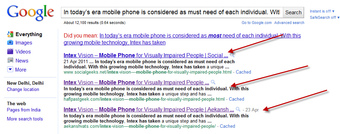
Avoiding Plagiarism on the Internet
As tempting as it might be to plagiarize with the vastness of available sources on the Internet – don’t do it.
Yes. Yes, You Will Get Caught.
With the advent of complex, proprietary search engine algorithms has come another niche market: plagiarism detection. If you think you can get away with just borrowing a sentence here or there, beware: sites like CopyScape and Plagiarism.org’s software can be used by academics and professionals alike, running your work through their programs to see if anything comes up with a red flag.
And if you think you can fool plagiarism detection software, don’t count out manual checking, either. You might pull a sentence or idea from an obscure professional or expert in the field, but keep in mind that your professor is an expert in this field; he or she is likely to have read whatever you’re copying.
When in doubt, avoid the temptation to plagiarize despite the seemingly endless availability of content online. Your speech is better served when your words are original and genuine.
Chapter 1: Introduction to Public Speaking
1.1: Learning How to Speak Publicly
1.1.1: Learning How to Speak Publicly
There are a variety of traditional and nontraditional avenues available for you to learn about public speaking.
Learning Objective
Find ways to improve your public speaking skills.
Key Points
- You can learn about public speaking through organized learning opportunities, such as classes and organizations like Toastmasters International.
- If you prefer to learn at your own pace, you can read books about public speaking. Many are available at little or no cost.
- If you prefer one-on-one guided learning, consider hiring a public speaking coach.
- For an even more nontraditional approach, the Internet is rife with free materials, guides and videos to help you learn more about speaking in public.
Key Term
- Toastmasters International
-
Toastmasters International (TI) is a nonprofit educational organization with clubs worldwide. They help members improve their communication, public speaking, and leadership skills. Through its thousands of member clubs, TI offers a program of communication and leadership projects designed to help people learn the arts of speaking, listening, and thinking.
When you see politicians and other speakers addressing a crowd with ease and eloquence, it seems as though they were born to speak in front of people. The truth is, public speaking is an art learned over time, and with practice, there are many ways to learn it.

Public Speaking
Adventurer Jason Lewis speaking publicly at the Royal Geographical Society in London
If you’re using this online textbook to support material you’re learning in a class, you’re already engaged in one of the basic ways of learning to speak in public. Classroom learning is one of the most common ways for students to learn about communications and public speaking. With guidance from a dedicated teacher, along with accompanying texts, supporting materials, and in-class practice, your basic public speaking course will prepare you to make your first big speech.
Take a Class
If you’re not taking a class, you might find structured learning opportunities through clubs and nonprofit organizations such as Toastmasters International. Toastmasters focuses on the art of public speaking, communication, and leadership skills. They offer a variety of programs, competitions, and conferences to help people like you become better public speakers.
Hit the Books
If you don’t have time for a class and would like to learn more about public speaking at your own pace, consider visiting your local library to find print or digital books on public speaking. Many are tailored to specific types of public speaking (such as political or business) and are often available at little or no cost.
Learning Outside the Box
If reading a book or attending a class still seems too formal, there are plenty of other ways to learn about speaking in public. You might benefit most from personalized, one-on-one attention and directed learning. In this case, consider hiring a public-speaking coach. These individuals are often certified to give personal training and attention to individual clients. Conduct research to learn about their experience and training, and ask to speak with some of their other clients. You can also “hire” a virtual coach by looking for public speaking skill-training videos online, using sites such as YouTube or eHow. Videos about public speaking can give you all the benefits of personalized coaching but from the comfort of your own living room. When looking for videos on public speaking, try to learn what you can about the people producing these videos: What experience and credentials do they have? Are they created by a single person, or the work of a professional company or educational institution?
The benefit of all these ways of learning about public speaking is they all complement one another. If you’re feeling deficient in one skill set after using a certain learning method, turn to another method to bolster your knowledge. Keep in mind, practice is the best way to improve your public speaking ability. Take every opportunity you can to speak in front of an audience to boost your confidence, as well as your skill.
Regardless of the method you choose to learn about public speaking, go in with an open mind and an eagerness to learn. This will allow you to get the most from your curriculum, no matter how it’s constructed or delivered.
1.1.2: Best Practices in Public Speaking
Your public speaking can be improved through various practices both before and during the speech.
Learning Objective
Discuss the high-level best practices for giving a speech
Key Points
-
Construct a well-organized speech with an engaging
topic and a clear theme in order to hold your audience’s attention. -
Build confidence beforehand through rehearsal, and
use techniques such as meditation to reduce anxiety. -
When delivering the speech, keep in mind how your
vocal delivery and visual appearance can enhance your message. -
Consider the background of the audience before the
speech, and the reactions of the audience during the speech.
Key Terms
- topic
-
Subject; theme; a category or general area of interest
- audience
-
One or more people within hearing range of some message; for example, a group of people listening to a performance, speech etc. ; the crowd attending a stage performance.
Writing
the Speech
Good public speaking begins with the content of the
speech itself. The first thing you should consider is the topic, or subject, of
the speech. Choosing a topic that is relevant to your audience’s interests will
help you keep them engaged. Once a topic is chosen, narrowing down the focus of
the topic will allow you to cover more detailed information, and your audience
should find the speech easier to follow as a result. When writing the speech,
keep the purpose of your words in mind. Do you want to inform your audience of
something, or do you want to persuade them to your side of an argument?
Creating a well-organized speech that introduces a topic, emphasizes a few main
points, and leads to a conclusion that sums up a central thesis, will make your
job easier when it comes time to speak.
Preparing
Beforehand
Sometimes the idea of speaking publically can be
overwhelming. Practicing your speech and mentally preparing yourself beforehand
can lessen anxiety and build confidence for the moment you’re in front of a
crowd. Rehearsing the speech out loud after writing it can assist you in
nailing down good timing and refining your intonation. This will also help you
memorize what you’ve written, thereby allowing you more freedom with your delivery.
If you feel anxious at the thought of public speaking, trying relaxation
exercises such as deep breathing or even meditation may help you clear out
negative thoughts. Envisioning the speech going well can also lead you to a
feeling of empowerment. Whatever strategy you choose, planning days or even
weeks in advance will make the experience of public speaking more manageable.
Delivering
the Speech
Even if you’re confident in the quality of your
speech beforehand, the actual process of speaking in front of an audience
provides many opportunities to enhance your message. As the focus of attention,
you have the ability to use both vocal and visual elements to your advantage. Effective
vocal delivery involves changing elements such as pitch, volume, and speaking
rate in order to emphasize parts of your speech that are integral to its theme.
In terms of visual elements, maintaining eye contact and keeping an open
posture can help you build a relationship with the audience. On the other hand,
inappropriate dress and unnecessary gestures can distract your audience.

Audience
Public speakers should keep their audience in mind when preparing and delivering a speech.
Thinking
of the Audience
The audience is the target of your speech, and effectively
communicating your theme to them is the goal of good public speaking. As such,
you should always keep the audience in mind both before and during your time on
stage. Knowing details about your audience in advance, such as age, religion,
and educational background, can help you tailor your message to make it more
relevant to them. While talking, pay attention to both verbal and non-verbal
feedback of crowd members to determine if they are engaged or distracted. If
you sense they are distracted, changing the pace of the speech with an inquiry
or story can reengage them.
1.2: History of Public Speaking
1.2.1: History of Public Speaking
Our current knowledge and practice of public speaking draws upon the Western thought from Greece and Rome.
Learning Objective
Identify key figures of public speaking through the ages
Key Points
- The formal study of public speaking began approximately 2,500 years ago in Greece and Rome to train citizens to participate in society.
- Aristotle (384-322 BCE), the most famous Greek Scholar, defined rhetoric as the “faculty of discovering the possible means of persuasion in reference to any subject whatever.” He divided the “means of persuasion” into three parts–logical reason (logos), human character (ethos), and emotional.
- Cicero (106-43 BCE), one of the most significant rhetoricians of all time, developed the five canons of rhetoric, a five-step process for developing a persuasive speech that we still use to teach public speaking today.
- Quintilian (c. 35-95 CE) argued that public speaking was inherently moral. He stated that the ideal orator is “a good man speaking well”.
- American Revolution–The rhetorical studies of ancient Greece and Rome were resurrected as speakers and teachers looked to Cicero and others to inspire defense of the new republic. John Quincy Adams of Harvard advocated for the democratic advancement of the art of rhetoric.
- Throughout the 20th century, rhetoric developed as a concentrated field of study with the establishment of public speaking courses in high schools and universities. The courses in speaking apply fundamental Greek theories (such as the modes of persuasion: ethos, pathos, and logos).
Key Terms
- sophist
-
One of a class of teachers of rhetoric, philosophy, and politics in ancient Greece, especially one who used fallacious but plausible reasoning.
- orator
-
A skilled and eloquent public speaker.
- rhetoric
-
The art of using language, especially public speaking, as a means to persuade.
History of Public Speaking
Our current knowledge and practice of public speaking draws upon ancient Greek, Roman, and Western thought.
The Classical Period (500 BCE – 400 BCE)
The ancient Greeks highly valued public political participation, where public speaking was a crucial tool. We will begin an overview of four Ancient Greek philosophers, also known as the “fantastic four”Aspasia of Miletus, Socrates, Plato, and Aristotle.
Aspasia of Miletus (469 BCE), the “mother of rhetoric,” is believed to have taught rhetoric to Socrates. During this period Pericles, the Athenian ruler and Aspasia’s partner, treated Aspasia as an equal and allowed her the opportunity to engage in dialogue with the important and educated men of society.
Socrates (469-399 BCE) greatly influenced the direction of the Classical Period. Most of what we know about Socrates comes from the writings of his student Plato.
Plato (429-347 BCE) wrote about rhetoric in the form of dialogues with Socrates as the main character. Plato defined the scope of rhetoric according to his negative opinions of the art. He criticized the Sophists for using rhetoric as a means of deceit instead of discovering truth.
Aristotle (384-322 BCE) is the most famous Greek Scholar. Aristotle studied in Plato’s Academy where he later taught public speaking until Plato’s death in 347 BCE. During this time, he opened his own school of politics, science, philosophy, and rhetoric.

Aristotle
This statue resides at Aristotle University of Thessaloniki, Greece.
Aristotle defined rhetoric as the “faculty of discovering the possible means of persuasion in reference to any subject whatever.” Aristotle divided the “means of persuasion” into three parts, or three artistic proofs, necessary to persuade others: logical reason (logos), human character (ethos), and emotional appeal (pathos).
Sophist (400s BCE): The Classical Period flourished for nearly a millennium in and around Greece as democracy gained prominence. Citizens learned public speaking from early teachers known as Sophists. Sophists were self-appointed professors of how to succeed in the civic life of the Greek states.
The Romans: Cicero and Quintilian
Cicero (106-43 BCE) is considered one of the most significant rhetoricians of all time. His works include the early and very influential De Inventione (On Invention), often read alongside the Ad Herennium as the two basic texts of rhetorical theory (throughout the Middle Ages and into the Renaissance); De Oratore (a fuller statement of rhetorical principles in dialogue form); and Topics (a rhetorical treatment of common topics, highly influential through the Renaissance). Cicero is most famous in the field of public speaking for creating the five canons of rhetoric, a five-step process for developing a persuasive speech that we still use to teach public speaking today.
Quintilian (c. 35-95 CE) extended this line of thinking and argued that public speaking was inherently moral. He stated that the ideal orator is “a good man speaking well. “
The Medieval Period (400 CE – 1400 CE)
In contrast to the Classical Period, which saw tremendous growth and innovation in the study of communication, the Medieval Period might be considered the dark ages of academic study in public speaking. The church felt threatened by secular rhetorical works they considered full of pagan thought. The Church did, however, focus on persuasion and developing public presentation to improve preaching.
St. Augustine (354 CE-430 CE), a Christian clergyman and renowned rhetorician, argued for the continued development of ideas that had originated during the Classical Period. He thought that the study of persuasion, in particular, was a worthwhile pursuit for the church.
The Renaissance (1400-1600 CE)
Powered by a new intellectual movement during this period, secular institutions and governments started to compete with the church for personal allegiances. Ideas surrounding issues of style in speaking situations received significant attention during the Renaissance period.
Petrus Ramus (1515-1572) paid great attention to the idea of style by actually grouping style and delivery of the five canons together. Ramus also argued that invention and arrangement did not fit the canon and should be the focus of logic, not rhetoric. Ramus challenged much of what early scholars thought of truth, ethics, and morals as they applied to communication.
Francis Bacon (1561-1626), a contemporary of Shakespeare, believed that the journey to truth was paramount to the study and performance of communication. According to Bacon, reason and morality required speakers to have a high degree of accountability, making it an essential element in oration.
The Enlightenment (1600 – 1800 CE)
Neoclassicism revived the classical approach to rhetoric by adapting and applying it to contemporary situations.
George Campbell (1719-1796), a Scottish minister and educator, tried to create convincing arguments using scientific and moral reasoning by seeking to understand how people used speech to persuade others.
Finally, the elocutionary approach (mid 1700’s to mid-1800’s) concentrated on delivery and style by providing strict rules for a speaker’s bodily actions such as gestures, facial expressions, tone, and pronunciation.
Overall, the Enlightenment Period served as a bridge between the past and the present. Political rhetoric also underwent renewal in the wake of the U.S. and French revolutions. The rhetorical studies of ancient Greece and Rome were resurrected in the studies of the era as speakers and teachers looked to Cicero and others to inspire defense of the new republic. Leading rhetorical theorists included John Quincy Adams, who advocated for the democratic advancement of the art of rhetoric.
New School — 1900s and 2000s Through Today
Throughout the 20th century, rhetoric developed as a concentrated field of study with the establishment of rhetorical courses in high schools and universities. Courses such as public speaking and speech analysis apply fundamental Greek theories, as well as trace rhetorical development throughout the course of history.
The 1960’s and 70’s saw renewed emphasis and focus on the works of those from the Classical Period. Thus, the 60’s and 70’s worked to bridge together the old and new school of communication study for the first time. Communication departments had professors who studied and taught classical rhetoric, contemporary rhetoric, along with empirical and qualitative social science.
1.3: What You Can Accomplish with Public Speaking
1.3.1: Summary of the Benefits of Public Speaking
Public speaking can enrich the speaker’s personal and professional life, and also provide opportunities to influence the outside world.
Learning Objective
List the benefits of developing public speaking skills
Key Points
- Public speaking can be a great self-esteem booster.
- Public speaking engagements are great places to meet new social and professional contacts.
- If you would like to change the world, remember–public speaking is an effective platform for spreading revolutionary ideas.
Key Terms
- critical thinking
-
he application of logical principles, rigorous standards of evidence, and careful reasoning to the analysis and discussion of claims, beliefs, and issues
- publicity
-
Advertising or other activities designed to rouse public interest in something.
- networking
-
the act of meeting new people in a business or social context.
Summary of the Benefits of Public Speaking
The previous segments in this chapter explained how public speaking can enrich personal life, professional life, and the outside world. Still not convinced? If you worry that public speaking has nothing to offer you, or simply isn’t worth the stress, then check out this brief review of the benefits of public speaking:
Personal Satisfaction
OVERCOME FEARS
Many people have a phobia of public speaking. Jerry Seinfeld put it this way: “According to most studies, people’s number one fear is public speaking. Number two is death. Death is number two. Does that sound right? This means to the average person, if you go to a funeral, you’re better off in the casket than doing the eulogy. “Even though public speaking can be scary, it is possible to succeed in spite of these fears–with preparation and practice.
BOOST SELF-ESTEEM
Public speaking is quite the self-esteem booster. Overcoming the fears and insecurities that accompany public speaking is empowering. Furthermore, connecting with audiences can be a great reminder that you have valuable insights and opinions to share with the world.
SHARE YOUR VIEWS WITH OTHERS
It can be very satisfying to share something that matters to you with people outside your usual social circle.
Critical Thinking
IMPROVE CRITICAL THINKING SKILLS
The process of writing a speech will exercise and strengthen your critical thinking skills, from the research to the actual speech-drafting.
ANALYZE COMMUNICATION HABITS
Preparing a speech will force you to reevaluate the way you communicate and re-examine your speaking habits.
Personal Development
IMPROVE COMMUNICATION SKILLS
When you write a speech, you have to think carefully about the best organizational framework, persuasive strategy, and language to communicate your message to the audience. This type of thinking can help you improve your communication skills in other areas of your life.
MAKE NEW SOCIAL CONNECTIONS
Public speaking engagements are great places to meet other people who share your interests.
Career Advancement

PRSA Houston Speech
Bryant A. Hilton, a public relations representative for Dell, giving a speech entitled “Going Green: Dell’s Journey to Sustainability.”
IMPRESS YOUR BOSS
Success in public speaking indicates creativity, critical thinking skills, leadership abilities, poise, and professionalism–qualities which are very valuable for the job market.
GAIN PUBLICITY
Public speaking is a great way to bring your message to a wider audience.
EXPAND YOUR PROFESSIONAL NETWORK
Public speaking can bring like-minded professionals together to share ideas. These engagements are great networking opportunities!
PERSONALIZE YOUR PROFESSIONAL REPUTATION
If you establish a good reputation as a public speaker, your public persona will set you apart from the sea of faceless resumes and cover letters.
Influence the World Around You
FIND THE RIGHT WORDS TO INSPIRE CHANGE
Public speaking has a long history as a catalyst for nonviolent activism and political change. It is a powerful way to unite people under a common cause and motivate them to take action.
1.3.2: Personal Benefits of Public Speaking
Public speaking has great personal benefits, such as building self-esteem, honing critical thinking skills, and presenting networking opportunities.
Learning Objective
List the rewards of public speaking
Key Points
- Public speaking can be intimidating. It is actually a common phobia. Overcoming this fear can be a satisfying personal victory.
- Public speaking is a great way to further personal development on many levels, since improving communication skills is helpful in every area of life: personal and professional.
- Public speaking engagements are great places to meet new people and build your social and professional networks.
Key Term
- critical thinking
-
The application of logical principles, rigorous standards of evidence, and careful reasoning to the analysis and discussion of claims, beliefs, and issues.
Personal Benefits: Satisfaction, Development, Critical Thinking, Social Connections
Personal Satisfaction
Public speaking is a very common phobia, right up there with spiders and killer clowns. Many people would prefer to do almost anything—even clean the bathroom—instead of standing up and talking in front a crowd of people. Delivering a speech can feel intimidating and risky. Fears and insecurities tend to multiply as the speech draws closer: “What if I freeze up?” “What if I forget my speech?” “What if people get bored and walk out?” “What if the audience tears me apart during the Q&A?”

Common Phobias
Many people have phobias. Just like some people are scared of spiders, others are afraid of public speaking.
If you’re thinking, “Why would I want to do something so stressful?” then remember: no risk, no reward! These fears don’t have to be crippling—practice and preparation can build confidence leading up to a speech. Overcoming these fears is an empowering experience. Public speaking is a great way to show yourself that, with practice, you can do the things that scare you the most. What starts out as a nightmare can turn into a great self-esteem boost.
Once the nervous jitters are under control, you may discover that public speaking is actually very rewarding. It can be satisfying to explain your views to a room full of people. Having the opportunity to share a message you care about is actually pretty special. If you think about it that way, public speaking can be satisfying on a personal level.
Critical Thinking
Public speaking is also a great way to build critical thinking skills. Writing a speech requires a great deal of careful thought, from the audience analysis to the outline to the conclusion. It’s not enough to have a message—you also need to figure out how to tailor the message to fit the needs of your audience. How can you make your points relevant to your listeners? How can you help the audience understand your views? Thinking in this way is a great exercise for improving general communication skills. If you start thinking critically about your speaking style, you may find ways to improve your general communication style at home and at work.
Personal Development
Communication skills are crucial for personal and professional success. Preparing a speech forces speakers to take a step back and think critically about effective ways to communicate. In day-to-day life, it is easy to fall back on communication habits we formed many years ago. If communication is the backbone of the important relationships in your life, isn’t it worth taking some time to work on it? Improving your communication skills can make life more fulfilling on many levels.
Social Connections
Are you looking for new ways to network and make social connections? Try public speaking. Giving a speech is like starting a conversation with a room full of people—and you can continue that conversation as soon as you step down from the podium. You and your audience share an interest in the topic of your speech, so you already have something to talk about! If the schedule allows, try to mingle with the audience after your speech, answering questions and seeking fresh perspectives on your topic. Give audience members the option of getting in touch with you at a later date by listing contact information on handouts or slides. If you have a website, direct audience members to find more information there. If you are part of a speaking lineup, reach out to your fellow presenters. Congratulate them or, if you miss a talk, ask how it went. There are lots of opportunities for networking in the realm of public speaking, so plan ahead and make use of them.
1.3.3: Career Benefits: Advancement
Public speaking is a great tool for career advancement because it provides opportunities to impress the boss, seek publicity, and network.
Learning Objective
Use public speaking as a tool for career advancement
Key Points
- Public speaking is a great way to showcase your talents, skills, and abilities.
- For professionals who want to build a personal brand, increase publicity, or earn a reputation as an expert, public speaking is a great way to further those ambitions.
- Public speaking engagements are great networking opportunities.
Key Term
- networking
-
the act of meeting new people in a business or social context.
Career Benefits: Advancement
Public speaking can be a great way to advance your career. No matter what your goals are, showing your boss that you deserve a raise, advertising your “personal brand,” or finding new career opportunities, public speaking can help you achieve them.
Impressing the Boss
Success in public speaking is a good indicator of valuable professional skills. Composing an effective speech demonstrates creativity and critical thinking. Holding an audience’s attention demonstrates a talent for leadership. Maintaining confidence and poise during a speech and Q&A session demonstrates professionalism under pressure. If you’re trying to impress your boss, public speaking can be a great showcase for your professional abilities.
Self-Promotion
If you’re looking for publicity, speaking engagements are a great place to start. Look for opportunities to discuss your area of knowledge, and present yourself as an expert. One caveat: you still need to do a thorough audience analysis. If you don’t connect your personal story to bigger issues that affect the audience, you will seem self-centered and irrelevant. If you spout opinions without establishing credibility, you may come across as a charlatan. Even if your goal is self-promotion, remember: the world doesn’t revolve around you, and neither should your speech. You want good publicity, not bad publicity!
Networking

Meeting New People
In many business cultures, networking involves meeting new people. A handshake is a common gesture.
Public speaking is a great way to connect with people who share your interests and goals. You can get more mileage out of speaking engagements if you initiate conversations with other speakers and audience members. Find out more about their interests, and take those interests into consideration when you write your next speech.
In terms of professional networking, public speaking can help you gain an edge over the competition. A speech will show more of your personality than a resume or cover letter. You can control the content and tone of a speech more easily than you can dictate the content of a job interview. The primary elements of the typical job application–the resume, cover letter, and interview–are tough to ace, since rigid formatting makes it difficult to stand out from the crowd. When you have public speaking opportunities in a professional context, take advantage of them! Try to be memorable, make connections, and follow up afterward. If your professional connections know you as a speaker, you will be more than just another faceless resume and cover letter.
1.3.4: External Benefits: Influence the World Around You
Public speaking skills can be used to influence the world through public leadership and in personal day-to-day applications.
Learning Objective
Give examples of ways public speaking can lead to influence
Key Points
- There is a strong correlation between communication skills and leadership. Speakers can use knowledge of persuasion to motivate others to take collective action to achieve desired goals.
- Modern communication technology allows speakers to share their message and influence audiences any place in the world, for the cost of an internet connection and camera phone.
- Experienced speakers can use their skills to accomplish simple goals in daily life with new self-confidence.
- Trained speakers should ask, “How will I use my skills to influence the world around me? ” and other relevant questions.
Key Terms
- orator
-
A skilled and eloquent public speaker.
- leadership
-
A process of social influence in which one person can enlist the aid and support of others in the accomplishment of a common task.
Example
- Can words really change the world? When Martin Luther King, Jr. stood on the steps of the Lincoln Memorial and delivered his famous “I Have a Dream” speech, he put his faith in the power of public speaking. King’s faith was justified; that speech is credited with paving the way for the 1964 Civil Rights Act, a bill that took important steps toward making his dream a reality. King remains one of the most revered orators of all time, and a stellar role model for those who believe words can change the world.
External Benefits: Influence the World Around You
Public speaking skills allow people to to influence the world through public leadership in society, including roles in commercial organizations, the volunteer sector, groups, and clubs. They can also enhance one’s personal development and self-confidence.
Public Leadership as Influence
Public speakers have the opportunity to influence others; they can use their knowledge of persuasion to motivate others to take collective action to achieve desired goals. There is a strong correlation between leadership and communication skills. Leadership has been described as “a process of social influence in which one person can enlist the aid and support of others in the accomplishment of a common task. ” Public speaking skills can be used to influence multiple people simultaneously, such as in a meeting or when addressing a large group. Speaking skills can help when setting and agreeing to a motivating vision or future for a group or organization to ensure unity of purpose; creating positive peer pressure towards shared, high performance standards and an atmosphere of trust and team spirit; and driving successful collective action and results.
Martin Luther King, Jr., Winston Churchill, and Nelson Mendela are notable examples of effective orators who used oratory to have a significant impact on society. The influence of the great leaders may have been initially limited to moving an audience in person with written copies of their speeches distributed. With the invention of radio and television, listeners who could not attend in person were still influenced by the words of the speaker.
Global Leadership as Influence
Today, the reach of technology is pervasive and global. In the past, influencing others involved speaking directly to an audience face-to-face or having expensive equipment for broadcasting. Today, modern communication technology coupled with the internet means that speakers can share messages and thoughts with audiences anyplace in the world for the cost of an internet connection and a camera, or simply a smart phone recorder.
How Influence Works in Daily Life
Public speaking skills are not reserved for global leaders; anyone can use the same skills in his or her daily life to speak with confidence. Aristotle defined rhetoric as the “faculty of discovering the possible means of persuasion in reference to any subject whatever. “
For example, imagine someone who wants to persuade his or her parents for money. Chances are that this person will work through strategies for persuading them why he or she needs the money and why the parents should provide it. He or she will reflect on what has and has not worked in the past, including previous successful and unsuccessful strategies. From this analysis, he or she constructs a message that fits the occasion and audience.
Now, imagine that the same person wants to persuade his or her roommate to go out to get Mexican food for dinner. He or she is not going to use the same message or approach that he or she used with the parents. The same logic exists in public speaking situations. Aristotle highlighted the importance of finding the appropriate message and strategy for the audience and occasion in order to persuade.
By training in public speaking and actually speaking in front of an audience, one develops a sense of self-confidence. Public speakers learn to overcome fear of failure and lack of confidence in order to deliver a message to an audience. They learn to think about ideas, evaluate their truthfulness, and then organize them into a message to share with others.
The flip side of public speaking is listening; people can learn how to influence by learning how to listen. Trained speakers know how to recognize sound logic, reasoning, and ethical appeals. A critical listener is less likely to be persuaded by unsound logic and fallacies or to take action that is not in his or her best interest.
How Everyone Can Influence the World
The world is still full of injustice, ranging from major issues such as poverty to minor issues such as people who cut in line. Every prospective speaker should ask, “Is there a particular cause that has personal significance for me? If I could change something about the world, what would I choose? If studying the art of public speaking will give me the tools to influence the world around me, how will I use them? “

Bust of Martin Luther King, Jr.
Martin Luther King, Jr. used his ability to speak to influence and lead a nation to action.
1.3.5: Differences Between Public Speaking and Conversation
While public speaking and conversation share many similarities, they are in fact two very different forms of communication.
Learning Objective
Differentiate between public speaking and conversation
Key Points
- Public speaking is the process of speaking to a group of people in a structured, deliberate manner intended to inform, influence, or entertain the listeners.
- Conversation is a form of interactive, spontaneous communication between two or more people who are following rules of etiquette.
- There are three key differences that set public speaking apart from conversation: organizational structure, use of formalized language, and method of delivery.
- Speeches involve thoughts that are logically organized and structured, whereas conversations may wander around subjects.
- Speeches use formalized language, while conversation may use slang, profanity, or poor grammar.
- Speeches are often delivered in deliberate, intentional settings and contexts, whereas conversations may arise spontaneously.
Key Term
- conversation
-
the expression and exchange of individual ideas through talking with other people; also, an instance of such talking
Differences with Conversation
It may seem rather simple: isn’t public speaking just a form of conversation with an audience? At the most basic level, that might seem true. But under closer inspection, public speaking and conversation are, in fact, two very different things.

Differences in Conversation
While public speaking involves imparting a message to others, there are key differences between public speaking and casual conversation.
Public speaking is defined as “the process of speaking to a group of people in a structured, deliberate manner intended to inform, influence, or entertain the listeners.” Conversation, on the other hand, “is a form of interactive, spontaneous communication between two or more people who are following rules of etiquette.”
You may already notice the similarities: both conversation and public speaking involve speakers and audiences, as well as messages exchanged between the two parties. Depending on to whom you’re speaking, you’ll adjust your message based on both your audience and the context of your speech or conversation. And of course, a good conversation and a good speech both share elements of compelling and engaging storytelling.
But, for the most part, that’s where the similarities between conversation and public speaking end. There are three key differences that set public speaking apart from conversation: organizational structure, use of formalized language, and method of delivery.
Organizational Structure
Speeches and public addresses are far more organized than everyday conversation. A public speaker organizes his or her thoughts in a speech by using three basic structural elements: an introduction, a body, and a conclusion. Conversations can wander and meander without ever coming to a point. Speeches are deliberately structured and organized, whereas conversations are not.
Use of Formalized Language
When you sit down and have a conversation with a close friend, either face-to-face or via text message or chat, you might find that your language and tone are far more casual than if you were to sit down and have a conversation with, say, your doctor. Public speaking formalizes language that much more. When speeches are designed to “inform, influence, or entertain,” they require a certain formality of speaking compared to a casual conversation between friends. Slang, profanity, and poor grammar might be accepted between friends but are definitely not appropriate for any kind of public address or speech.
Method of Delivery
You hear the phrase “strike up a conversation” more than you hear “strike up a speech” because conversations are far more spontaneous than public speeches. And don’t let extemporaneous speaking fool you: extemporaneous speeches merely involve speaking about a subject with no written notes and are not to be considered truly spontaneous. Conversations can spring up anywhere. Public speaking is often organized into events and venues with a set time and location. Public speeches may also fall within certain time constraints, whereas conversations can be as brief or as long as those involved are willing to participate.
1.4: Elements of Speech Communication
1.4.1: Speaker
The speaker is one of the key elements of the basic speech communication model.
Learning Objective
Define the speaker in the basic speech communication model
Key Points
- Speech communication, in its simplest form, consists of a sender, a message and a recipient. The speaker and sender are synonymous.
- The speaker is the initiator of communication.
- Effective speakers are those who can most clearly delivery their message to their recipients.
Key Term
- sender
-
someone who encodes and sends a message to a receiver through a particular channel; the initiator of communication.
Elements of Speech Communication: The Speaker
— Example image of a speaker

The Speaker
President Barack Obama giving a speech in Accra, Ghana on July 11, 2009.
The communication cycle offers a model for communication. In its simplest form, the cycle consists of a sender, a message, and a recipient. Other models include the channel, which is the vehicle in which your message travels. For the purposes of speech communication, the speaker is you!
The speaker is perhaps the second most important factor in the speech communication model, second only to the message (your speech) itself. Let’s take a step back and look at a very specific definition of the message speaker, or sender:
A sender is someone who encodes and sends a message to a receiver through a particular channel. The sender is the initiator of communication.
When you think about how you craft your speech, you’re actually encoding your message. This doesn’t mean that your speech is laced with cryptic clues for your audience to determine the meaning and purpose, rather, it gives you a way to think about your speech in a new light. Your message’s recipient, the audience, will have to decode your message. With their brainpower, experience and intellect, they need to make sense of the very message you’re trying to deliver. This is why it’s so valuable to understand the importance of your role as speaker, as the initiator of communication in the delivery of your message.
When you are able to successfully communicate your message, that is, when the audience can decode your message, then you have become a successful communicator.
1.4.2: Message
The message is the most important and instrinsic element of all speech communication models.
Learning Objective
Define the message of the basic speech communication model
Key Points
- With regard to public speaking, your speech is your message.
- Your audience, the receiver, may send you a message in response to your message in the form of feedback.
- Messages consist of both verbal and non-verbal elements. Your words and how you deliver them equally make up the balance of your message.
Key Term
- message
-
A communication, or what is communicated; any concept or information conveyed.
Elements of Speech Communication: The Message
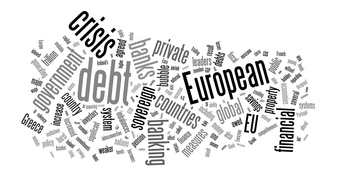
The Message
What is the message that you’re trying to get across to your audience?
No matter which model of communication you study, every model includes the most important element of all: the message. You can’t have communication without a message. The word “message” actually comes from the Latin mittere, “to send. ” The message is fundamental to communication.
With regard to public speaking and speech communication, your speech is your message. But you may have other intentions for your speech as well: the message behind the message. Perhaps you have a singular goal, point or emotion you want your audience to feel and understand. Every single word that you use to craft your speech then, works to achieve that singular goal, point or emotion.
As the sender, the speech writer and speech giver, you may also be getting messages back from your receivers: your audience. This is what’s known as feedback, when the receiver sends a message of response back to the sender. In this way, messaging becomes a dynamic conversation of feedback as the sender sends his or her message to his or her audience, receives feedback from the audience, and then adjusts the message accordingly based on said feedback.
Messages can be sent both verbally and non-verbally. You can say one thing with your words, but depending on how you say it and the non-verbal cues such as posture and eye contact, you may send an entirely different message to your audience. That said, it’s important to consider all aspects of your overall message, from verbal to non-verbal to the meaning and message behind the message, when crafting your speech.
1.4.3: Channel
The channel is the method (auditory and visual) that is used to transmit the message to the receiver.
Learning Objective
Give examples of auditory and visual channels used in public speaking
Key Points
- In a face-to-face setting, the channel will be primarily audio and visual; in a speaking situation with remote audience via videoconferencing, the channel will be computer mediated audio and visual.
- When the speaker and the audience are in the same room at the same time, the channels of communication are synchronous.
- When listeners receive the speech at some time after the speech was delivered, the channels are asynchronous (that is, in delayed time).
Key Terms
- mediated
-
Acting or brought about through an intervening agency.
- channel
-
The method a sender uses to send a message to a receiver. The most common channels humans use are audtiory and visual.
- co-located
-
To locate or be located at the same site, for two things or groups at same space.
Elements of Speech Communication: The Channel
A basic speech communication model includes a sender (that is, a speaker), a message, a receiver (that is, an audience), and a channel. Claude Shannon, who developed one of the earlier communication models, defined the channel as the medium used to transmit the signal from the transmitter to the receiver. In a face-to-face, in-person speaking situation, the channel will be primarily audio using sound and visual using light waves; in a speaking situation with a remote audience via videoconferencing, the channel will be computer mediated audio and visual.
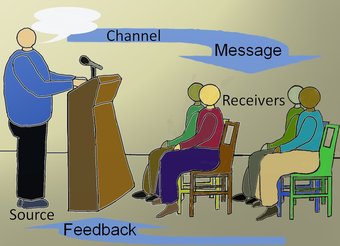
Communication Channel Model
The speaker uses the channel, or speech, to transmit the message to the audience.
Face-to-Face, Co-Located Audience Channel
When speaking to an audience in person, a speaker uses both verbal and non-verbal methods to communicate the message. The sounds that a speaker makes are interpreted as words. The sounds are transmitted through an audio (or auditory) channel as sound waves and are received by the listeners in the audience. Speakers also use their hands to make gestures, change their facial expressions, and project images or words on a screen. These cues are received by the listeners through the visual part of the channel: their sense of sight. When the speaker and the audience are in the same room at the same time, the channels of communication are synchronous, in real time.
Computer Mediated Communication (CMC) Channel
Speakers also use communication channels that are mediated, meaning there is something between the speaker and the receivers. In some cases, the auditory and visual signal is mediated by a computer to convert what the speaker says and does into a digital signal that is transmitted to remote audiences. Computer Mediated Communication (CMC) is able to overcome physical and social limitations of other forms of communication, and therefore allow the interaction of people who are not physically sharing the same space. Computer mediated digital channels may be synchronous, when remote audiences are listening to the speech via computer conferencing or streaming audio and video at the same time the speech is being delivered. The channel might also be asynchronous, when audiences listen to the speech at some time after the speech was delivered, perhaps via a website like youtube.com or vimeo.com. The message delivered through CMC channels could be only audio, but is likely to involve both audio and video, which uses the auditory and visual senses of the humans to decode the digital signals and process the message.

Shannon Weaver Communication Model
The channel in the middle links the speaker with the receiver of the message.
1.4.4: Audience
Your audience represents one very important third in the basic model of communication.
Learning Objective
Analyze your audience based on demographics
Key Points
- “Who is my audience? ” is the first question you should ask yourself before you begin crafting your speech.
- Your audience may share commonalities and characteristics known as demographics. You should never stereotype or generalize your audience by their demographics, but you can use them to inform the language, context, and delivery of your speech.
- Audience demographics to consider include age, culture, race, gender, education, occupation, values, and morals.
Key Terms
- audience
-
A group of people within hearing; specifically a group of people listening to a performance, speech etc.; the crowd seeing a stage performance.
- demographic
-
A demographic criterion: a characteristic used to classify people for statistical purposes, such as age, race, or gender.
Elements of Speech Communication: The Audience

Audience
The audience is the most important part in the model of communication.
At its simplest, communication consists of a speaker, a message, and a receiver. Following this model, your speech represents the message. Naturally, this makes you the speaker. To whom you speak then, represents the receiver: in this case, your audience. When looking at this most basic model of communication, your audience represents one-third of the communication equation, proving it is one of the three most important elements to consider as you craft your speech.
Elements to Consider About Your Audience
Your audience may be represented by a variety of distinguishing characteristics and commonalities, often referred to as demographics. It is important to remember that you should not stereotype or make assumptions about your audience based on their demographics; however, you can use these elements to inform the language, context, and delivery of your speech. The first question you should ask yourself, before you begin crafting your speech, is this: “Who is my audience?”
As you begin to answer this question for yourself, here are some key elements to consider as you begin to outline and define your audience:
- Age: What age ranges will be in your audience? What is the age gap between you and your audience members? Age can inform what degree of historical and social context they bring to your speech as well as what knowledge base they have as a foundation for understanding information.
- Culture/Race: While these are two separate demographics, one informs the other and vice versa. Race and culture can influence everything from colloquialisms to which hand gestures may or may not be appropriate as you deliver your speech.
- Gender: Is your audience mostly women? Men? A mix of the two? It is important to consider your gender and your audience, as the gender dynamic between you and your audience can impact the ways in which your speech may be received.
- Occupation/Education: Just as age, culture, race, and gender factor into your audience’s ability to relate to you as speaker, so may occupation and education. These elements also help to give you an understanding of just how much your audience already may or may not know about your given subject.
- Values and Morals: While these may not be readily apparent, they can factor prominently into your ability to be likable to your audience. Particularly if you are dealing with controversial material, your audience may already be making judgments about you based on your values and morals as revealed in your speech and thus impacting the ways in which they receive your message.
1.4.5: Feedback: Visual and Verbal Cues
Your audience can provide you with immediate feedback; pay attention to the visual and verbal cues they give you in the moment.
Learning Objective
Define feedback and describe how you can receive audience feedback in the moment
Key Points
- An advanced model of communication includes a sender, a message, a receiver, a channel and feedback. Feedback represents a message of response sent by the receiver back to the sender.
- Feedback happens in realtime as your audience provides you with visual and verbal cues in response to your speech.
- If feedback indicates that your message hasn’t been received as intended, you may need to correct course in the moment to make that connection with your audience.
Key Term
- feedback
-
The receivers’ verbal and nonverbal responses to a message, such as a nod for understanding (nonverbal), a raised eyebrow for being confused (nonverbal), or asking a question to clarify the message (verbal).
Elements of Speech Communication: Feedback

Feedback
You audience might give you visual, non-verbal cues that signal how they might be receiving your message.
The simplest model of communication relies on three distinct parts: sender, message and receiver. More complex models throw in a fourth element: the channel via which the message is sent. The most advanced communication models include a fifth element: feedback, that is, a return message sent from the receiver back to the sender. Feedback could be as formal as handing out a presentation evaluation following your speech or presentation. Typically though, you can gauge feedback as your speech is happening by paying very close attention to the visual and verbal cues your audience may be giving you while you speak.
Verbal and Visual Cues
Verbal and visual cues refer to those sounds and reactions you may hear and see made by your audience. If you tell a joke or a funny anecdote, you expect laughter as your feedback. One good way to tell if your joke bombed–no laughter. And, as awkward as it can be in the moment, you get that instant feedback on how you may need to correct course and potentially deviate from your scripted approach in order to make that connection with your audience.
Visual cues can also include making eye contact. As you scan the room, are people returning your gaze? If so, you have an engaged audience, attentively listening to your speech. If you see half-closed or closed eyes, try adjusting your tone and volume: you just might need to wake your audience up a little bit.
And of course, depending on your speech topic, the lack of a smile or a chuckle doesn’t mean your audience is connecting to your words. Tears can indicate that your words have an incredibly powerful effect on your audience if you’re talking about a particularly moving or emotional subject.
The key takeaway is to remember that this feedback loop of immediate audience reaction plays out in real time as you speak, so it’s up to you to be observant and think two to three steps ahead if you need to correct course based on your audience’s feedback.
1.4.6: Noise and Interference
Noise and interference can block your audience’s ability to receive your message.
Learning Objective
Identify methods to cut down on internal and external noise and interference
Key Points
- Noise exists in all aspects of communication, thus, no message is received exactly as the sender intends (despite his or her best efforts) because of the ever-presence of noise in communication.
- Noise can be both external and internal. External noise often relates to your physical environment, such as a noisy room, as well as your physiological state. Internal noise includes psychological and semantic noise, and is how you prevent yourself from effectively delivering your message.
- To combat external noise, speak louder or see if you can be amplified in some way. Alternatively, see if the source of the noise can be stopped or lowered.
- To triumph over internal noise, take a few deep breaths before speaking. Breathe out all of the negative self-doubt and anxieties you may have about speaking. Inhale confidence. You can do this!
Key Term
- noise
-
Various sounds, usually unwanted.
Elements of Speech Communication: Noise & Interference

Noise
Noise and interference can distort the meaning and delivery of your message.
What Are Noise and Interference?
Typically, you know it when you hear it. Noise may be jarring and unpleasant and is usually an interruption or distraction when it occurs. Noise and interference block the sending or receiving of a message. When it comes to public speaking, noise and interference can be a major issue for both you as message sending and for your audience as your message receivers.
Quite simply, noise jams the signal you’re trying to send as you speak.
Noise and interference can be both external or internal. It could be your microphone feeding back through a speaker, causing that ear-splitting high pitch squeal. You could be trying to talk over an auditorium full of chatty high schoolers. Or you could be giving a speech outdoors on a windy day and you’re barely able to shout over the sound of the wind.
Internal noise and interference can be particularly challenging, since this often refers to the internal monologue you might be telling yourself before you get up on stage to speak: “I’m not good enough. I’m going to forget my speech. They’re going to boo me. ” Internal noise can be psychological and semantic in nature, whereas external noise can be known as or include physical and physiological noise. Often, internal noise and interference are the result of anxiety, nervousness, or stress.
Whether internal or external, unless you’re giving your speech in a vacuum, noise is unavoidable. Noise exists at all levels of communication and thus, no message is received exactly as the sender intends (despite his or her best efforts) because of the ever-presence of noise in communication.
Learning How to Tune It All Out
With regard to external noise, double check to see if there are any ways to boost your volume. You might need to physically project your voice a little more to be heard over a low din. You might even need to call attention to yourself so that your audience pays attention. And it’s okay to ask your audience before you speak: “Can you hear me in the back? “
As for internal noise, fear is the enemy. If you’re nervous about speaking, take a few moments before presenting to inhale some nice, deep breaths for a count of four: in through the nose for four, blow it out through the mouth for four. Repeat this until you can feel your heart rate slow down a little and the butterflies in your stomach settle down. You can do this!
1.4.7: Presentation
How you deliver your speech presentation may be just as important as the speech itself.
Learning Objective
Demonstrate how to appropriately present yourself when giving a speech
Key Points
- Remember to “dress to impress”–when in doubt, go for business professional. It’s better to be overdressed for a speech or presentation than underdressed.
- Your verbal communication, in how you phrase and intone your actual words, is vital to building auditory interest for your audience. Try to play with the pitch and tone of your speech; avoid speaking in monotone.
- From gesture to posture, your non-verbal communication via your body language also adds visual depth and engagement for your audience. Maintain eye contact. Don’t wander around stage or gesticulate too much. Make your audience feel comfortable by being comfortable in front of them.
Key Term
- non-verbal communication
-
Nonverbal communication is usually understood as the process of communication through sending and receiving wordless (mostly visual) cues between people. Messages can be communicated through gestures and touch, by body language or posture, by facial expression and eye contact.
Elements of Speech Communication: The Presentation

Presentation
How your message comes across is just as important as the message itself.
The delivery of your message may be just as important as the words you speak. There are a number of factors to consider when delivering your speech that can help or hinder your efforts to an effective overall presentation.
Appearance
You may have heard the phrase, “Dress to impress. ” This couldn’t be more true when getting up to deliver a speech. While some speech venues and settings might be more casual, chances are, you should be dressed in business attire. While fashion may change as quickly as the seasons, some basic tips regarding business professional or business formal attire hold true:
For men: A suit is a good staple for any business professional wardrobe. When in doubt as to just how formal or professional, stick with button-down shirts and add the tie (as cumbersome as it might be). If you can swing a blazer or suit coat, do it. If not, the tie is a good business formal backup. Hair should be neat and faces clean-shaven.
For women: What constitutes business casual versus business professional or formal is always changing, but a good rule of thumb is to keep your shoulders covered and skirts knee-length or longer. Dress and pant suits are usually acceptable as well as single-piece dresses. Avoid any plunging necklines. Keep the makeup to only what’s necessary and hair should be neat. If you’re comfortable in tall heels, go for it. Otherwise, choose a pair of shoes in which you are confident you can be sturdy when entering and exiting the stage as well as standing for the duration of your speech.
Verbal Communication: Your Words and Ideas
The actual words that you say certainly influence your presentation. Make sure that you rehearse often so that the words feel comfortable in your mouth as you speak them aloud. Be on the lookout for phrases that might trip you up or leave you tongue-tied. Practice your speech in front of another person or small group of people: ask them if what you’re saying–from the ideas to which you’re trying to get across to your phrasing, tone and style–make sense to them.
Non-Verbal Communication: Your Body Language
Your non-verbal communication is equally as important as the words you have to say. Your body stance and posture and your eye contact (or lack thereof) can be crucial in making yourself relatable to your audience. You’ll want to keep an assertive body posture: stand up straight and maintain eye contact when you can (if you’re not reading from prepared remarks). Be mindful of gesture: don’t overdo it, but don’t stand there rigidly, either. Gesture and movement build visual interest for your audience. If you’re able to get out from behind a podium or lectern, do so.
1.4.8: Situational and Environmental Context
It is important to understand the environmental and situational contexts in which you are giving a speech.
Learning Objective
Define situational context, environmental context, and situational awareness
Key Points
- Without context, your audience may not understand your message. Conversely, you might not understand your audience.
- Situational context refers to the reason why you’re speaking. Think of situational context as the event itself.
- Environmental context refers to the physical space and time in which you speak. Think of environmental context as the time and venue of the event.
- The key to understanding your context is to cultivate a habit of situational awareness. It’s not something you’ll learn overnight, but by being keenly aware of your surroundings, you’ll learn to always think one step ahead should context change suddenly when speaking.
Key Terms
- situational awareness
-
the perception of environmental elements with respect to time and/or space, the comprehension of their meaning, and the projection of their status after some variable has changed, such as time, or some other variable, such as a predetermined event.
- context
-
the surroundings, circumstances, environment, background, or settings that determine, specify, or clarify the meaning of an event or other occurrence.
Example
- A politician gives a stump speech on the campaign trail. A best man gives a toast at a wedding. The Queen of England knights actor Ian McKellan. In each of these instances, context is crucial. A politician wouldn’t knight Sir Ian nor would a best man give a stump speech at a wedding. Remember: if you can’t fully grasp the context in which you’re speaking, your audience won’t understand you.
Elements of Speech Communication: Situational and Environmental Context

Environmental and Situational Context
The environmental and situational context in which you give a speech is important.
Just as you consider your audience when crafting your speech, you’ll also want to consider the context in which your speech will be given. While context certainly includes your audience, it also encompasses many other factors that are important for you to consider as you craft your speech.
Consider for a moment when you hear just the tail end of a conversation in passing. It doesn’t always make much sense. What you’re missing, in this instance, is the context of that conversation. Just as you need it to understand the conversation you just missed, both you and your audience need to be on the same page about the context of your speech.
Situational context refers to the actual reason why you are speaking or presenting. If you’re campaigning for office, you might deliver what’s called a “stump speech” – a speech you repeat over and over on the campaign trail that gets at the main talking points and promises of your campaign. If you’re at a funeral, you may be asked to deliver a eulogy. On a lighter note, you might be at your best friend’s wedding and asked to give one of the first toasts.
The manner in which you deliver your speech, from the words you say to how you say them, relies on the situational context. For example, you wouldn’t read a eulogy at a wedding?
Environmental context refers to the physical space in which you’re speaking. Whether you’re in a classroom presenting the findings from a lab report or in a stadium that seats thousands, environmental context can influence both your message and delivery. The audience will connect with you in different ways depending on the environmental context. You may need to work harder to build individual connections with your audience members the larger the audience you have.
The key then, to understanding your context is to develop a habit of situational awareness. Situational awareness refers to one’s perception of their environment and situation around them on a moment by moment basis. In being situationally aware, you can anticipate changes to your environment. In this way, you’re always thinking just one step ahead in any given situation or environment, and can be able to adapt accordingly. Cultivating this skill (and it does take time and a keen awareness of your surroundings) is especially helpful when your context may shift or change in subtle or major ways, or in an instant.
1.4.9: Context of Culture and Gender
Understanding the cultural and gender context of your speech is vital to making a connection with your audience.
Learning Objective
Define gender and culture in relation to public speaking
Key Points
- Gender and culture are societal constructs of sex and (sometimes, but not always) race, respectively.
- People who identify as one sex (i.e., female) may not necessarily associate with the corresponding gender traits (i.e., feminine). The same is true of race and culture, respectively.
- Both gender and culture come with their own set of biases: bias that you may have toward differing genders and cultures, and the biases that differing genders and cultures may have towards you.
Key Terms
- culture
-
The beliefs, values, behavior and material objects that constitute a people’s way of life; the arts, customs, and habits that characterize a particular society or nation.
- bias
-
An inclination towards something; predisposition, partiality, prejudice, preference, predilection.
- gender
-
The sociocultural phenomenon of dividing people into the categories of “male” and “female,” with each having associated clothing, roles, stereotypes, etc.
Elements of Speech Communication: Cultural and Gender Context
Both culture and gender play key roles not only in how you perceive your audience, but in how your audience perceives you.
Understanding Gender
When we think of gender, we often think of male or female; that’s only half of understanding gender. The denotations of male and female actually refer to biological and physiological sex. Gender is a sociological construct of values, ideals, and behaviors about what it means to be either male or female, and are often regarded in terms of masculine or feminine, respectively. Many people use sex and gender interchangeably, but one does not have to be male to identify as masculine, and vice versa.
Understanding Culture
In the example above, we have both a biological, physical characteristic (sex) with a superimposed cultural construct (gender). The same applies to both race and culture, respectively. Race refers to groups of people who are distinguished by shared physical characteristics, such as skin color and hair type. Culture refers to the customs, habits, and value systems of groups of people. People of the same race may not share the same culture; similarly, a culture isn’t necessarily comprised of people of the same race.
How Gender and Culture Can Impact Public Speaking
When considering both gender and cultural contexts, we often encounter bias, both intentional and unintentional, and implicit or explicit. We may have presumptive judgments or opinions about those cultures and races that differ from our own, which are often the result of our own upbringing. And as much as you might be biased toward or against certain gender and cultural groups, your audience will have just as much bias as you, and in different ways.
As such, it is radically important to know exactly to whom you’re speaking when giving your speech. It’s helpful for you to anticipate not only the biases you might bring to the podium, but those biases of your audience towards you as well.

Cultural and Gender Context
The speaker’s gender and cultural identity and the audience’s cultural and gender identities invariably influence one another.
1.5: Types of Public Speeches
1.5.1: Informative Speeches
An informative speech involves a knowledgeable speaker transferring some of their knowledge to their audience.
Learning Objective
List the types of informative speeches and describe their use
Key Points
- A speaker should be very knowledgeable about the topic of their informative speech.
- The topic of an informative speech can range from a detailed method to an abstract concept.
- Narrower topics make for more robust and comprehensible speeches.
- Practice any speech multiple times.
Key Terms
- object
-
A thing that has physical existence.
- inform
-
To communicate knowledge to others.
- concept
-
An understanding retained in the mind, from experience, reasoning and/or imagination; a generalization (generic, basic form), or abstraction (mental impression), of a particular set of instances or occurrences (specific, though different, recorded manifestations of the concept).
Example
- A professor giving a lecture, which provides technical information on a given topic to the audience of students, is an example of an informative speech.
An informative speech is one in which the speaker relays knowledge to an audience on a specific topic. There are four distinct categories of topic:
- things, people, or places
- methods
- events
- ideas
Speeches About Objects
For the purposes of this type of informative speech, anything that is visible and tangible is considered an object. Object speeches seek to impart knowledge about this object to the audience. Whether your object is the human body or the most recent episode of Family Guy, informative object speeches provide a comprehensive overview of your object as topic.
It’s important that object speeches have a purpose: using our previous examples, you may discuss the complex, myriad ways in which the endocrine system functions and how it regulates metabolism; similarly, you may describe how Family Guy serves as a modern form of satire in pop culture. It’s one thing to spout off facts about an object, but there must be a purpose to those facts.
Speeches About Processes
A process is the manner in which something is created, made, done, or works. An informative speech about a process then describes how something is made, done, or works. Processes could include anything from how the modern electoral college works to how an ice cream sandwich is made on the factory line. Informative process speeches work to help your audience both understand the process, and possibly be able to replicate the process for themselves (if applicable).
Speeches About Events
Any occurrence that happens is regarded as an “event. ” A speech about an event then, describes the occurrence in full: the time, date, location, and circumstances of that occurrence. Like all informative speeches, event speeches must also serve a purpose. You may talk about how the Battles of Lexington and Concord came to be known as the “shot heard ’round the world,” or describe the experience of your first week at college. In either case, your speech must have a purpose to it.
Speeches About Concepts
Concepts refer to ideas, beliefs, theories, attitudes, and/or principles. When speaking about concepts, you may have to find concrete ideas in order to make abstract ideas more relatable and tangible to your audience. Whether discussing the theory of the origins of the universe to whether there’s any truth to the phrase “love at first sight,” concept speeches break down complex ideas into manageable chunks of understanding for your audience.
Crafting an Effective Informative Speech
A narrowly focused speech topic can really hone in on an object, process, event, or concept, thus making it easier for the audience to understand that topic. A broadly chosen topic usually entails lots of different kinds of information, which might complicate the informative quality of a speech and confuse the audience members. A narrowed focus also makes researching more manageable for the speech writer and increases his or her ability to understand that topic thoroughly before presenting it to others.
When writing an informative speech, pick out a small number of key points on your specific topic that you want the audience to take away from your speech. Use these points to develop an organizational structure to your speech, which should include an introduction, body, and conclusion. This structure will provide a trajectory that guides your audience as you elaborate the key points of information. Having a structure gives you, as the speaker, an opportunity to introduce the key points in the introduction and revisit them in the conclusion, increasing the likelihood that the audience will walk away with the key knowledge about your topic.

Informative Speech
A lecture is an example of an informative speech.
1.5.2: Persuasive Speeches
In a persuasive speech, a speaker attempts to persuade the audience to adopt his/her position in relation to a topic.
Learning Objective
Explain how to compose a persuasive speech
Key Points
- A persuasive speech intends to persuade the audience to adopt the position of the speaker.
- Know your audience: in order to be persuasive, the form and content of your speech must take into account what the audience knows and how it wants to be addressed.
- An appeal to ethos is used to show the character of the speaker and make him/her more credible.
Key Terms
- audience
-
A group of people within hearing; specifically a group of people listening to a performance, speech etc.; the crowd seeing a stage performance.
- pathos
-
That quality or property of anything which touches the feelings or excites emotions and passions, esp., that which awakens tender emotions, such as pity, sorrow, and the like; contagious warmth of feeling, action, or expression; pathetic quality.
- persuade
-
To successfully convince someone to agree to, accept, or do something, usually through reasoning and verbal influence.
Example
- A persuasive speech can be seen in the image where William Jennings Bryan gives a campaign speech. Here he is trying to persuade the audience to cast its vote for him.
The purpose of a persuasive speech is to convince the audience to adopt the speaker’s perspective on a given topic. The core of a persuasive speech is pathos: appealing to and resonating with the audience’s feelings and emotions.
In order for the pathos contained in a persuasive speech to be effective, the speaker has to understand the audience he/she is addressing.To be convincing, the speaker has to take into account the behavioral motivations and foundational beliefs of the audience.
Showing empathy with the audience is crucial. Drawing parallels between yourself and the audience reduces the distance between you and them, making your speech that much more persuasive.
In addition to pathos, persuasive speeches contain appeals to ethos and logos. An appeal to ethos is used to show the character of the speaker and make him/her more credible. For the audience to be persuaded, they have to feel that the speaker is a credible and worth listening to. An appeal to logos requires referencing evidence. This demonstrates the extent to which the speaker is knowledgeable about the topic he/she is speaking about, making their speech more persuasive than if he/she appeared ill-informed on the topic.

William Jennings Bryan, 1908
A picture of William Jennings Bryan giving a campaign speech in 1908.
1.5.3: Informative vs. Persuasive Speeches
Many speeches will contain elements of both informative and persuasive speeches.
Learning Objective
Distinguish between an informative speech and a persuasive speech
Key Points
- An informative speech aims to inform the audience about a specific topic.
- A persuasive speech aims to persuade the audience to perform a certain action or convince the audience to adopt the belief or opinion of the speaker.
- Many speeches will combine features of informative and persuasive speeches.
- Know the audience: the types of knowledge they possess, the core beliefs they hold, and what motivates them to undertake actions.
- Considering the purpose of the speech will help determine if the speech should use more of the features of informative or persuasive speeches.
Key Terms
- pathos
-
That quality or property of anything which touches the feelings or excites emotions and passions, esp., that which awakens tender emotions, such as pity, sorrow, and the like; contagious warmth of feeling, action, or expression; pathetic quality.
- persuasive
-
Able to induce to believe by appealing to reason or understanding; convincing.
- informative
-
Providing knowledge, especially useful or interesting information.
Example
- The State of the Union is an example of a speech that is instructive, because the President of the United States is supposed to tell the members of Congress what the state of the union is, while also being persuasive, by aiming to persuade citizens to adopt the beliefs of the President.
When choosing between writing an informative or persuasive speech, the speaker should consider the purpose of the speech. Is it to share information about a particular event, topic, or subject? Or is it to persuade the audience to hold a certain belief or attitude about said event, topic, or subject?
The focus of the thesis, or the main argument of the speech, often dictates whether the speech will be mainly informative or persuasive in nature. However, keep in mind that some speeches will contain a combination of both types of speech.
Informative speeches describe knowledge about a particular event, process, object, or concept. The goal of an informative speech is for the audience to fully comprehend this knowledge. Persuasive speeches are those that seek to have the audience share a belief or feeling about a particular event, process, object or concept. The difference is subtle, and yet mighty.
For example, imagine a topic that could fall into either category, such as reproductive choice. An informative speech may track the history of reproductive choice in America. A persuasive speech may discuss the pros and cons of Roe v. Wade, or how some groups feel that reproductive choice is threatened. In the latter instance, using examples from history may bolster that argument. As noted above, all persuasive speeches will be informational in nature, but not all informational speeches may be persuasive.
Fully understanding the informational or persuasive purpose of the speech will help the speaker determine what rhetorical strategies to use in the pursuit of achieving his or her goal. If the purpose is simply to provide information, then the speech will likely rely less on pathos and more on evidence, statistical data, or charts and graphs. If the purpose is have the audience believe or feel a certain way about the subject, then the speaker will tailor the evidence and specific data with appeals to emotion to lead the audience to the desired point of view.
When writing a speech, take into account the intended audience that will be addressed; never underestimate the importance of knowing the audience. For example, when giving an informative speech, the speaker must take into account not only the audience’s familiarity with any technical terms, but also what sort of pathos he or she may want to use. Some audiences will respond to certain appeals to emotion, while others might be turned off to the speaker if he or she makes what is seen as an inappropriate appeal to emotion. Therefore, always consider the specifics of your audience–age, occupation, beliefs, motivations–and then use these specifics to inform the form and content of the speech.
The State of the Union is a good example of a speech that contains elements of informative and persuasive speeches. In the State of the Union, the President of the United States is supposed to inform the members of Congress on the state of the union. Therefore, it commonly contains specific information (for example, the number of jobs created in a certain time period).
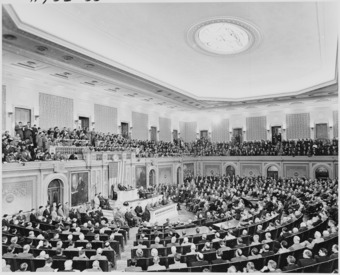
President Truman, 1950
President Truman delivers his State of the Union to Congress in 1950.
However, the State of the Union also contains heavy pathos that is intended to make citizens feel confident about the President’s handling of the nation and hopeful about the future. The President will spin data and use emotional appeals to make his or her case to the American people. This specific speech makes it clear that a speech can combine the features of informative and persuasive speeches.
1.5.4: Speeches for Special Occasions
Some special occasions require speeches that are different than speeches aimed at informing or persuading audiences.
Learning Objective
Differentiate a special occasion speech from an informative or persuasive speech
Key Points
- Special occasion speeches tend to be shorter speeches, commonly less than ten minutes.
- Special occasion speeches are commonly addressed to a particular audience.
- Depending on the context, special occasion speeches can be funny or sad.
Key Terms
- context
-
the situation in which something happens.
- pathos
-
an appeal to an audience’s emotions or sensibilities.
- toast
-
to engage in a salutation and/or accompanying raising of glasses while drinking alcohol (or other appropriate beverage) in honor of someone or something.
As the name implies, special occasion speeches are speeches that are given on special occasions. There are many examples of special occasions where it might be appropriate to deliver a speech. For example, an individual might give a speech at a wake or memorial for an audience of friends and families who knew the person being memorialized. Clearly this speech will be very different than a toast given at a wedding, which is also an example of a special occasion speech and which will have a much more celebratory tone. A commencement ceremony or award ceremony are some other special occasions during which someone may give a speech.
Special occasion speeches are usually shorter than informative or persuasive speeches. Special occasion speeches are usually less than ten minutes long, which demonstrates that their purpose is different than other types of speeches delivered at a conference or political rally. Depending on the context, the purpose of a special occasion speech may be to remember, to praise or to humorously tease. They may contain a use of pathos that aims to convince the audience to be happy, possibly by being comedic. However, they may use a pathos intended to make the audience reflective, as in a speech given at a memorial service.
Special occasion speeches might inform the audience. For example, someone may give a speech at a wedding and share a specific memory, thus informing the audience of that particular incident and possibly articulating its importance in relation to the newlyweds. While special occasion speeches may be informative, their purpose is always specific to the context and audience that will be hearing them.

A wedding toast
The toasts that are given at a wedding are an example of special occasion speeches.
Chapter 21: The Functions of Money and Banking
21.1: Money as a Tool
21.1.1: Functions of Money
The main functions of money are as a medium of exchange, a unit of account, and a store of value.
Learning Objective
Describe the function of money
Key Points
- When money is used to intermediate the exchange of goods and services, it is performing a function as a medium of exchange.
- A unit of account is a standard numerical unit of measurement of the market value of goods, services, and other transactions.
- To act as a store of value, money must be able to be reliably saved, stored, and retrieved. In this case, the value of the money must also remain stable over time.
- Money can also function as a “standard of deferred payment,” which means that its status as legal tender allows it to function for the discharge of debts.
Key Terms
- medium of exchange
-
An intermediary used in trade to avoid the inconveniences of a pure barter system, such as money.
- unit of account
-
a standard monetary unit of measurement of value/cost of goods, services, or assets.
- store of value
-
An asset such as money or gold that is purchased or accepted as payment for goods and services for its ability to purchase other assets in the future without rapidly losing its purchasing power.
Example
- After World War II, at the Bretton Woods Conference, most countries adopted fiat currencies that were fixed to the U.S. dollar. In turn, the U.S. dollar was fixed to gold. In 1971, the U.S. government suspended the convertibility of the U.S. dollar to gold.
Money acts as a standard measure and common denomination of trade. As a result, it is a basis for quoting and bargaining prices. It is necessary for developing efficient accounting systems, but its most important use is that it provides a method to compare the values of dissimilar objects. Money functions as:
- A medium of exchange
- A unit of account
- A store of value
A Medium of Exchange
When money is used to intermediate the exchange of goods and services, it is performing the function of a medium of exchange. It avoids the inefficiencies of a barter system, such as the dependence on the occurrence of a coincidence of wants. To be widely acceptable, a medium of exchange should have stable purchasing power. Therefore, it should possess the following characteristics:
- Valuation of common assets
- Constant utility
- Low cost of preservation
- Transportability
- Divisibility
- High market value in relation to volume and weight
- Recognizability
- Resistance to counterfeiting
Gold was popular as a medium of exchange and store of value because it was inert. Gold was convenient to move because even small amounts of it had considerable value. Gold also had a constant value due to its special physical and chemical properties, which made it cherished by men.
A Unit of Account
A unit of account is a standard numerical unit of measurement of the market value of goods, services, and other transactions. Also known as a “measure” or “standard” of relative worth and deferred payment, a unit of account is a necessary prerequisite for the formulation of commercial agreements. To function as a unit of account, whatever is being used as money must meet these characteristics:
- It must be divisible into smaller units without a loss of value. For example, precious metals can be coined from bars or melted down into bars again.
- It must be fungible. In other words, one unit or piece must be perceived as equivalent to any other. This is why diamonds, works of art, or real estate are not suitable as money.
- It must have a specific weight, measure, or size in order to be verifiably countable. For instance, coins are often milled with a reeded edge, so that any removal of material from the coin (lowering its commodity value) will be easy to detect.
A Store of Value
To act as a store of value, money must be able to be reliably saved, stored, and retrieved. Moreover, it must be predictably usable as a medium of exchange when it is retrieved. The value of the money must also remain stable over time. Put simply, money acting as a store of value allows its owner to transfer real purchasing power from the present to the future. Some have argued that inflation, by reducing the value of money, diminishes its ability to function as a store of value. Money can also function as a “standard of deferred payment,” which means that its status as a legal tender allows it to function for the discharge of debts.

Functions of Money
Money, such as the U.S. dollar, functions as a medium of exchange, a unit of account, and a store of value.
21.1.2: Types of Currency
Nearly all contemporary money systems are based on fiat money, which is modern currency that has value only by government order.
Learning Objective
Describe the different types of mediums used as currency
Key Points
- Fiat money is money that derives its value from government regulation or law. Value is not derived from any intrinsic value or guarantee that it can be converted into a valuable commodity (such as gold).
- Commodity money value comes from the commodity out of which it is made. The commodity itself constitutes the money, and the money is the commodity. For example gold, silver, copper, rice, salt, alcohol, and cigarettes are commodities that have been used as a medium of exchange.
- Commercial bank money or demand deposits are claims against financial institutions that can be used for the purchase of goods and services.
Key Terms
- Fiat money
-
money whose value is not derived from any intrinsic value or guarantee that it can be converted into a valuable commodity (such as gold).
- commodity money
-
money whose value comes from a commodity of which it is made. It is objects that have value in themselves as well as for use as money.
- Bretton Woods System
-
The Bretton Woods system of monetary management established the rules for commercial and financial relations among the world’s major industrial states in the mid-20th century. The Bretton Woods system was the first example of a fully negotiated monetary order intended to govern monetary relations among independent nation-states.
Example
- Fiat money originated in 11th century China, and its use became widespread during the Yuan and Ming dynasties. The Nixon Shock of 1971 ended the direct convertibility of the United States dollar to gold. Since then all reserve currencies have been fiat currencies, including the U.S. dollar and the euro.
Currency refers to physical objects generally accepted as a medium of exchange. These are usually the coins and banknotes of a particular government, which comprise the physical aspects of a nation’s money supply. The other part of a nation’s money supply consists of bank deposits (sometimes called deposit money), ownership of which can be transferred by means of checks, debit cards, or other forms of money transfer. Deposit money and currency are money in the sense that both are acceptable as a means of payment.
Money in the form of currency has predominated throughout most of history. Usually (gold or silver) coins of intrinsic value (commodity money) have been the norm. However, nearly all contemporary money systems are based on fiat money. In other words, modern currency has value only by government order (fiat). Usually, the government declares the fiat currency (typically notes and coins issued by the central bank) to be legal tender, making it unlawful to not accept the fiat currency as a means of repayment for all debts, both public and private.
Fiat Money
Fiat money is money that derives its value from government regulation or law. Value is not derived from any intrinsic value or guarantee that it can be converted into a valuable commodity (such as gold). The term fiat currency is also used when the fiat money is used as the main currency of the country. Some bullion coins such as the Australian Gold Nugget and American Eagle are legal tender, but they trade based on the market price of the metal content as a commodity, rather than their legal tender face value (which is usually only a small fraction of their bullion value).
Fiat money, if physically represented in the form of currency (paper or coins), can be accidentally damaged or destroyed . However, fiat money has an advantage over representative or commodity money in that the same laws that created the money can also define rules for its replacement in case of damage or destruction. For example, the U.S. government will replace mutilated Federal Reserve notes (U.S. fiat money) if at least half of the physical note can be reconstructed, or if it can be otherwise proven to have been destroyed. By contrast, commodity money which has been lost or destroyed cannot be recovered.

Money
Fiat, Commodity, and Commercial Bank money are three main types of money
Currently, most modern monetary systems are based on fiat money. However, for most of history, almost all money was commodity money, such as gold and silver coins. As economies developed, commodity money was eventually replaced by representative money, such as the gold standard, as traders found the physical transportation of gold and silver burdensome. Fiat currencies gradually took over in the last hundred years, especially since the breakup of the Bretton Woods system in the early 1970s.
Commodity Money
Many items have been used as commodity money such as naturally scarce precious metals, conch shells, barley, and beads, as well as many other things that are thought of as having value. Commodity money value comes from the commodity out of which it is made. The commodity itself constitutes the money, and the money is the commodity. Examples of commodities that have been used as mediums of exchange include gold, silver, copper, rice, salt, peppercorns, large stones, decorated belts, shells, alcohol, cigarettes, cannabis, and candy. The use of commodity money is similar to barter, but a commodity money provides a simple and automatic unit of account for the commodity which is being used as money.
Commercial Bank Money
Commercial bank money or demand deposits are claims against financial institutions that can be used for the purchase of goods and services. A demand deposit account is an account from which funds can be withdrawn at any time by check or cash withdrawal without giving the bank or financial institution any prior notice. Banks have the legal obligation to return funds held in demand deposits immediately upon demand (or “at call”). Demand deposit withdrawals can be performed in person, via checks or bank drafts, using automatic teller machines (ATMs), or through online banking.
Commercial bank money is created through fractional-reserve banking, which is the banking practice where banks keep only a fraction of their deposits in reserve (as cash and other highly liquid assets). Banks then lend out the remainder, while maintaining the simultaneous obligation to redeem all these deposits upon demand. Commercial bank money differs from commodity and fiat money in two ways. First, it is non-physical, as its existence is only reflected in the account ledgers of banks and other financial institutions. Second, there is some element of risk that the claim will not be fulfilled if the financial institution becomes insolvent.
21.1.3: Measuring the Money Supply
In economics, the money supply or money stock, is the total amount of money available in an economy at a specific time.
Learning Objective
Describe the standard measures used to classify the money supply
Key Points
- There are several ways to define “money,” but standard measures usually include currency in circulation and demand deposits (depositors’ easily accessed assets on the books of financial institutions).
- Public and private sector analysts have long monitored changes in money supply because of its possible effects on the price level, inflation and the business cycle.
- The different types of money are typically classified as “M”s. The “M”s usually range from M0 (narrowest) to M3 (broadest) but which “M”s are actually used depends on the country’s central bank.
- Different measures of a nation’s money supply reflect various degrees of asset liquidity, which marks the ease at which a monetary asset can be turned into cash.
Key Terms
- money
-
a generally accepted means of exchange and measure of value
- money supply
-
The total amount of money available in an economy at a specific time.
- currency
-
In economics, currency is a generally accepted medium of exchange. These are usually the coins and banknotes of a particular government, which comprise the physical aspects of a nation’s money supply.
Example
- An examples of M0: (1) Laura has ten US $100 bills, representing $1000 in the M0 supply for the United States. (MB = $1000, M0 = $1000, M1 = $1000, M2 = $1000) (2) Laura burns one of her $100 bills. The US M0, and her personal net worth, just decreased by $100. (MB = $900, M0 = $900, M1 = $900, M2 = $900)
Monetary Aggregates in the U.S.
In economics, the money supply or money stock, is the total amount of money available in an economy at a specific time. There are several ways to define “money,” but standard measures usually include currency in circulation and demand deposits (depositors’ easily accessed assets on the books of financial institutions) .
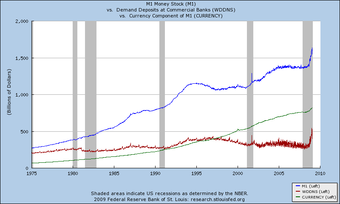
Money supply
In economics, the money supply or money stock, is the total amount of money available in an economy at a specific time.
Money supply data are recorded and published, usually by the government or the central bank of the country. Public and private sector analysts have long monitored changes in money supply because of its possible effects on the price level, inflation and the business cycle.
The different types of money are typically classified as “M”s. The “M”s usually range from M0 (narrowest) to M3 (broadest) but which “M”s are actually used depends on the country’s central bank.
In economics, the monetary base (also base money, money base, high-powered money, reserve money, or, in the UK, narrow money) is a term relating to (but not being equivalent to) the money supply (or money stock) or the amount of money in the economy. The monetary base is highly liquid money that consists of coins, paper money (both as bank vault cash and as currency circulating in the public), and commercial banks’ reserves with the central bank. Measures of money are typically classified as levels of M, where the monetary base is the smallest and lowest M-level: M0. Base money can be described as the most acceptable (or liquid) form of final payment. Broader measures of the money supply also include money that does not count as base money, such as demand deposits (included in M1), and other deposit accounts like the less liquid savings accounts (included in M2), etc. (The narrow money supply is an earlier term used in the U.S. to describe currency held by the non-bank public and demand deposits of banks, M1).
Different Types of Money are Typically Classified as “M”s
- M0: In some countries, such as the United Kingdom, M0 includes bank reserves, so M0 is referred to as the monetary base, or narrow money.
- MB: This is referred to as the monetary base or total currency. This is the base from which other forms of money (like checking deposits) are created and is traditionally the most liquid measure of the money supply.
- M1: Bank reserves are not included in M1.
- M2: Represents money and “close substitutes” for money. M2 is a broader classification of money than M1. Economists use M2 when looking to quantify the amount of money in circulation and trying to explain different economic monetary conditions. M2 is a key economic indicator used to forecast inflation.
- M3: M2 plus large and long-term deposits. Since 2006, M3 is no longer tracked by the U.S. central bank.
The ratio of a pair of these measures, most often M2/M0, is called an (actual, empirical) money multiplier.
Different measures of a nation’s money supply reflect various degrees of asset liquidity, which marks the ease at which a monetary asset can be turned into cash. Liquid assets include coins, paper currency, checkable-type deposits, and traveler’s checks. Less liquid assets include money market deposits and savings account deposits. Measure MI, the most narrow of measures, includes only the most liquid forms of monetary assets; all currency and bank deposits held by a nation’s public. M2, a slightly “broader” measure includes all values incorporated under MI, in addition to assets held in savings accounts, certain time deposits and mutual funds balances.
Money supply is important because it is linked to inflation by the equation of exchange in an equation, MV=PQ, proposed by Irving Fisher in 1911:
- M is the total dollars in the nation’s money supply,
- V is the number of times per year each dollar is spent (velocity of money);
- P is the average price of all the goods and services sold during the year;
- Q is the quantity of assets, goods and services sold during the year.
21.1.4: Control of the Money Supply
A nation’s money supply is determined by the monetary policy actions of its central bank.
Learning Objective
Summarize the argument against the role of open market operations in determining the nation’s money supply
Key Points
- Open market operations, the most dominant instrument of monetary policy, is the behavior of a nation’s central bank to trade or purchase government securities for cash in attempts to expand or contract the total money supply.
- By controlling the national interest rate, a central bank can adequately meet and further dictate the consumer demand for money.
- Under fractional reserve banking, a nation’s central bank is responsible for holding a certain fraction of all deposits as cash or on account with the central bank.
- The central bank’s ability to predict how much money should be in circulation, given current employment rates and inflation rates, is often debated.
Key Terms
- Phillips curve
-
In economics, the Phillips curve is a historical inverse relationship between the rate of unemployment and the rate of inflation in an economy. Stated simply, the lower the unemployment in an economy, the higher the rate of inflation. While it has been observed that there is a stable short run tradeoff between unemployment and inflation, this has not been observed in the long run
- monetary base
-
The monetary base s a term relating to (but not being equivalent to) the money supply; the amount of money in the economy. The monetary base is highly liquid money that consists of coins, paper money (both as bank vault cash and as currency circulating in the public), and commercial banks’ reserves with the central bank.
- open market operations
-
An open market operation (also known as OMO) is an activity by a central bank to buy or sell government bonds on the open market. A central bank uses them as the primary means of implementing monetary policy.
Example
- When a central bank is “easing”, it triggers an increase in money supply by purchasing government securities on the open market thus increasing available funds for private banks to loan through fractional-reserve banking (the issue of new money through loans) and thus the amount of bank reserves and the monetary base rise. By purchasing government bonds (especially Treasury Bills), this bids up their prices, so that interest rates fall at the same time that the monetary base increases.
A nation’s money supply is determined by the monetary policy actions of its central bank. Examples of Central Banks include the Federal Reserve, the Bank of England, and the Bank of Canada, shown here . Commercial banks, as required by the central bank, must keep a fraction of all accepted deposits on reserve either in bank vaults or in central bank deposits. Accordingly, a nation’s central bank can maintain control of such reserves by lending to commercial banks and altering the rate of interest to be charged on such loans. These actions are known as open market operations and allow central banks to achieve a desired level of reserves.

Various Central Banks
Clockwise from top-left: Federal Reserve, Bank of England, European Central Bank, Bank of Canada.
In determining a nation’s money supply, its central bank first sets the supply of the monetary base and upholds certain restrictions on the value of assets and liabilities held by smaller commercial banks. Although the consumer demand for liquidity is dictated by the public, small commercial banks are required to meet consumer demand and do so by identifying certain conditions including a set interest rate which apply to the loaning of bank liabilities. Commercial bank behavior, ultimately regulated by the nation’s central banking institution, and in conjunction with consumer demand define the total stock of money, bank credit, and rates of interest which shape national economic conditions. The value of the money supply is determined by themoney multiplier and the monetary base. The monetary base consists of the total quantity of government-produced money and includes all currency held by the public and reserves held by commercial banks. The central bank retains tight control over its nation’s money supply through the use of open market operations, the discount rate, and reserve requirements.
Open Market Operations
Open market operations, the most dominant instrument of monetary policy, are the behavior of a nation’s central bank to trade or purchase government securities for cash in attempts to expand or contract the total money supply. While purchases of government securities prove to expand the total monetary base, the selling of government securities will ultimately contract a nation’s monetary base.
The Discount Rate
A nation’s central bank is also responsible for supplying commercial banks with enough currency to meet consumer demand. By controlling the national interest rate, a central bank can adequately meet and further dictate the consumer demand for money. A decrease in the interest rate will spark an increase in the consumer demand for money; an increase in the rate of interest will lessen its demand. Changes in the interest rate also play a role in the setting of price levels. Any increase in the demand for money will increase spending levels and cause prices to rise. A decrease in the demand for money will slow spending levels and produce a subsequent decrease in price levels. If consumers expect price levels to fall, the demand for money will increase. If consumers expect price levels to increase, the demand for money will decline.
Reserve Requirements
Under fractional reserve banking, a nation’s central bank is responsible for holding a certain fraction of all deposits as cash or on account with the central bank. Central banks may alter the total money supply by changing the required percentage of total deposits to be held by commercial banks. An increase in reserve requirements would decrease the monetary base; a decrease in the requirements would increase the monetary base.
Criticism
In recent years, some academic economists renowned for their work on the implications of rational expectations have argued that open market operations are irrelevant. The Keynesian side points to a major example of ineffectiveness of open market operations encountered in 2008 in the United States, when short-term interest rates went as low as they could go in nominal terms, so that no more monetary stimulus could occur.
The main functions of the central bank are to maintain low inflation and a low level of unemployment, although these goals are sometimes in conflict (according to Phillips curve). A central bank may attempt to do this by artificially influencing the demand for goods by increasing or decreasing the nation’s money supply (relative to trend), which lowers or raises interest rates, which stimulates or restrains spending on goods and services.
The central bank’s ability to predict how much money should be in circulation, given current employment rates and inflation rates, is often debated. Economists such as Milton Friedman believed that the central bank would always get it wrong, leading to wider swings in the economy than if it were just left alone. This is why they advocated a non-interventionist approach—one of targeting a pre-specified path for the money supply independent of current economic conditions— even though in practice this might involve regular intervention with open market operations (or other monetary-policy tools) to keep the money supply on target.
21.1.5: International Exchange of Money
The foreign exchange market is a form of exchange for international currencies that determines the relative values of different currencies.
Learning Objective
Discuss the factors that influence supply and demand for currencies
Key Points
- Financial centers around the world function as anchors of trading between a wide range of different types of buyers and sellers around the clock, with the exception of weekends.
- The foreign exchange market assists international trade and investment by enabling currency conversion. For example, it permits a business in the United States to import goods from the European Union member states, especially Eurozone members, and pay Euros.
- The foreign exchange market is the most liquid financial market in the world. Traders include large banks, central banks, institutional investors, currency speculators, corporations, governments, other financial institutions, and retail investors.
- At the top is the interbank market, which is made up of the largest commercial banks and securities dealers. Within the interbank market, spreads, which are the difference between the bid and ask prices, are razor sharp and not known to players outside the inner circle.
- Supply and demand for any given currency, and thus its value, are not influenced by any single element, but rather by several. These elements generally fall into three categories: economic factors, political conditions and market psychology.
Key Terms
- floating exchange rate
-
A floating or fluctuating exchange rate is a type of exchange rate regime wherein a currency’s value is allowed to fluctuate according to the foreign exchange market.
- exchange rate
-
An exchange rate between two currencies is the rate at which one currency will be exchanged for another.
- fixed exchange rate
-
Sometimes called a pegged exchange rate, a type of exchange rate regime wherein a currency’s value is matched to the value of another single currency or to a basket of other currencies, or to another measure of value, such as gold.
Example
- For several centuries the developed world operated under a fixed exchange rate system based on the gold standard. The system worked well until WW I and the rapid changes occurring due to industrialization. After the depression in the 1930s, many systems were tried, but the developed world chose to switch back to a fixed exchange rate system after WW II. This was called the Bretton Woods system and included the creation of the IMF (International Monetary Fund).
In finance, an exchange rate (also known as the foreign-exchange rate, forex rate or FX rate) between two currencies is the rate at which one currency will be exchanged for another. It is also regarded as the value of one country’s currency in terms of another currency. For example, an interbank exchange rate of 91 Japanese yen (JPY, ¥) to the United States dollar (US$) means that ¥91 will be exchanged for each US$1 or that US$1 will be exchanged for each ¥91. Exchange rates are determined in the foreign exchange market, which is open to a wide range of different types of buyers and sellers where currency trading is continuous (24 hours a day except weekends, i.e., trading from 20:15 GMT on Sunday until 22:00 GMT Friday). The spot exchange rate refers to the current exchange rate. The forward exchange rate refers to an exchange rate that is quoted and traded today but for delivery and payment on a specific future date .

Exchange Rate
In finance, an exchange rate (also known as the foreign-exchange rate, forex rate or FX rate) between two currencies is the rate at which one currency will be exchanged for another.
In a typical foreign exchange transaction, a party purchases a quantity of one currency by paying a quantity of another currency. The modern foreign exchange market began forming during the 1970s after three decades of government restrictions on foreign exchange transactions (the Bretton Woods system of monetary management established the rules for commercial and financial relations among the world’s major industrial states after World War II), when countries gradually switched to floating exchange rates from the previous exchange rate regime, which remained fixed as per the Bretton Woods system.
The foreign exchange market (forex, FX, or currency market) is a form of exchange for the global decentralized trading of international currencies. Financial centers around the world function as anchors of trading between a wide range of different types of buyers and sellers around the clock, with the exception of weekends. The foreign exchange market determines the relative values of different currencies.
The foreign exchange market assists international trade and investment by enabling currency conversion. For example, it permits a business in the United States to import goods from the European Union member states, especially Eurozone members, and pay Euros, even though its income is in United States dollars. It also supports direct speculation in the value of currencies, and the carry trade, speculation based on the interest rate differential between two currencies.
21.2: Credit
21.2.1: Obtaining Credit
Credit is a term used to denote transactions involving the transfer of money or other property on promise of repayment.
Learning Objective
Describe the concept of credit and how consumers can obtain in for transaction purposes
Key Points
- Credit encompasses any form of deferred payment. Credit does not necessarily require money. The credit concept can be applied in barter economies as well, based on the direct exchange of goods and services.
- Obtaining credit is dependent on the reputation or creditworthiness of the entity which takes responsibility for the funds.
- In the U.S., when a customer fills out an application for credit from a bank, store or credit card company, their information is forwarded to a credit bureau.
- Lenders like to see consumer debt obligations paid regularly and on time, and therefore focus particularly on missed payments and may not, for example, consider an overpayment as an offset for a missed payment. The other factor in determining whether a lender will provide a consumer credit or a loan is dependent on income. The higher the income, all other things being equal, the more credit the consumer can access.
Key Terms
- creditor
-
A person to whom a debt is owed.
- debtor
-
A person or firm that owes money; one in debt; one who owes a debt
- credit report
-
A document of the history and current status of a borrower’s credit standing, and may include identifying information, credit information, public-records information, recent inquiries and credit score.
Example
- A credit card company, which is a type of creditor, will look at information about the potential customer, or debtor, from a credit bureau in order to determine if the company will lend to the potential customer. The credit card company uses the credit report, provided by the credit bureau, to determine if the lender is likely to pay back the loan. The credit history includes information about past borrowing and repaying behavior of the customer.
Credit, in commerce and finance, is a term used to denote transactions involving the transfer of money or other property on promise of repayment, usually at a fixed future date. The transferor thereby becomes a creditor, and the transfer, a debtor; hence credit and debt are simply terms describing the same operation viewed from opposite standpoints.Credit encompasses any form of deferred payment. Credit does not necessarily require money. The credit concept can be applied in barter economies as well, based on the direct exchange of goods and services (Ingham 2004 p. 12-19). However, in modern societies credit is usually denominated by a unit of account. Unlike money, credit itself cannot act as a unit of account. Types of credit include: bank credit, consumer credit, public credit, and investment credit.
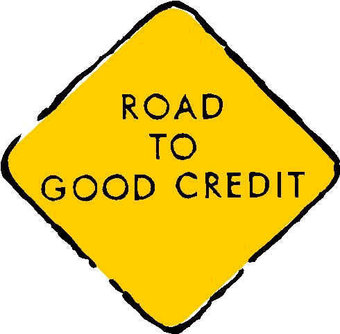
Good Credit
Credit, in commerce and finance, is a term used to denote transactions involving the transfer of money or other property on promise of repayment, usually at a fixed future date.
Obtaining credit is dependent on the reputation or creditworthiness of the entity which takes responsibility for the funds. Credit is also traded in financial markets. The purest form is the credit default swap market, which is essentially a traded market in credit insurance. A credit default swap represents the price at which two parties exchange this risk – the protection “seller” takes the risk of default of the credit in return for a payment, commonly denoted in basis points (one basis point is 1/100 of a percent) of the notional amount to be referenced, while the protection “buyer” pays this premium and in the case of default of the underlying (a loan, bond or other receivable), delivers this receivable to the protection seller and receives from the seller the par amount (that is, is made whole)
Credit history or credit report is, in many countries, a negative record of an individual’s or company’s past borrowing and repaying, including information about late payments and bankruptcy. The term “credit reputation” can either be used synonymous to credit history or to credit score.
In the U.S., when a customer fills out an application for credit from a bank, store or credit card company, their information is forwarded to a credit bureau. The credit bureau matches the name, address and other identifying information on the credit applicant with information retained by the bureau in its files. That’s why it’s very important for creditors, lenders and others to provide accurate data to credit bureaus.
This information is used by lenders such as credit card companies to determine an individual’s credit worthiness; that is, determining an individual’s ability and track record of repaying a debt. The willingness to repay a debt is indicated by how timely past payments have been made to other lenders. Lenders like to see consumer debt obligations paid regularly and on time, and therefore focus particularly on missed payments and may not, for example, consider an overpayment as an offset for a missed payment.
The other factor in determining whether a lender will provide a consumer credit or a loan is dependent on income. The higher the income, all other things being equal, the more credit the consumer can access. However, lenders make credit granting decisions based on both ability to repay a debt (income) and willingness (the credit report) as indicated by a history of regular, unmissed payments. These factors help lenders determine whether to extend credit, and on what terms.
21.2.2: The Five Cs of Credit
Capacity to repay, capital, collateral, conditions, and character, are referred to as the “Five Cs of Credit”.
Learning Objective
Name the Five Cs of credit
Key Points
- Capacity to repay, the most critical of the five factors, indicates to the prospective lender exactly how an individual intends to repay a loan. The lender will consider the cash flow from the business, the timing of the repayment, and the probability of successful repayment of the loan.
- Capital is the value of assets that a debtor currently holds. Potential lenders may expect an individual to communicate their current assets so as to indicate their ability to pay back a loan.
- Collateral is additional form of security you can provide the lender. Giving a lender collateral means that you pledge an asset you own, such as your home, to the lender with the agreement that it will be the repayment source in case you can’t repay the loan.
- Conditions focus on the intended purpose of the loan. Will the money be used for working capital, additional equipment, or inventory? The lender also will consider the local economic climate and conditions both within your industry and in other industries that could affect your business.
- Character is the general impression you make on the potential lender or investor. The lender will form a subjective opinion as to whether or not you are sufficiently trustworthy to repay the loan or generate a return on funds invested in your company.
Key Terms
- collateral
-
A security or guarantee (usually an asset) pledged for the repayment of a loan if one cannot procure enough funds to repay. (Originally supplied as “accompanying” security. )
- capital
-
Money and wealth. The means to acquire goods and services, especially in a non-barter system.
- loan
-
A sum of money or other valuables or consideration that an individual, group, or other legal entity borrows from another individual, group, or legal entity (the latter often being a financial institution) with the condition that it be returned or repaid at a later date (sometimes with interest).
Example
- How might a potential lender use information about a debtor’s capital? For example, a business owner’s capital would be how much they have personally invested in the business and is an indication of how much you have at risk should the business fail. Prospective lenders and investors will expect you to have contributed from your own assets and to have undertaken personal financial risk to establish the business before asking them to commit any funding.
The Five Cs of Credit
Capacity to repay is the most critical of the five factors. The prospective lender will want to know exactly how an individual intends to repay a loan. The lender will consider the cash flow from the business, the timing of the repayment, and the probability of successful repayment of the loan. Payment history on existing credit relationships—personal or commercial—is considered an indicator of future payment performance. Prospective lenders also will want to know about your contingent sources of repayment. Other relevant information includes already existing debts that a debtor may hold.
Capital is the value of assets that a debtor currently holds. A business owner’s capital, for instance, would be how much they have personally invested in the business and is an indication of how much you have at risk should the business fail. Prospective lenders and investors will expect you to have contributed from your own assets and to have undertaken personal financial risk to establish the business before asking them to commit any funding .

Capital
Capital is the value of assets that a debtor currently holds.
Collateral, or guarantees, are additional forms of security that you can provide the lender. Giving a lender collateral means that you pledge an asset you own, such as your home, to the lender with the agreement that it will become the repayment source if you can’t repay the loan. A guarantee, on the other hand, is just that: someone else signs a guarantee document promising to repay the loan if you can’t. Some lenders may require such a guarantee in addition to collateral as security for a loan.
Conditions focus on the intended purpose of the loan. Will the money be used for working capital, additional equipment, or inventory? The lender also will consider the local economic climate and conditions both within your industry and in other industries that could affect your business.
Character is the general impression you make on the potential lender or investor. The lender will form a subjective opinion as to whether or not you are sufficiently trustworthy to repay the loan or generate a return on funds invested in your company. Your employment background and experience in business and in your industry will be reviewed. The quality of your references and the background and experience levels of your employees also will be taken into consideration. A person who seems to have a stable background, indicated by steady employment and housing, is more likely to seem trustworthy to lenders.
An additional, often cited “C” of credit, is credit history, which looks at the debtor’s past uses of credit. Evidence of responsible use and repayment of credit is a good sign to lenders.
21.2.3: Credit Ratings
A credit rating evaluates the credit worthiness of a debtor, specifically a business (company), individual, or a government.
Learning Objective
Distinguish between corporate credit ratings and individual credit ratings
Key Points
- Credit ratings are determined by credit ratings agencies. The credit rating represents the credit rating agency’s evaluation of qualitative and quantitative information for a company or government; including non-public information obtained by the credit rating agencies analysts.
- A short-term rating is a probability factor of an individual going into default within a year. This is in contrast to a long-term rating, which is evaluated over a long time frame.
- A sovereign credit rating is the credit rating of a sovereign entity like a national government. The sovereign credit rating indicates the risk level of the investing environment of a country and is used by investors looking to invest abroad. It takes political risk into account.
- In the United States, an individual credit score is a number based on a statistical analysis of a person’s credit files, that in theory represents the creditworthiness of that person.
- Starting in the early 1970s, the “Big Three” ratings agencies (S&P, Moody’s, and Fitch) began to receive payment for their work by the securities issuers for whom they issue those ratings, which has led to charges that these ratings agencies can no longer always be impartial when issuing ratings for those securities issuers. This problem of vested interests has been cited as one of the primary causes of the subprime mortgage crisis (which began in 2007), when some securities, particularly mortgage backed securities (MBSs) and collateralized debt obligations (CDOs) rated highly by the credit ratings agencies, and thus heavily invested in by many organizations and individuals, were rapidly and vastly devalued due to defaults, and fear of defaults, on some of the individual components of those securities, such as home loans and credit card accounts.
Key Terms
- revolving credit agreement
-
a type of debt that does not have a fixed number of payments
- default
-
The condition of failing to meet an obligation.
- bond
-
Evidence of a long-term debt, by which the bond issuer (the borrower) is obliged to pay interest when due, and repay the principal at maturity, as specified on the face of the bond certificate. The rights of the holder are specified in the bond indenture, which contains the legal terms and conditions under which the bond was issued. Bonds are available in two forms: registered bonds and bearer bonds.
Examples
- How might credit ratings affect companies and other entities that issue debt? Credit ratings may determine, for example, how much a firm or government has to pay to access credit markets (i.e., the amount of interest they pay on their issued debt).
- How might credit ratings affect companies and other entities that issue debt? Credit ratings may determine, for example, how much a firm or government has to pay to access credit markets (i.e., the amount of interest they pay on their issued debt. )
Credit Ratings
A credit rating evaluates the credit worthiness of a debtor, especially a business (company) or a government. It is an evaluation made by a credit rating agency of the debtor’s ability to pay back the debt and the likelihood of default. Credit ratings are determined by credit ratings agencies. The credit rating represents the credit rating agency’s evaluation of qualitative and quantitative information for a company or government; including non-public information obtained by the credit rating agencies analysts. Credit ratings are not based on mathematical formulas. Instead, credit rating agencies use their judgment and experience in determining what public and private information should be considered in giving a rating to a particular company or government. The credit rating is used by individuals and entities that purchase the bonds issued by companies and governments to determine the likelihood that the government will pay its bond obligations.
A poor credit rating indicates a credit rating agency’s opinion that the company or government has a high risk of defaulting, based on the agency’s analysis of the entity’s history and analysis of long term economic prospects.
Sovereign Credit Ratings
A sovereign credit rating is the credit rating of a sovereign entity like a national government. The sovereign credit rating indicates the risk level of the investing environment of a country and is used by investors looking to invest abroad. Ratings are broken down into components including political and economic risk. Euromoney’s bi-annual country risk index monitors the political and economic stability of 185 sovereign countries. Results focus foremost on economics, specifically sovereign default risk and/or payment default risk for exporters (a.k.a. trade credit risk).
The top 10 least risky countries, as of June 2011 are as follows:
- Norway
- Luxembourg
- Switzerland
- Denmark
- Sweden
- Singapore
- Finland
- Canada
- Netherlands
- Germany
Corporate Ratings
A short-term rating is a probability factor of an individual going into default within a year. This is in contrast to a long-term rating, which is evaluated over a long time frame. First, the Basel II agreement requires banks to report their one-year probability if they applied internal ratings-based approach for capital requirements. Second, many institutional investors can easily manage their credit/bond portfolios with derivatives on monthly or quarterly basis. Therefore, some rating agencies simply report short-term ratings.
The credit rating of a corporation is a financial indicator to potential investors of debt securities, such as bonds. The corporate credit rating is usually of a financial instrument such as a bond, rather than the whole corporation. These are assigned by credit rating agencies such as A. M. Best, Dun & Bradstreet, Standard & Poor’s, Moody’s, or Fitch. Ratings have letter designations such as A, B, C. Bond ratings below BBB/Baa are considered to be not investment grade and are colloquially called junk bonds.
Ratings play a critical role in determining how much companies and other entities that issue debt, including sovereign governments, have to pay to access credit markets, such as the amount of interest they pay on their issued debt. The threshold between investment-grade and speculative-grade ratings has important market implications for issuers’ borrowing costs.
Bonds that are not rated as investment-grade bonds are known as high yield bonds or more derisively as junk bonds. The risks associated with investment-grade bonds (or investment-grade corporate debt) are considered significantly higher than those associated with first-class government bonds. The difference between rates for first-class government bonds and investment-grade bonds is called investment-grade spread. The range of this spread is an indicator of the market’s belief in the stability of the economy. The higher these investment-grade spreads (or risk premiums) are, the weaker the economy is considered.
Individual Ratings
In the United States, a credit score is a number based on a statistical analysis of a person’s credit files, that in theory represents the creditworthiness of that person, which is the likelihood that people will pay their bills. A credit score is primarily based on credit report information, typically from one of the three major credit bureaus: Experian, TransUnion, and Equifax. Income is not considered by the major credit bureaus when calculating a credit score.
There are different methods of calculating credit scores. FICO, the most widely known type of credit score, is a credit score developed by FICO, previously known as Fair Isaac Corporation. It is used by many mortgage lenders that use a risk-based system to determine the possibility that the borrower may default on financial obligations to the mortgage lender. All credit scores have to be subject to availability.
The credit bureaus all have their own credit scores: Equifax’s ScorePower, Experian’s PLUS score, and TransUnion’s credit score, and each also sells the VantageScore credit score. In addition, many large lenders, including the major credit card issuers, have developed their own proprietary scoring models.
Studies have shown scores to be predictive of risk in the underwriting of both credit and insurance. Some studies even suggest that most consumers are the beneficiaries of lower credit costs and insurance premiums due to the use of credit scores.
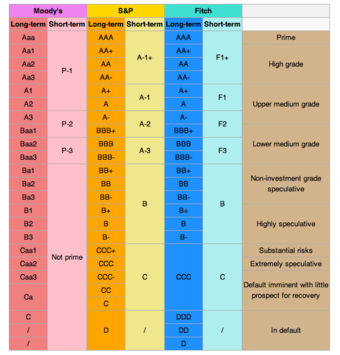
Bond Credit Ratings
Each credit rating agency designates the quality of bonds with letters. This table shows each agency and their respective rating systems.
21.2.4: Collection from Delinquent Payables
Debt compliance describes various legal measures taken to ensure that debtors honor their debts.
Learning Objective
Explain the ramifications of failing to repay credit card and loan debts
Key Points
- A charge-off is the declaration by a creditor that an amount of debt is unlikely to be collected. This occurs when a consumer becomes severely delinquent on a debt. Traditionally, creditors will make this declaration at the point of six months without payment.
- The purpose a charge-off is to give the bank a tax exemption on the debt. However, the charge-off declaration does not free the debtor of having to pay the debt.
- While a charge-off is considered to be “uncollectible” by the bank, the debt is still legally valid and remains as such after the fact. The creditor legally has the right to collect the full amount for a period of time permitted by the laws where the bank is and the consumer reside.
- While a charge-off is considered to be “written off as uncollectable” by the bank, the debt is still legally valid, and remains as such after the fact. The creditor legally has the right to collect the full amount for a time periods permitted the laws of places of the location of the bank and where the consumer resides.
Key Terms
- audit
-
An independent review and examination of records and activities to assess the adequacy of system controls, to ensure compliance with established policies and operational procedures, and to recommend necessary changes in controls, policies, or procedures.
- compliance
-
The accuracy with which a patient follows an agreed treatment plan.
- debt
-
Money that one person or entity owes or is required to pay to another, generally as a result of a loan or other financial transaction.
Examples
- If an individual does not repay borrowed money to a credit card company and 6 months of nonpayment have passed, the credit card company may declare a “charge-off. ” This means that the debt is “written off as uncollectable,” so that the credit card company will get a tax exemption on that debt. The debtor does not get off scott-free, however. The “charge-off” declaration severely negatively impacts the debtor’s credit report and the creditor still has the legal right to collect the full amount over a period of time, depending on permitted local laws.
- There are a number of repercussions for debt noncompliance. For example, a provision of the Federal Debt Collection Procedure Act states that a person or organization indebted to the United States, against whom a judgment lien has been filed, is ineligible to receive a government grant.
Collection from delinquent payables
In finance, the term “debt compliance” describes various legal measures taken to ensure that debtors, whether individuals, businesses, or governments, honor their debts and make an honest effort to repay the money that they owe. Generally, regarded as a subdivision of tax law, debt compliance is most often enforced through a combination of audits and legal restrictions. For example, a provision of the Federal Debt Collection Procedure Act states that a person or organization indebted to the United States, against whom a judgment lien has been filed, is ineligible to receive a government grant. Noncompliance, depending on severity and frequency, may be punished by fine or even incarceration. A charge-off is the declaration by a creditor (usually a credit card account) that an amount of debt is unlikely to be collected. This occurs when a consumer becomes severely delinquent on a debt. Traditionally, creditors will make this declaration at the point of six months without payment. In the United States, Federal regulations require creditors to charge-off installment loans after 120 days of delinquency, while revolving credit accounts must be charged-off after 180 days.Figure 1
The purpose of making such a declaration is to give the bank a tax exemption on the debt. Bad debts and even fraud are simply part of the cost of doing business. The charge-off, though, does not free the debtor of having to pay the debt. A charge-off is one of the most adverse factors that can be listed on an individual’s credit report, greatly impacting an individual’s ability to get credit in the future.
While a charge-off is considered to be “written off as uncollectible” by the bank, the debt is still legally valid, and remains as such after the fact. The creditor legally has the right to collect the full amount for time periods permitted by the laws of places of the location of the bank and where the consumer resides. Depending on the location, this amount of time may be a certain number of years (e.g., 3 to 7 years), or in some places, indefinitely.
Methods of collection that can be used include contacts from internal collections staff, outside collection agencies, or if the amount is large (generally over $1500–$2000), there is the possibility of a lawsuit or arbitration. In the United States, as the charge off number climbs or becomes erratic, officials from the Federal Reserve take a close look at the finances of the bank and may impose various operating strictures on the bank and in the most extreme cases, may close the bank entirely.
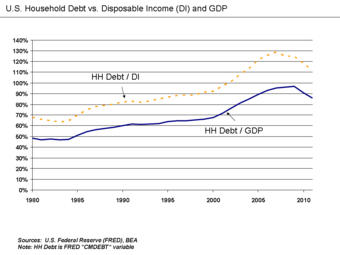
U.S. Household Debt Relative to Disposable Income and GDP 1980-2011
A charge-off is the declaration by a creditor (usually a credit card account) that an amount of debt is unlikely to be collected.
21.2.5: Trends in Credit After 2008
The economic collapse of 2008 had substantial impacts on the banking industry and the availability of credit for borrowers.
Learning Objective
Consider the impact of the 2008 economic collapse on the credit market
Key Points
- The 2008 economic collapse, also referred to as the Sub-Prime Crisis and the Great Recession, had enormous and far-reaching implications on the nature of banking.
- It is important to understand what caused this crisis: irresponsible lending coupled with dishonest description of these loans through bundling them into derivatives. As a result, the process of lending money saw increased scrutiny.
- This massive amount of irresponsible credit lending is well-evidenced by the subsequent foreclosures on millions upon millions of homes in the United States alone between 2007-2015.
- Stipulations on borrowing, such as verification of income and a minimum down payment, have been implemented when pursuing credit.
- Interest rates have remained low despite despite the credit crunch, primarily to incentive spending to spur the economy back into growth.
Key Terms
- derivatives
-
In finance, this is an investment option defined as being valued via the variable valuation of another asset.
- foreclosures
-
Following a default on credit, the lending party is allowed to recapture the capital by repossessing assets (such as the property the money was borrowed to purchase).
The Great Recession, The Housing Bubble, the Sub-Prime Crisis, the Depression of 2007-08— the financial crisis in 2008 is known by quite a few names. When considering the causes of the financial disaster, it is important to note that governments, banks, investors, and borrowers made some bad decisions. At the center of these bad decisions was the lending of capital (credit) to individuals who were unlikely to be able to repay it.
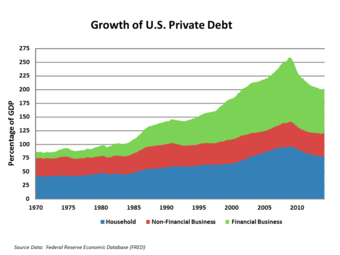
Debt to GDP Ratio
This chart demonstrates the overall percentage of debt owned by governments, companies, and individuals relative to overall GDP. The spike shows how credit before the 2008 disaster was easily obtained (irresponsibly so), and post 2008 the reaction has been a reversal of that trend (albeit, temporarily).
This resulted in what’s called a credit crunch. The credit crunch from the 2008 economic disaster was quite significant, and the scale of the financial collapse was enormous.
Credit Crunch Post-2008
Foreclosures
To understand the trends in decreased lending by the banks, it’s useful to observe the increases in foreclosures (demonstrated risk) that underline the risk banks are taking in the current economy:
- 2007: 2,203,295 foreclosures were filed on 1,285,873 properties during the year, up 75 percent from 2006.
- 2008: 3,157,806 foreclosures were filed on 2,330,483 properties during the year, up 81 percent from 2007.
- 2009: 3,957,643 foreclosures were filed on 2,824,674 properties during the year, up 21 percent from 2008.
- 2010: 3,825,637 foreclosures were filed on 2,871,891 properties during 2010, up nearly 2 percent from the previous year.
- 2011: 1,887,777 properties received foreclosure notices during the year, down 34 percent from last year.
- 2012: 1,836,634 properties received foreclosure notices during the year, down 3 percent from last year.
- 2013: 1,361,795 properties received foreclosure notices during the year, down 26 percent from last year.
- 2014: 1,117,426 properties received foreclosure notices in 2014, a 18 percent decrease over 2013.
- 2015: 1,083,572 properties received foreclosure notices in 2015, a 3 percent decrease over 2014.
Lending
With the above foreclosures in mind, banks were not particularly eager to repeat their past mistakes by offering credit to anyone (and bundling these mortgages into derivatives supposedly labeled as low risk AAA securities, a highly misleading practice that contributed substantially to the problem). As a result, lending became more stringent in terms of proof of income and the required down payments.
Prior to the turn of the 21st century, it was common practice to provide 20% down payment on a loan, alongside providing proof of income (in the United States, that is). Indeed, most developing countries require these types of proofs for a sizable loan such as a mortgage. These rules were removed in the United States, leading the 21st century into a massive increase in homeowner borrowing. Addressing this was a primary concern after the 2008 collapse, building in safety measures to mitigate risk in borrowing for home purchasing.
That being said, spending is good for the economy, so interest rates became quite low post 2008. This is somewhat unusual for a credit crunch, as low interest rates stimulate borrowing. However, creating spend is one tactic for reversing an economic recession, and this is exactly what was done.

Mortgage Rates (US)
This chart shows the rates of interest incurred by borrowers over time in the US mortgage market, most notably highlighting the relative decrease in overall interest rates even after the Great Recession.
21.3: American Banking
21.3.1: Non-Bank Financial Institutions
A non-bank financial institution offers customers bank-related services such as payday lending, cashier’s checks, and check cashing.
Learning Objective
Describe the services offered by non-bank financial institutions
Key Points
- Non-bank financial institutions such as payday lenders will offer consumers relatively small-dollar, short-term, cash loans at a high interest rate.
- While the nature of the loans offered by non-bank financial institutions are not ideal for financing a major purchase like a home or an automobile, they serve as a crucial last resort for those facing an emergency.
- Financial services are equally important in protecting against the unforeseen consequences of natural disasters, war, illness, incapacity or death of a breadwinner, and other crises.
Key Terms
- non-bank financial institution
-
A financial institution that does not have a full banking license or one that is not supervised by a national or international banking regulatory agency.
- currency
-
Money or other items used to facilitate transactions.
Services from Non-Bank Financial Institutions
A non-bank financial institution (NBFI) is a financial institution that does not have a full banking license or is not supervised by a national or international banking regulatory agency. NBFIs facilitate bank-related financial services, such as investments, risk pooling, contractual savings, and market brokering. Examples of these include insurance firms, pawn shops, cashier’s check issuers, check cashing locations, payday lending, currency exchanges, and microloan organizations. Alan Greenspan has identified the role of NBFIs in strengthening an economy, as they provide “multiple alternatives to transform an economy’s savings into capital investment which act as backup facilities should the primary form of intermediation fail. “
Financial services are equally important in protecting against the unforeseen consequences of natural disasters, war, illness, incapacity or death of a breadwinner, and other crises. With financial services, poor families can send their children to school, buy medicine, and get through lean times when cash and food are scarce. Despite the importance of financial services for both poverty reduction and equitable economic growth, experts estimate that only five percent of low-income households around the world have access to such services. The international development community, with a vision it calls “financial sector deepening,” is promoting the extension of diverse financial services by a wide range of bank and non-bank financial institutions to ever larger numbers of low-income and middle-class households around the world.
High-Cost Loans
You have probably seen ads for check-cashing stores, payday loans, and rent-to-own stores. You may be intrigued by the services they offer. But these short-term financial fixes can cost you big bucks because they are ostensibly high-cost loans. Make sure you understand what you’re agreeing to and can afford to pay back your loan before you sign any documents. Consider your options to taking a high-cost loan and use loans wisely.
Check-Cashing Establishments
If you don’t have a checking or savings account, you might think check-cashing stores are a convenient alternative. Understand, however, check-cashing stores charge you for that convenience. Many check-cashing stores charge a fee of $4 for every $100 on a payroll check. That means if you have a $700 payroll check, you’re paying $28 just to cash it. For $28 you might be able to fill your car with gas or buy groceries. For personal checks, these establishments charge even more .

Mural: Checks Cashed
Check-cashing institution on Haight Street, San Francisco, California
Payday Lenders
Many check-cashing stores also make payday loans. A payday loan is a small, high-interest, short-term cash loan. In most cases, you write a post-dated, personal check for the advance amount, plus a fee. The payday lender holds the check for the loan period and then deposits it, or you return with cash to reclaim the check. Although a payday loan may be a convenient short-term solution, it is not a good idea for long-term cash needs. You run the risk of getting into a payday loan cycle of debt by taking out loan after loan
21.3.2: Commercial Banks
Commercial banks enable business by providing access to resources and risk-mitigating exchanges.
Learning Objective
Perceive the role of commercial banks from the business sense, and recognize the variety of risks banks encounter as a result
Key Points
- Commercial banks offer consumers the ability to conduct most of their financial business through a single institution.
- Recently, the U.S. banking industry has become more commercial. Commercial banks generally deal with mid-sized to larger businesses, though due to high consolidation in the industry, they also offer various retail services.
- By enabling the exchange of capital and currency on a global scale via various investment mediums, commercial banks enable businesses with valuable resources.
- While banks offer a wide range of services, the primary service a bank offers revolves around exchanging various capital assets to access funding and mitigate risks.
- Banks themselves must combat a variety of risks themselves, as they are essentially in the business of taking strategic risks. These risks come in a variety of forms.
- The 2008 economic collapse is a strong example of how commercial banks impact the broader economy, and the potential repercussions of failing to manage risk.
Key Term
- Risk management
-
Offsetting potential financial exposures through strategic investments.
Commercial banks are financial institutions that focus on enabling the exchange of capital and currency via a variety of services. For the most part, the term commercial bank refers to divisions of banks that deal primarily with mid-sized to large businesses.
Banking Commercially
When considering commercial banks, it’s useful to understand that they act as an outlet for strategic financial decisions for businesses to offset certain risks, procure resources, invest, and store assets. These services generally include the following:
- Enabling bank accounts, used to store, exchange, send, and receive capital electronically (generally via the internet)
- Providing loans and other lending services, at established rates of interest
- Safekeeping of documents and valuables via safe deposit boxes
- Enabling the purchase of a wide variety of investment options
- Risk management (i.e. foreign exchange risks, interest rates, hedging commodities, derivatives)
- Project financing
- Raising capital (i.e. IPOs and other forms of commercial capital raising)
While banks offer other services in addition to these, the primary function of commercial banks is to act as a critical resource for businesses to access capital, enable investments, and mitigate risks.
Banking Risks and Economic Issues
Banking is, in many ways, in the business of risk. It is in measuring these risks that banks determine their interest rates and fees. There are a few types of risks banks encounter, which are useful in understanding how banks function:
- Credit Risk – Risk that a borrower may not return the entirety of the payment owed.
- Liquidity Risk – Risk that an acquired asset cannot be traded quickly enough to capture profit.
- Market Risk – Virtually any capital asset has a market, and is therefore subjected to the risks of it’s respective market.
- Operational Risk – Risk that an operational issue will diminish returns.
- Reputation Risk – Risk that a company’s trustworthiness will decline.
- Macroeconomic Risk – Risk that the broader economy will decline.
The economic collapse in 2008, partly as a result of banks failing to accurately identify and ethically respond to risk, is a strong example of the consequences of banking failures.
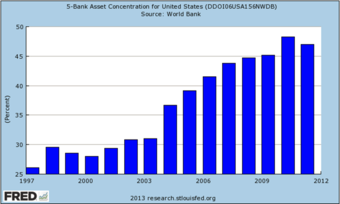
Percent of Industry Assets Owned by the Largest 5 Banks
This image demonstrated the ongoing consolidation of the banking industry, through displaying the overall assets owned by the largest 5 banks.
21.3.3: Savings and Loan Associations (S&Ls)
A savings and loan association is a special kind of deposit institution that only participates in a subsection of financial activities.
Learning Objective
Define a savings and loan association, and its role in the American banking system
Key Points
- A savings and loan association primarily earns income by lending the deposits held at their institution by other members.
- Savings and loan associations tend to be smaller and less complex than commercial banks.
- Savings and loan associations and cooperative banks were established during the 1800s to help factory workers and other wage earners become homeowners.
Key Terms
- savings and loan association
-
A financial institution that specializes in accepting savings deposits and making mortgage and other loans.
- credit union
-
A financial cooperative similar to a bank but owned and controlled by its members, often restricted to a local area or sometimes to a single profession.
A savings and loan association (or S&L), also known as a thrift, is a financial institution that specializes in accepting savings deposits and making mortgage and other loans. The terms “S&L” or “thrift” are mainly used in the United States; similar institutions in the United Kingdom, Ireland, and some Commonwealth countries include building societies and trustee savings banks. They are often mutually held (often called mutual savings banks), meaning that the depositors and borrowers are members with voting rights, and have the ability to direct the financial and managerial goals of the organization like the members of a credit union or the policyholders of a mutual insurance company. While it is possible for an S&L to be a joint stock company, and even publicly traded, in such instances it is no longer truly a mutual association, and depositors and borrowers no longer have membership rights and managerial control. By law, thrifts must have at least 65% of their lending in mortgages and other consumer loans, making them particularly vulnerable to housing downturns, such as the deep one the United States has experienced since 2007.
Savings and loan associations and cooperative banks were established during the 1800s to help factory workers and other wage earners become homeowners. S&Ls accepted savings deposits and used the money to make loans to home buyers. Most of the loans went to people who did not make enough money to be welcomed at traditional banks.
The savings and loan association became a strong force in the early twentieth century through assisting people with home ownership, through mortgage lending, and further assisting their members with basic saving and investing outlets, typically through passbook savings accounts and term certificates of deposit.

Banking district in China
All three note-issuing banks are in this shot: Bank of China, HSBC (Hongkong and Shanghai Banking Corporation), and Standard Chartered Bank.
21.3.4: Credit Unions
Credit unions offer local communities unique banking benefits by empowering local ownership and reinvesting in the community.
Learning Objective
Assess the value of credit unions, particularly compared to big banks and an understanding of risk
Key Points
- Credit unions act as a substitute to traditional larger banks, focusing on providing local communities full ownership, voting rights, and funding through their emphasis on people rather than profits.
- There are a variety of benefits when choosing a credit union instead of a bank, primarily revolving around supporting the community, minimizing risk, and achieving lower rates.
- Credit unions also come with their fair share of downsides, most notably easy global accessibility, the benefits of scale, and access to riskier investment options.
- When making a banking decision, consumers must carefully consider the pros and cons of credit unions before making a decision.
Key Terms
- Credit unions
-
Cooperative banking institutions focused more on people and community, as opposed to profitability and global scale.
- mitigating risk
-
Reducing the potential for losing capital, as well as gaining larger returns, through investing in more volatile options.
Not A Bank
Credit unions are substitutes and competitors of banks, owned by members as a financial cooperative. As a result, credit unions tend to be smaller forms of cooperative banks that avoid borrowing, and operate solely upon the funding and liquidity enabled by the resources deposited by members.
The primary difference between a credit union and a bank from an operational perspective is best described via the decision-making system. The board of directors for a credit union is traditionally elected through a vote of all existing members, where each member gets one vote (regardless of the amount of capital one has invested). Credit unions pride themselves on being community-oriented, deliberately mitigating risk and serving people as opposed to pursuing profit.
The Pros and Cons
There are a variety of valid reasons to support credit unions, as well as a few downsides consumers should also be aware of:
The Good
- Credit unions commit resources to the local community.
- Credit unions usually offer better rates on deposits and lower costs for loans
- Credit unions offer access to borrowing options not always available at traditional banks
- Credit unions provide more personalized service
- Credit unions increase competition (big banks tend to be oligopolies, while credit unions are intrinsically smaller in scale, thus high in quantity)
The Risks
- Credit unions are usually region specific, so traveling can have some complexities in terms of support
- Credit unions are smaller, and therefore more likely to go out of business
- Credit unions are more vulnerable to risk, and thus may not be as willing as larger banks to lend money without confidence in repayment
While there are many considerations to be made when deciding on a banking option, credit unions are uniquely positioned to offset the downsides of big banks through avoiding risk while focusing on local needs. Big banks add advantage through scale (along with risk), providing more investment opportunities and global access to capital.
21.4: Trends in Banking
21.4.1: Electronic Banking
Electronic banking includes such services as ATMs, direct deposits, electronic fund transfers, and online banking.
Learning Objective
Discuss common electronic banking features and services
Key Points
- ATMs can be used to to make a withdrawal, make a deposit, make a loan payment, transfer money from one account to another, or check your account balance.
- Direct deposit makes it possible for you to have your money electronically added to your checking account every payday.
- Electronic funds transfer (EFT) is a service that allows a bank to transfer large amounts of money to another bank by sending an electronic message.
Key Term
- overdraft
-
The act of overdrawing a bank account.
Electronic Banking
The emergence of new technologies has turned banking into a round-the-clock business. Automated teller machines (ATMs) now make it possible for you to do much of your banking whenever you choose . ATMs are computers that are much like limited-service bank branches. You can use them to make a withdrawal, make a deposit, make a loan payment, transfer money from one account to another, or check your account balance. In many cases, automated teller machines of different banks are linked together in networks so you can use them when you travel to a different town, another state, or even another country. All you need is a plastic card from your bank and your own password.

ATM
ATMs are computers that are much like limited-service bank branches. You can use them to make a withdrawal, make a deposit, make a loan payment, transfer money from one account to another, or check your account balance.
Another electronic banking service available today is direct deposit. This service makes it possible for you to have your money electronically added to your checking account every payday. Instead of receiving a paycheck, you receive a statement that tells you your money has been deposited in your account. Direct deposit is popular among people who receive Social Security checks or pension checks because it saves them the trouble of travelling to the bank to deposit them in person.
Electronic funds transfer (EFT) is a service that allows a bank to transfer large amounts of money to another bank by sending an electronic message. Electronic transfers take only an instant. An electronic message instructs a computer to deduct a certain amount of money from one bank account and then add the same amount to another bank account. The message is sent, and the appropriate amount is transferred. No cash or paper changes hands, but money is transferred just the same.
Possibly the most popular advance in banking through the use of technology is online banking. The emergence of online banking has ushered in a new era of convenience and security in managing money. The service is available seven days a week, 24 hours a day. The system gives you the freedom to choose your own banking hours, giving you greater control of your finances. It’s secure, fast, and easy to use. Online banking allows you to check your balance, pay your bills, view statements, transfer funds, view transaction history, and much more. Online banking services include:
- Getting provisional statements
- Making account payments
- Making a once-off payment
- Setting up future-dated payments
- Setting up repeat payments
- Making inter-account transfers
- Stopping debit orders and checks
- Increasing and decreasing overdraft limits
Banks have found online banking so much cheaper than traditional in-bank methods that some have encouraged depositors and other customers to bank from home or via machines by charging them fees for the privilege of talking to a teller! Some banks are completely virtual and have no physical branches. So-called click-and-mortar, or hybrid, banks appear more viable than completely virtual banks at present.
Further technological advances have led to the creation of automated banking machines (ABMs). ABMs are combinations of ATMs, web sites, and dedicated customer service telephone lines that allow customers to make deposits, transfer funds between accounts, or engage in even more sophisticated banking transactions without stepping foot in the bank.
21.4.2: Online Direct Banks
An online direct bank has no physical branches, relying only on internet, phone, and mail services and often delivering better rates to customers.
Learning Objective
Describe direct banking and the drivers behind its success
Key Points
- By eliminating the costs associated with bank branches, direct banks may offer higher interest rates and lower service charges on their products than their traditional competitors.
- The commercialization of the Internet in the early 1990s was the biggest driver in the creation of direct banking models.
- The initial success of internet banking services provided by traditional banks led to the development of internet-only banks or “virtual banks”.
Key Term
- automated teller machine
-
A device that provides bank customers with cash withdrawal and other services without the need for a bank teller.
Direct Banking
A direct bank is a bank without any branch network. It offers its financial services by:
- Telephone banking
- Online banking
- Automated teller machines (often through interbank network alliances)
- Mail banking
- Or mobile banking
By eliminating the costs associated with bank branches, direct banks may offer higher interest rates and lower service charges on their products than their traditional competitors. Direct banks were originally based on providing banking services via telephone. One of the world’s first fully functional direct banks was First Direct, which launched in the United Kingdom on October 1, 1989. First Direct pioneered the concepts of no branches and 24-hour service from a call center.
The commercialization of the Internet in the early 1990s was the biggest driver in the creation of direct banking models. As the Internet became more generally accessible, traditional banks began to realize their potential to deliver services to their customers while reducing long-term operational costs. Upon realizing this, traditional banks began to offer limited online banking services. The initial success of internet banking services provided by traditional banks led to the development of internet-only banks or “virtual banks. ” These banks were designed without a traditional banking infrastructure, a cost-saving feature that allowed many of them to offer savings accounts with higher interest rates and loans with lower interest rates than most traditional banks.
One of the first fully functional direct banks in the United States was the Security First Network Bank (SFNB). Based in Atlanta, it was the first direct bank to be insured by the Federal Deposit Insurance Corporation (FDIC). Though SFNB did not make much profit in its initial years, it demonstrated that the concept of direct banking could work.
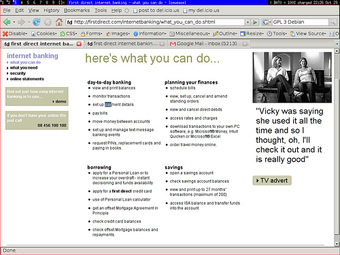
Online Direct Banking
A list of services offered by the First Direct Bank.
21.4.3: Personal Financial Management
Personal finance is the application of the principles of finance to the monetary decisions of an individual or family.
Learning Objective
Give examples of personal financial management
Key Points
- Having rules to dictate when and how much money you set aside for personal savings will help you avoid over-consumption.
- Personal savings should always be kept in the form of liquid assets. This way, should you befall some kind of tragedy, your money will be readily available.
- With all of the financial, investment, and insurance products available to consumers, it is worthwhile to learn about your options in order to find a personal financial management strategy that fits your goals and risk preferences.
Key Terms
- insurance
-
A means of indemnity against a future occurrence of an uncertain event.
- mutual funds
-
A mutual fund is a type of professionally-managed collective investment vehicle that pools money from many investors to purchase securities.
- finance
-
the science of management of money and other assets
Personal Finance Defined
Personal finance is the application of the principles of finance to the monetary decisions of an individual or family. It addresses the ways in which individuals or families obtain, budget, save, and spend monetary resources over time, taking into account various financial risks and future life events. When planning personal finances there are many financial products one might consider: such as banking products (checking, savings accounts, credit cards, and consumer loans), investment products (stock market, bonds, and mutual funds), and insurance products (life insurance, health insurance, and disability insurance). One might also consider individual or employer sponsored retirement plans, social security benefits, and income tax management.
Personal Finance Strategies
Here are ways to start saving more:
Have an emergency savings account. This is an account you can tap into if you lose your job or have major, unforeseen expenses. “Emergency savings will help ensure that you don’t have to borrow from your retirement nest egg or take out additional loans that would push you into debt,” said Luke W. Reynolds, Chief of the FDIC’s Community Affairs Outreach Section. A general rule of thumb is to have enough money in this “rainy day” fund equal to at least two months of living expenses. If your employment outlook is especially uncertain, consider setting aside enough to cover six or more months of anticipated expenses.
Also, keep your emergency savings in an account that will be fairly liquid — such as a bank savings account, money market account, or a short-term certificate of deposit (CD) — so you can withdraw the money relatively quickly, if necessary. “You should probably also keep your emergency money in a deposit account, where your funds are protected by federal deposit insurance, as opposed to stocks or stock or bond mutual funds that can lose value in a volatile market,” said Mary Bass, an FDIC Senior Community Affairs Specialist. Try to save money for long-term goals, such as your retirement. If your employer matches a portion of your payroll contributions to a tax-advantaged retirement savings plan, “not participating means you are passing up free money and perhaps losing out on a valuable tax break,” added Reynolds.
Pay yourself first. That means each month, before you’re tempted to spend money, commit to putting a good bit of it into a savings account. You can write out a check to be deposited into your savings account, but it’s much easier to arrange with your bank to automatically transfer a certain amount from your paycheck or your checking account into your savings. And as you pay your bills, your mortgage and other obligations, take satisfaction in knowing that some of your hard-earned dollars are already saved for you!
Start small. “By consistently saving small amounts, even $25 out of every paycheck, your savings account will grow and you will be motivated to try to save more,” said Reynolds. “Even that spare change you put once a month into a bank savings account can add up faster than you think. “
Review your existing accounts and comparison shop for the best deals. Look at what is being offered by your bank and a few competitors. The idea is to make sure the interest rates are competitive and that the fees and features are appropriate for how you use each account. For example, if your money is sitting in a low-rate checking or savings account, consider moving it to a higher-yielding account, perhaps a CD where the earnings can get an extra boost. Turn a debt payment into a deposit. If you pay off a debt, such as the outstanding balance on a credit card, or if you make that last loan payment on your car, put that money to work as part of your savings.
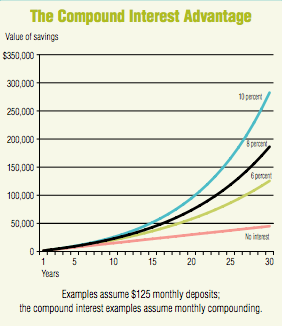
Compound Interest
The chart to the left shows how compound interest at various rates would increase Lynne’s savings compared with simply putting the money in a shoebox. This is compound interest that you earn. And as you can see from an investment, compounding has a greater effect after the investment and interest have increased over a longer period.
21.5: The Federal Reserve System
21.5.1: Introduction to the Federal Reserve
The Federal Reserve System is the central banking system of the United States, which conducts the nation’s monetary policy.
Learning Objective
Describe the primary function and objectives of the Federal Reserve System
Key Points
- By changing the money supply through buying or selling government bonds, the Fed can alter the short-term interest rates. This lowers interest rates, which can stimulate borrowing, spending, and investment, in theory.
- The Fed also supervises and regulates banking institutions, maintains the stability of the financial system, and provides financial services to depository institutions, the government, and foreign institutions.
- The Congress established three key objectives for monetary policy—maximum employment, stable prices, and moderate long-term interest rates.
- The Fed acts independently; it does not have to answer to the president or Congress.
Key Terms
- Federal Reserve System
-
the central banking system in the United States
- monetary policy
-
The process by which the government, central bank, or monetary authority manages the supply of money, or trading in foreign exchange markets.
- depression
-
a period of major economic contraction
What is the Federal Reserve?
The Federal Reserve System (also known as the Federal Reserve, or the “Fed”) is the central banking system of the United States. It was created on December 23, 1913 with the enactment of the Federal Reserve Act, largely in response to a series of financial panics. Over time, the roles and responsibilities of the Federal Reserve System have expanded, and its structure has evolved. Events, such as the Great Depression, were major factors leading to changes in the system.
Congress established three key objectives for monetary policy—maximum employment, stable prices, and moderate long-term interest rates—in the Federal Reserve Act. Its duties have expanded over the years, and today, according to official Federal Reserve documentation, include conducting the nation’s monetary policy, supervising and regulating banking institutions, maintaining the stability of the financial system, and providing financial services to depository institutions, the U.S. government, and foreign official institutions.
The Fed is independent within government in that “its monetary policy decisions do not have to be approved by the President or anyone else in the executive or legislative branches of government. ” Its authority is derived from statutes enacted by the U.S. Congress, and the system is subject to congressional oversight. The members of the board of governors, including its chairman and vice-chairman, are chosen by the president and confirmed by the Senate.
Since the inflation of the 1970s, Federal Reserve monetary policy has emphasized preventing rapid escalation of general price levels. When the general price level is rising too fast, the Federal Reserve acts to slow economic expansion by reducing the money supply, thus raising short-term interest rates.
When the economy is slowing down too fast or contracting, the Federal Reserve increases the money supply, thus lowering short-term interest rates. The most common way it effects these changes in interest rates, called “open-market operations,” is by buying and selling government securities among a small group of major banks and bond dealers.
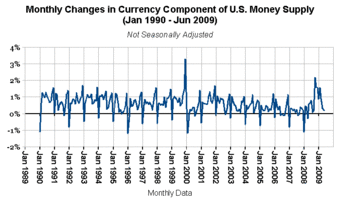
Monthly changes in the currency component of the U.S. money supply as reported by the Federal Reserve
21.5.2: Banking Crises and Centralized Reserve Enforcements
One of the Federal Reserve’s duties is to regulate financial institutions, such as bank-holding companies and state member banks.
Learning Objective
Discuss the Federal Reserve’s powers for enforcing actions due to violations
Key Points
- Generally, the Federal Reserve takes formal enforcement actions against banks for violations of laws, rules, or regulations, unsafe or unsound practices, breaches of fiduciary duty, and violations of final orders.
- Formal enforcement actions include cease and desist orders, written agreements, removal and prohibition orders, and orders assessing civil money penalties.
- The Federal Reserve supervises certain entities and has the statutory authority to take formal enforcement actions against them.
Key Term
- Federal Reserve
-
the central banking system of the United States
The Federal Reserve supervises certain entities and has the statutory authority to take formal enforcement actions against them, including state member banks, bank holding companies, nonbank subsidiaries of bank holding companies, branches and agencies of foreign banking organizations operating in the United States and their parent banks, and officers, directors, employees, and certain other categories of individuals associated with the above banks, companies, and organizations.
Generally, the Federal Reserve takes formal enforcement actions against the above entities for violations of laws, rules, or regulations, unsafe or unsound practices, breaches of fiduciary duty, and violations of final orders. Formal enforcement actions include cease and desist orders, written agreements, removal and prohibition orders, and orders assessing civil money penalties.
Enforcement
If the Federal Reserve determines that a state member bank or bank holding company has problems that affect the institution’s safety and soundness or is not in compliance with laws and regulations, it may take a supervisory action to ensure that the institution undertakes corrective measures. Typically, such findings are communicated to the management and directors of a banking organization in a written report. The management and directors are then asked to address all identified problems voluntarily and to take measures to ensure that the problems are corrected and will not recur.

Bank failure
If the Federal Reserve determines that a state member bank or bank holding company has problems that affect the institution’s safety and soundness or is not in compliance with laws and regulations, it may take a supervisory action to ensure that the institution undertakes corrective measures.
Most problems are resolved promptly after they are brought to the attention of an institution’s management and directors. In some situations, however, the Federal Reserve may need to take an informal supervisory action, requesting that an institution adopt a board resolution or agree to the provisions of a memorandum of understanding to address the problem. If necessary, the Federal Reserve may take formal enforcement actions to compel the management and directors of a troubled banking organization, or persons associated with it, to address the organization’s problems. For example, if an institution has significant deficiencies or fails to comply with an informal action, the Federal Reserve may enter into a written agreement with the troubled institution or may issue a cease-and-desist order against the institution or against an individual associated with the institution, such as an officer or director. The Federal Reserve may also assess a fine, remove an officer or director from office and permanently bar him or her from the banking industry, or both.
21.5.3: The Lender of Last Resort
The U.S. Federal Reserve as the “lender of last resort” extends credit to financial institutions unable to obtain credit elsewhere.
Learning Objective
Explain why the Federal Reserve serves as the “lender of last resort”
Key Points
- There has been some criticism of this particular Fed function, as it shifts responsibility away from lenders and borrowers and adversely affects other parties in the form of inflation.
- Through its discount and credit operations, Reserve Banks provide liquidity to banks to meet short-term needs stemming from seasonal fluctuations in deposits or unexpected withdrawals.
- The rate the Fed charges banks for these loans is the discount rate (officially the primary credit rate).
Key Term
- liquidity
-
An asset’s ability to become solvent without affecting its value; the degree to which it can be easily converted into cash.
Example
- The Fed’s role as lender of last resort played a large role in the aftermath of the 2008 Financial Crisis. The Fed provided loans to support a number of institutions from collapse, including AIG, Bank of America, and Morgan Stanley.
In the United States, the Federal Reserve serves as the lender of last resort to those institutions that cannot obtain credit elsewhere and the collapse of which would have serious implications for the economy. It took over this role from the private sector “clearing houses” which operated during the Free Banking Era; whether public or private, the availability of liquidity was intended to prevent bank runs.
According to the Federal Reserve Bank of Minneapolis, “the Federal Reserve has the authority and financial resources to act as ‘lender of last resort’ by extending credit to depository institutions or to other entities in unusual circumstances involving a national or regional emergency, where failure to obtain credit would have a severe adverse impact on the economy. ” Through its discount and credit operations, Reserve Banks provide liquidity to banks to meet short-term needs stemming from seasonal fluctuations in deposits or unexpected withdrawals. Longer term liquidity may also be provided in exceptional circumstances. The rate the Fed charges banks for these loans is the discount rate (officially the primary credit rate).
By making these loans, the Fed serves as a buffer against unexpected day-to-day fluctuations in reserve demand and supply. This contributes to the effective functioning of the banking system, alleviates pressure in the reserves market and reduces the extent of unexpected movements in the interest rates. For example, on September 16, 2008, the Federal Reserve Board authorized an $85 billion loan to stave off the bankruptcy of international insurance giant American International Group (AIG).
The Federal Reserve System’s role as lender of last resort has been criticized because it shifts the risk and responsibility away from lenders and borrowers and places it on others in the form of inflation.
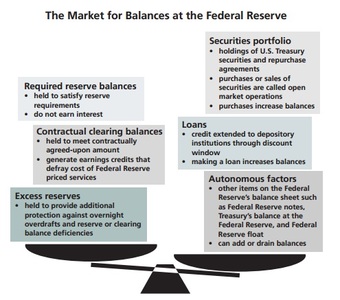
The Market for Balances at the Federal Reserve
21.5.4: The Fed as a Check Clearer
The Fed created a nationwide check-clearing system that provided an efficient and stable way of transferring funds between institutions.
Learning Objective
Explain why a check clearing system was created under the Federal Reserve system
Key Points
- The government of the United States of America is the federal government of the constitutional republic of 50 states that constitute the United States, as well as one capitol district and several other territories.
- A check-clearing system was created in the Federal Reserve system after banks refused to clear checks from certain others during times of economic uncertainty.
- The system, then, was to provide not only an elastic currency—that is, a currency that would expand or shrink in amount as economic conditions warranted—but also an efficient and equitable check-collection system.
Key Term
- Check-clearing
-
The movement of a check from the depository institution at which it was deposited back to the institution on which it was written; the movement of funds in the opposite direction and the corresponding credit and debit to the accounts involved.
Example
- Person A writes a check for $10 and gives it to Person B, who brings it to his banking institution. This part is where the check moves from the depository institution (Person B’s bank) to the institution on which it was drawn (Person A’s). If there are sufficient funds in Person A’s account, the face value of the check ($10 in this case) then moves from A to B, resulting in a debit of $10 to Person A and a credit of $10 to Person B.
The Fed as a Check Clearer
The government of the United States of America is the federal government of the constitutional republic of 50 states that constitute the United States, as well as one capitol district, and several other territories. The federal government is composed of three distinct branches: legislative, executive, and judicial, with powers vested by the U.S. Constitution in the Congress, the President, and the federal courts, including the Supreme Court, respectively; the powers and duties of these branches are further defined by acts of Congress, including the creation of executive departments and courts inferior to the Supreme Court.
Check clearing is defined as “the movement of a check from the depository institution at which it was deposited back to the institution on which it was written, the movement of funds in the opposite direction, and the corresponding credit and debit to the accounts involved. Check clearing also encompasses the return of a check (for insufficient funds, for example) from the bank on which it was written to the bank at which it was deposited, and the corresponding movement of funds. “
Because some banks refused to clear checks from certain others during times of economic uncertainty, a check-clearing system was created in the Federal Reserve system. By creating the Fed, Congress intended to eliminate the severe financial crises that had periodically swept the nation, especially the sort of financial panic that occurred in 1907. During that episode, payments were disrupted throughout the country because many banks and clearinghouses refused to clear checks drawn on certain other banks, a practice that contributed to the failure of otherwise solvent banks. To address these problems, Congress gave the Federal Reserve System the authority to establish a nationwide check-clearing system. The system, then, was to provide not only an elastic currency—that is, a currency that would expand or shrink in amount as economic conditions warranted—but also an efficient and equitable check-collection system.

measures of aggregate balances, 2001-2004
Billions of dollars
21.5.5: The Reserve Requirement
The Federal Reserve is in charge of setting reserve requirements for all depository institutions in the country.
Learning Objective
Discuss what happens when the Fed increases or decreases the reserve requirement
Key Points
- Reserve requirements are the amount of assets against liabilities that depository institutions must hold in reserve.
- A bank’s liabilities are their financial obligations; for instance, if a customer deposits $100 in the bank, that is a liability because the bank must have that $100 to give back if the customer decides to withdraw their money.
- Requiring depository institutions to hold a certain fraction of their deposits in reserve (either as cash in their vaults or as non-interest-bearing balances at the Federal Reserve) directly affects availability of credit.
- An increase in the reserve requirement reduces the amount banks are free to lend out, so this is a contraction in credit that leads to an increase in interest rates. The opposite is true if there is a decrease in the reserve requirement.
Key Terms
- liabilities
-
An amount of money in a company that is owed to someone and has to be paid in the future, such as tax, debt, interest, and mortgage payments.
- reserve requirement
-
The amount of funds that a depository institution must hold in reserve against specified deposit liabilities.
Example
- Suppose that the Fed sets the reserve ratio at 10% for net transaction accounts between $6 million and $15 million. If a bank has deposits totalling $10 million, it must have 10% of that on reserve, so that’s $1 million that the bank cannot lend out.
Reserve requirements have long been a part of the United States banking history. Depository institutions maintain a fraction of certain liabilities in reserve in specified assets. The Federal Reserve can adjust reserve requirements by changing required reserve ratios, the liabilities to which the ratios apply, or both. Changes in reserve requirements can have profound effects on the money stock and on the cost to banks of extending credit and are also costly to administer; therefore, reserve requirements are not adjusted frequently. Nonetheless, reserve requirements play a useful role in the conduct of open market operations by helping to ensure a predictable demand for Federal Reserve balances and thus enhancing the Federal Reserve’s control over the federal funds rate.
Requiring depository institutions to hold a certain fraction of their deposits in reserve, either as cash in their vaults or as non-interest-bearing balances at the Federal Reserve, does impose a cost on the private sector. The cost is equal to the amount of forgone interest on these funds—or at least on the portion of these funds that depository institutions hold only because of legal requirements and not to meet their customers’ needs.
Changes in reserve requirements can affect the money stock, by altering the volume of deposits that can be supported by a given level of reserves, and bank funding costs. Unless it is accompanied by an increase in the supply of Federal Reserve balances, an increase in reserve requirements (through an increase in the required reserve ratio, for example) reduces excess reserves, induces a contraction in bank credit and deposit levels, and raises interest rates. It also pushes up bank funding costs by increasing the amount of non-interest-bearing assets that must be held in reserve. Conversely, a decrease in reserve requirements, unless accompanied by a reduction in Federal Reserve balances, initially leaves depository institutions with excess reserves, which can encourage an expansion of bank credit and deposit levels and reduce interest rates.
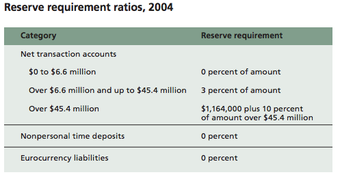
Reserve Requirement
Reserve Requirement Ratios, 2004
21.5.6: The Discount Rate
The Fed makes loans to depository institutions and charges different discount rates for each of discount windows.
Learning Objective
Describe the Fed’s primary credit, secondary credit, and seasonal credit lending programs
Key Points
- The Fed offers three discount window programs to depository institutions: primary credit, secondary credit, and seasonal credit, each with its own interest rate. All discount window loans are fully secured.
- The discount rate charged for primary credit (the primary credit rate) is set above the usual level of short-term market interest rates.
- The discount rate on secondary credit is above the rate on primary credit.
- The discount rate for seasonal credit is an average of selected market rates.
Key Terms
- discount rate
-
The interest rate charged to commercial banks and other depository institutions on loans they receive from their regional Federal Reserve Bank’s lending facility.
- Discount window
-
The discount window is an instrument of monetary policy (usually controlled by central banks) that allows eligible institutions to borrow money from the central bank, usually on a short-term basis, to meet temporary shortages of liquidity caused by internal or external disruptions.
The discount rate is the interest rate charged to commercial banks and other depository institutions on loans they receive from the Fed’s lending facility, the discount window. The Fed offers three discount window programs to depository institutions: primary credit, secondary credit, and seasonal credit, each with its own interest rate. All discount window loans are fully secured.
Under the primary credit program, loans are extended for a very short term (usually overnight) to depository institutions in generally sound financial condition. Depository institutions that are not eligible for primary credit may apply for secondary credit to meet short-term liquidity needs or to resolve severe financial difficulties. Seasonal credit is extended to relatively small depository institutions that have recurring intra-year fluctuations in funding needs, such as banks in agricultural or seasonal resort communities.
The discount rate charged for primary credit (the primary credit rate) is set above the usual level of short-term market interest rates. (Because primary credit is the Federal Reserve’s main discount window program, the Federal Reserve, at times, uses the term “discount rate” to mean the primary credit rate. ) The discount rate on secondary credit is above the rate on primary credit. The discount rate for seasonal credit is an average of selected market rates. Discount rates are established by each reserve bank’s board of directors, subject to the review and determination of the Federal Reserve System’s Board of Governors. The discount rates for the three lending programs are the same across all reserve banks except on days around a change in the rate.
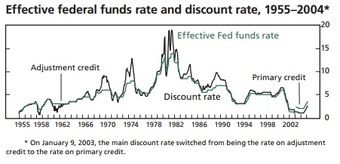
Discount rate
Effective Federal funds rate and discount rate, 1955-2004
21.5.7: Open Market Operations
Open market operations (OMO) refer to a central bank’s selling or buying of government bonds on the open market.
Learning Objective
Define the role and function of an open market operation (OMO)
Key Points
- The Fed’s primary tool in conducting monetary policy is open market operations, which involves the Fed buying or selling securities (usually U.S. treasury bonds) on the open market.
- The Fed’s open market account (their securities holdings associated with open market operations) is composed mostly of U.S. Treasury securities with remaining maturities of one year or less. This allows the Fed to change the composition of its assets quickly, if necessary.
- Buying or selling the bonds changes the supply of base money in the economy, affecting the interest rates.
- The Federal Open Market Committee (FOMC) oversees open market operations.
- In theory, the Federal Reserve could conduct open market operations by purchasing or selling any type of asset. In practice, however, most assets cannot be traded readily enough to accommodate open market operations.
Key Terms
- Open Market Operation
-
an activity by a central bank to buy or sell government bonds on the open market.
- monetary policy
-
The process by which the government, central bank, or monetary authority manages the supply of money, or trading in foreign exchange markets.
Example
- If the economy is contracting, the Fed would want lower interest rates to stimulate borrowing and spending again. They can achieve this through expansionary monetary policy, buying government bonds and increasing the money supply.
Open Market Operation
An open market operation (also known as OMO) is an activity by a central bank (in the U.S. it is the Fed) to buy or sell government bonds on the open market. A central bank uses them as the primary means of implementing monetary policy. The usual aim of open market operations is to control the short term interest rate and the supply of base money in an economy, and thus indirectly control the total money supply. This involves meeting the demand of base money at the target interest rate by buying and selling government securities, or other financial instruments. Monetary targets, such as inflation, interest rates, or exchange rates, are used to guide this implementation.
In theory, the Federal Reserve could conduct open market operations by purchasing or selling any type of asset. In practice, however, most assets cannot be traded readily enough to accommodate open market operations. For open market operations to work effectively, the Federal Reserve must be able to buy and sell quickly, at its own convenience, in whatever volume may be needed to keep the federal funds rate at the target level. These conditions require that the instrument it buys or sells be traded in a broad, highly active market that can accommodate the transactions without distortions or disruptions to the market itself. The market for U.S. Treasury securities satisfies these conditions. The U.S. Treasury securities market is the broadest and most active of U.S. financial markets. Transactions are handled over the counter, not on an organized exchange. Although most of the trading occurs in New York City, telephone and computer connections link dealers, brokers, and customers—regardless of their location—to form a global market.
Composition of the Federal Reserve’s Portfolio
The overall size of the Federal Reserve’s holdings of Treasury securities depends principally on the growth of Federal Reserve notes; however, the amounts and maturities of the individual securities held depends on the FOMC’s preferences for liquidity. A sizable share of the Federal Reserve’s holdings is held in Treasury securities with remaining maturities of one year or less. This structure provides the Federal Reserve with the ability to alter the composition of its assets quickly when developments warrant. At the end of 2004, the Federal Reserve’s holdings of Treasury securities were about evenly weighted between those with maturities of one year or less and those with maturities greater than one year.
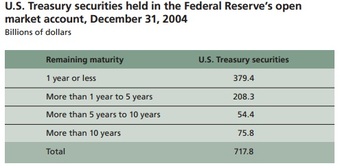
U.S. Treasury securities held in the Federal Reserve’s open market account, December 31, 2004
In billions of dollars.
21.6: Protection of Funds
21.6.1: The Federal Deposit Insurance Corporation (FDIC)
The Federal Deposit Insurance Corporation is an independent agency whose mandate is to maintain stability and public confidence in financial system.
Learning Objective
Discuss the history and role of the FDIC
Key Points
- The FDIC promotes public confidence in the U.S. financial system by insuring depositors for at least $250,000 per insured bank.
- The FDIC receives no Congressional appropriations; it is funded by premiums that banks and thrift institutions pay for deposit insurance coverage and from earnings on investments in U.S. Treasury securities.
- The FDIC insures deposits only. It does not insure securities, mutual funds, or similar types of investments that banks and thrift institutions may offer.
- The FDIC was created in 1933 in response to the thousands of bank failures that occurred in the 1920s and early 1930s.
Key Term
- FDIC
-
The Federal Deposit Insurance Corporation (FDIC) is a United States government corporation operating as an independent agency that provides deposit insurance, which guarantees the safety of deposits in member banks, up to $250,000 per depositor per bank.
Example
- As of April 16, 2012, the members of the Board of Directors of the FDIC are Martin J. Gruenberg (Acting Chairman of the Board), Thomas M. Hoenig, Jeremiah O. Norton, Thomas J. Curry (Comptroller of the Currency), and Richard Cordray (Director, Consumer Financial Protection Bureau).
The Federal Deposit Insurance Corporation (FDIC)
The Federal Deposit Insurance Corporation (FDIC) is an independent agency created by the Congress to maintain stability and public confidence in the nation’s financial system by insuring deposits, examining and supervising financial institutions for safety and soundness and consumer protection, and managing receiverships. The FDIC promotes public confidence in the United States financial system by insuring depositors for at least $250,000 per insured bank. This is accomplished by identifying, monitoring, and addressing risks to the deposit insurance funds and by limiting the effect on the economy and the financial system when a bank or thrift institution fails.
An independent agency of the federal government, the FDIC was created in 1933 in response to the thousands of bank failures that occurred in the 1920s and early 1930s. Since the start of FDIC insurance on January 1, 1934, no depositor has lost a single cent of insured funds as a result of a failure. The FDIC receives no Congressional appropriations; it is funded by premiums that banks and thrift institutions pay for deposit insurance coverage and from earnings on investments in U.S. Treasury securities. The FDIC insures more than $7 trillion of deposits in U.S. banks and thrifts—deposits in virtually every bank and thrift in the country .
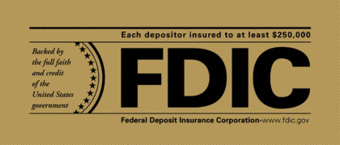
FDIC
The Federal Deposit Insurance Corporation (FDIC) is an independent agency created by the Congress to maintain stability and public confidence in the nation’s financial system.
United States banks and credit unions are closely regulated and supervised to ensure that consumer money is safe. Banks and credit unions are required to comply with regulations.The Federal Deposit Insurance Corporation (FDIC) insures deposit accounts for banks and the National Credit Union Administration for credit unions.
In order to counter banks that engage in excessive risk taking, programs were developed for early intervention. The FDIC Improvement Act of 1991 limits regulators’ discretion as to when to close troubled financial institutions (FIs). It requires that troubled FIs be recognized long before they become insolvent. For example, within 90 days of detection, critically undercapitalized FIs with tangible equity of less than 2% of assets must be placed in conservatorship or receivership. Public FIs can also utilize specific regulations to reallocate portfolios in ways that are deemed to be financially sound and socially beneficial. A good example is the prohibition against lending more than 10% of a bank’s capital to any one borrower.
21.6.2: The National Credit Union Administration (NCUA)
The NCUA is the independent federal agency created by the U.S. Congress to regulate, charter, and supervise federal credit unions.
Learning Objective
Describe the NCUA and its role in the United States
Key Points
- As the insurer and regulator of Federally chartered credit unions, the NCUA oversees credit union safety and soundness, much like the FDIC.
- To protect against the failure of credit unions, NCUA implemented a 12-month examination cycle for federally insured credit unions to detect problems in individual credit unions before they became insurmountable.
- The NCUA is governed by a three-member board appointed by the President of the United States and confirmed by the United States Senate. The president also chooses which member will serve in the position of chairman.
Key Term
- NCUA
-
The National Credit Union Administration (NCUA) is the independent federal agency created by the U.S. Congress to regulate, charter, and supervise federal credit unions.
Example
- On March 20, 2009, during the financial crisis of 2007–2010, the NCUA took over the two largest corporate credit unions with combined assets of $57 billion, because of the losses on their investments in mortgage-backed securities.
The National Credit Union Administration (NCUA)
The National Credit Union Administration (NCUA) is the United States independent federal agency that supervises and charters federal credit unions. NCUA also insures savings in federal- and most state-chartered credit unions across the country through the National Credit Union Share Insurance Fund (NCUSIF), a federal fund backed by the full faith and credit of the United States government. The chartering of credit unions in all states is due to the signing of the Federal Credit Union Act by President Franklin D. Roosevelt in 1934 as part of the New Deal. The federal law sought to make credit available and promote thrift through a national system of nonprofit, cooperative credit unions.
At first, the newly created Bureau of Federal Credit Unions was housed at the Farm Credit Administration. Responsibility for regulation would shift over the years as the agency migrated from the Federal Deposit Insurance Corporation to the Federal Security Agency, then to the Department of Health, Education, and Welfare.
As the insurer and regulator of federally chartered credit unions, the NCUA oversees credit union safety and soundness, much like the FDIC. It is sometimes required to place credit unions in conservatorship. On March 20, 2009, during the financial crisis of 2007–2010, the NCUA took over the two largest corporate credit unions with combined assets of $57 billion because of the losses on their investments in mortgage-backed securities.
The National Credit Union Share Insurance Fund (NCUSIF) is the federal fund created by Congress in 1970 to insure member’s deposits in federally insured credit unions. On July 22, 2010, the Dodd-Frank Wall Street Reform and Consumer Protection Act was signed into law and included permanently establishing the NCUA’s standard maximum share insurance amount at $250,000. All deposit insurance resources reflect this higher level of coverage. Credit unions may also offer an array of additional financial services which are not covered by federal insurance.
21.6.3: The Savings Association Insurance Fund (SAIF)
Between 1989 and 2006, there were two separate FDIC funds–Bank Insurance Fund (BIF), and Savings Association Insurance Fund (SAIF).
Learning Objective
Explain why the Bank Insurance Fund and the Savings Association Insurance Fund were merged into the Deposit Insurance Fund
Key Points
- The existence of two separate funds for the same purpose led to banks attempting to shift from one fund to another, depending on the benefits each could provide. In the 1990s, SAIF premiums were, at one point, five times higher than BIF premiums.
- In February 2006, President George W. Bush signed into law the Federal Deposit Insurance Reform Act of 2005 (FDIRA), which resulted in the merging of the Bank Insurance Fund (BIF) and the Savings Association Insurance Fund (SAIF) into a new fund, the Deposit Insurance Fund (DIF).
- Bank failures typically represent a cost to the DIF, because the FDIC, as receiver of the failed institution, must liquidate assets that have declined substantially in value while, at the same time, making good on the institution’s deposit obligations.
Key Term
- SAIF
-
One of the two FDIC fund between 1989 and 2006, after which it merged with the Bank Insurance Fund to form the Deposit Insurance Fund in 2006
Example
- In the 1990s, SAIF premiums were, at one point, five times higher than BIF premiums; several banks attempted to qualify for the BIF, with some merging with institutions qualified for the BIF to avoid the higher premiums of the SAIF. This drove up the BIF premiums as well, resulting in a situation where both funds were charging higher premiums than necessary.
Between 1989 and 2006, there were two separate FDIC funds—the Bank Insurance Fund (BIF) and the Savings Association Insurance Fund (SAIF). The latter was established after the savings and loans crisis of the 1980s. The existence of two separate funds for the same purpose led to banks attempting to shift from one fund to another, depending on the benefits each could provide. In the 1990s, SAIF premiums were, at one point, five times higher than BIF premiums. Alan Greenspan, Chairman of the Federal Reserve, was a critic of the system, saying, “We are, in effect, attempting to use government to enforce two different prices for the same item – namely, government-mandated deposit insurance. Such price differences only create efforts by market participants to arbitrage the difference.” Greenspan proposed “to end this game and merge SAIF and BIF” .

FDIC office in Arlington, VA
Between 1989 and 2006, there were two separate FDIC funds—the Bank Insurance Fund (BIF), and the Savings Association Insurance Fund (SAIF).
In February 2006, President George W. Bush signed into law the Federal Deposit Insurance Reform Act of 2005 (FDIRA),which contained changes to implement deposit insurance reform, as well as a number of study and survey requirements. Among the highlights of this law was merging the BIF and the SAIF into a new fund, the Deposit Insurance Fund (DIF). This change was made effective March 31, 2006. The FDIC maintains the DIF by assessing depository institutions an insurance premium. The amount each institution is assessed is based both on the balance of insured deposits, as well as on the degree of risk the institution poses to the insurance fund.
Typically, bank failures represent a cost to the DIF because the FDIC, as receiver of the failed institution, must liquidate assets that have declined substantially in value while, at the same time, making good on the institution’s deposit obligations.
Chapter 20: Managing Information Technology
20.1: Information Technology Trends
20.1.1: Hardware and Software Improvements
To keep up with evolving consumer and market trends, both hardware and software components have seen drastic improvements.
Learning Objective
Outline the recent technology trends in both hardware and software improvements
Key Points
- Unlike standard RAM computer memory, in which the user supplies a memory address and the RAM returns the data word stored at that address, a CAM is designed such that the user supplies a data word and the CAM searches its entire memory to see if that data word is stored anywhere in it.
- CMOS logic gates have allowed computing to become a commodity which is now ubiquitous—embedded in many forms, from greeting cards and telephones to satellites.
- Improvements in software can largely be attributed to the implementation of software development models, such as the waterfall model, the spiral model, and agile software development.
Key Terms
- CMOS
-
Complementary metal–oxide–semiconductor (CMOS) is technology for constructing integrated circuits. CMOS technology is used in microprocessors, microncontrollers, static RAM and other digital logic circuits.
- CPU
-
The main computer case containing the central components of a personal computer.
Today’s technology is rapidly evolving. To keep up with consumer and market trends, both hardware and software components have seen drastic improvements.
Hardware Improvements
The 21st century has seen the rise of multi-core CPUs. Content-addressable memory (CAM) has become inexpensive enough to be used in networking. CAM is a special type of computer memory used in certain very high speed searching applications. Unlike standard computer memory (random access memory or RAM) in which the user supplies a memory address and the RAM returns the data word stored at that address, a CAM is designed such that the user supplies a data word and the CAM searches its entire memory to see if that data word is stored anywhere in it. If the data word is found, the CAM returns a list of one or more storage addresses where the word was found. Because a CAM is designed to search its entire memory in a single operation, it is much faster than RAM in virtually all search applications.
CMOS logic gates have allowed computing to become a commodity which is now ubiquitous—embedded in many forms, from greeting cards and telephones to satellites. Fiber-optic and photonic devices, which already have been used to transport data over long distances, are now entering the data center—side by side with CPU and semiconductor memory components. This allows the separation of RAM from CPU by optical interconnects.
Software Improvements
Improvements in software can largely be attributed to the implementation of software development models. One example is the waterfall model . The waterfall model shows a process where software developers are to follow these phases in order:
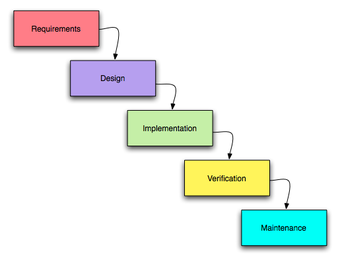
The Waterfall Model
A diagram laying out the steps of the waterfall model for software development.
- Requirements specification (Requirements analysis)
- Software design
- Implementation and Integration
- Testing (or Validation)
- Deployment (or Installation)
- Maintenance
Reviews may occur before moving to the next phase, which allows for the possibility of changes. Reviews may also be employed to ensure that the phase is indeed complete. The phase completion criteria are often referred to as a “gate” that the project must pass through to move to the next phase. Waterfall discourages revisiting and revising any prior phase once it’s complete.
Another example is the spiral model . The key characteristic of a spiral model is risk management at regular stages in the development cycle. This model combines some key aspects of the waterfall model and rapid prototyping methodologies, but provides emphasis in deliberate iterative risk analysis, particularly suited to large-scale, complex systems. The spiral is visualized as a process passing through some number of iterations, with the four-quadrant diagram representative of the following activities:

Spiral Model
A diagram laying out the steps in the spiral model of software development.
- Formulate plans to identify software targets, implement the program, clarify the project development restrictions.
- Risk analysis or assessment of selected programs, to consider how to identify and eliminate risk.
- Implementation of software development and verification.
- Plan the next iteration.
The spiral model has some restrictive conditions, as follows:
- The spiral model emphasizes risk analysis, and thus requires customers to accept this analysis and act on it. This requires both trust in the developer as well as the willingness to spend more to fix the issues, which is the reason why this model is often used for large-scale internal software development.
- If the implementation of risk analysis will greatly affect the profits of the project, the spiral model should not be used.
- Software developers have to actively look for possible risks, and analyze it accurately for the spiral model to work.
The first stage is to formulate a plan to achieve the objectives with these constraints, and then strive to find and remove all potential risks through careful analysis and, if necessary, by constructing a prototype.
A third model is known as agile software development. Agile software development uses iterative development as a basis but advocates a lighter and more people-centric viewpoint than traditional approaches . Agile processes use feedback, rather than planning, as their primary control mechanism. The feedback is driven by regular tests and releases of the evolving software.

Agile Software Development
A poster outlining the principles of agile software development.
20.1.2: Consumerization of IT
Consumerization is the growing tendency for new IT to emerge first in the consumer market and then spread into business and government organizations.
Learning Objective
Explain the business and technology implications of consumerization in the technology industry
Key Points
- It was the growth of the World Wide Web in the mid 1990s that began the modern pattern of consumerization. In particular the rise of free, advertising-based services such as email and search engines.
- The primary impact of consumerization is that it is forcing businesses, especially large enterprises, to rethink the way they procure and manage IT equipment and services.
- Products have become easier to use, and cloud-based, software-as-a-service offerings are addressing an ever-widening range of business needs in areas such as video-conferencing, digital imaging, business collaboration, salesforce support and systems back-up.
- One of the more serious, negative implications of consumerization is that security controls have been slower to be adopted in the consumer space.
- The giant data centers that have been and are being built by firms such as Google, Apple, Amazon and others are far larger and generally much more efficient than the data centers used by most large enterprises.
Key Terms
- customer relationship management
-
Customer relationship management (CRM) is a widely implemented model for managing a company’s interactions with customers, clients and sales prospects.
- cloud
-
Regarded as an amorphous omnipresent space for processing and storage on the Internet; the focus of cloud computing.
- server
-
A computer or a program which provides services to other programs or users, either in the same computer or over a computer network.
Consumerization is the growing tendency for new information technology to emerge first in the consumer market and then spread into business and government organizations. The emergence of consumer markets as the primary driver of information technology innovation is seen as a major IT industry shift, as large business and government organizations dominated the early decades of computer usage and development .
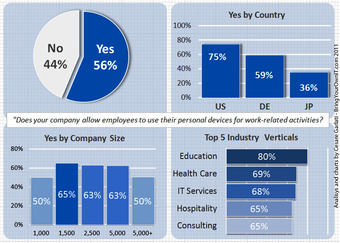
Consumerization Facts – Part 1
A survey was conducted in June 2011 in the U.S., Germany and Japan among IT personnel. It found that consumerization has reached a tipping point.
It was the growth of the World Wide Web in the mid 1990s that began the modern pattern of consumerization. In particular the rise of free, advertising-based services such as email and search engines from companies like Hotmail and Yahoo! began to establish the idea that consumer IT offerings based on a simple Internet browser were often viable alternatives to traditional business computing approaches. In recent years, this view has become increasingly accepted due to the widespread reliance on free, advertising-based services from a growing number of firms such as Google, Facebook and Twitter .
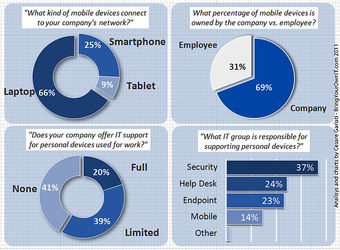
Consumerization Facts – Part 2
The report also found that a strategic approach to consumerization starts with providing IT support to personal devices.
Business Implications
The primary impact of consumerization is that it is forcing businesses, especially large enterprises, to rethink the way they procure and manage IT equipment and services. Historically, central IT organizations controlled the great majority of IT usage within their firms—choosing or, at least, approving the systems and services that employees used. Today, employees and departments are becoming increasingly self-sufficient in meeting their IT needs. Products have become easier to use, and cloud-based, software-as-a-service offerings are addressing an ever-widening range of business needs in areas such as video-conferencing, digital imaging, business collaboration, salesforce support and systems back-up.
Equally important is the fact that large enterprises have become increasingly dependent upon consumerized services that provide search capabilities, mapping, and social interaction. The capabilities of firms such as Google, Facebook and Twitter are now essential components of many firms’ marketing strategies. One of the most important consumerization questions going forward is to what extent such advertising-based services will spread into major corporate applications such as email, Customer Relationship Management (CRM), and Intranets.
One of the more serious, negative implications of consumerization is that security controls have been slower to be adopted in the consumer space. As a result, there is an increased risk to the information assets accessed through these less trustworthy consumerized devices . This shortcoming may soon be remedied by the chip manufacturers through technologies such as Intel’s “Trusted Execution Technology” and ARM’s “Trust Zone. “
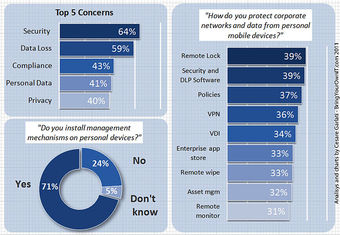
Consumerization Facts – Part 3
Lastly, the report found that new IT tools reduce security risks and management costs.
Technology Implications
In addition to the mass market changes above, consumer markets are now changing large scale computing as well. The giant data centers that have been and are being built by firms such as Google, Apple, Amazon and others are far larger and generally much more efficient than the data centers used by most large enterprises. For example, Google is said to support over 300 million Gmail accounts, while executing more than 1 billion searches per day. Supporting these consumer-driven volumes requires new levels of efficiency and scale, and this is transforming many traditional data center approaches and practices. Among the major changes are reliance on low cost, commodity servers, N+1 system redundancy, and largely unmanned data center operations.
20.1.3: Types of Networks
Networks are often classified by their physical or organizational extent, their purpose, their usage, trust level, and access rights.
Learning Objective
Compare the usage, trust level, and access rights of the main technology networks
Key Points
- A personal area network (PAN) is a computer network used for communication among computer and information technological devices close to one person.
- A local area network (LAN) is a network that connects computers and devices in a limited geographical area such as a home, school, computer laboratory, office building, or closely positioned group of buildings.
- A wide area network (WAN) is a computer network that covers a large geographic area such as a city, country, or even intercontinental distances, using a communications channel that combines many types of media such as telephone lines, cables, and air waves.
- A backbone network is part of a computer network infrastructure that interconnects various pieces of network, providing a path for the exchange of information between different LANs or subnetworks.
- A virtual private network (VPN) is a computer network in which some of the links between nodes are carried by open connections or virtual circuits in some larger network (e.g., the Internet) instead of by physical wires.
Key Term
- hypervisor
-
A software or firmware system that provides a virtual machine and allows it to operate directly on underlying hardware (instead of via emulation), but within specified constraints
Networks are often classified by their physical or organizational extent or their purpose. Usage, trust level, and access rights differ between these types of networks, outlined below.
Personal Area Network (PAN)
A personal area network (PAN) is a computer network used for communication among computer and information technological devices close to one person. Devices used in a PAN include personal computers, printers, fax machines, telephones, PDAs, scanners, and even video game consoles. Home area networks (HANs) are very similar to PANs.
Local Area Network (LAN)
A local area network (LAN) is a network that connects computers and devices in a limited geographical area such as home, school, computer laboratory, office building, or closely positioned group of buildings. Each computer or device on the network is a node. The defining characteristics of LANs, in contrast to WANs (wide area networks), include their higher data transfer rates, smaller geographic range, and no need for leased telecommunication lines. LANs can be connected to wide area networks by using routers.
Wide Area Network (WAN)
A wide area network (WAN) is a computer network that covers a large geographic area such as a city, country, or even intercontinental distances, using a communications channel that combines many types of media such as telephone lines, cables, and air waves. A WAN often uses transmission facilities provided by common carriers, such as telephone companies.
Storage Area Network (SAN)
A storage area network (SAN) is a dedicated network that provides access to consolidated, block level data storage. SANs are primarily used to make storage devices, such as disk arrays, tape libraries, and optical jukeboxes, accessible to servers so that the devices appear as locally-attached devices to the operating system. A SAN typically has its own network of storage devices that are not accessible through the local area network by other devices.
Campus Area Network (CAN)
A campus area network (CAN) is a computer network made up of an interconnection of LANs within a limited geographical area. The networking equipment (switches, routers) and transmission media (optical fiber, copper plant, Cat5 cabling, etc.) are almost entirely owned by the campus tenant or owner: an enterprise, university, government, etc. In the case of a university campus-based campus network, the network is likely to link a variety of campus buildings — including, for example, academic colleges or departments, the university library, and student residence halls. CANs are similar to metropolitan area networks (MANs), which usually span cities or large campuses.
Backbone Network
A backbone network is part of a computer network infrastructure that interconnects various pieces of network, providing a path for the exchange of information between different LANs or subnetworks. A backbone can tie together diverse networks in the same building, in different buildings in a campus environment, or over wide areas. Normally, the backbone’s capacity is greater than that of the networks connected to it.
A large corporation which has many locations may have a backbone network that ties all of these locations together — for example, if a server cluster needs to be accessed by different departments of a company which are located at different geographical locations. The equipment which ties these departments together constitute the network backbone. Network performance management, including network congestion, are critical parameters taken into account when designing a network backbone. Backbone networks are similar to enterprise private networks.
Virtual Private Network (VPN)
A virtual private network (VPN) is a computer network in which some of the links between nodes are carried by open connections or virtual circuits in some larger network (e.g., the Internet) instead of by physical wires. The data link layer protocols of the virtual network are said to be tunneled through the larger network when this is the case. One common application is secure communications through the public Internet, but a VPN need not have explicit security features, such as authentication or content encryption. VPNs, for example, can be used to separate the traffic of different user communities over an underlying network with strong security features.
Virtual Network
Not to be confused with a Virtual Private Network, a Virtual Network defines data traffic flows between virtual machines within a hypervisor in a virtual computing environment. Virtual Networks may employ virtual security switches, virtual routers, virtual firewalls, and other virtual networking devices to direct and secure data traffic.

The Internet changed the way the world produces and consumes information
The Internet, represented in this photo, is an aggregation of the different computer networks spanning the globe.
20.2: Decision Making
20.2.1: Expert Systems
An expert system consists of both an inference engine and a knowledge base and has decision-making abilities.
Learning Objective
Break down expert systems to the inference engine, the knowledge base, and conversational
Key Points
- In the 1980s, a third component was added to most expert systems: A dialog interface to communicate with users. This ability to conduct a conversation with users was later called “conversational. “
- In expert system technology, the knowledge base is expressed with natural language rules, such as if-then statements. For example: “If it is living then it is mortal. ” This dialog interface has the advantage of speaking in everyday language, which is very rare in computer science.
- Knowledge-based systems are artificial intelligent tools working in a narrow domain to provide intelligent decisions with justification. Knowledge is acquired and represented using various knowledge representation techniques, rules, frames and scripts.
Key Terms
- artificial intelligence
-
The branch of computer science dealing with the reproduction or mimicking of human-level intelligence, self-awareness, knowledge, conscience, thought in computer programs.
- knowledge base
-
A database designed to meet the complex storage and retrieval requirements of computerized knowledge management, especially in support of artificial intelligence or expert systems.
Example
- An expert system in use in the financial services field is its use during the approval process for mortgages. Loan departments tend to use expert systems for smaller amount mortgage requests because of the growing cost of labor, which makes the handling and acceptance of relatively smaller loans less profitable.
Definition of an Expert System
An expert system has a unique structure, different from traditional computer programs. It is divided into two parts: One fixed and independent of the expert system—the inference (reasoning) engine, and one variable—the knowledge base. To run an expert system, the engine uses the knowledge base in the same way that a human reasons. In the 1980s, a third component was added to most expert systems: A dialog interface to communicate with users. This ability to conduct a conversation with users was later called “conversational. ” In expert system technology, the knowledge base is expressed with natural language rules, such as “if-then” statements. For example: “If it is living then it is mortal. ” This dialog interface has the advantage of speaking in everyday language, which is very rare in computer science (a classic computer program must be written in a specific programming language in order for the computer to understand and carry out instructions) .

Robots Are a Type of Expert System.
Expert systems have decision-making abilities, just like their human counterparts.
Knowledge-based Systems
Knowledge based systems are artificial intelligent tools working in a narrow domain to provide intelligent decisions with justification. Knowledge is acquired and represented using various knowledge representation techniques, rules, frames and scripts. The basic advantages offered by such a system are documentation of knowledge, intelligent decision support, self learning, reasoning and explanation. Knowledge-based systems are systems based on the methods and techniques of artificial Intelligence. Their core components are
- Knowledge base
- Acquisition mechanisms
- Inference mechanisms (reasoning ability)
Knowledge base systems (KBS) go beyond the decision support philosophy to incorporate expert system technology into the decision-making framework. Expert systems (ES) have been the tools and techniques perfected by artificial intelligence (AI) researchers to deduce decision influences based on the codification of knowledge and applying rules, such as if-then statements.
20.2.2: Informed Decisions
Effectively transforming data into actionable information is the key to using information technology to improve decision making.
Learning Objective
Infer how managing information systems relates to decision-making
Key Points
- The decision-making process involves several steps, which includes the establishment of objectives, classification of objectives by order of importance, and the development of alternative actions.
- Business organizations utilize management information systems (MIS), which combine the use of information technology, people, and data/information to provide tools used in making decisions.
- An MIS supports a business’ long-range plans, providing performance analysis reports on areas critical to those plans, with feedback mechanisms that improve guidance for every aspect of the enterprise, including recruitment and training.
Key Term
- cost center
-
A division or project of an organization to which costs can be specifically allocated.
Decision-making Process
Decision making can be regarded as the mental processes (cognitive processes) resulting in the selection of a course of action among several alternative scenarios. Every decision making process produces a final choice. The output can be an action or an opinion of choice. A typical decision-making process involves several steps:
- Objectives must first be established;
- Objectives must be classified and placed in order of importance;
- Alternative actions must be developed;
- The alternatives must be evaluated against all the objectives;
- The alternative that is able to achieve all the objectives is the tentative decision;
- The tentative decision is evaluated for more possible consequences;
- The decisive actions are taken and additional actions are taken to prevent any adverse consequences from becoming problems, which can lead to the processes of problem analysis and decision-making to begin all over again.
Management Information Systems
Information technology refers to the convergence of audio-visual and telephone networks with computer networks through a single cable or link system that unifies signal distribution and management. Business organizations utilize management information systems (MIS), which combine the use of information technology, people, and data/information to provide tools used in making decisions . Management information systems are distinct from other information systems in that they are designed to be used to analyze and facilitate strategic and operational activities in the organization. An MIS supports a business’ long-range plans, providing performance analysis reports on areas critical to those plans, with feedback mechanisms that improve guidance for every aspect of the enterprise, including recruitment and training. MIS not only indicates how various aspects of a business are performing, but also why and where. MIS reports include near-real-time performance of cost centers and projects with detail sufficient for individual accountability.

Smartphones Make It Easier for Individuals to Make Informed Decisions.
Technology enables fast access to vast quantities of information, which can lead to better decision-making.
20.2.3: Information and Risk Trade-Off
IT risk relates to the business risk associated with the use, ownership, operation, involvement, and adoption of IT within an enterprise.
Learning Objective
Explain how organizations can measure and control IT risk
Key Points
- IT risk encompasses, not only the negative impact on operations and service delivery which can bring destruction or reduction of the organization’s value, but also the benefit\value enabling risk associated with missed opportunities to use technology or the improper management of IT projects.
- The measure of IT risk can be determined as a product of threat, vulnerability and asset values or Risk = Threat * Vulnerability * Asset Value.
- IT risk management can be considered a component of a wider enterprise risk management (ERM) system. Some organizations have a comprehensive enterprise risk management methodology, which addresses four objective categories: strategy, operations, financial reporting, and compliance.
Key Terms
- COSO
-
Committee of Sponsoring Organizations of the Treadway Commission (COSO) is a voluntary private-sector organization dedicated to providing thought leadership to executive management and governance entities on aspects of organizational governance, business ethics, internal control, enterprise risk management, fraud and financial reporting.
- likelihood
-
The probability of a specified outcome; the chance of something happening; probability; the state of being probable.
Measuring IT Risk
Information technology (IT) risk involves the business risk associated with the use, ownership, operation, involvement, influence and adoption of IT within an enterprise. IT encompasses not only the negative impact on operations and service delivery, but also the benefit and/or value enabling risk associated with missed opportunities to use technology to enable or enhance the business (including improper management of IT projects). The negative impact can cause destruction or reduction of the organization’s value. The benefit and/or enabling risk can result in overspending or late delivery of projects that lead to adverse business results.
Risk is the product of the likelihood of an occurrence times its impact (Risk = Likelihood x Impact). The measure of IT risk can be determined as a product of threat, vulnerability, and asset values (Risk = Threat x Vulnerability x Asset Value).
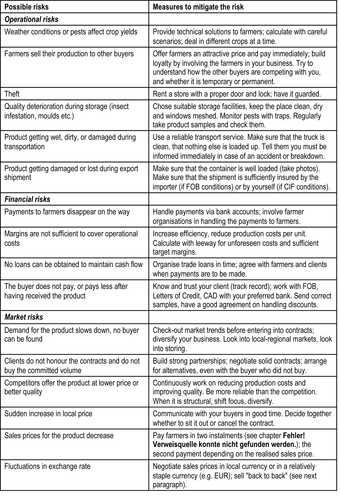
Possible Business Risks
This chart represents a list of the possible risks involved in running an organic business. Risks such as these affect sales, which in turn affect the amount of operating leverage a company should utilize.
IT and Enterprise Risk Management
IT risk management can be viewed as a component of a wider enterprise risk management (ERM) system. Some organizations have a comprehensive enterprise risk management methodology in place. The four objective categories addressed in an ERM, according to COSO, are:
- Strategy – high-level goals, aligned with and supporting the organization’s mission
- Operations – effective and efficient use of resources
- Financial Reporting – reliability of operational and financial reporting
- Compliance – compliance with applicable laws and regulations
IT risk transverses all four of the aforementioned categories and should be managed within the framework of enterprise risk management. Risk appetite and risk sensitivity of the whole enterprise should guide the IT risk management process. ERM should provide the context and business objectives on the management of IT risk.
20.2.4: Information and Knowledge
Knowledge is acquired through the use of and access to information.
Learning Objective
Explain the process of transforming information into knowledge
Key Points
- Information seeking is the process or activity of attempting to obtain information in both human and technological contexts. Information seeking is related to, but different from, information retrieval.
- Retrieving information is an integral part of information gathering and with today’s technology it can involve searching for documents, for information within documents, and for metadata about documents,. It may also involve searching structured storage, relational databases, and the Internet.
- Both information access and information architecture can facilitate user access to vast quantities of information and the use of it.
Key Terms
- relational database
-
A database consisting of separate tables, having explicitly defined relationships, and whose elements may be selectively combined as the results of queries.
- metadata
-
Data that describes other data, serving as an informative label.
- database
-
a collection of information in a regular structure, usually, but not necessarily in a machine-readable format accessible by a computer
Using and Managing Information
Information seeking is the process or activity of attempting to obtain information in both human and technological contexts. Information seeking is related to, but different from, information retrieval. Retrieving information is an integral part of information gathering and with today’s technology it can involve searching for documents, for information within documents, and for metadata about documents. Receiving information can also involve searching structured storage, relational databases, and the Internet. Information management (IM) is the collection and management of information from one or more sources and the distribution of that information to one or more audiences. Sometimes this involves those who have a stake in, or a right to that information. Management means the organization of and control over the structure, processing and delivery of information .
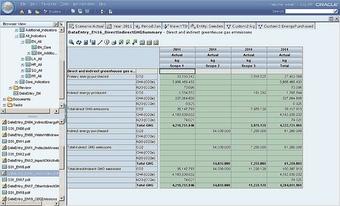
Information Presented in a Software Application
Well-organized information improves knowledge and decision making.
Knowledge Through Information
Knowledge is acquired through the use of and access to information. An area of research known as information access aims to automate the processing of large and unwieldy amounts of information and to simplify users’ access to it. Applicable technologies include information retrieval, text mining, machine translation, and text categorization. Information architecture (IA) is the art and science of organizing and labeling websites, intranets, online communities and software to support information use. It is an emerging discipline and community of practice focused on bringing together principles of design and architecture to the digital landscape. Typically it involves a model or concept of information which is used and applied to activities that require explicit details from complex programs and information systems. These activities include library systems and database development.
20.2.5: Data and Information
Data consists of nothing but facts, which can be manipulated to make it useful; the analytical process turns the data into information.
Learning Objective
Explain the process of turning data into information
Key Points
- Data are the numbers, characters, or symbols on which operations are performed by a computer, being stored and transmitted in the form of electrical signals and recorded on magnetic, optical, or mechanical recording media.
- In order to be processed by a computer, data needs to be first converted into a machine readable format. Once data is in digital format, various procedures can be applied on the data to get useful information.
- Data processing may involve various processes, including: data summarization, data aggregation, data validation, data tabulation, and statistical analysis.
Key Terms
- statistical analysis
-
The process of examining data to draw conclusions or insights, and determine cause-and-effect patterns between events; for example determining the safety and efficacy of new drugs by drawing out a probability as to whether the fact that a patient got better (or worse) was due to the drug or some other (perhaps random) factor.
- tabulation
-
A table displaying data in compact form.
- primary data
-
information collected by the investigator conducting the research
- secondary data
-
information collected by someone other than the user of the data
Forms of Computer Data
Data are the numbers, characters, or symbols on which operations are performed by a computer, being stored and transmitted in the form of electrical signals and recorded on magnetic, optical, or mechanical recording media. A program is a set of data that consists of a series of coded software instructions to control the operation of a computer or other machine. While program files are referred to as executable files, they may also contain data which is built into the program. For example, some programs have a data segment, which contains constants and initial values. Binary files (readable by a computer but not a human) are sometimes called “data” and are distinguishable from human-readable data, referred to as “text” .
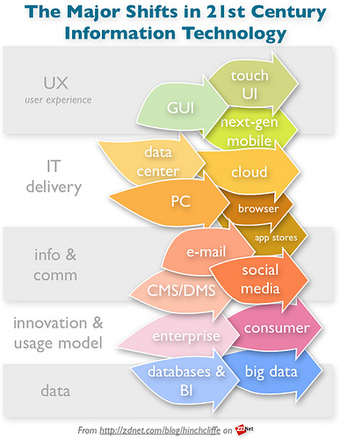
Changing Technology Has Improved The Way Data Is Organized.
Computer systems make it easier to turn data into useful information.
Data vs. Information
Data consists of nothing but facts (organized or unorganized) which can then be manipulated into other forms to make it useful and understandable, turning the data into information. The process of manipulating facts to information is referred to as “processing. ” In order to be processed by a computer, data needs to first be converted into a machine readable format. Once data is in digital format, various procedures can be applied on the data to get useful information. Data processing may involve various processes, including:
- Data summarization
- Data aggregation
- Data validation
- Data tabulation
- Statistical analysis
Data processing may or may not be distinguishable from data conversion, which involves changing data into another format, and does not involve any data manipulation. During processing, raw data is used as an input to produce information as an output, typically in the form of reports and other analytical tools.
20.3: E-Commerce
20.3.1: Selling to Businesses
B2B e-commerce is the type of e-commerce that deals with relationships between and among businesses.
Learning Objective
Explain the impact of technological advances on business to business (B2B) commerce
Key Points
- About 80% of e-commerce is of this type, and most experts predict that B2B e-commerce will continue to grow faster than the business to consumer (B2C) segment.
- E-frastructure is the architecture of B2B, primarily consisting of logistics, application service providers, outsourcing of e-commerce functions, auction solutions, content management software, and Web-based commerce enablers.
- E-markets are simply defined as Web sites where buyers and sellers interact with each other and conduct transactions.
- Impacts of B2B e-commerce on the economy in general are evident in transaction costs, disintermediation, transparency in pricing, and economies of scale and network effects.
Key Terms
- outsourcing
-
The transfer of a business function to an external service provider.
- e-commerce
-
Commercial activity conducted via the Internet.
Business to business (B2B) e-commerce is simply defined as e-commerce between companies. This is the type of e-commerce that deals with relationships between and among businesses. About 80% of e-commerce is of this type, and most experts predict that B2B e-commerce will continue to grow faster than the business to consumer (B2C) segment. The B2B market has two primary components: e-frastructure and e-markets. E-frastructure is the architecture of B2B, primarily consisting of a number of subcategories:
- Logistics: transportation, warehousing and distribution
- Application service providers: deployment, hosting and management of packaged software from a central facility
- Outsourcing of functions in the process of e-commerce, such as Web-hosting, security and customer care solutions
- Auction solutions software for the operation and maintenance of real-time auctions in the Internet
- Content management software for the facilitation of Web site content management and delivery
- Web-based commerce enablers
E-markets are simply defined as Web sites where buyers and sellers interact with each other and conduct transactions.
The more common B2B examples and best practice models are IBM, Hewlett Packard (HP), Cisco, and Dell. Cisco, for instance, receives over 90% of its product orders over the Internet. Most B2B applications are in the areas of supplier management (especially purchase order processing), inventory management (i.e., managing order-ship-bill cycles), distribution management (especially in the transmission of shipping documents), channel management (i.e., information dissemination on changes in operational conditions), and payment management (e.g., electronic payment systems or EPS).
Impacts of B2B e-commerce on the economy in general are evident in a number of areas:
- Transaction costs: There are three cost areas that are significantly reduced through the conduct of B2B e-commerce. First is the reduction of search costs, as buyers need not go through multiple intermediaries to search for information about suppliers, products, and prices as in a traditional supply chain. In terms of effort, time, and money spent, the Internet is a more efficient information channel than its traditional counterparts. In B2B markets, buyers and sellers are gathered together into a single online trading community, reducing search costs even further. Second is the reduction in the costs of processing transactions (e.g. invoices, purchase orders and payment schemes), as B2B allows for the automation of transaction processes and, therefore, the quick implementation of the same compared to other channels (such as the telephone and fax). Efficiency in trading processes and transactions is also enhanced through the B2B e-market’s ability to process sales through online auctions. Third, online processing improves inventory management and logistics.
- Disintermediation: Through B2B e-markets, suppliers are able to interact and transact directly with buyers, thereby eliminating intermediaries and distributors. However, new forms of intermediaries are emerging. For instance, e-markets themselves can be considered intermediaries because they come between suppliers and customers in the supply chain.
- Transparency in pricing: Among the more evident benefits of e-markets is the increase in price transparency. The gathering of a large number of buyers and sellers in a single e-market reveals market price information and transaction processing to participants. The Internet allows for the publication of information on a single purchase or transaction, making the information readily accessible and available to all members of the e-market. Increased price transparency has the effect of pulling down price differentials in the market. In this context, buyers are provided much more time to compare prices and make better buying decisions. Moreover, B2B e-markets expand borders for dynamic and negotiated pricing wherein multiple buyers and sellers collectively participate in price-setting and two-way auctions. In such environments, prices can be set through automatic matching of bids and offers. In the e-marketplace, the requirements of both buyers and sellers are thus aggregated to reach competitive prices, which are lower than those resulting from individual actions.
- Economies of scale and network effects: The rapid growth of B2B e-markets creates traditional supply-side cost-based economies of scale. Furthermore, the bringing together of a significant number of buyers and sellers provides the demand-side economies of scale or network effects. Each additional incremental participant in the e-market creates value for all participants in the demand side. More participants form a critical mass, which is key in attracting more users to an e-market.

B2B E-Commerce
E-commerce has become so prevalent in today’s business world that multiple conferences are held each year — like this one pictured in the UK.
20.3.2: Selling to Consumers
B2C e-commerce involves customers gathering information and purchasing either physical or information goods over an electronic network.
Learning Objective
Explain how technological change has transformed the business-to-consumer (B2C) industry
Key Points
- Information goods include electronic material or digitized content, such as software or e-books, and can be delivered over an electronic network.
- The more common applications of this type of e-commerce are in the areas of purchasing products and information, and personal finance management, which pertains to the management of personal investments and finances with the use of online banking tools.
- B2C e-commerce reduces transactions costs (particularly search costs) by increasing consumer access to information and allowing consumers to find the most competitive price for a product or service.
- B2C e-commerce also reduces market entry barriers since the cost of putting up and maintaining a website is much cheaper than installing a “brick-and-mortar” structure for a firm.
- C2C e-commerce is characterized by the growth of electronic marketplaces and online auctions, particularly in vertical industries where firms/businesses can bid for what they want from among multiple suppliers.
Key Term
- distribution
-
The process by which goods get to final consumers over a geographical market, including storing, selling, shipping, and advertising.
Business-to-consumer (B2C) e-commerce, or commerce between companies and consumers, involves customers gathering information; purchasing physical goods (i.e., tangibles such as books or consumer products) or information goods (or goods of electronic material or digitized content, such as software or e-books); and, for information goods, receiving products over an electronic network. It is the second largest and the earliest form of e-commerce. Its origins can be traced to online retailing (or e-tailing). Thus, the more common B2C business models are the online retailing companies such as Amazon.com, Drugstore.com, Beyond.com, Barnes and Noble, and Toys-R-Us. Other B2C examples involving information goods are E-Trade and Travelocity.
The more common applications of this type of e-commerce are in the areas of purchasing products and information, and personal finance management, which pertains to the management of personal investments and finances with the use of online banking tools (e.g., Quicken). Online retailing transactions make up a significant share of the B2C e-commerce market.
B2C e-commerce reduces transactions costs (particularly search costs) by increasing consumer access to information and allowing consumers to find the most competitive price for a product or service. B2C e-commerce also reduces market entry barriers since the cost of putting up and maintaining a website is much cheaper than installing a “brick-and-mortar” structure for a firm. In the case of information goods, B2C e-commerce is even more attractive because it saves firms from factoring in the additional cost of a physical distribution network. Moreover, for countries with a growing and robust Internet population, delivering information goods becomes increasingly feasible.
Another form of e-commerce involving selling to consumers is known as consumer-to-consumer (C2C). It is simply commerce between private individuals or consumers. This type of e-commerce is characterized by the growth of electronic marketplaces and online auctions, particularly in vertical industries where firms/businesses can bid for what they want from among multiple suppliers. It perhaps has the greatest potential for developing new markets.
This type of e-commerce comes in at least three forms:
- Auctions facilitated at a portal, such as eBay, which allows online real-time bidding on items being sold in the Web
- Peer-to-peer systems, such as the Napster model (a protocol for sharing files between users used by chat forums similar to IRC) and other file exchange and later money exchange models
- Classified ads at portal sites such as Craigslist (an interactive, online marketplace where buyers and sellers can negotiate and that features “Buyer Leads & Want Ads”)

B2C E-Commerce
B2C e-commerce makes up a smaller portion of the market share of e-commerce compared to B2B, and appears to be shrinking in comparison.
20.4: Difficulties with New Technologies
20.4.1: Forced Entry
Cybercrimes are those committed via computer networks for such purposes as fraud, identity theft, and the hacking of sensitive information.
Learning Objective
Discuss the ramifications of cybercrime
Key Points
- Cybercrimes are offenses that are committed with a criminal motive to intentionally harm the reputation of the victim or cause physical or mental harm directly or indirectly, using modern telecommunication networks such as the Internet and mobile phones.
- Computer crime may be divided into two categories: crimes that target computers directly, and crimes facilitated by computer networks or devices, the primary target of which is independent of the network or device.
- Computer fraud is any dishonest misrepresentation of fact intended to get another to do or refrain from doing something which causes loss.
- Identity theft is a form of stealing someone’s identity in which someone pretends to be someone else by assuming that person’s identity, typically in order to access resources or obtain credit and other benefits in that person’s name.
Key Terms
- hacking
-
Unauthorized attempts to bypass the security mechanisms of an information system or network. See also cracker.
- phishing
-
The act of sending email that falsely claims to be from a legitimate organization. This is usually combined with a threat or request for information. For example, it may claim that an account will close, a balance is due, or information is missing from an account. The email will ask the recipient to supply confidential information, such as bank account details, PINs or passwords; these details are then used by the owners of the website to conduct fraud.
- identity theft
-
The deliberate assumption of another person’s identity, usually to gain access to that person’s finances or to frame a person for a crime.
Forced Entry
The creation and widespread use of new technology brings along with it many benefits. However, new and previously unaccounted-for dangers arise as well. Cybercrime is one such danger. It is defined as offenses that are committed against individuals or groups of individuals with a criminal motive to intentionally harm the reputation of the victim or cause physical or mental harm to the victim, directly or indirectly, using modern telecommunication networks such as the Internet (chat rooms, emails, notice boards, etc.) and mobile phones (SMS/MMS). Such crimes may threaten a nation’s or individual’s security and financial health. Issues surrounding this type of crime have become high-profile, particularly those surrounding hacking, copyright infringement, and child abduction. There are also problems of privacy when confidential information is lost or intercepted, lawfully or otherwise.
Computer crime encompasses a broad range of activities. Generally, however, it may be divided into two categories: crimes that target computers directly, and crimes facilitated by computer networks or devices, the primary target of which is independent of the network or device. Crimes that primarily target computer networks or devices include computer viruses, denial-of-service attacks, and malware. Crimes that use computer networks or devices to advance other ends include cyberstalking, fraud and identity theft, information warfare, and phishing scams.
Computer Fraud
Computer fraud is any dishonest misrepresentation of fact intended to get another to do or refrain from doing something which causes loss. In this context, the fraud will result in obtaining a benefit by one of a number of means:
- Altering computer input in an unauthorized way. This requires little technical expertise and is not an uncommon form of theft by employees. Altering data before entry or entering false data, or entering unauthorized instructions or using unauthorized processes are the most common examples.
- Altering, destroying, suppressing, or stealing output, usually to conceal unauthorized transactions. This is difficult to detect.
- Altering or deleting stored data.
- Altering or misusing existing system tools or software packages, or altering or writing code for fraudulent purposes.
Other forms of fraud may be facilitated using computer systems, including bank fraud, identity theft, extortion, and theft of classified information.
Identity Theft
Identity theft is a form of stealing a person’s identity in which someone pretends to be someone else, typically in order to access resources or obtain credit and other benefits in that person’s name. The victim of identity theft (here meaning the person whose identity has been assumed by the identity thief) can suffer adverse consequences if he or she is held accountable for the perpetrator’s actions. Identity theft occurs when someone uses another’s personally identifying information, like name, Social Security number, or credit card number, without permission, to commit fraud or other crimes.
Identity fraud is often but not necessarily the consequence of identity theft. Someone can steal or misappropriate personal information without then committing identity theft using the stolen information; this can happen when a major data breach occurs and the information of a large number of people is compromised.
Documented Cases of Cybercrime
One of the highest profiled banking computer crimes occurred during a course of three years, beginning in 1970. The chief teller at the Park Avenue branch of New York’s Union Dime Savings Bank embezzled over $1.5 million from hundreds of accounts.
In 1983, a nineteen-year-old UCLA student used his PC to break into a Defense Department international communications system.
Between 1995 and 1998, the Newscorp satellite pay-to-view encrypted SKY-TV service was hacked several times during an ongoing technological arms race between a pan-European hacking group and Newscorp. The original motivation of the hackers was to watch Star Trek re-runs in Germany, which was something Newscorp did not have the copyright to allow.
In February 2000, an individual under the alias of MafiaBoy began a series denial-of-service attacks against high profile websites, including Yahoo!, Amazon.com, Dell, E*TRADE, eBay, and CNN. About 50 computers at Stanford University, as well as computers at the University of California at Santa Barbara, were among the zombie computers sending pings in DDoS attacks. On August 3, 2000, Canadian federal prosecutors charged MafiaBoy with 54 counts of illegal access to computers, plus a total of 10 counts of mischief to data for his attacks.
On March 2, 2010, Spanish investigators arrested three individuals for the infection of over 13 million computers around the world. The “botnet” of infected computers included PCs inside more than half of the Fortune 1,000 companies and more than 40 major banks, according to investigators.
In August 2010, the international investigation Operation Delego, operating under the aegis of the Department of Homeland Security, shut down the international pedophile ring Dreamboard. The website had approximately 600 members and may have distributed up to 123 terabytes of child pornography (roughly equivalent to 16,000 DVDs). To date, this is the single largest U.S. prosecution of an international child pornography ring; 52 arrests were made worldwide.

Cybercrime
Cybercrime can be committed using computer viruses and other various programs that can track any information you enter into computer networks.
20.4.2: Malware
Malware is software used or created by attackers to disrupt computer operation, gather sensitive information, or gain access to private computer systems.
Learning Objective
Explain how malware can negatively impact individuals and organizations
Key Points
- Malware includes computer viruses, worms, trojan horses, spyware, adware, and other malicious programs.
- Malware has caused the rise in use of protective software types such as anti-virus, anti-malware, and firewalls.
- Malware is often used against individuals to gain personal information such as social security numbers, bank or credit card numbers, and so on.
- Spyware is designed to monitor users’ web browsing, display unsolicited advertisements, or redirect affiliate marketing revenues to the spyware creator.
Key Terms
- malware
-
Software which has been designed to operate in a malicious, undesirable manner.
- adware
-
A software application that includes advertisements, which are displayed while the software is running. Developers use adware as a source of income and to keep the costs of the software down (usually making it free). Some adware programs can include spyware.
- spyware
-
Programs that surreptitiously monitor and report the actions of a computer user.
Malware
Malware, short for malicious (or malevolent) software, is software used or created by attackers to disrupt computer operation, gather sensitive information, or gain access to private computer systems. It can appear in the form of code, scripts, active content, and other software. Malware is a general term used to refer to a variety of forms of hostile or intrusive software.
Malware includes computer viruses, worms, spyware, adware, and trojan horses . Malware is not the same as defective software, which is software that has a legitimate purpose but contains harmful bugs that were not corrected before release. However, some malware is disguised as genuine software, and may come from an official company website. An example of this is software used for harmless purposes that is packed with additional tracking software that gathers marketing statistics. Malware has caused the rise in use of protective software types such as anti-virus, anti-malware, and firewalls. Each of these are commonly used by personal users and corporate networks to stop the unauthorized access by other computer users, as well as the automated spread of malicious scripts and software.

BEAST Trojan Horse
Beast, a Windows-based backdoor Trojan horse
The best-known types of malware, viruses and worms, are known for the manner in which they spread, rather than any specific types of behavior. The term computer virus is used for a program that has infected some executable software and, when run, causes the virus to spread to other executables. On the other hand, a worm is a program that actively transmits itself over a network to infect other computers. These definitions lead to the observation that a virus requires user intervention to spread, whereas a worm spreads itself automatically.
Purposes
Malware is sometimes used broadly against government or corporate websites to gather guarded information, or to disrupt their operation in general. However, malware is often used against individuals to gain personal information such as social security numbers, bank or credit card numbers, and so on. Left unguarded, personal and networked computers can be at considerable risk against these threats. Since the rise of widespread broadband Internet access, malicious software has more frequently been designed for profit. Since 2003, the majority of widespread viruses and worms have been designed to take control of users’ computers for black-market exploitation. Infected “zombie computers” are used to send email spam, to host contraband data such as pornography, or to engage in distributed denial-of-service attacks as a form of extortion.
Another strictly for-profit category of malware has emerged, called spyware. These programs are designed to monitor users’ web browsing, display unsolicited advertisements, or redirect affiliate marketing revenues to the spyware creator. Spyware programs do not spread like viruses; instead they are generally installed by exploiting security holes. They can also be packaged together with user-installed software, such as peer-to-peer applications.
The prevalence of malware as a vehicle for Internet crime, along with the challenge of anti-malware software to keep up with the continuous stream of new malware, has seen the adoption of a new mindset for individuals and businesses using the Internet. With the amount of malware currently being distributed, some percentage of computers will always be infected. For businesses, especially those that sell mainly over the Internet, this means that they need to find a way to operate despite security concerns. The result is a greater emphasis on back-office protection designed to protect against advanced malware operating on customers’ computers.
Concealment
For a malicious program to accomplish its goals, it must be able to run without being detected, shut down, or deleted. When a malicious program is disguised as something normal or desirable, users may willfully install it without realizing it. This is the technique of the Trojan horse or trojan. In broad terms, a Trojan horse is any program that invites the user to run it, though it conceals harmful or malicious code. The code may take effect immediately and can lead to many undesirable effects, such as deleting the user’s files or installing additional harmful software.
One of the most common ways that spyware is distributed is as a Trojan horse, bundled with a piece of desirable software that the user downloads from the Internet. When the user installs the software, the spyware is installed along with it. Spyware authors who attempt to act in a legal fashion may include an end-user license agreement that states the behavior of the spyware in loose terms, which users may not read or understand.
20.4.3: E-Mail as an Entry Point
Email represents a potential IT risk and entry point for hackers, and so IT teams must integrate appropriate safeguards.
Learning Objective
Understand the risks associated with organizational email systems and the tools available to offset those risks
Key Points
- Email is used by virtually every organization on the planet and is an often targeted weakness by hackers.
- Opening an email could potentially enable an executable file, which could contain a virus. Once this virus enters just one device, the shared professional network is at risk.
- Utilizing tools such as firewalls, anti-virus software, and encryption can help block attempts to hack via email.
- Organizations must be aware of the potential risks, and invest in IT accordingly to offset them.
Key Terms
- Firewall
-
A gateway between the internet and a local network, allowing or denying access based upon protocols.
- Encryption
-
A method of scrambling and unscrambling information to protect it during digital transmission (in the context of email).
Why Email is a Business Risk
Virtually every business and individual with internet access has an email account of some sort. Emails are files sent from one computer to another, and those files can contain virtually anything, including executable files. If a virus is transferred to a computer and executed internally, it can gain access to the device of an employee that has access to centralized databases. At this point, the virus has now infected the entire organization and, if not caught, can download, manipulate, export, and alter any and all customer data, strategic assets, and potentially even valuable IP.
As a result, protecting the inboxes of the employees at an organization is critical to minimizing this risk. There are a variety of mechanisms designed to do exactly that.
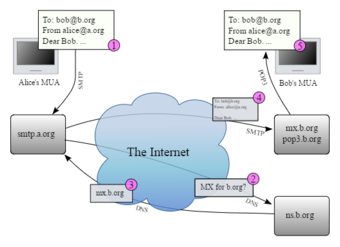
This image shows the transmission of an email from one device to another.
How to Protect Your Inbox
There are a few simple steps organizations should take to protect their email systems. These include:
- Firewalls – Simply put, a firewall permits or denies communication from the network based upon specific parameters. Setting stricter parameters with verification built in can stop viruses from accessing the network.
- Encryption – Encryption takes a message and scrambles the contents of that message upon sending. The sender must enable the receiver to unscramble that message, and this can be done in a variety of ways. For example, business partners may agree on a password that will unlock the contents of an email and verify the sender while protecting the contents during transmission.

Encryption
This shows a simple visual representation of how encryption works.
- Anti-virus Software – Anti-virus programs are designed to record libraries of data on common viruses, and scan all incoming email traffic (as well as internal files and databases) for signs of malicious software.
- Intrusion detection systems (IDS) – Similar to anti-viruses, these programs scan devices and networks for malicious activity or violations to the preset policies.
As the world grows more and more digitally connected, the risks will continue to elevate. Being aware of the risks and investing in a strong IT infrastructure is key to mitigating the potential risks.
Chapter 19: Financial Management
19.1: Introduction to Financial Management
19.1.1: The Importance of Finance
Finance involves the evaluation, disclosure, and management of economic activity and is crucial to the successful operation of firms and markets.
Learning Objective
Differentiate between managerial finance and corporate finance
Key Points
- The primary goal of corporate finance is to maximize shareholder value and it deals with the monetary decisions that business enterprises make.
- Managerial finance is interested in the internal and external significance of a firm’s financial figures.
- The terms corporate finance and corporate financier are also associated with investment banking. The typical role of an investment bank is to evaluate a company’s financial needs and raise the appropriate type of capital that best fits those needs.
- Sound financial management creates value and organizational ability through the allocation of scarce resources.
Key Term
- dividends
-
Dividends are payments made by a corporation to its shareholder members. It is the portion of corporate profits paid out to stockholders.
The Importance of Finance
Finance involves the evaluation, disclosure, and management of economic activity and is crucial to the successful and efficient operation of firms and markets.
Managerial Finance
Managerial finance concerns itself with the managerial significance of finance. It is focused on assessment rather than technique. For instance, in reviewing an annual report, one concerned with technique would be primarily interested in measurement. They would ask: is money being assigned to the right categories? Were generally accepted accounting principles (GAAP) followed?
A person working in managerial finance would be interested in the significance of a firm’s financial figures measured against multiple targets such as internal goals and competitor figures.They may look at changes in asset balances and probe for red flags that indicate problems with bill collection or bad debt as well as analyze working capital to anticipate future cash flow problems.
Sound financial management creates value and organizational ability through the allocation of scarce resources amongst competing business opportunities. It is an aid to the implementation and monitoring of business strategies and helps achieve business objectives.
Corporate Finance
Corporate finance is the area of finance dealing with monetary decisions that business enterprises make and the tools and analysis used to make those decisions. The primary goal of corporate finance is to maximize shareholder value. Although it is in principle different from managerial finance, which studies the financial decisions of all firms, rather than corporations alone, the main concepts in the study of corporate finance are applicable to financial problems of all kinds of firms.
The discipline can be divided into long-term and short-term decisions and techniques. Capital investment decisions are long-term choices about which projects receive investment, whether to finance that investment with equity or debt, and when or whether to pay dividends to shareholders. On the other hand, short-term decisions deal with the short-term balance of current assets and current liabilities; the focus here is on managing cash, inventories, short-term borrowing, and lending (such as the terms on credit extended to customers).
The terms corporate finance and corporate financier are also associated with investment banking. The typical role of an investment bank is to evaluate the company’s financial needs and raise the appropriate type of capital that best fits those needs. Thus, the terms “corporate finance” and “corporate financier” may be associated with transactions in which capital is raised in order to create, develop, grow, or acquire businesses.

Wall St.
Wall Street is the symbol of American and global finance.
19.1.2: The Role of Financial Managers
Financial managers ensure the financial health of an organization through investment activities and long-term financing strategies.
Learning Objective
Outline the various roles played by financial managers
Key Points
- Financial managers perform data analysis and advise senior managers on profit-maximizing ideas.
- The role of the financial manager, particularly in business, is changing in response to technological advances that have significantly reduced the amount of time it takes to produce financial reports.
- Types of financial managers include controllers, treasurers, credit managers, cash managers, risk managers and insurance managers.
Key Term
- net present value
-
The present value of a project or an investment decision determined by summing the discounted incoming and outgoing future cash flows resulting from the decision.
The Role of Financial Managers
Overview
Financial managers perform data analysis and advise senior managers on profit-maximizing ideas. Financial managers are responsible for the financial health of an organization. They produce financial reports, direct investment activities, and develop strategies and plans for the long-term financial goals of their organization. Financial managers typically:
- Prepare financial statements, business activity reports, and forecasts,
- Monitor financial details to ensure that legal requirements are met,
- Supervise employees who do financial reporting and budgeting,
- Review company financial reports and seek ways to reduce costs,
- Analyze market trends to find opportunities for expansion or for acquiring other companies,
- Help management make financial decisions.
The role of the financial manager, particularly in business, is changing in response to technological advances that have significantly reduced the amount of time it takes to produce financial reports. Financial managers’ main responsibility used to be monitoring a company’s finances, but they now do more data analysis and advise senior managers on ideas to maximize profits. They often work on teams, acting as business advisors to top executives.
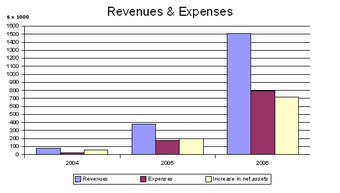
Financial Statements
This is an example of a financial statement that financial managers are responsible for preparing and interpreting.
Financial managers also do tasks that are specific to their organization or industry. For example, government financial managers must be experts on government appropriations and budgeting processes, and healthcare financial managers must know about issues in healthcare finance. Moreover, financial managers must be aware of special tax laws and regulations that affect their industry.
Capital Investment Decisions
Capital investment decisions are long-term corporate finance decisions relating to fixed assets and capital structure. Decisions are based on several inter-related criteria. Corporate management seeks to maximize the value of the firm by investing in projects which yield a positive net present value when valued using an appropriate discount rate in consideration of risk. These projects must also be financed appropriately. If no such opportunities exist, maximizing shareholder value dictates that management must return excess cash to shareholders (i.e., distribution via dividends). Capital investment decisions thus comprise an investment decision, a financing decision, and a dividend decision.
Management must allocate limited resources between competing opportunities (projects) in a process known as capital budgeting. Making this investment decision requires estimating the value of each opportunity or project, which is a function of the size, timing and predictability of future cash flows.
Achieving the goals of corporate finance requires that any corporate investment be financed appropriately. The sources of financing are, generically, capital self-generated by the firm and capital from external funders, obtained by issuing new debt or equity.
Types of Financial Managers
There are distinct types of financial managers, each focusing on a particular area of management.
Controllers direct the preparation of financial reports that summarize and forecast the organization’s financial position, such as income statements, balance sheets, and analyses of future earnings or expenses. Controllers also are in charge of preparing special reports required by governmental agencies that regulate businesses. Often, controllers oversee the accounting, audit, and budget departments. Treasurers and finance officers direct their organization’s budgets to meet its financial goals and oversee the investment of funds. They carry out strategies to raise capital and also develop financial plans for mergers and acquisitions.
Credit managers oversee the firm’s credit business. They set credit-rating criteria, determine credit ceilings, and monitor the collections of past-due accounts. Cash managers monitor and control the flow of cash that comes in and goes out of the company to meet the company’s business and investment needs. Risk managers control financial risk by using hedging and other strategies to limit or offset the probability of a financial loss or a company’s exposure to financial uncertainty. Insurance managers decide how best to limit a company’s losses by obtaining insurance against risks such as the need to make disability payments for an employee who gets hurt on the job or costs imposed by a lawsuit against the company.
Important Skills for Financial Managers
Analytical skills. Financial managers increasingly assist executives in making decisions that affect the organization, a task for which they need analytical ability.
Communication. Excellent communication skills are essential because financial managers must explain and justify complex financial transactions.
Attention to detail. In preparing and analyzing reports such as balance sheets and income statements, financial managers must pay attention to detail.
Math skills. Financial managers must be skilled in math, including algebra. An understanding of international finance and complex financial documents also is important.
Organizational skills. Financial managers deal with a range of information and documents. They must stay organized to do their jobs effectively.
19.2: Planning
19.2.1: Creating a Budget
A budget is the financial expression of an organization’s operating plan for a period of time, usually at least a year.
Learning Objective
Outline the process of budgeting
Key Points
- The budgeting process may be carried out by individuals or by companies to estimate whether the person or company can continue to operate with its projected income and expenses.
- In summary, the purpose of budgeting is to provide a forecast of revenues and expenditures; enable the actual financial operation of the business to be measured against the forecast; and establish the cost constraint for a project, program, or operation.
- The process for preparing a monthly budget includes: listing all sources of monthly income; listing all required, fixed expenses, like rent and mortgage, utilities, and phone; and listing other possible and variable expenses.
Key Term
- fixed expenses
-
In economics, fixed costs are business expenses that are not dependent on the level of goods or services produced by the business.
The Purpose of Budgeting
A budget is the financial expression of an organization’s operating plan for a period of time, usually at least a year . Prior to the beginning of the year, managers prepare a plan for what they hope to accomplish in the coming year in terms of revenue, expenses, and net profit.
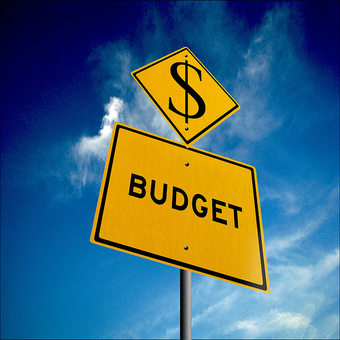
Budget
A budget is the financial expression of an organization’s operating plan for a period of time, usually at least a year.
Budget can be more formally defined as “a financial document used to project future income and expenses. ” The budgeting process may be carried out by individuals or by companies to estimate whether the person or company can continue to operate with its projected income and expenses. A budget may be prepared simply using paper and pencil, or on computer using a spreadsheet program like Excel, or with a financial application like Quicken or QuickBooks.
In summary, the purpose of budgeting is to:
- Provide a forecast of revenues and expenditures
- Construct a model of how a business might perform financially if certain strategies, events, and plans are carried out
- Enable the actual financial operation of the business to be measured against the forecast
- Establish the cost constraint for a project, program, or operation
The Process of Preparing a Monthly Budget
The process for preparing a monthly budget includes:
- Listing all sources of monthly income
- Listing all required, fixed expenses, like rent and mortgage, utilities, and phone
- Listing other possible and variable expenses
Then, as the year unfolds, actual income and expenses are posted to the accounting records, and compared to what was budgeted, and a variance from budget for each item budgeted (e.g., sales, selling expenses, advertising costs) is calculated. Managers responsible for the various income and expense items then examine each variance and, if it is substantial, search for an explanation. For example, it is one thing if electricity costs are 20% higher than what was budgeted for one month because workmen were using power tools to repair the roof. In that case, we can expect costs to return to normal when the repair work is completed. It is quite another thing if costs are higher because the electric company raised its rates. In that case, we can expect that costs will be at least 20% higher in the future.
The Role of Budgeting in Operations
Budgeting helps aid the planning of actual operations by forcing managers to consider how the conditions might change. It thus encourages managers to consider problems before they arise and think of the steps that should be presently taken. It also helps coordinate the activities of the organization by compelling managers to examine relationships between their own operation and those of other departments. Other essential functions of budgets include:
- To control resources
- To communicate plans to various responsibility center managers
- To motivate managers to strive to achieve budget goals
- To evaluate the performance of managers
- To provide visibility into the company’s performance
The Two Approaches to Budgeting
There are two basic approaches or philosophies when it comes to budgeting. One approach is based on mathematical models, and the other on people.
The first school of thought believes that financial models, if properly constructed, can be used to predict the future. The focus is on variables, inputs and outputs, drivers and the like. Investments of time and money are devoted to perfecting these models, which are typically held in some type of financial spreadsheet application.
The other school of thought holds that it’s not about models, it’s about people. No matter how sophisticated models can get, the best information comes from the people in the business. The focus is therefore in engaging the managers in the business more fully in the budget process, and building accountability for the results. The companies that adhere to this approach have their managers develop their own budgets. While many companies would say that they do both, in reality the investment of time and money falls squarely in one approach or the other.
19.2.2: Financial Plan and Forecast
Financial planning aims to ensure that a firm is properly capitalized and makes appropriate investments.
Learning Objective
Explain how financial planners use forecasts in decision making
Key Points
- Management must identify the “optimal mix” of financing—the capital structure that results in maximum value. Equity financing is less risky with respect to cash flow commitments, but results in a dilution of share ownership, control and earnings.
- Management must attempt to match the long-term financing mix to the assets being financed as closely as possible, in terms of both timing and cash flows.
- Most organizations prepare a revised forecast for the balance of the year, taking into account earlier budgets and forecasts. This step is particularly important if material variances from the original budget exist.
Key Term
- corporate finance
-
Corporate finance is the area of finance dealing with monetary decisions that business enterprises make and the tools and analysis used to make these decisions.
Financial Planning
Financial planning is important in ensuring that corporate investment is financed appropriately, as well as seeing to it that money is spent in worthwhile investments. Achieving the goals of corporate finance requires that any corporate investment be financed appropriately. The sources of financing are capital self-generated by the firm and capital from external sources, obtained by issuing new debt and equity. The financing mix will impact the valuation of the firm (as well as the other long-term financial management decisions). There are two interrelated considerations here:

Financial planning
Financial planning is important in ensuring that corporate investment is both financed appropriately, as well as seeing to it that money is spent in worthwhile investments.
- Management must identify the “optimal mix” of financing—the capital structure that results in maximum value. Equity financing is less risky with respect to cash flow commitments, but results in a dilution of share ownership, control and earnings.
- Management must attempt to match the long-term financing mix to the assets being financed as closely as possible, in terms of both timing and cash flows.
Forecasts
Most organizations prepare a revised forecast for the balance of the year, taking into account earlier budgets and forecasts. This step is particularly important if there are variances from the original budget. For example, if sales are less than projected because market conditions are less favorable than anticipated when the budget was prepared, managers may look for ways to increase sales or reduce expenses in order to avoid a loss for the year.
Organizations may carry out a form of economic forecasting which is the process of making predictions about the economy. Forecasts can be carried out at a high level of aggregation like gross domestic product (GDP), inflation, unemployment, or the fiscal deficit. They may also happen at a more dis-aggregated level, for specific sectors of the economy or even specific firms. Some forecasts are produced annually, but many are updated more frequently.
Scenarios
There are many other forecasts that managers ask for in order to try and anticipate what the future might hold and so that they can prepare contingency plans in case of unforeseen events. Examples of unforeseen events that may affect future outcomes are the arrival of a new competitor, a change in the overall economic outlook which could affect costs and/or revenues either positively or negatively, or even the arrival of a new company in another line of business that could raise prevailing wage rates in the region.
Managers like to develop forecasts of figures such as sales, costs, cash, profits, interest rates using different assumptions. Another word for forecasts is scenarios. For example, let us assume that a forecast of the income statement for a business at the end of the year assumes that sales will grow by 8 percent over the previous year and costs will grow by 6 percent. A manager might ask for an alternative scenario where sales increase by 12 percent and costs increase by 9 percent and another scenario where sales decrease by 3 percent and costs increase by 1 percent.
19.3: Operating Funds
19.3.1: Day-to-Day Needs
Operating cash flow refers to the daily cash inflows and outflows generated from business revenues earned, excluding certain costs.
Learning Objective
Define operating cash flow
Key Points
- The International Financial Reporting Standards (IFRS) defines operating cash flow as cash generated from operations less taxation and interest paid, investment income received and less dividends paid.
- “Cash and cash equivalents” on the balance sheet are the most liquid assets found on this statement. They are assets that are readily convertible into cash, such as money market holdings, short-term government bonds or Treasury bills, marketable securities, and commercial paper.
- Cash flow forecasting or cash flow management is a key aspect of the financial management of a business, because planning for future cash requirements can help to avoid a liquidity crisis in the business.
Key Terms
- liquidity
-
An asset’s ability to become solvent without affecting its value; the degree to which it can be easily converted into cash.
- International Financial Reporting Standards
-
International accounting standards that provide a common global language for business affairs, so that company accounts are understandable and comparable across international boundaries.
Operating Cash Needs
Operating cash flow refers to the amount of cash a company generates from the revenues it brings in, excluding costs associated with long-term investment on capital items or investment in securities. The International Financial Reporting Standards (IFRS) defines operating cash flow as cash generated from operations less taxation and interest paid, investment income received and less dividends paid. Business operations have daily cash inflows and outflows. Cash inflows come from cash sales of inventory, collection of credit sales, sales of other assets, and funds obtained through credit financing. Cash outflows occur due to cash payment of business expenses, purchase of assets, and payment on debt .

Liquidity
Liquidity is essential for businesses, because it allows them to meet daily operating needs.
Cash and Cash Equivalents
“Cash and cash equivalents” on the balance sheet are the most liquid assets found on this statement. They are assets that are readily convertible into cash, such as money market holdings, short-term government bonds or Treasury bills, marketable securities, and commercial paper. Cash equivalents are distinguished from other investments through their short-term existence; they mature within three months and have insignificant risk of change in value.
Cash and cash equivalents are also used in the contexts of payments and payment transactions and refer to currency, money orders, paper checks, and stored value products, such as gift certificates and gift cards.
Operating Cash Forecast
Cash flow forecasting or cash flow management is a key aspect of the financial management of a business, because planning for future cash requirements can help to avoid a liquidity crisis in the business. Cash flow is the life-blood of all businesses, particularly start-ups and small enterprises. As a result, it is essential that management forecast (predict) what is going to happen to cash flow to make sure the business has enough to survive.
19.3.2: Capital Expenditures
Capital costs are incurred for the purchase of land, buildings, construction of assets, and equipment, etc., used during business operations.
Learning Objective
Explain how capital expenditures are accounted for
Key Points
- Capital expenditures are needed to bring a project to a commercially operable status. Whether a particular cost is capital or not depends on many factors, such as accounting rules, tax laws, and materiality.
- Capital costs include expenses for tangible goods, such as the purchase of plants and machinery, as well as expenses for intangibles assets, such as trademarks and software development.
- A capital expenditure cannot be deducted in the year in which it is paid or incurred and must be capitalized. The general rule is that if the acquired property’s useful life is longer than the taxable year, then the cost must be capitalized.
Key Terms
- expenditure
-
Amount expended; expense; outlay.
- amortize
-
To reduce (a debt, liability, etc. ) gradually or in installments.
- Trademark
-
A word, symbol, or phrase used to identify a particular company’s product and differentiate it from other companies’ products.
Costs of Capital
Capital expenditures (“CAPEX”) are one-time expenses incurred for the purchase of land, buildings, construction of buildings and other assets, and equipment used in the production of goods or in the rendering of services. In short, capital expenditures are the total costs needed to bring a project to a commercially operable status.
Whether a particular cost is a CAPEX or not depends on many factors, such as accounting rules, tax laws, and materiality. CAPEX include expenses for tangible goods, such as the purchase of plants and machinery, as well as expenses for intangibles assets, such as trademarks and software development. CAPEX are not limited to the initial construction of a building or other asset and should include other expense items, such as interest incurred during the construction phase.

The construction of a building requires the use of capital.
The funds used to construct and put a building into use are capital expenditures.
Accounting for Capital Expenditures
A CAPEX cannot be deducted as an expense in the year in which it is paid or incurred and must be capitalized. The general rule is that if the acquired property’s useful life is longer than the taxable year, then the cost must be capitalized. The CAPEX costs are then amortized or depreciated over the life of the asset in question. The following capital expenditures are capitalized:
- Acquiring fixed and, in some cases, intangible assets
- Repairing an existing asset so as to improve its useful life
- Upgrading an existing asset, which increases its value (original cost)
- Preparing an asset to be used in business
- Restoring property or adapting it to a new or different use
- Starting or acquiring a new business
An ongoing question for the accounting of any company is whether certain expenses should be capitalized. Costs that are expensed in a particular month simply appear on the financial statement as a cost incurred that month. Costs that are capitalized, however, are amortized or depreciated over multiple years. Capitalized expenditures show up on the balance sheet. Most ordinary business expenses are clearly either expensable or capitalizable, but some expenses could be treated either way, according to the preference of the company. Capitalized interest, if applicable, is also spread out over the life of the asset.The counterpart of capital expenditure is operational expenditure (“OpEx”).
19.3.3: Alternate Sources of Funds
Funds typically originate from company sales and earning revenue; other cash sources include the sale of non-current assets and company stock.
Learning Objective
Differentiate between operating, investing and financing cash flows
Key Points
- Cash inflows and outflows can originate from three types of activities: operating, investing, and financing.
- Operating activities that generate cash flows include receipts from the sale of goods or services; receipts from the sale of loans, debt, or equity instruments in a trading portfolio; and interest received on loans.
- Cash inflows from investing activities involve non-current assets, such as sales of land, building, equipment, and marketable securities; loans from suppliers; and payments related to mergers and acquisitions.
- Financing activities include the inflow of cash from investors, such as banks and shareholders, proceeds from issuing short-term or long-term debt; sale of repurchased company shares (treasury stock); for non-profit organizations, receipts of donor-restricted cash; and sale of the company’s stock.
Key Term
- non-current assets
-
assets and property not easily converted into cash; a fixed/non-current asset can also be defined as an asset not directly sold to a firm’s consumers/end-users
Sources of Funds
Funds for business operations typically originate from company sales and earning revenue. However, a business can also generate cash funds from other sources as well, such as the sale of non-current assets and through the sale of company stock. The cash flow statement, which shows cash inflows and outflows for a specific reporting period and distinguishes between three types of activities that generate or use cash: operating, investing, and financing.
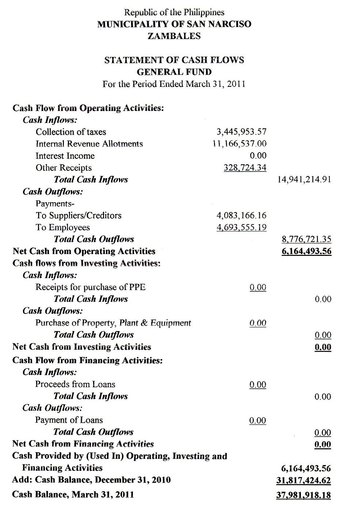
Cash Flow Statement
The cash flow statement shows cash inflows and outflows for a specific reporting period and distinguishes between three types of activities that generate or use cash: operating, investing, and financing.
Cash from Operating Activities
Operating activities include the production, sales, and delivery of the company’s product, as well as collecting payment from its customers. This could include purchasing raw materials, building inventory, advertising, and shipping the product. Operating activities that generate cash flows are:
- Receipts from the sale of goods or services
- Receipts for the sale of loans, debt, or equity instruments in a trading portfolio
- Interest received on loans
- Merchandise items which are added back to the net income figure
- Dividends received
- Revenue received from certain investing activities
Cash from Investing Activities
Cash inflows from investing activities involve cash flows associated with non-current assets:
- Sale of a non-current asset (assets, such as land, building, equipment, marketable securities, etc.)
- Loans from suppliers
- Payments related to mergers and acquisitions
Cash from Financing Activities
Financing activities include the inflow of cash from investors, such as banks and shareholders. Other activities which impact long-term liabilities and equity of the company are also listed under financing activities, such as:
- Proceeds from issuing short-term or long-term debt
- Sale of repurchased company shares (treasury stock)
- For non-profit organizations, receipts of donor-restricted cash
- Sale of the company’s stock
19.3.4: Credit Operations
Business operations can require the use of credit, or the transfer of money or property on promise of repayment, to meet operating needs.
Learning Objective
Outline the types of credit used for financing business operations
Key Points
- Credit is sometimes not granted to a person or business with financial instability or difficulty. Companies frequently offer credit to their customers as part of the terms of a purchase agreement.
- A line of credit is any credit source extended to a business or individual by a bank or other financial institution and may take several forms.
- A revolving credit line provides a borrower with a maximum aggregate amount of capital, available over a specified period of time; it allows the borrower to draw down, repay, and re-draw credit amounts advanced to her by the available capital during the term of the debt.
- In a loan, the borrower initially receives or borrows an amount of money, called the “principal,”, from the lender and is obligated to pay back or repay an amount with interest to the lender at a later time.
Key Terms
- debtor
-
A person or firm that owes money; one in debt; one who owes a debt
- creditor
-
A person to whom a debt is owed.
Use of Credit and Financing for Operations
Business operations can require the use of credit and financing to meet operating needs. Credit, in commerce and finance, is a term used to denote transactions involving the transfer of money or other property on promise of repayment, usually at a fixed future date and at a specific interest rate . The transferor thereby becomes a creditor, and the transferee (the recipient of the funds or property) becomes a debtor. Credit is sometimes not granted to a person or business with financial instability or difficulty. Companies frequently offer credit to their customers as part of the terms of a purchase agreement. Organizations that offer credit to their customers frequently employ a credit manager .

Loans can weigh a business down.
The use of credit is a necessity in business and should be managed wisely.
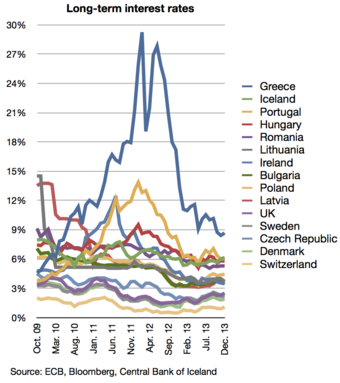
Interest Rates
Long-term interest rate statistics for non-Euro countries plus Greece, Portugal, and Ireland.
Types of Credit
A line of credit is any credit source extended to a business or individual by a bank or other financial institution. A line of credit may take several forms, such as overdraft protection, demand loan, special purpose, export packing credit, term loan, discounting, purchase of commercial bills, traditional revolving credit card account, etc. It is effectively a source of funds that can readily be used at the borrower’s discretion. Interest is paid only on money actually withdrawn. Lines of credit can be secured by collateral or may be unsecured.
A revolving credit line provides a borrower with a maximum aggregate amount of capital, available over a specified period of time. However, unlike a term loan, revolving debt allows the borrower to draw down, repa,y and re-draw credit amounts advanced to her by the available capital during the term of the debt. Each credit line is borrowed for a set period of time, usually one, three, or six months, after which time it is technically repayable. Repayment of revolving credit is achieved either by scheduled payments on the total amount of the debt over time, or by all outstanding loans being repaid on the date of termination.
In a loan, the borrower initially receives or borrows an amount of money, called the “principal,” from the lender and is obligated to pay back or repay an equal amount of money to the lender at a later time. Typically, the money is paid back in regular installments, or partial repayments; in an annuity, each installment is the same amount. The loan is generally provided at a cost, referred to as interest on the debt, which provides an incentive for the lender to engage in the loan.
19.3.5: Purchasing Inventory
Inventory management is primarily about specifying the quantity and placement of stocked goods.
Learning Objective
Explain how an organization makes purchasing decisions
Key Points
- The scope of inventory management includes items such as: stock replenishment lead time, carrying costs of inventory, asset management, and inventory forecasting.
- There are four basic reasons for keeping an inventory: time lags present in the supply chain, the maintenance of inventory for consumption during variations in lead time, inventories maintained to meet uncertainties in demand and supply, and economies of scale.
- Purchasing refers to a business or organization acquiring goods or services to accomplish the goals of its enterprise. Companies generally use operating funds to finance their purchasing program.
- One of the goals of purchasing inventory is to acquire goods at the most advantageous terms for the buying entity (the “Buyer”).
Key Terms
- lead time
-
The amount of time between the initiation of some process and its completion, e.g. the time required to manufacture or procure a product; the time required before something can be provided or delivered.
- economies of scale
-
The characteristics of a production process in which an increase in the scale of the firm causes a decrease in the long-run average cost of each unit.
Inventory Management
Inventory management is primarily about specifying the quantity and placement of stocked goods. Inventory management is required at different locations within a facility or within multiple locations of a supply network to maintain the regular and planned course of production and to manage the risk of running out of materials or goods for sale. The scope of inventory management also involves stock replenishment lead time, carrying costs of inventory, asset management, inventory forecasting, inventory valuation, inventory visibility, future inventory price forecasting, physical inventory, available physical space for inventory, quality management, returns and defective goods, and demand forecasting .

Clothing Retailers Should Have Sufficient Inventory On Hand
Inventory purchases should be carefully managed to prevent overstocking merchandise or having inventory shortages.
There are four basic reasons for keeping an inventory:
- Time: The time lags present in the supply chain, from supplier to user at every stage, require that businesses maintain certain amounts of inventory to use in this lead time.
- Consumption: Inventory is to be maintained for consumption during variations in lead time. Lead time itself can be addressed by ordering a specified number of days in advance.
- Uncertainty: Inventories are maintained as buffers to meet uncertainties in demand, supply, and movements of goods.
- Economies of scale: The idea of “one unit at a time, at a place where a user needs it, when they need it” tends to incur lots of costs in terms of logistics. So bulk buying, movement, and storing brings in economies of scale and creates inventory.
Purchasing
Purchasing refers to a business or organization acquiring goods or services to accomplish the goals of its enterprise. Companies generally use operating funds to finance their purchasing program. Most organizations use a three-way check as the foundation of their purchasing programs. This involves three departments in the organization completing separate parts of the acquisition process. These departments can be purchasing, receiving, and accounts payable; or engineering, purchasing, and accounts payable; or a plant manager, purchasing, and accounts payable. Combinations can vary significantly, but a purchasing department and accounts payable are usually two of the three departments involved.
Historically, the purchasing department issued purchase orders for supplies, services, equipment, and raw materials. Then, in an effort to decrease the administrative costs associated with the repetitive ordering of basic consumable items, “blanket” or “master” agreements were put into place. These types of agreements typically have a longer duration and increased scope to maximize the quantities of scale concept. When additional supplies were required, a simple release would be issued to the supplier to provide the goods or services.
From time to time, an organization will “shop” for suppliers through the process of bidding. When selecting bidders, an organization identifies potential suppliers for specified supplies, services, or equipment. These suppliers’ credentials and history are analyzed, together with the products or services they offer. The bidder selection process varies from organization to organization, but can include running credit reports, interviewing management, testing products, and touring facilities. Organizational goals will dictate the criteria for the selection process of bidders. It is also possible that the product or service being procured is so specialized that the number of bidders are limited and the criteria must be very wide to permit competition.
Negotiating is a key skill in purchasing. One of the goals of purchasing inventory is to acquire goods at the most advantageous terms for the buying entity (the “Buyer”). Purchasing agents typically attempt to decrease costs while meeting the Buyer’s other requirements, such as an on-time delivery and compliance to the commercial terms and conditions (including the warranty, the transfer of risk, assignment, auditing rights, confidentiality, remedies, etc.).
19.4: Short-Term Financing
19.4.1: Commercial Paper
Commercial paper is a money-market security issued (sold) by large corporations to get money to meet short term debt obligations.
Learning Objective
Analyze the commercial paper market
Key Points
- There are two methods of issuing paper. The issuer can market the securities directly to a buy and hold investor such as most money market funds. Alternatively, it can sell the paper to a dealer, who then sells the paper in the market.
- Commercial paper is a lower cost alternative to a line of credit with a bank. Once a business becomes established, and builds a high credit rating, it is often cheaper to draw on a commercial paper than on a bank line of credit.
- Asset-Backed Commercial Paper (ABCP) is a form of commercial paper that is collateralized by other financial assets.
Key Term
- money market
-
A market for trading short-term debt instruments, such as treasury bills, commercial paper, bankers’ acceptances, and certificates of deposit.
Commercial Paper
In the global money market, commercial paper is an unsecured promissory note with a fixed maturity of one to 364 days. Commercial paper is a money-market security issued (sold) by large corporations to get money to meet short term debt obligations (for example, payroll), and is only backed by an issuing bank or a corporation’s promise to pay the face amount on the maturity date specified on the note. Since it is not backed by collateral, only firms with excellent credit ratings from a recognized rating agency will be able to sell their commercial paper at a reasonable price. Commercial paper is usually sold at a discount from face value, and carries higher interest repayment rates than bonds. Typically, the longer the maturity on a note, the higher the interest rate the issuing institution must pay. Interest rates fluctuate with market conditions, but are typically lower than banks’ rates.
There are two methods of issuing paper. The issuer can market the securities directly to a buy and hold investor such as most money market funds. Alternatively, it can sell the paper to a dealer, who then sells the paper in the market . The dealer market for commercial paper involves large securities firms and subsidiaries of bank holding companies. Most of these firms are also dealers in US Treasury securities. Direct issuers of commercial paper are usually financial companies that have frequent and sizable borrowing needs, and find it more economical to sell paper without the use of an intermediary. In the United States, direct issuers save a dealer fee of approximately five basis points, or 0.05% annualized, which translates to $50,000 on every $100 million outstanding. This saving compensates for the cost of maintaining a permanent sales staff to market the paper. Dealer fees tend to be lower outside the United States .

US Commercial Paper Weekly 2001-2008
United States Commercial Paper outstanding at end of each week from 3 January 2001 to 29 October 2008. Vertical scale shows debt in billions (thousands of millions) of dollars, horizontal scale shows years. Each blue marker indicates commercial paper outstanding at that date which matures after one week.

US Commercial Paper 2001-2007
United States Commercial Paper outstanding at end of each year 2001 to 2007. Vertical scale shows debt in millions of dollars, horizontal scale shows years. All markers indicate commercial paper outstanding, maturing after December 31. Circles on blue line indicate Total commercial paper; triangles diamonds on pink line indicate SEC rule 2a-7 tier-1 commercial paper; triangles on blue line indicate Asset-backed commercial paper; squares on yellow line indicate SEC rule 2a-7 tier-2 commercial paper.
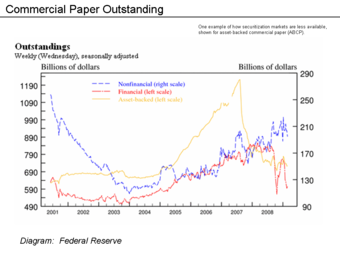
Weekly Commercial Paper Outstandings
Commercial paper is a lower cost alternative to a line of credit with a bank. Once a business becomes established and builds a high credit rating, it is often cheaper to draw on a commercial paper than on a bank line of credit. Nevertheless, many companies still maintain bank lines of credit as a backup. Banks often charge fees for the amount of the line of the credit that does not have a balance.
Advantages and Disadvantages
Advantages of commercial paper include lower borrowing costs; term flexibility; and more liquidity options for creditors due to its trade-ability.
Disadvantages of commercial paper include its limited eligibility; reduced credit limits with banks; and reduced reliability due to its strict oversight.
Asset-Backed Commercial Paper (ABCP)
Asset-Backed Commercial Paper (ABCP) is a form of commercial paper that is collateralized by other financial assets. ABCP is typically a short-term instrument that matures between one and 180 days from issuance and is typically issued by a bank or other financial institution. The firm wishing to finance its assets through the issuance of ABCP sells the assets to a Special Purpose Vehicle (SPV) or Structured Investment Vehicle (SIV), created by a financial services company. The SPV/SIV issues the ABCP to raise funds to purchase the assets. This creates a legal separation between the entity issuing and the institution financing its assets.
19.4.2: Factoring Accounts Receivable
Factoring makes it possible for a business to readily convert a substantial portion of its accounts receivable into cash.
Learning Objective
Explain the business of factoring and assess the risks of the involved parties
Key Points
- Debt factoring is also used as a financial instrument to provide better cash flow control especially if a company currently has a lot of accounts receivables with different credit terms to manage.
- The three parties directly involved in factoring are: the one who sells the receivable, the debtor (the account debtor, or customer of the seller), and the factor.
- There are two principal methods of factoring: recourse and non-recourse. Under recourse factoring, the client is not protected against the risk of bad debts. Under non-recourse factoring, the factor assumes the entire credit risk.
Key Term
- factoring
-
A financial transaction whereby a business sells its accounts receivable to a third party (called a factor) at a discount.
Factoring
Factoring is a financial transaction whereby a business sells its accounts receivable to a third party (called a “factor”) at a discount. Factoring makes it possible for a business to convert a readily substantial portion of its accounts receivable into cash. This provides the funds needed to pay suppliers and improves cash flow by accelerating the receipt of funds.

Money
Factoring makes it possible for a business to readily convert a substantial portion of its accounts receivable into cash.
Companies factor accounts when the available cash balance held by the firm is insufficient to meet current obligations and accommodate its other cash needs, such as new orders or contracts. In other industries, however, such as textiles or apparel, for example, financially sound companies factor their accounts simply because this is the historic method of finance. The use of factoring to obtain the cash needed to accommodate a firm’s immediate cash needs will allow the firm to maintain a smaller ongoing cash balance. By reducing the size of its cash balances, more money is made available for investment in the firm’s growth. Debt factoring is also used as a financial instrument to provide better cash flow control, especially if a company currently has a lot of accounts receivables with different credit terms to manage. A company sells its invoices at a discount to their face value when it calculates that it will be better off using the proceeds to bolster its own growth than it would be by effectively functioning as its “customer’s bank. “
Types of Factoring
There are two principal methods of factoring: recourse and non-recourse. Under recourse factoring, the client is not protected against the risk of bad debts. On the other hand, the factor assumes the entire credit risk under non-recourse factoring (i.e., the full amount of invoice is paid to the client in the event of the debt becoming bad). Other variations include partial non-recourse, where the factor’s assumption of credit risk is limited by time, and partial recourse, where the factor and its client (the seller of the accounts) share credit risk. Factors never assume “quality” risk, and even a non-recourse factor can charge back a purchased account which does not collect for reasons other than credit risk assumed by the factor, (e.g., the account debtor disputes the quality or quantity of the goods or services delivered by the factor’s client).
In “advance” factoring, the factor provides financing to the seller of the accounts in the form of a cash “advance,” often 70-85% of the purchase price of the accounts, with the balance of the purchase price being paid, net of the factor’s discount fee (commission) and other charges, upon collection. In “maturity” factoring, the factor makes no advance on the purchased accounts; rather, the purchase price is paid on or about the average maturity date of the accounts being purchased in the batch.
There are three principal parts to “advance” factoring transaction:
- The advance, a percentage of the invoice’s face value that is paid to the seller at the time of sale.
- The reserve, the remainder of the purchase price held until the payment by the account debtor is made.
- The discount fee, the cost associated with the transaction which is deducted from the reserve, along with other expenses, upon collection, before the reserve is disbursed to the factor’s client.
Parties Involved in the Factoring Process
The three parties directly involved are the one who sells the receivable, the debtor (the account debtor, or customer of the seller), and the factor. The receivable is essentially an asset associated with the debtor’s liability to pay money owed to the seller (usually for work performed or goods sold). The seller then sells one or more of its invoices (the receivables) at a discount to the third party, the specialized financial organization (aka the factor), often, in advance factoring, to obtain cash. The sale of the receivables essentially transfers ownership of the receivables to the factor, indicating the factor obtains all of the rights associated with the receivables. Accordingly, the factor obtains the right to receive the payments made by the debtor for the invoice amount and, in non-recourse factoring, must bear the loss if the account debtor does not pay the invoice amount due solely to his or its financial inability to pay.
Risks in Factoring
The most important risks of a factor are:
- Counter party credit risk: risk covered debtors can be re-insured, which limit the risks of a factor. Trade receivables are a fairly low risk asset due to their short duration.
- External fraud by clients: fake invoicing, mis-directed payments, pre-invoicing, unassigned credit notes, etc. A fraud insurance policy and subjecting the client to audit could limit the risks.
- Legal, compliance, and tax risks: a large number and variety of applicable laws and regulations depending on the country.
- Operational: operational risks such as contractual disputes.
19.4.3: Credit Cards
Credit cards allow users to pay for goods and services based on the promise to pay for them later and the immediate provision of cash by the card provider.
Learning Objective
Evaluate the costs and benefits of a credit card
Key Points
- The issuer of the card creates a revolving account and grants a line of credit to the consumer (or the user) from which the user can borrow money for payment to a merchant or as a cash advance to the user.
- The main benefit to each customer is convenience. Credit cards allow small short-term loans to be quickly made to a customer who need not calculate a balance remaining before every transaction, provided the total charges do not exceed the maximum credit line for the card.
- Costs to users include high interest rates and complex fee structures.
Key Term
- credit card
-
A plastic card with a magnetic strip or an embedded microchip connected to a credit account and used to buy goods or services. It’s like a debit card, but money comes not from your personal bank account, but the bank lends money for the purchase based on the credit limit. Credit limit is determined by the income and credit history. Bank charge APR (annual percentage rate) for using of money.
Example
- For example, if a user has a $1,000 transaction and repaid it in full within this grace period, there would be no interest charged. If, however, even $1 of the total amount remained unpaid, interest would be charged on the $1,000 from the date of purchase until the payment is received.
Credit Cards
A credit card is a payment card issued to users as a system of payment. It allows the cardholder to pay for goods and services based on the promise to pay for them later and the immediate provision of cash by the card provider. The issuer of the card creates a revolving account and grants a line of credit to the consumer (or the user) from which the user can borrow money for payment to a merchant or as a cash advance to the user. Credit cards allow the consumers a continuing balance of debt, subject to interest being charged. A credit card also differs from a cash card, which can be used like currency by the owner of the card .

Credit card
A credit card is a payment card issued to users as a system of payment.
Credit cards are issued by an issuer like a bank or credit union after an account has been approved by the credit provider, after which cardholders can use it to make purchases at merchants accepting that card.
Benefits to Users
The main benefit to each customer is convenience. Compared to debit cards and checks, a credit card allows small short-term loans to be quickly made to a customer who need not calculate a balance remaining before every transaction, provided the total charges do not exceed the maximum credit line for the card.
Many credit cards offer rewards and benefits packages like enhanced product warranties at no cost, free loss/damage coverage on new purchases and various insurance protections. Credit cards can also offer reward points which may be redeemed for cash, products or airline tickets.
Costs to Users
High interest rates: Low introductory credit card rates are limited to a fixed term, usually between six and 12 months, after which a higher rate is charged. As all credit cards charge fees and interest, some customers become so indebted to their credit card provider that they are driven to bankruptcy. Some credit cards often levy a rate of 20 to 30 percent after a payment is missed. In other cases a fixed charge is levied without change to the interest rate. In some cases universal default may apply – the high default rate is applied to a card in good standing by missing a payment on an unrelated account from the same provider. This can lead to a snowball effect in which the consumer is drowned by unexpectedly high interest rates.
Complex fee structures in the credit card industry limit customers’ ability to comparison shop, help ensure that the industry is not price-competitive and help maximize industry profits.
Benefits to Merchants
For merchants, a credit card transaction is often more secure than other forms of payment, because the issuing bank commits to pay the merchant the moment the transaction is authorized regardless of whether the consumer defaults on the credit card payment. In most cases, cards are even more secure than cash, because they discourage theft by the merchant’s employees and reduce the amount of cash on the premises. Finally, credit cards reduce the back office expense of processing checks/cash and transporting them to the bank.
Costs to Merchants
Merchants are charged several fees for accepting credit cards. The merchant is usually charged a commission of around one to three percent of the value of each transaction paid for by credit card. The merchant may also pay a variable charge, called an interchange rate, for each transaction. In some instances of very low-value transactions, use of credit cards will significantly reduce the profit margin or cause the merchant to lose money on the transaction. Merchants with very low average transaction prices or very high average transaction prices are more averse to accepting credit cards. Merchants may charge users a “credit card supplement,” either a fixed amount or a percentage, for payment by credit card. This practice is prohibited by the credit card contracts in the United States, although the contracts allow the merchants to give discounts for cash payment.
Merchants are also required to lease processing terminals, meaning merchants with low sales volumes may have to commit to long lease terms. For some terminals, merchants may need to subscribe to a separate telephone line. Merchants must also satisfy data security compliance standards which are highly technical and complicated. In many cases, there is a delay of several days before funds are deposited into a merchant’s bank account. As credit card fee structures are very complicated, smaller merchants are at a disadvantage to analyze and predict fees. Finally, merchants assume the risk of chargebacks by consumers.
19.4.4: Commercial Banks
A commercial bank lends money, accepts time deposits, and provides transactional, savings, and money market accounts.
Learning Objective
Sketch out the role of commercial banks in money lending
Key Points
- Commercial banks may provide a secured loan, which are monetary loans that have borrower collateral pledged against their repayment.
- Commercial banks may also provide unsecured loans, which are monetary loans that are not secured against the borrower’s assets (i.e., no collateral is involved).
- Accessing funds through a commercial bank is a very common way of accessing funds when in need, particularly in the case of small or entrepreneurial businesses.
Key Term
- collateral
-
A security or guarantee (usually an asset) pledged for the repayment of a loan if one cannot procure enough funds to repay. (Originally supplied as “accompanying” security. )
A commercial or business bank , is a type of financial institution and intermediary that lends money, accepts time deposits, and provides transactional, savings, and money market accounts.

Commercial banks
A commercial bank (or business bank) is a type of financial institution and intermediary.
Commercial banks engage in the following activities: the processing of payments; accepting money on term deposit; lending money by overdraft, installment loan, or other means; providing documentary and standby letters of credit guarantees, performance bonds, securities underwriting commitments and other forms of off- balance sheet exposures; and the safekeeping of documents and other items in safe deposit boxes.
Commercial banks provide a number of loans. A secured loan is when a borrower pledges some asset (e.g., a car or property) as collateral for it, which then becomes a secured debt owed to the creditor who gives the loan. The debt is thus secured against the collateral. In the event that the borrower defaults, the creditor takes possession of the asset used as collateral and may sell it to regain some or all of the amount originally lent to the borrower.
Commercial banks may also provide unsecured loans, which are monetary loans that are not secured against the borrower’s assets (i.e., no collateral is involved). Some examples of unsecured loans include credit cards and credit lines.
An overdraft is an example of an unsecured loan. An overdraft occurs when money is withdrawn from a bank account and the available balance goes below zero. In this situation, the account is said to be “overdrawn”. If there is a prior agreement with the account provider for an overdraft, and the amount overdrawn is within the authorized overdraft limit, then interest is normally charged at the agreed rate. If the positive balance exceeds the agreed terms, then additional fees may be charged and higher interest rates may apply.
Accessing funds through a commercial bank is very typical, and a common way of accessing funds when in need, particularly in the case of small or entrepreneurial businesses.
19.4.5: Trade Credit or Accounts Payable
Trade credit is the largest use of capital for a majority of B2B sellers; Accounts Payable is money owed by a firm to its suppliers.
Learning Objective
Explain the process of using and recording accounts payable
Key Points
- There are many forms of trade credit in common use; often industry-specific. They all benefit from their collaboration to make efficient use of capital to accomplish various business objectives.
- An accounts payable is recorded in the Account Payable sub-ledger at the time an invoice is vouchered for payment.
- Commonly, a supplier will ship a product, issue an invoice, and collect payment later, which describes a cash conversion cycle, or a period of time during which the supplier has already paid for raw materials but hasn’t been paid in return by the final customer.
Key Term
- supplier
-
One who supplies; a provider.
Trade Credit
Trade credit is the largest use of capital for a majority of business to business (B2B) sellers in the United States and is a critical source of capital for a majority of all businesses. For example, Wal-Mart, the largest retailer in the world, has used trade credit as a larger source of capital than bank borrowings. Trade credit for Wal-Mart is eight times the amount of capital invested by shareholders.
For many borrowers in the developing world, trade credit serves as a valuable source of alternative data for personal and small business loans.
There are many forms of trade credit in common use; often industry-specific. They all benefit from their collaboration to make efficient use of capital to accomplish various business objectives.
Accounts Payable (A/P)
Accounts Payable (A/P and also known as creditors) is money owed by a business to its suppliers. An accounts payable is recorded in the A/P sub-ledger at the time an invoice is vouchered for payment. Payables are often categorized as Trade Payables, payables for the purchase of physical goods that are recorded in Inventory, and Expense Payables, payables for the purchase of goods or services that are expensed. Common examples of Expense Payables are advertising, travel, entertainment, office supplies, and utilities. A/P is a form of credit that suppliers offer to their customers by allowing them to pay for a product or service after it has already been received .

Credit
Accounts Payable (also known as Creditors) is money owed by a business to its suppliers.
In households, these payables are ordinarily bills such as utility, rent, etc. Households usually track and pay on a monthly basis manually by using checks, credit cards, or online banking. In a business, there is usually a much broader range of suppliers to pay, and accountants or bookkeepers usually use accounting software to track the flow of money into this liability account when they receive invoices and out of it when they make payments. Increasingly, large firms often use specialized automation solutions (commonly called ePayables) to automate the paper and manual elements of processing an organization’s invoices.
Commonly, a supplier will ship a product, issue an invoice, and collect payment later, which describes a cash conversion cycle, a period of time during which the supplier has already paid for raw materials but hasn’t been paid in return by the final customer. When the invoice is received by the purchaser, it is matched to the packing slip and purchase order, and if all is in order, the invoice is paid. This is referred to as the three-way match. The three-way match can slow down the payment process, so the method may be modified. For example, three-way matching may be limited solely to large-value invoices, or the matching is automatically approved if the received quantity is within a certain percentage of the amount authorized in the purchase order.
19.4.6: Family and Friends
Asking friends and families to invest is one way that start-ups are funded.
Learning Objective
Analyze person to person (P2P) lending
Key Points
- Somewhat similar to raising money from family and friends is person-to-person lending. Person-to-person lending is a certain breed of financial transaction which occurs directly between individuals or “peers” without the intermediation of a traditional financial institution.
- Lending money and supplies to friends, family, and community members predates formalized financial institutions, but in its modern form, peer-to-peer lending is a by-product of Internet technologies, especially Web 2.0.
- In a particular model of P2P lending known as “family and friend lending”, the lender lends money to a borrower based on their pre-existing personal, family, or business relationship.
Key Term
- financial institution
-
In financial economics, a financial institution is an institution that provides financial services for its clients or members.
Investments from Family and Friends
Asking friends and families to invest is another common way that start-ups are funded. Often the potential entrepreneur is young, energetic, and has a good idea for a start-up, but does not have much in the way of personal savings. Friends and family may be older and have some money set aside. While your parents, or other family members should not risk all of their retirement savings on your start-up, they may be willing to risk a small percentage of it to help you out .

Family
Asking friends and families to invest is another common way that start-ups are funded.
Sometimes friends your own age are willing to work for little or no wages until your cash flow turns positive. The term “sweat equity” is often used for this type of contribution as the owner will often reward such loyalty with a small percentage ownership of the organization in lieu of cash. A variation on this is barter or trade. This is a method by which you could provide a needed service such as consulting or management advice in return for the resources needed for your start up. This needs to be accounted for in your accounting records also.
Person-to-Person Lending
Somewhat similar to raising money from family and friends is person-to-person lending. Person-to-person lending (also known as peer-to-peer lending, peer-to-peer investing, and social lending; abbreviated frequently as P2P lending) is a certain breed of financial transaction (primarily lending and borrowing, though other more complicated transactions can be facilitated) which occurs directly between individuals or “peers” without the intermediation of a traditional financial institution. However, person-to-person lending is for the most part a for-profit activity, which distinguishes it from person-to-person charities, person-to-person philanthropy, and crowdfunding.
Lending money and supplies to friends, family, and community members predates formalized financial institutions, but in its modern form, peer-to-peer lending is a by-product of Internet technologies, especially Web 2.0. The development of the market niche was further boosted by the global economic crisis in 2007 to 2010 when person-to-person lending platforms promised to provide credit at the time when banks and other traditional financial institutions were having fiscal difficulties.
Many peer-to-peer lending companies leverage existing communities and pre-existing interpersonal relationships with the idea that borrowers are less likely to default to the members of their own communities. The risk associated with lending is minimized either through mutual (community) support of the borrower or, as occurs in some instances, through forms of social pressure. The peer-to-peer lending firms either act as middlemen between friends and family to assist with calculating repayment terms, or connect anonymous borrowers and lenders based on similarities in their geographic location, educational and professional background, and connectedness within a given social network.
In a particular model of P2P lending known as “family and friend lending”, the lender lends money to a borrower based on their pre-existing personal, family, or business relationship. The model forgoes an auction-like process and concentrates on formalizing and servicing a personal loan. Lenders can charge below market rates to assist the borrower and mitigate risk. Loans can be made to pay for homes, personal needs, school, travel, or any other needs.
Advantages and Criticisms
One of the main advantages of person-to-person lending for borrowers has been better rates than traditional bank rates can offer (often below 10%). The advantages for lenders are higher returns that would be unobtainable from a savings account or other investments.
As person-to-person lending companies and their customer base continue to grow, marketing expenses and administrative costs associated with customer service and arbitration, maintaining product information, and developing quality websites to service customers and stand out among competitors will rise. In addition, compliance to legal regulations becomes more complicated. This causes many of the original benefits from disintermediation to fade away and turns person-to-person companies into new intermediaries, much like the banks that they originally differentiated from. This process of reintroducing intermediaries is known as reintermediation.
Person-to-person lending also attracts borrowers who, because of their past credit status or the lack of thereof, are unqualified for traditional bank loans. The unfortunate situation of these borrowers is well-known for the people issuing the loans and results in very high interest rates that verge on predatory lending and loan sharking.
19.4.7: Secured vs. Unsecured Funding
A secured loan is a loan in which the borrower pledges an asset (e.g. a car or property) as collateral, while an unsecured loan is not secured by an asset.
Learning Objective
Differentiate between a secured loan vs. an unsecured loan
Key Points
- A loan constitutes temporarily lending money in exchange for future repayment with specific stipulations such as interest, finance charges, and fees.
- Secured loans are secured by assets such as real estate, an automobile, boat, or jewelry. The secured asset is known as collateral. In the event the borrower does not pay the loan as agreed, he/she may forfeit the asset used as collateral to the lender.
- Unsecured loans are monetary loans that are not secured against collateral. Interest rates for unsecured loans are often higher than for secured loans because the risk to the lender is greater.
Key Term
- Assets
-
An asset is something of economic value. Examples of assets include money, real estate, and automobiles.
Examples
- A mortgage loan is a secured loan in which the collateral is real estate. If the borrower does not pay back the mortgage within the agreed upon terms, the lender may seize the property. Seizure of real estate for non-payment is also known as foreclosure. A foreclosure is a legal process in which mortgaged property is sold to pay the debt of the defaulting borrower.
- A car loan is a secured loan in which the collateral is an automobile, If the borrower does not pay back the car loan within the agreed upon terns, the lender may seize the automobile. Seizure of an automobile for non-payment is also known as repossession. Repossession is a legal process in which property, such as a car, is taken back by the creditor.
Loans
Debt refers to an obligation. A loan is a monetary form of debt. A loan constitutes temporarily lending money in exchange for future repayment with specific stipulations such as interest, finance charges, and/or fees. A loan is considered a contract between the lender and the borrower. Loans may either be secured or unsecured.
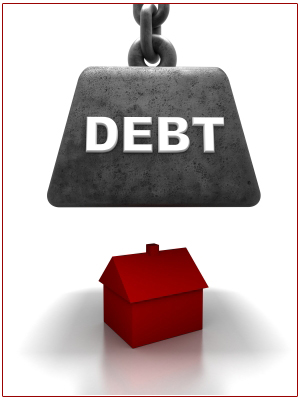
Secured Loans
A secured loan is a loan in which the borrower pledges some asset (e.g., a car or property) as collateral. A mortgage loan is a very common type of debt instrument, used by many individuals to purchase housing. In this arrangement, the money is used to purchase the property. The financial institution, however, is given security — a lien on the title to the house — until the mortgage is paid off in full. If the borrower defaults on the loan, the bank has the legal right to repossess the house and sell it, to recover sums owed to it.
If the sale of the collateral does not raise enough money to pay off the debt, the creditor can often obtain a deficiency judgment against the borrower for the remaining amount. Generally speaking, secured debt may attract lower interest rates than unsecured debt due to the added security for the lender. However, credit history, ability to repay, and expected returns for the lender are also factors affecting rates.
There are two purposes for a loan secured by debt. By extending the loan through secured debt, the creditor is relieved of most of the financial risks involved because it allows the creditor to take the property in the event that the debt is not properly repaid. For the debtor, a secured debt may receive more favorable terms than that available for unsecured debt, or to be extended credit under circumstances when credit under terms of unsecured debt would not be extended at all. The creditor may offer a loan with attractive interest rates and repayment periods for the secured debt.
Unsecured Loans
Unsecured loans are monetary loans that are not secured against the borrower’s assets. The interest rates applicable to these different forms may vary depending on the lender and the borrower. These may or may not be regulated by law.
Interest rates on unsecured loans are nearly always higher than for secured loans, because an unsecured lender’s options for recourse against the borrower in the event of default are severely limited. An unsecured lender must sue the borrower, obtain a money judgment for breach of contract, and then pursue execution of the judgment against the borrower’s unencumbered assets (that is, the ones not already pledged to secured lenders). In insolvency proceedings, secured lenders traditionally have priority over unsecured lenders when a court divides up the borrower’s assets. Thus, a higher interest rate reflects the additional risk that in the event of insolvency, the debt may be difficult or impossible to collect.
Unsecured loans are often used by borrowers for small purchases such as computers, home improvements, vacations, or unexpected expenses. An unsecured loan means the lender relies on the borrower’s promise to pay it back. Due to the increased risk involved, interest rates for unsecured loans tend to be higher. Typically, the balance of the loan is distributed evenly across a fixed number of payments; penalties may be assessed if the loan is paid off early. Unsecured loans are often more expensive and less flexible than secured loans, but suitable if the lender wants a short-term loan (one to five years).
In the event of the bankruptcy of the borrower, the unsecured creditors will have a general claim on the assets of the borrower after the specific pledged assets have been assigned to the secured creditors, although the unsecured creditors will usually realize a smaller proportion of their claims than the secured creditors.
In some legal systems, unsecured creditors who are also indebted to the insolvent debtor are able (and in some jurisdictions, required) to set-off the debts, which actually puts the unsecured creditor with a matured liability to the debtor in a pre-preferential position.
19.4.8: Short-Term Loans
Short-term loans offer individuals and businesses borrowing options to meet financial obligations.
Learning Objective
Classify different types of short term loans
Key Points
- Longer term funding is supplied by bonds and equity.
- Convenience is main benefit of a credit card to a business or entrepreneur .
- Venture capitalists use bridge loans to “bridge” cash flow gaps between successive major private equity financing terms.
Key Terms
- London Interbank Offered Rate
-
the average interest rate estimated by leading financial instiutions in London that they would be charged if borrowing from others
- collateral
-
A security or guarantee (usually an asset) pledged for the repayment of a loan if one cannot procure enough funds to repay. (Originally supplied as “accompanying” security. )
- benchmark
-
A standard by which something is evaluated or measured.
- venture capital
-
money invested in an innovative enterprise in which both the potential for profit and the risk of loss are considerable.
Example
- In December 2010, Kohlberg Kravis Roberts (KKR) and partners marketed a bridge loan for its upcoming acquisition of Del Monte Foods. As is common in such cases, KKR planned for the newly private company to borrow money by issuing corporate bonds. To ensure the money would be available, KKR sought $1.6 billion in bridge loan guarantees, for which it promised to pay 8.75 percent interest for 60 days and 11.75 percent thereafter. At KKR’s option, these loans could then be replaced with eight-year corporate bonds (in effect, a put option) paying 11.75 percent. In return for the loans and guarantees, KKR was offering roughly 2 percent in fees.
Short Term Loans
Short term loans are borrowed funds used to meet obligations within a few days up to a year. The borrower receives cash from the lender more quickly than with medium- and long-term loans, and must repay it in a shorter time frame.
Examples of short-term loans include:
Overdraft
Overdraft protection is a financial service offered by banking institutions in the United States. An overdraft occurs when money is withdrawn from a bank account and the available balance goes below zero. In this situation, the account is said to be “overdrawn. ” If there is a prior agreement with the account provider for an overdraft, and the amount overdrawn is within the authorized overdraft limit, then interest is normally charged at the agreed rate.
Credit Card
A credit card is a payment card issued to users as a method of payment. It allows the cardholder to pay for goods and services based on the holder’s promise to pay for them. The issuer of the card creates a revolving account and grants a line of credit to the consumer (or the user) from which the user can borrow money for payment to a merchant or as a cash advance to the user. For smaller businesses, financing via credit card is an easy and viable option.
The main benefit to a business or entrepreneur is convenience. Compared to debit cards and checks, a credit card allows small short-term loans to be quickly made to a customer. The customer then need not calculate a balance remaining before every transaction, provided the total charges do not exceed the maximum credit line for the card.
Payday Loans
A payday loan (also called a payday advance) is a small, short-term unsecured loan. These loans are also sometimes referred to as “cash advances,” though that term can also refer to cash provided against a credit card or other prearranged line of credit. The basic loan process involves a lender providing a short-term unsecured loan to be repaid at the borrower’s next pay day. Typically, some verification of employment or income is involved (via pay stubs and bank statements), but some lenders may omit this.
Money Market
The money market developed because parties had surplus funds, while others needed cash. The core of the money market consists of inter bank lending (banks borrowing and lending to each other using commercial paper), repurchase agreements, and similar short-term financial instruments. Because money market securities are typically denominated in high values, it is not common for individual investors to wholly own shares of money market securities; instead, investments are carried out by corporations or money market mutual funds. These instruments are often benchmarked to the London Interbank Offered Rate (LIBOR) for the appropriate term and currency.
Refund Anticipation Loan (RAL)
A refund anticipation loan (RAL) is a short-term consumer loan secured by a taxpayer’s expected tax refund designed to offer customers quicker access to funds than waiting for their tax refund. In the United States, taxpayers can apply for a refund anticipation loan through a paid professional tax preparation service.
Bridge Loans
A bridge loan is a type of short-term loan, typically taken out for a period of two weeks to three years pending the arrangement of larger or longer-term financing. It is interim financing for an individual or business until permanent or next-stage financing can be obtained. Money from the new financing is generally used to “take out” (i.e. to pay back) the bridge loan, as well as other capitalization needs.
Bridge loans are typically more expensive than conventional financing to compensate for the additional risk of the loan. Bridge loans typically have a higher interest rate, points and other costs that are amortized over a shorter period, as well as various fees and other “sweeteners” like equity participation by the lender. The lender also may require cross-collateralization and a lower loan-to-value ratio. On the other hand, they are typically arranged quickly with little documentation.
Bridge loans are used in venture capital and other corporate finance for several purposes:
- To inject small amounts of cash to carry a company so that it does not run out of cash between successive major private equity financing.
- To carry distressed companies while searching for an acquirer or larger investor (in which case the lender often obtains a substantial equity position in connection with the loan).
- As a final debt financing to carry the company through the immediate period before an initial public offering or acquisition.

Payday Loan store
Payday loan stores offer short term loans
19.5: Long-Term Financing
19.5.1: Financial Leverage
Financial leverage is a technique used to multiply gains and losses by obtaining funds through debt instead of equity.
Learning Objective
Explain the implications of leverage on a company’s risk
Key Points
- In terms of investments, there exists accounting leverage, notional leverage, and economic leverage.
- In corporate finance, financial leverage involves the use of debt instruments over equity instruments to acquire additional assets, therefore keeping stakeholders at a minium and per share profits at a maximum.
- It is possible to over-leverage, which is incurring a huge debt by borrowing funds at a lower rate of interest and using the excess funds in high risk investments in order to maximize returns.
- There is an important implicit assumption in evaluating the risk of leverage, which is that the underlying levered asset is the same as the unlevered one.
Key Terms
- notional
-
Speculative, theoretical, not the result of research.
- equity
-
Ownership interest in a company as determined by subtracting liabilities from assets.
- derivative
-
A financial instrument whose value depends on the valuation of an underlying asset; such as a warrant or an option.
Financial Leverage
Financial leverage is a general term for any technique to multiply gains and losses. Common ways to attain leverage are borrowing money or buying derivatives. Examples include:
- A public corporation may leverage its equity (stocks outstanding) by borrowing money. The more it borrows, the less equity capital it needs, so any profits or losses are shared among a smaller base and are proportionately larger as a result.
- A business entity can leverage its revenue by buying fixed assets. This will increase the proportion of fixed, as opposed to variable, costs, meaning that a change in revenue will result in a larger change in operating income .
Measuring Leverage
The term “leverage” is used differently in investments and corporate finance, and has multiple definitions in each field. In terms of investments, there exists accounting leverage, notional leverage, and economic leverage. Accounting leverage is total assets divided by the total assets minus total liabilities (or total equity). Notional leverage is total notional amount of assets plus total notional amount of liabilities divided by equity. Economic leverage is the volatility of an asset divided by volatility of an unlevered investment in the same assets.
Leverage In Corporate Finance
The concept of financial leverage is much more utilized and understood in the realm of corporate finance. Financial leverage tries to estimate the percentage change in net income for a one percent change in operating income. It involves the use of debt instruments over equity instruments to acquire additional assets, therefore keeping stakeholders at a minium and per share profits at a maximum. It is possible to over-leverage, which is incurring a huge debt by borrowing funds at a lower rate of interest and using the excess funds in high risk investments in order to maximize returns.
Leverage and Risk
The most obvious risk of leverage is that it multiplies losses. A corporation that borrows too much money might face bankruptcy during a business downturn, while a less-levered corporation might survive. There is an important implicit assumption, though, in evaluating the risk of leverage, which is that the underlying levered asset is the same as the unlevered one. If a company borrows money to modernize, or add to its product line, or expand internationally, the additional diversification might more than offset the additional risk from leverage.
From an investor’s point of view, if an individual uses a fraction of his or her portfolio to purchase derivatives and puts the rest in a money market fund, he or she might have the same volatility and expected return as an investor in an unlevered equity index fund, plus a limited downside. In short, while adding leverage to a given asset always adds risk, it is not the case that a levered company or investment is always riskier than an unlevered one. For example, many highly-levered hedge funds have less return volatility than unlevered bond funds, and public utilities with lots of debt are usually less risky stocks than unlevered technology companies.
There is a popular prejudice against leverage rooted in the observation that people who borrow a lot of money often end up in unfavorable situations. However, individuals who undertake such positions are not typically undertaking leverage. Instead, they are borrowing money for personal consumption. In finance, the general practice is to borrow money to buy an asset with a higher return than the cost of borrowing.
There also exists the risk of involuntary leverage. This is a situation in which a company or individual enters into financial distress and is forced to enter into a higher leveraged position. This multiplies losses as things continue to go downhill. This can lead to rapid ruin, even if the underlying asset value decline is mild or temporary.
19.5.2: Debt Finance
Debt is a way for firms to access capital for operations or investment with various terms and agreements for future repayment .
Learning Objective
Outline the characteristics of the different types of debt financing available
Key Points
- A debt obligation is considered secured, if creditors have recourse to the assets of the company on a proprietary basis or otherwise ahead of general claims against the company.
- Private debt comprises bank-loan type obligations, whether senior or mezzanine. Public debt is a general definition covering all financial instruments that are freely tradeable on a public exchange or over the counter, with few if any restrictions.
- A syndicated loan is a loan that is granted to companies that wish to borrow more money than any single lender is prepared to risk in a single loan, usually many millions of dollars.
Key Terms
- coupon
-
Any interest payment made or due on a bond, debenture or similar (no longer by a physical coupon).
- unsecured debt
-
Unsecured debt comprises financial obligations, where creditors do not have recourse to the assets of the borrower to satisfy their claims.
- Private debt
-
Private debt comprises bank-loan type obligations, whether senior or mezzanine.
Debt Finance
A company uses various kinds of debt to finance its operations . The various types of debt can generally be categorized into:

Debt
A company uses various kinds of debt to finance its operations.
- Secured and unsecured debt.
- Private and public debt.
- Syndicated and bilateral debt.
- Other types of debt that display one or more of the characteristics noted above.
A debt obligation is considered secured, if creditors have recourse to the assets of the company on a proprietary basis or otherwise ahead of general claims against the company. Unsecured debt comprises financial obligations, where creditors do not have recourse to the assets of the borrower to satisfy their claims.
Private debt comprises bank loan sorts of obligations, whether senior or mezzanine. Public debt is a general definition covering all financial instruments that are freely trade-able on a public exchange or over the counter, with few if any restrictions. A basic loan or “term loan” is the simplest form of debt. It consists of an agreement to lend a fixed amount of money, called the principal sum, for a fixed period of time, with the amount to be repaid by a certain date. In commercial loans interest, calculated as a percentage of the principal sum per year, will also have to be paid by that date, or may be paid periodically in the interval, such as annually or monthly. Such loans are also colloquially called “bullet loans”, particularly if there is only a single payment at the end – the “bullet” – without a “stream” of interest payments during the “life” of the loan.
A syndicated loan is a loan that is granted to companies that wish to borrow more money than any single lender is prepared to risk in a single loan, usually many millions of dollars. In such a case, a syndicate of banks can each agree to put forward a portion of the principal sum. Loan syndication is a risk management tool that allows the lead banks underwriting the debt to reduce their risk and free up lending capacity. A bond is a debt security issued by certain institutions such as companies and governments. A bond entitles the holder to repayment of the principal sum, plus interest. Bonds are issued to investors in a marketplace when an institution wishes to borrow money. Bonds have a fixed lifetime, usually a number of years; with long-term bonds, lasting over thirty years, being less common. At the end of the bond’s life, the money should be repaid in full. Interest may be added to the end payment, or can be paid in regular installments (also known as coupons) during the life of the bond. Bonds may be traded in bond markets, and are widely used as relatively safe investments in comparison to equity.
Lending to stable financial entities such as large companies or governments are often termed “risk free” or “low risk” and made at a so-called “risk-free interest rate”. This is because the debt and interest are highly unlikely to be defaulted. A good example of such risk-free interest is a US Treasury security – it yields the minimum return available in economics, but investors have the comfort of the (almost) certain expectation that the US Treasury will not default on its debt. A risk-free rate is also commonly used in setting floating interest rates, which are usually calculated as the risk-free interest rate plus a bonus to the creditor based on the creditworthiness of the debtor (in other words, the risk of him or her defaulting and the creditor losing the debt). In reality, no lending is truly risk free, but borrowers at this rate are considered the least likely to default.
Debt allows people and organizations to do things that they would otherwise not be able, or allowed, to do. Commonly, people in industrialised nations use it to purchase houses, cars and many other things too expensive to buy with cash on hand. Companies also use debt in many ways to leverage the investment made in their assets, “leveraging” the return on their equity. This leverage, the proportion of debt to equity, is considered important in determining the riskiness of an investment; the more debt per equity, the riskier. For both companies and individuals, this increased risk can lead to poor results, as the cost of servicing the debt can grow beyond the ability to pay due to either external events (income loss) or internal difficulties (poor management of resources).
19.5.3: Equity Finance
Companies can use equity financing to raise money and/or increase shareholder liquidity (through an IPO).
Learning Objective
Explain the process of financing a firm through equity
Key Points
- The equity, or capital stock (or stock) of a business entity represents the original capital paid into or invested in the business by its founders.
- Shares represent a fraction of ownership in a business. A business may declare different types or classes of shares, each having distinctive ownership rules, privileges, or share values.
- In finance, the cost of equity is the return (often expressed as a rate of return) a firm theoretically pays to its equity investors, (i.e., shareholders), to compensate for the risk they undertake by investing their capital.
Key Terms
- Preferred Stock
-
Stock with a dividend, usually fixed, that is paid out of profits before any dividend can be paid on common stock and that has priority to common stock in liquidation.
- Common stock
-
Shares of an ownership interest in the equity of a corporation or other entity with limited liability entitled to dividends, with financial rights junior to preferred stock and liabilities.
- par value
-
The amount or value listed on a bill, note, stamp, etc.; the stated value or amount.
Equity
The equity, or capital stock (or stock) of a business entity represents the original capital paid into or invested in the business by its founders. It serves as a security for the creditors of a business since it cannot be withdrawn to the detriment of the creditors. Stock is different from the property and the assets of a business which may fluctuate in quantity and value.
The stock of a business is divided into multiple shares, the total of which must be stated at the time of business formation. Given the total amount of money invested in the business, a share has a certain declared face value, commonly known as the par value of a share. The par value is the minimum amount of money that a business may issue and sell shares for in many jurisdictions, and it is the value represented as capital in the accounting of the business.
Shares represent a fraction of ownership in a business. A business may declare different types or classes of shares, each having distinct ownership rules, privileges, or share values. Ownership of shares is documented by the issuance of a stock certificate. A stock certificate is a legal document that specifies the amount of shares owned by the shareholder, and other specifics of the shares, such as the par value, if any, or the class of the shares.
Stock typically takes the form of either common or preferred. As a unit of ownership, common stock typically carries voting rights that can be exercised in corporate decisions. Preferred stock differs from common stock in that it typically does not carry voting rights but is legally entitled to receive a certain level of dividend payments before any dividends can be issued to other shareholders.
Financing through Equity
The owners of a private company may want additional capital to invest in new projects within the company. They may also simply wish to reduce their holding, freeing up capital for their own private use. They can achieve these goals by selling shares in the company to the general public, through a sale on a stock exchange. This process is called an Initial Public Offering, or IPO.
By selling shares they can sell part or all of the company to many part-owners. The purchase of one share entitles the owner of that share to literally share in the ownership of the company, a fraction of the decision-making power, and potentially a fraction of the profits, which the company may issue as dividends.
Public companies may issue additional shares (thus diluting current equity holders) to raise money to fund operations or capital investments.
Financing a company through the sale of stock in a company is known as equity financing. Alternatively, debt financing (for example issuing bonds) can be done to avoid giving up shares of ownership of the company. Unofficial financing known as trade financing usually provides the major part of a company’s working capital (day-to-day operational needs).
Cost of Equity
In finance, the cost of equity is the return, often expressed as a rate of return, a firm theoretically pays to its equity investors, (i.e., shareholders) to compensate for the risk they undertake by investing their capital. Firms need to acquire capital from others to operate and grow. Individuals and organizations who are willing to provide their funds to others naturally desire to be rewarded. Just as landlords seek rents on their property, capital providers seek returns on their funds, which must be commensurate with the risk undertaken.
Firms obtain capital from two kinds of sources: lenders and equity investors. From the perspective of capital providers, lenders seek to be rewarded with interest and equity investors seek dividends and/or appreciation in the value of their investment (capital gain). From a firm’s perspective, they must pay for the capital it obtains from others, which is called its cost of capital. Such costs are separated into a firm’s cost of debt and cost of equity and attributed to these two kinds of capital sources.
While a firm’s present cost of debt is relatively easy to determine from observation of interest rates in the capital markets, its current cost of equity is unobservable and must be estimated. According to finance theory, as a firm’s risk increases/decreases, its cost of capital increases/decreases. This theory is linked to observation of human behavior and logic: capital providers expect reward for offering their funds to others. Such providers are usually rational and prudent preferring safety over risk. They naturally require an extra reward as an incentive to place their capital in a riskier investment instead of a safer one. If an investment’s risk increases, capital providers demand higher returns or they will place their capital elsewhere.
19.5.4: Long-Term Loans
Three common examples of long term loans are government debt, mortgages, and debentures (bonds).
Learning Objective
Outline the characteristics of three types of long term loans: debt, mortgages and bonds
Key Points
- Government debt (also known as public debt or national debt) is owed by a central government. Government debt is one of several methods of financing government operations.
- A mortgage is a loan secured by real property. It requires a mortgage note affirming the existence of the loan and the encumbrance of the realty through the granting of a mortgage securing the loan.
- A debenture is a document that either creates or acknowledges a debt, and the debt is one without collateral.
Key Term
- Long term loans
-
Loans that are generally understood to be over a year in duration – often much longer.
Long Term Loans
Long term loans are generally over a year in duration and sometimes much longer. Three common examples of long term loans are government debt, mortgages, and bonds or debentures .
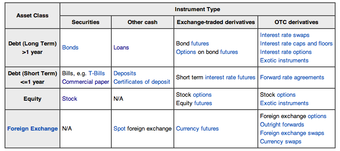
Different Financial Instruments
Long term loans are generally over a year in duration and sometimes much longer.
Government Debt
Government debt (also known as public debt or national debt) is the debt owed by a central government. Government debt is one of numerous methods of financing government operations.
Governments may create money to monetize their debts, thereby removing the need to pay interest. This practice, also known as quantitative easing, reduces government interest costs but does not actually cancel government debt. Governments usually borrow by issuing securities, government bonds, and bills. Less creditworthy countries sometimes borrow directly from a supranational organization (e.g., the World Bank) or international financial institutions.
Government bonds are issued by a national government. Such bonds are often denominated in the country’s domestic currency, and they are sometimes regarded as risk-free bonds, as national governments can raise taxes or reduce spending up to a certain point. In many cases, governments print more money in order to redeem the bond at maturity. Most governments in developed countries are prohibited by law from printing money directly, as this function is generally assigned to their central banks. However, central banks may buy government bonds in order to finance government spending, thereby monetizing the debt.
Mortgage Loan
A mortgage is a loan secured by real property. It requires a mortgage note affirming the existence of the loan and the encumbrance of the realty through the granting of a mortgage securing the loan. In U.S. property law, a mortgage occurs when an owner (usually of a fee simple interest in realty) pledges his or her interest (right to the property) as security or collateral for a loan.
A home buyer or builder can obtain a loan to purchase or secure against the property from a financial institution, such as a bank, or either directly or indirectly through intermediaries. Features of mortgage loans such as the size of the loan, maturity of the loan, interest rate, method of paying off the loan, and other characteristics can vary considerably.
Mortgage loans are generally structured as long term loans, the periodic payments for which are similar to an annuity and calculated according to the time value of money formulae. The most basic arrangement requires a fixed monthly payment over a period of ten to thirty years, depending on local conditions. Over this period, the principal component of the loan (the original loan) is slowly paid down through amortization. However, many variants on this arrangement are possible within different countries.
Many types of mortgages are used worldwide, though several characteristics, subject to local regulations and legal requirements, define most mortgages:
- Interest: Interest may be fixed for the life of the loan or variable, and it may change at certain pre-defined periods; the interest rate may rise or fall.
- Term: Mortgage loans generally have a maximum term, or a number of years after which an amortizing loan will be repaid. Some mortgage loans may have no amortization or require full repayment of any remaining balance at a certain date; others may have negative amortization.
- Payment amount and frequency: The amount paid per period and the frequency of payments may change, or the borrower may have the option to increase or decrease the amount paid.
- Prepayment: Some types of mortgages may limit or restrict prepayment of all or a portion of the loan, or they may require payment of a penalty to the lender for prepayment.
Debenture
A debenture is a document that either creates or acknowledges a debt, and the debt is one without collateral. In corporate finance, debenture refers to a medium- to long-term debt instrument used by large companies to borrow money. In some countries, the term is used interchangeably with bond, loan stock, or note. A debenture thus resembles a certificate of loan or a loan bond, evidencing the fact that the company is liable to pay a specified amount with interest. Although the money raised by the debenture becomes part of the company’s capital structure, it does not become share capital.
In general, debentures are freely transferable by the debenture holder. Debenture holders have no right to vote in the company’s general meetings of shareholders, but they may hold separate meetings or votes (regarding, for instance, changes to the rights attached to the debentures). The interest paid to debenture holders is a charge against profit in the company’s financial statements.

Level of Public Debt as a Percentage of GDP
U.S., Japan, and Germany
19.5.5: Corporate Bonds
A corporate bond is issued by a corporation seeking to raise money in order to expand its business.
Learning Objective
Explain how an organization can finance their operations through bonds
Key Points
- The term corporate bond is typically applied to longer-term debt instruments with a maturity date falling at least a year after the issue date.
- Corporate bonds are often listed on major exchanges (and referred to as listed bonds) and ECNs, and the coupon (i.e., the interest payment) is usually taxable.
- Corporate debt falls into several broad categories: secured debt and unsecured debt; senior debt and subordinated debt.
Key Term
- default
-
The condition of failing to meet an obligation.
Corporate Bonds
A corporate bond is issued by a corporation seeking to raise money in order to expand the business. The term corporate bond is usually applied to longer-term debt instruments with a maturity date falling at least a year after the issue date. (The term commercial paper is sometimes used for instruments with a shorter maturity period. ) Sometimes, corporate bond is used in reference to all bonds with the exception of those issued by governments in their own currencies. Strictly speaking, however, the term only applies to bonds issued by corporations .
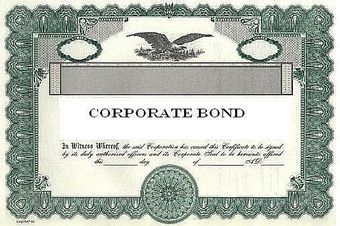
Corporate Bond
A corporate bond is issued by a corporation seeking to raise money in order to expand its business.
Corporate bonds are often listed on major exchanges (and known as listed bonds) and ECNs, and the coupon (i.e., the interest payment) is usually taxable. Sometimes, the coupon can be zero with a high redemption value. However, though many are listed on exchanges, the vast majority of corporate bonds in developed markets are traded in decentralized, dealer-based, over-the-counter markets.
Corporate bonds and corporate debt fall into several broad categories:
Secured loan/debt:
A secured loan is one in which the borrower pledges some asset (e.g., a car or property) as collateral for the loan, which in turn becomes a secured debt owed to the creditor of the loan. The debt is thus secured against the collateral, and in the event that the borrower defaults, the creditor takes possession of the collateral asset and may sell it in order to recover some or all of the amount loaned.
Unsecured loan/debt:
The opposite of secured debt is unsecured debt, which is not linked to any specific piece of property. In the case of unsecured debt, the absence of collateral means that the creditor may only satisfy the debt against the borrower. The comparative security of secured debt for the lender generally results in lower interest rates for secured than for unsecured debt. However, the borrower’s credit history and ability to repay, as well as the expected returns for the lender, are factors that also affect rates.
Senior debt:
Senior debt, frequently issued in the form of senior notes and sometimes referred to as senior loans, is debt that takes priority over unsecured or junior debt owed by the issuer. Senior debt has seniority over subordinated debt in the issuer’s capital structure. In the event of bankruptcy or liquidation, senior debt must be repaid before any other creditors receive payment. Senior debt is often secured by collateral on which the lender has placed a first lien, which typically covers all the assets of a corporation and is frequently used in the resolution of credit lines.
Subordinated debt:
Subordinated debt is repaid after other debts in the case of liquidation or bankruptcy. Such debt is referred to as subordinate, because the debt providers (the lenders) have subordinate status relative to the normal debt. Subordinated debt has a lower priority than the issuer’s other bonds and ranks below the liquidator, government tax authorities, and senior debt holders in the hierarchy of creditors. Because subordinated debt is repaid only after other debts have been paid, they are riskier for lenders. Subordinated debt is also unsecured and has a lower priority than any additional debt claim on the same asset.
In the event of a default, the higher one’s position in the company’s capital structure, the stronger one’s claims to the company’s assets.
Chapter 18: Financial Statements
18.1: Ratio Analysis and Statement Evaluation
18.1.1: Financial Statements Across Periods
Companies prepare three financial statements according to GAAP rules: the income statement, the balance sheet, and the cash flow statement.
Learning Objective
Identify the three main financial statements that companies generally submit
Key Points
- The income statement gives an account of what the company sold and spent in the year (revenues and expenses).
- The balance sheet is a financial snapshot of the company’s assets and liabilities, and informs shareholders about its financial health.
- The cash flow statement shows what came into and went out of the company in cash. It gives a better idea than the other two financial statements about how well the company can meet its cash obligations.
- The Securities and Exchange Commission (SEC) regulates these financial statements. Companies must file extensive reports annually (known as a 10K), as well as quarterly reports (10Q).
- A company may report its financials in a fiscal year that is different from the calendar year.
Key Terms
- 10Q
-
A quarterly report mandated by the United States federal Securities and Exchange Commission to be filed by publicly traded corporations.
- generally accepted accounting principles
-
The standard framework of guidelines for financial accounting used in any given jurisdiction; generally known as accounting standards. GAAP includes the standards, conventions, and rules accountants follow in recording and summarizing, and in the preparation of financial statements.
- 10K
-
An annual report, required by the U.S. Securities and Exchange Commission (SEC), that gives a comprehensive summary of a public company’s performance.
Example
- Publicly traded companies must make their financial statements available for all to see. These can be found on a financial website, such as finance.yahoo.com.
Financial statements are records that outline the financial activities of a business, individual, or any other entity . Corporations report financial statements following Generally Accepted Accounting Principles (GAAP). The rules about how financial statements should be put together are set by the Financial Accounting Standards Board (FASB). Standardized rules ensure, to some extent, that a firm’s financial statements accurately represent the company’s financial status.

Financial Statements Analysis
Corporations report financial statements following Generally Accepted Accounting Principles (GAAP).
Companies generally submit three forms of financial statements. The information contained in these statements, and how this information fluctuates across periods, is very telling for investors and government regulatory agencies. These three financial statements are:
The income statement (also called the “profit and loss statement”): This gives an account of what the company sold and spent in the year. Sales (also called “revenues”), or what the company sold in products and services, less any expenses (expenses are divided into a number of categories) and less taxes, gives the company’s income. The income statement summarizes all this type of activity for the year.
The balance sheet: This is a financial snapshot of what the company owns (assets), what it owes (liabilities), and its worth free and clear of debt (or the value of its equity). Analyzing a balance sheet informs shareholders about the company’s financial health.
The cash flow statement: It tells what transactions went into and came out of the company in the form of cash. This is necessary because accounting sometimes deals with revenues and expenses which are not real cash, such as accounts receivable and accounts payable. Looking at the actual cash flow gives a better idea of how well the company can meet its cash obligations.
The period represented in a given financial statement can vary. A company may report its financials in a fiscal year that is different from the calendar year. While some firms do follow the calendar year, others–such as retail companies–prefer not to follow the calendar year due to seasonality of sales or expenses, et cetera.
The reporting of these financial statements is regulated by the federal agency, the Securities and Exchange Commission (SEC). According to SEC regulations, companies have to file an extensive report (called the 10K) on what happened during the year. In addition to the 10K, companies have to file 10Qs every three months, which give their quarterly financial performance. These reports can be accessed through the SEC’s website, www.sec.gov, the company’s website, or various financial websites, such as finance.yahoo.com.
18.1.2: Profitability Ratios
Profitability ratios are used to assess a business’s ability to generate earnings.
Learning Objective
Compare the information given by calculating the various profitability ratios
Key Points
- Profitability ratios are used to compare companies in the same industry, since profit margins will vary widely from industry to industry.
- Taxes should not be included in these ratios, since tax rates will vary from company to company.
- The profit margin shows the relationship between profit and sales and is mostly used for internal comparison.
- Profit Margin = Net Profit / Net Sales. It shows the relationship between profit and sales and is mostly used for internal comparison.
- ROE = Net Income / Shareholder Equity. It measures a firm’s efficiency at generating profits from every unit of shareholders’ equity.
- The BEP ratio compares earnings before income and taxes to total assets. BEP = EBIT / Total Assets.
Key Terms
- financial leverage
-
The degree to which an investor or business is utilizing borrowed money.
- Cost of Goods Sold
-
Cost of goods sold (COGS) refer to the inventory costs of those goods a business has sold during a particular period.
- profitability
-
The capacity to make a profit.
Example
- Company A had a net income last year of ten thousand dollars. It operated with two thousand five hundred dollars worth of assets. Thus, its ROA = 10000 / 2500 = 4. Therefore, it derives four dollars for each dollar of assets it owns. In that time, its net sales were fifty thousand dollars. Thus, the Profit Margin = 10000 / 50000 = 20 percent. This figure should be compared to its competitors in order to determine whether this is healthy or not.
Profitability Ratios
Profitability ratios show how much profit the company takes in for every dollar of sales or revenues. They are used to assess a business’s ability to generate earnings as compared to expenses over a specified time period .

Increasing Profits
Profitability ratios are used to assess a business’s ability to generate earnings.
Profitability ratios are going to vary from industry to industry, so comparisons should be between other companies in the same field. When comparing companies in the same industry, the company with the higher profit margin is able to sell at a higher price or lower expenses. They tend to be more attractive to investors.
Net Profit Margins and Returns on Sales
Many analysts focus on net profit margins or returns on sales, which are calculated by taking the net income after taxes and dividing by the revenues or sales. This ratio uses the bottom line on the income statement to calculate profit for every dollar of sales or revenues. The operating margin takes the profit before taxes further up the income statement and divides by revenues. Operating margins are also important, since they focus on the operating income and operating expenses. Other profitability ratios include:
- Return on Assets: The return on assets ratio (ROA) is found by dividing the net income by total assets. The higher the ratio, the better the company is at using their assets to generate income (i.e., how many dollars of earnings they derive from each dollar of assets they control). It is also a measure of how much the company relies on assets to generate profit. The return on assets gives an indication of the company’s capital intensity, which will depend on the industry. Companies that require large initial investments will generally have reduced return on assets.
- Profit Margin: The profit margin is one of the most used profitability ratios. The profit margin refers to the amount of profit that a company earns through sales. The profit margin ratio is broadly the ratio of profit to total sales times one hundred percent. The higher the profit margin, the more profit a company earns on each sale. The profit margin is mostly used for internal comparison. It is difficult to accurately compare the net profit ratio for different entities. A low profit margin indicates a low margin of safety and a higher risk that a decline in sales will erase profits and result in a net loss or a negative margin.
- Return on Equity: The return on equity (ROE) measures profitability related to ownership. It measures a firm’s efficiency at generating profits from every unit of the shareholders’ equity. ROEs between 15 percent and 20 percent are generally considered good. The ROE is equal to the net income divided by the shareholder equity.
- Basic Earning Power Ratio: The basic earning power ratio (or BEP ratio) compares earnings separately from the influence of taxes or financial leverage to the assets of the company. The BEP is equal to the earnings before interest and taxes divided by the total assets. The BEP differs from the ROA in that it includes the non-operating income.
- Gross Profit Ratio: This indicates what portion of each sales dollar is available to meet expenses and generate profit after taking into account the cost of goods sold. Generally, it is calculated as the selling price of an item minus the cost of goods sold (production or acquisition costs).
18.1.3: Liquidity Ratios
Liquidity ratios measure how quickly assets can be turned into cash in order to pay the company’s short-term obligations.
Learning Objective
Compare the current ratio to the quick ratio
Key Points
- Liquidity ratios should fall within a certain range—too low and the company cannot pay off its obligations, or too high and the company is not utilizing its cash efficiently.
- Current Ratio = Current Assets / Current Liabilities. This ratio examines whether a firm can cover its short-term debts. If below 1, the company may have difficulty meeting short-term obligations.
- Acid Test Ratio (or Quick Ratio) = [Current Assets – Inventories] / Current Liabilities. More stringent and meaningful than the Current Ratio, since it does not include inventory. A ratio of 1:1 is recommended, but not necessarily a minimum.
- A company can improve its liquidity ratios by raising the value of its current assets, reducing current liabilities by paying off debt, or negotiating delayed payments to creditors.
Key Terms
- liquidity ratio
-
total cash and equivalents divided by short-term borrowings
- liquidity
-
An asset’s ability to become solvent without affecting its value; the degree to which it can be easily converted into cash.
- creditor
-
A person to whom a debt is owed.
Example
- Company X has $1,000 dollars in cash, and $2,000 worth of inventory to be sold. Company X owed Company Y $1,000 dollars. X’s Current Ratio = 3000 / 1,000 = 3, and so can be considered healthy. X’s Acid Test Ratio = 1,000 / 1,000 = 1, which means that it can pay off short-term obligations. It is also not too high, and so cash is not idle.
Liquidity ratios measure a company’s ability to pay short-term obligations of one year or less (i.e., how quickly assets can be turned into cash). A high liquidity ratio indicates that a business is holding too much cash that could be utilized in other areas. A low liquidity ratio means a firm may struggle to pay short-term obligations.
One such ratio is known as the current ratio, which is equal to:
Current Assets ÷ Current Liabilities.
This ratio reveals whether the firm can cover its short-term debts; it is an indication of a firm’s market liquidity and ability to meet creditor’s demands. Acceptable current ratios vary from industry to industry. For a healthy business, a current ratio will generally fall between 1.5 and 3. If current liabilities exceed current assets (i.e., the current ratio is below 1), then the company may have problems meeting its short-term obligations. If the current ratio is too high, the company may be inefficiently using its current assets or its short-term financing facilities. This may also indicate problems in working capital management.
The acid test ratio (or quick ratio) is similar to current ratio except in that it ignores inventories. It is equal to:
(Current Assets – Inventories) Current Liabilities.
Typically the quick ratio is more meaningful than the current ratio because inventory cannot always be relied upon to convert to cash. A ratio of 1:1 is recommended. Low values for the current or quick ratios (values less than 1) indicate that a firm may have difficulty meeting current obligations. Low values, however, do not indicate a critical problem. If an organization has good long-term prospects, it may be able to borrow against those prospects to meet current obligations.
A firm may improve its liquidity ratios by raising the value of its current assets, reducing the value of current liabilities, or negotiating delayed or lower payments to creditors.
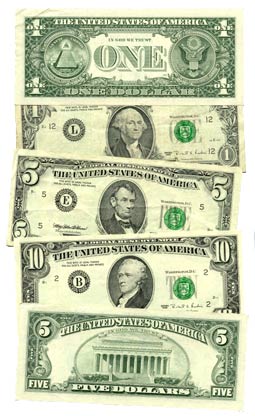
Cash
Cash is the most liquid asset in a business.
18.1.4: Debt Utilization Ratios
Debt ratios provide information about a company’s long-term financial health.
Learning Objective
Explain the methods and usage of debt utilization ratios
Key Points
- Generally speaking, the more debt a company has (as a percentage of assets), the less healthy it is financially.
- Debt Ratio = Total Debt / Total Assets. It shows the percentage of a company’s assets that are provided through debt. The higher the ratio, the greater the risk the company has undertaken.
- Debt-to-Equity Ratio (D/E) = Debt (i.e. Liabilities) / Equity. It shows the split of shareholders’ equity and debt that are used to finance the company’s assets.
- The DCR shows the ratio of cash available for debt servicing to interest, principal, and lease payments. The higher this ratio, the easier it is for a company to take on new debt.
Key Terms
- debt financing
-
funding obtained by borrowing assets
- amortization
-
The reduction of loan principle over a series of payments.
- debt
-
Money that one person or entity owes or is required to pay to another, generally as a result of a loan or other financial transaction.
- Interest
-
The price paid for obtaining or price received for providing money or goods in a credit transaction, calculated as a fraction of the amount or value of what was borrowed.
Example
- If Company F has $100,000 in assets, and $10,000 in total liabilities, it would have a debt ratio of 10,000 / 100,000 = 10%. Company G, on the other hand, may have $100,000 worth of assets and $200,000 worth of liabilities. In this case, it has a debt ratio of 200%.
Debt utilization ratios provide a comprehensive picture of the company’s solvency or long-term financial health. The debt ratio is a financial ratio that indicates the percentage of a company’s assets that are provided via debt. It is the ratio of total debt (the sum of current liabilities and long-term liabilities) and total assets (the sum of current assets, fixed assets, and other assets such as “goodwill”).
Debt Ratio = Total Debt / Total Assets
For example, a company with $2 million in total assets and $500,000 in total liabilities would have a debt ratio of 25%. The higher the ratio, the greater the risk associated with the firm’s operation. In addition, high debt to assets ratio may indicate low borrowing capacity of a firm, which in turn will lower the firm’s financial flexibility. Like all financial ratios, a company’s debt ratio should be compared with their industry average or other competing firms.
The debt-to-equity ratio (D/E) is a financial ratio indicating the relative proportion of shareholders’ equity and debt used to finance a company’s assets. When used to calculate a company’s financial leverage, the debt usually includes only the Long Term Debt (LTD). D/E = Debt(liabilities)/Equity.
The debt service coverage ratio (DSCR), also known as debt coverage ratio (DCR), is the ratio of cash available for debt servicing to interest, principal, and lease payments. It is a popular benchmark used in the measurement of an entity’s ability to produce enough cash to cover its debt (including lease) payments. The higher this ratio is, the easier it is to obtain a loan. In general, it is calculated as:
DSCR = (Annual Net Income +
Amortization
/
Depreciation
+ Interest
Expense
+ other non-cash and discretionary items (such as non-contractual
management
bonuses)) / (Principal Repayment + Interest payments + Lease payments)
A similar debt utilization ratio is the times interest earned (TIE), or interest coverage ratio. It is a measure of a company’s ability to honor its debt payments. It may be calculated as either EBIT or EBITDA, divided by the total interest payable. EBIT is earnings before interest and taxes, and EBITDA is earnings before interest, taxes, depreciation, and amortization.
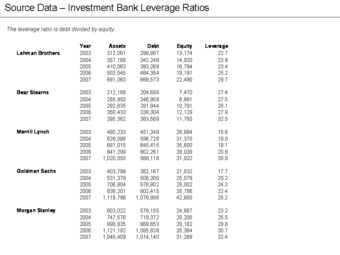
Leverage Ratios
Leverage ratios for some investment banks
18.1.5: Comparisons Within an Industry
Most financial ratios have no universal benchmarks, so meaningful analysis involves comparisons with competitors and industry averages.
Learning Objective
Explain how to effectively use financial statement analysis
Key Points
- Ratios allow easier comparison between companies than using absolute values of certain measures. They negate the impact of scale in profitability or solvency.
- Firms should generally try to meet or exceed the industry average, over time, in their ratios.
- Industry trends, changes in price levels, and future economic conditions should all be considered when using financial ratios to analyze a firm’s performance.
Key Terms
- solvency
-
The state of having enough funds or liquid assets to pay all of one’s debts; the state of being solvent.
- bankruptcy
-
A legally declared or recognized condition of insolvency of a person or organization.
Example
- Suppose Company Z has $100,000 in assets and $40,000 in total liabilities, it would have a debt ratio of 40,000 / 100,000 = 40%. If the industry average is 50%, then Company Z is in a good financial position debt-wise. Alternatively, if the industry average over time is only 25%, then Company Z should consider ways to reduce its debt.
Financial statement analysis (or financial analysis) is the process of reviewing and analyzing a company’s financial statements to make better economic decisions. These statements include the income statement, balance sheet, statement of cash flows, and a statement of retained earnings. Financial statement analysis is a method or process involving specific techniques for evaluating risks, performance, financial health, and future prospects of an organization.
Financial statements can reveal much more information when comparisons are made with previous statements, rather than when considered individually. Horizontal analysis compares financial data, such as an income statements, over a period of several quarters or years. When comparing past and present financial information, one will want to look for variations such as higher or lower earnings. Moreover, it is often useful to compare the financial statements of companies in related industries.
Ratios of risk such as the current ratio, the interest coverage, and the equity percentage have no theoretical benchmarks. It is, therefore, common to compare them with the industry average over time. If a firm has a higher equity ratio than the industry, this is considered less risky than if it is below the average. Similarly, if the equity ratio increases over time, it is a good sign in relation to insolvency risk.
The main purpose of conducting financial analysis is to measure a business’s profitability and solvency. The actual metrics tracked and methods applied vary from stakeholder to stakeholder, depending on his or her interests and needs. For example, equity investors are interested in the long-term earnings power of the organization and perhaps the sustainability and growth of dividend payments. Creditors want to ensure the interest and principal is paid on the organizations debt securities (e.g., bonds) when due.
Most analytical measures are expressed as percentages or ratios, which allows for easy comparison with other businesses in the industry regardless of absolute company size. Vertical analysis, which is a proportional analysis of financial statements, lists each line item in the financial statement as the percentage of another line item. For example, on an income statement each line item will be listed as a percentage of gross sales. This technique is also referred to as normalization or common-sizing.
When using these analytical measures, one should take the following factors into consideration:
- Industry trends;
- Changes in price levels;
- Future economic conditions.
Ratios must be compared with other firms in the same industry to see if they are in line .

Refining Operation
Ratio analyses can be used to compare between companies within the same industry. For example, comparing the ratios of BP and Exxon Mobil would be appropriate, whereas comparing the ratios of BP and General Mills would be inappropriate.
18.1.6: Performance per Share
Valuation ratios describe the value of shares to shareholders, and include the EPS ratio, the P/E ratio, and the dividend yield ratio.
Learning Objective
Identify the ratio analysis tools used for shares of stock
Key Points
- EPS (Earnings Per Share) = Net Income / Average Common Shares. This ratio gives the earnings per outstanding share of a company’s stock.
- P/E Ratio = Market Price per Share / Annual Earnings per Share. This ratio is widely used to measure the relative value of companies. The higher the P/E ratio, the more investors are paying for each unit of net income.
- Current Dividend Yield = Most Recent Full Year Dividend / Current Share Price. Displays the earnings distributed to stock holders in relation to the value of the stock.
- Market To Book ratio is used to compare a company’s current market price to its book value.
Key Terms
- stockholder
-
One who owns stock.
- dividend
-
A pro rata payment of money by a company to its shareholders, usually made periodically (e.g., quarterly or annually).
Company Performance Per Share
The below ratios describe the value of shares of stock to stockholders, both in terms of dividends and their general ownership value:
- Earnings Per Share (EPS) is the amount of earnings per each outstanding share of a company’s stock. Companies are required to report EPS for each of the major categories of the income statement, including: continuing operations, discontinued operations, extraordinary items, and net income. EPS = Net Income / Average Common Shares.
- Price to Earnings (P/E) ratio relates market price to earnings per share. The P/E ratio is a widely used metric used for measuring the relative value of companies. A higher P/E ratio means that investors are paying more for each unit of net income; therefore, the stock is more expensive compared to one with a lower P/E ratio. The P/E ratio also shows the number of years of earnings which would be required to pay back the purchase price—ignoring inflation, earnings growth and the time value of money. P/E Ratio = Market Price Per Share / Annual Earnings Per Share .
- Dividend Yield ratio shows the earnings distributed to stockholders related to the value of the stock, as calculated on a per-share basis. The dividend yield or the dividend-price ratio of a share is the company’s total annual dividend payments divided by its market capitalization—or the dividend per share, divided by the price per share. It is often expressed as a percentage. Current Dividend Yield = Most Recent Full Year Dividend / Current Share Price.
- Dividend Payout ratio shows the portion of earnings distributed to stockholders. Dividend payout ratio is the fraction of net income a firm pays to its stockholders in dividends: Dividend Payout Ratio = Dividends / Net Income for the Same Period. The part of earnings not paid to investors is left for investment to provide for future earnings growth. Investors seeking high current income and limited capital growth prefer companies with a high dividend payout ratio. However, investors seeking capital growth may prefer a lower payout ratio, because capital gains are taxed at a lower rate. High growth firms in early life generally have low or zero payout ratios. As they mature, they tend to return more of the earnings back to investors.
- Market To Book ratio is used to compare a company’s current market price to its book value. The calculation can be performed in two ways, but the result should be the same using either method. In the first method, the company’s market capitalization can be divided by the company’s total book value from its balance sheet (Market Capitalization / Total Book Value). The second method, using per-share values, is to divide the company’s current share price by the book value per share, which is its book value divided by the number of outstanding shares (Share Price / Book Value Per Share). A higher market to book ratio implies that investors expect management to create more value from a given set of assets, all else equal. This ratio also gives some idea of whether an investor is paying too much for what would be left if the company went bankrupt immediately.
18.1.7: Activity Ratios
Activity ratios provide useful insights regarding an organization’s ability to leverage existing assets efficiently.
Learning Objective
Calculate activity ratios to determine organizational efficiency
Key Points
- Organizations are largely systems of assets that produce outputs. The efficiency of how those assets are used can be measured via activity ratios.
- There are a number of different activity ratios commonly used by stakeholders and managers to assess overall organizational efficiency, most importantly asset turnover, inventory turnover, and degree of operating leverage.
- Different businesses and industries tend to focus more on some activity ratios than others. Knowing what ratio is relevant based on the operation or process is an important consideration for managerial accountants.
- Inventory turnover is highly relevant for industries selling perishable or time sensitive goods. On the other hand, manufacturing facilities tend to be more concerned with fixed asset turnover.
Key Terms
- leverage
-
To use in such a way to capture maximum value.
- perishable
-
A good that has an expiration date, or can go bad.
Why Firms Measure Activity
Activity ratios are essentially indicators of how a given organization leverages their existing assets to generate value. When considering the nature of a business, the general concept is to generate value through utilizing various production processes, employee talent, and intellectual property. Through identifying the profit compared to the investment in these core assets, the overall efficiency of the organization’s utilization can be derived.
How to Measure Activity
There are a number of ways to measure activity. Each calculation has different inputs and different implications. Some examples include:
- Average collection period – (Accounts Receivable)/(Daily Average Credit Sales)
- Degree of Operating Leverage (DOL) – (Percent Change in Net Operating Income)/(Percent Change in Sales)
- DSO Ratio – (Accounts Receivable)/(Daily Average Sales)
- Average Payment Period – (Accounts Payable)/(Average Daily Credit Purchases)
- Asset Turnover – (Net Sales)/(Total Assets)
- Stock Turnover Ratio – (Cost of Goods Sold)/(Average Inventory)
- Receivables Turnover Ratio – (Net Credit Sales)/(Average Net Receivables)
- Inventory Conversion Ratio – (365 Days)/(Inventory Turnover)
- Receivables Conversion Period – (Receivables/Net Sales)(365 Days)
- Payable Conversion Period – (Receivables/Net Sales)(365 Days)
- Cash Conversion Cycle – Inventory Conversion Period + Receivable Conversion Period – Payable Conversion Period
Using Activity Ratios
By tracking these metrics over time, and comparing them to the competition, organizations and stakeholders can gauge their competitiveness and overall capacity to leverage assets in the current industry. Understanding how to use these ratios, and what the implications are, is central to financial and managerial accounting at the strategic level.
For some business, inventory turnover is an incredibly important metric. A business selling farmed produce, for example, must have a highly sophisticated value chain with minimal warehousing and storage. Inventory turnover must be rapid, as the goods being sold are perishable. Fashion industries are similarly reliant on inventory turnover, as the seasonality of both fashion styles and climate create a strong necessity for careful activity management.
For other businesses, asset turnover is a central activity metric. A manufacturing facility producing semiconductors, for example, will invest heavily in the production facility and related equipment. Ensuring maximum production and annual sales contracts is integral to maintaining profitability, and maximizing utilization of those fixed assets will enormously impact profitability.
18.1.8: Sample Evaluation
Most of the ratios discussed can be calculated using information found in the three main financial statements.
Learning Objective
Apply financial ratio analysis to Bounded Inc.
Key Points
- Keep in mind that for most ratios, the number must be compared against competitors and industry standards for it to be meaningful.
- The ROE (Return on Equity) measures the firm’s ability to generate profits from every unit of shareholder equity.
- ROEs between 15 percent and 20 percent are generally considered good.
Key Term
- ROA
-
The return on assets (ROA) percentage shows how profitable a company’s assets are in generating revenue.
Consider the company Bounded Inc., a magazine publisher, to illustrate the financials of a company. The following information is based on the company’s FY (financial year) 2011 performance:
- Cash: $3,230
- Cost of Goods Sold: $2,390
- Current Assets: $1,000
- Current Liabilities: $3,500
- Depreciation: $800
- Fixed Assets: $8,600
- Interest Payments: $300
- Inventory: $2,010
- Long-term Debt: $3,000
- Sales: $5,000
Using the information above, we can compile the balance sheet and the income statement. We can also calculate some financial ratios to determine the company’s financial situation. Keep in mind that for most ratios, the number must be compared against competitors and industry standards for it to be meaningful:
ROA (Return on Assets) = Net Income / Total Assets = 1,057 / 13,840 = 7.6%
This means that for every dollar of assets the company controls, it derives $0.076 of profit. This would need to be compared to others in the same industry to determine whether this is a high or low figure.
Profit Margin = Net Income / Net Sales = 1,057/5,000 = 21.1 percent
This figure would need to be compared to competitors. A lower profit margin indicates a low margin of safety.
ROE (Return on Equity) = Net Income / Shareholder Equity = 1,057/7,340 = 14.4 percent
The ROE measures the firm’s ability to generate profits from every unit of shareholder equity. 0.144 (or 14 percent) is not a bad figure, but by no means a very good once, since ROE’s between 15 to 20 percent are generally considered good.
BEP Ratio = EBIT / Total Assets = 1,810/13,840 = 0.311
Current Ratio = Current Assets / Current Liabilities = 5,240/3,500 = 1.497
This demonstrates that the company does not seem to be in a tight position in terms of liquidity.
Quick Ratio = (Current Assets-Inventories) / Current Liabilities = (5,240 – 2,010) / 3,500 = 0.923
Despite having a current ratio of about 1.0, the quick ratio is slightly below 1.0. This means that the company may face liquidity problems should payment of current liabilities be demanded immediately. But it does not seem to be a huge cause for concern.
Debt Ratio = Total Debt / Total Assets = 6,500/13,840 = 47 percent
This indicates the percentage of a company’s assets that are provided via debt. The higher the ratio, the greater risk will be associated with the firm’s operation.
D/E Ratio = Long-term Debt/Equity = 3,000/7,340 = 40.9 percent
This shows the relative proportion of shareholders’ equity and debt used to finance a company’s assets. Once again, comparisons should be made between companies in the same industry in order to determine whether this is a low or high figure.

Financial Statement
One form of financial statement is the income statement.
18.2: Accounting Information
18.2.1: Usage of Accounting Information
Accounting is the vehicle for reporting financial information about a business entity to many different groups of people.
Learning Objective
Explain the history of accounting and how accounting information is useful
Key Points
- The American Accounting Association defines accounting as “the process of identifying, measuring and communicating economic information to permit informed judgements and decisions by users of the information.”
- Accounting involves two main elements: (1) an information process summarizing financial events; and (2) a reporting system that communicates financial information to interested parties.
- Double-entry bookkeeping first emerged in Northern Italy in the 14th century, where trading ventures began to require transactions that involved more than one investor.
- Management (or internal) accounting and financial (or external) accounting are generally the two key branches of accounting.
- Management accounting provides relevant and useful information to people inside the business, such as employees, managers, owners and auditors. It provides information for decision making and company strategy.
- Financial accounting, on the other hand, also provides information to people outside the business, such as investors, regulators, analysts, economists, and government agencies.
Key Terms
- double-entry bookkeeping
-
A method of bookkeeping in which each transaction must have at least one debit and one credit.
- Financial statements
-
Standardized documents that include the financial information of a person, company, government, or organization; this information is used to make financial decisions.
- accounting
-
The process of identifying, measuring and communicating economic information to permit informed judgements and decisions by users of the information. (definition by the American Accounting Association)
- stakeholders
-
People outside of a company who have a special interest in the company. Some examples are suppliers, customers, and the community.
Using Accounting Information
The American Accounting Association defines accounting as “the process of identifying, measuring and communicating economic information to permit informed judgements and decisions by users of the information.” In other words, it is the process of communicating financial information about a business entity to stakeholders and managers. Economic information is generally displayed in the form of financial statements that show the economic resources that a business currently has; the goal of the business is to determine which information is useful to the outside world.
Accounting involves two main elements:
- An information process that identifies, classifies and summarizes the financial events that take place within an organization
- A reporting system that communicates relevant financial information to interested persons, allowing them to assess performance, make decisions, and/or control the economic resources in the organization.
It is important to note that accounting is not the end of the decision making process; it provides the most relevant and reliable information possible to allow for goals to be developed, implemented, and revised.
Accounting History
Early accounts served mainly to assist a businessperson in recalling financial transactions. The proprietor or record keeper was usually the only person to see this information. Cruder forms of accounting were inadequate when a business needed multiple investors. As a result, double-entry bookkeeping first emerged in northern Italy in the 14th century, where trading ventures began to require more capital than a single individual was able to invest.
The development of joint stock companies created wider audiences for accounts, as investors without firsthand knowledge of their operations relied on accounts to provide additional information. This development resulted in the division of accounting systems for internal (i.e. management accounting) and external (i.e. financial accounting) purposes. This also led to the separation of internal and external accounting and disclosure regulations.
Accounting Today
Today, accounting is referred to as “the language of business” because it is the vehicle for reporting financial information about a business entity to many different groups of people. Accounting that concentrates on reporting to people inside the business entity is called management accounting. It is used to provide information to employees, managers, and auditors. Management accounting is concerned primarily with providing a basis for making management or operating decisions.
Accounting that provides information to people outside the business entity is called financial accounting. It provides information to present and potential shareholders, creditors, vendors, financial analysts, and government agencies. Because these users have different needs, the presentation of financial accounts is very structured and subject to many more rules than management accounting. The body of rules that governs financial accounting is called Generally Accepted Accounting Principles, or GAAP. The International Financial Reporting Standards, or IFRS, provides another set of accounting rules.
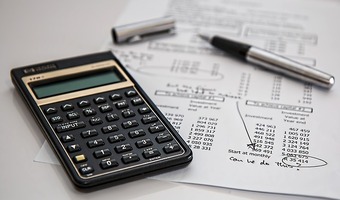
Accounting
Accounting allows a business to track its financial information.
18.2.2: Managerial Accounting
Through integrating accounting knowledge with strategic decision-making, organizations can improve performance, refine strategy, and mitigate risk.
Learning Objective
Integrate a knowledge of accounting with its impact on strategic decision-making
Key Points
- Through utilizing managerial accounting perspectives, strategic managers can vastly improve their understanding of performance and recognize areas of potential improvement.
- One critical difference between financial and managerial accounting is that managerial accounting is designed to flexibly align to current operations, while financial accounting sticks to global formats.
- Another key difference between financial and managerial accounting is chronological focal point. Managerial accounting is forward-looking, while financial accounting tends to look at the past.
- A few examples of managerial accounting include cost benefit analysis, life cycle costs, developing new business metrics, and geographically segmented reporting.
Key Terms
- financial accounting
-
Accounting that focuses on preparation of stakeholder documents (particularly for publicly traded companies) and collecting data on past operational performance.
- managerial accounting
-
Accounting that combines strategic decision-making with accounting knowledge through providing specific tools to measure the financial implications of various internal activities.
Management accounting is one of the most interesting and broad-minded applications of the accounting perspective. There exists a strong relationship between the knowledge accounting delivers to managerial teams, and the strategic and tactical decisions made by management. Through this integration, organizations can improve their decision-making to strategic value in the form of improved performance and mitigated risks.
Differentiating Managerial Accounting
When looking at traditional financial accounting, managerial accounting differs in a few key ways:
- For public organizations, a variety of reports are released quarterly and annually for stakeholders. Managerial accounting creates additional documents used for internal, strategic decision-making.
- Financial accounting is generally historical, while managerial accounting is about forecasting.
- Managerial accounting tends to lean a bit more on abstraction, utilizing various models to support financial decisions.
- While financial accounting fits the mold expected by stakeholders, managerial accounting is flexible and strives to meet the needs of management exclusively.
- Financial accounting looks at the company holistically, while financial accounting can zoom in at various levels (i.e. product level, division level, etc.)
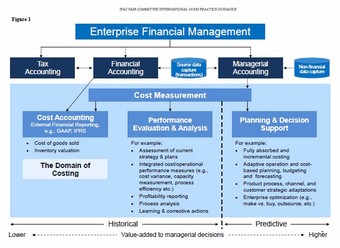
Differences between Financial and Managerial Accounting
This is a great image depicting the various differences in perspective found between different accounting methodologies. Looking at managerial accounting in this diagram, one can better understand its place in the organization.
Examples of Managerial Accounting
There are countless specific examples of managerial accounting practices. Taking a look at a few will provide additional scope and perspective on the field:
Throughput Accounting: Production processes have a great deal of inter-dependency. This can create opportunity costs, as interdependent resources are being restrained. Measuring the contribution per unit of constrained resource is called throughput accounting.
Lean Accounting: During the days when the Toyota Production System was just becoming celebrated as a leaner process, accountants began to consider the restrictions of traditional accounting methods on lean processes. As a result, managerial accounts began constructing a better way to measure just-in-time manufacturing process success.
Some simpler examples of common managerial accounting tasks include developing business metrics, cost-benefit analyses, IT cost transparency, life cycle cost analysis, strategic management advice, sales forecasting, geographically segmented reporting, and rate and volume analysis.
Managerial accounting is inherently flexible, and drives towards maximizing internal efficiency through careful consideration of opportunity costs and various customized metrics.
18.2.3: Financial Accounting
Financial accounting is a core organizational function in which accountants prepare a variety of documents to inform stakeholders of the financial health of operations.
Learning Objective
List the various expectations of a financial accounting statement, along with the three common statements produced
Key Points
- The role of financial accounting is of high importance, both for informing external stakeholders and for providing critical information to management.
- Financial accounting statements must be relevant, material, reliable, understandable, and comparable.
- The balance sheet measures all assets, liabilities, and stakeholder equity to identify and understand the organizations leverage position.
- The income statement is a top down statement, in which revenues are considered in the context of the costs and expenses required to obtain them. This ultimately demonstrates profitability.
- The statement of cash flows is all about liquidity, and identifying how much free cash is available to the organization for investment purposes.
- Taking all of these documents into account, stakeholders can derive a clear view of the health and efficiency of operation of a given organization.
Key Terms
- chronological
-
In order of time, usually earliest to latest.
- materiality
-
The state of being consequential in the making of a decision.
The Role of Financial Accounting
Financial accounting focuses on the tracking and preparation of financial statements for internal management and external stakeholders, such as suppliers, investors, government agencies, owners, and other interest groups. These financial statements are consistent with accounting guidelines and formatting, particularly for publicly traded organizations. This allows individuals unfamiliar with day to day operations to see the overall performance, health, and relative profitability of a given organization.
Characteristics of Financial Accounting
Generally speaking, it is expected by financial accounting standards that an organization maintain the following qualities when submitting financial accounting information:
- Relevance – Financial statements must be applicable to the decisions being made, and presented in a way that allows for distilling useful insights.
- Materiality – The information present must be of the quality that indicates consequence in strategic or legal decisions. This is to say that nothing of materiality should be omitted as well.
- Reliability – All information must be free of error, and reported with pinpoint accuracy.
- Understandability – Clarity and efficiency in presentation is important, as it must be immediately readable and without the possibility of being misinterpreted.
- Comparability – Finally, all presented financial statements should align with current best practices in accounting to ensure that the material presented is validly compared to that of other organizations.
How to Conduct Financial Accounting
Financial accountants are tasked with producing three primary documents that indicate a health check on various aspects (or at times all aspects) of the organization. These three statements are the balance sheet, the income statement, and the statement of cash flows.
Balance Sheet
A balance sheet demonstrates the overall value of organizational assets by listing current and long-term assets (fixed or otherwise) alongside short term and long term liabilities and stakeholder equity. Through balancing the assets against the combination of liabilities and stakeholder equity, the financial accounting should encounter a zero sum game.
Simply put: Assets = Liabilities + Shareholder Equity. This is the golden rule of balance sheets (hence the name: balance). The items on a balance sheet can range from long term debt to current inventory to dividends to accounts receivable to cash on hand. Anything and everything that can be valued should be included in this calculation.
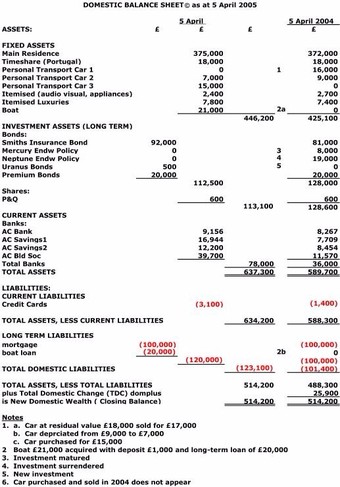
Balance Sheet Example
This balance sheet demonstrates such common line items an account will be populated and measuring when creating and releasing this financial statement.
Income Statement
As opposed to something that balances, the income statement is more of a one directional document. Picture this as a mathematical illustration of the organizations operations, from the production floor all the way to the hands of the consumer. When organizations go through such a process (producing, shipping, storing, paying taxes, selling, providing service, etc.), the expectation is that the price point established will cover all relevant costs while producing some percentage of net income. An income statement calculates whether or not a business is accomplishing this.
To picture it, let’s create a simple example. You own a pizza shop. You sold 1000 pizzas last month. Each pizza sold for $10 on average. That gives you $10,000, but this is your revenue, not your profit. For each pizza, it costs $4 in cheese, dough, sauce and toppings. That brings you down to $6,000. You have to pay your bills and your rent, which is takes you down another $2,000. Now, you’re at $4,000, and you end up paying $1,500 to your employees in wages. Of your $2,500 remaining, 40% goes to state and federal taxes. Your overall net income for the month is $1,500. This process is what an income statement does.
Statement of Cash Flows
The final statement is the statement of cash flows, which aims to identify how much capital in the organization is liquid (i.e. easily converted into spend). This is more of a chronological statement, as it takes the previous pay period and the current pay period, and identifies the difference in overall available cash.
The purpose of this document is quite interesting. An organizations available cash could be considered their flexibility in capturing external opportunities (e.g., investing in new opportunities, such as offering a new product or acquiring a competitor).
Combine these three documents, and stakeholders have a fairly clean view of what goes on in the organization. The balance of their assets, the overall profitability of their operations, and the availability of capital for expansion. This is the role of financial accountants.
18.2.4: Tax Accounting
Tax accounting couples legal obligations with financial accounting to ensure adherence to current tax laws.
Learning Objective
Understand the role of tax accounting in both small and large organizations
Key Points
- Every region has specific tax accounting rules and regulations. Adhering to these rules and regulations is critical to avoiding penalties and ensuring ethical behavior in the country (and/or state) of operation.
- Tax accountants act as a bridge between the organization and the governments that collect financial obligations. As a result, it requires a combination of financial and legal knowledge.
- On the financial side, tax accounts must understand the legal implications of decisions, as both opportunities and threats exist.
- On the legal side, the preparation, assessment, and delivery of tax documents is a time-sensitive and detail-oriented process that must be regularly maintained.
- Some unique situations exist in tax accounting, such as accounting for non-profit organizations (who don’t pay taxes). This still requires considerable legal know how and operational alignment with governmental regulations.
Key Term
- Tax accounting
-
The activity that focuses on satisfying legal accounting obligations through the preparation, analysis, and presentation of required tax documentation.
Tax accounting is relatively simple to explain, though nuanced in execution. In short, every region has specific tax accounting rules and regulations. Adhering to these rules and regulations is critical to avoiding penalties and ensuring ethical behavior in the country (and/or state) of operation. Tax accounting is therefore a combination of legal and financial knowledge.
The Financial Side
Tax accountants act as the bridge between an organization’s accounting team and the reporting bodies in the region. As a result, the primary role of a tax accountant is to understand the business’ current operating status, distill profitability before tax, and report earnings.
On the strategic side of this, tax accountants can consider any tax implications as it pertains to certain strategic decisions or tactics. Identifying and understanding opportunities in a region’s tax code is a win win. For example, some manufacturers can receive tax breaks for environmentally friendly operations, often high enough tax breaks to offset the cost of implementing them. Tax accountants should be aware of these opportunities in the legal environment.
The Legal Side
More tangibly, tax accounts will focus on the preparation, analysis, and presentation of tax payments and tax returns at all times. There are specialized accounting principles and obligations for each area of operation which must be met. Keeping up to date on what is expected, and ensuring alignment on across the organization, is their primary responsibility.
Some exceptions exist, of course, such as non-profit organizations. Non-profits have unique tax preparation requirements due to their no-tax status. This comes along with its fair share of obligations, paperwork, and approvals from the governing bodies.
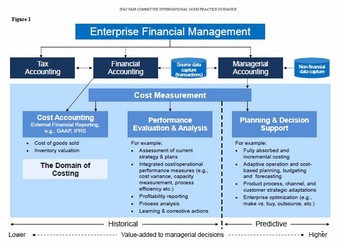
Various Accounting Perspectives
This image demonstrates the various responsibilities and perspectives of different forms of accounting (those being tax accounting, managerial accounting and financial accounting).
18.2.5: Government and Nonprofit Accounting
Governmental and nonprofit accounting follow different rules from those of commercial enterprises.
Learning Objective
Compare public vs. private accounting
Key Points
- Public sector entities have different goals to the private sector, who’s main goal is to make a profit. Public entities must be more fiscally responsible. The usage of government accounting processes also differs significantly from the use in the private sector.
- Publicly elected officials and their employees must be accountable to the public, and thus government accounting provides information on whether taxpayer funds are used responsibly or not.
- Government accounting must also serve the same purpose as commercial accounting, that is to provide information for decision-making purposes. The difference in this case is the recipient of the information is a government official, with different priorities and goals.
- Nonprofits also have unique accounting systems and standards. They generally use accrual basis accounting for their funds.
- Nonprofit financial statements generally include a balance sheet, a statement of activities or statement of support, a statement of functional expenses, and a cash flow statement.
Key Terms
- budget
-
An itemized summary of intended expenditure; usually coupled with expected revenue.
- Governmental accounting
-
Governmental accounting is an umbrella term which refers to the various accounting systems used by various public sector entities.
Public Sector Accounting
Governmental accounting is an umbrella term which refers to the various accounting systems used by various public sector entities. In the United States, for instance, there are two levels of government which follow different accounting standards set forth by independent, private sector boards. At the federal level, the Federal Accounting Standards Advisory Board (FASAB) sets forth the accounting standards to follow. Similarly, there is the Governmental Accounting Standards Board (GASB) for state and local level government .

Accounting
Governmental and Nonprofit accounting follow different rules to those of commercial enterprises.
Public vs. Private Accounting
There is an important difference between private sector accounting and governmental accounting. The main reasons for this difference is the environment of the accounting system. In the government environment, public sector entities have differing goals, as opposed to the private sector entities’ one main goal of gaining profit. Also, in government accounting, the entity has the responsibility of fiscal accountability which is demonstration of compliance in the use of resources in a budgetary context. In the private sector, the budget is a tool in financial planning and it is not mandatory to comply with it.
Government accounting refers to the field of accounting that specifically finds application in the public sector or government. The unique objectives of government accounting do not preclude the use of the double entry accounting system. There can, however, be other significant differences with private sector accounting practices, especially those that are intended to arrive at a net income result. Thus, a special field of accounting exists because:
- The objectives to which accounting reports to differ significantly from that for which generally accepted accounting practice has been developed for in the private (business) sector; and
- The usage of the results of accounting processes of government differs significantly from the use thereof in the private sector.
The objectives for which government entities apply accountancy can be organized in two main categories:
- The accounting of activities for accountability purposes. In other words, the representatives of the public, and officials appointed by them, must be accountable to the public for powers and tasks delegated. The public, who have no other choice but to delegate, are in a position that differs significantly from that of shareholders and therefore need financial information, to be supplied by accounting systems, that is applicable and relevant to them and their purposes.
- Decision-making purposes. The relevant role-players, especially officials and representatives, need financial information that is accounted, organized and presented for the objectives of their decision-making. These objectives bear, in many instances, no relation to net income results but are rather about service delivery and efficiency. The taxpayer, a very significant group, simply wants to pay as little taxes as possible for the essential services for which money is being coerced by law.
The governmental accounting system has a different focus for measuring accounting than private sector accounting. Rather than measuring the flow of economic resources, governmental accounting measures the flow of financial resources. Instead of recognizing revenue when they are earned and expenses when they are incurred, revenue is recognized when there is money available to liquidate liabilities within the current accounting period, and expenses are recognized when there is a drain on current resources.
Nonprofit Organizations
Nonprofit organizations generally use the following five categories of funds:
- Current fund – unrestricted. This fund is used to account for current assets that can be used at the discretion of the organization’s governing board.
- Current funds – restricted use current assets subject to restrictions assigned by donors or grantors.
- Land, building and equipment fund. Cash and investments reserved specifically to acquire these assets, and related liabilities, should also be recorded in this fund.
- Endowment funds are used to account for the principal amount of gifts the organization is required, by agreement with the donor, to maintain intact in perpetuity or until a specific future date or event.
- Custodian funds are held and disbursed according to the donor’s instructions.
18.2.6: Consumers of Accounting Information
Most of a company’s stakeholders consume its accounting information in one form or another.
Learning Objective
Explain the history of accounting
Key Points
- Double-entry bookkeeping first emerged in Northern Italy in the fourteenth century.
- As companies grew bigger, accounting standards were required for those without firsthand knowledge of operations to be able to understand the finances and operations of the company.
- Managers, employees, owners, and auditors all desire the information provided by management accounting.
- On the other hand, external auditors, potential and actual shareholders, creditors, analysts, economists, and government agencies rely on financial accounting statements to provide them with the information they need.
Key Terms
- IFRS
-
International Financial Reporting Standards (IFRS) are designed as a common global language for business affairs so that company accounts are understandable and comparable across international boundaries.
- GAAP
-
Generally Accepted Accounting Principles (GAAP) refer to the standard framework of guidelines for financial accounting used in any given jurisdiction; generally known as accounting standards.
Early accounts served mainly to assist the memory of the businessperson, and the audience for the account was the proprietor or record keeper alone. Cruder forms of accounting were inadequate for the problems created by a business entity involving multiple investors, so double-entry bookkeeping first emerged in northern Italy in the fourteenth century, where trading ventures began to require more capital than a single individual was able to invest.
The development of joint stock companies created wider audiences for accounts, as investors without firsthand knowledge of their operations relied on accounts to provide the requisite information. This development resulted in a split of accounting systems for internal (i.e., management accounting) and external (i.e., financial accounting) purposes and, subsequently, also in accounting and disclosure regulations and a growing need for independent attestation of external accounts by auditors.
Today, accounting is called “the language of business” because it is the vehicle for reporting financial information about a business entity to many different groups of people. Accounting that concentrates on reporting to people inside the business entity is called “management accounting” and is used to provide information to employees, managers, owner-managers, and auditors.
Management accounting is concerned primarily with providing a basis for making management or operating decisions. Accounting that provides information to people outside the business entity is called “financial accounting” and provides information to present and potential shareholders and creditors, such as banks or vendors, financial analysts, economists, and government agencies. Because these users have different needs, the presentation of financial accounts is very structured and subject to many more rules than management accounting. The body of rules that governs financial accounting in a given jurisdiction is the Generally Accepted Accounting Principles, or GAAP. Other rules include International Financial Reporting Standards, or IFRS, or U.S. GAAP.
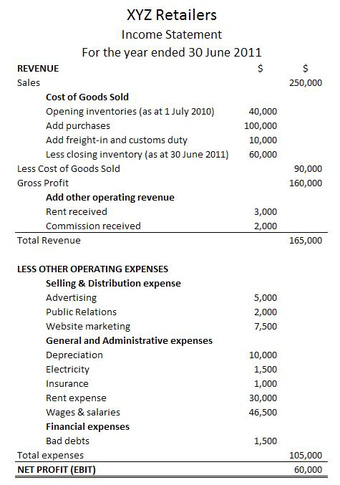
A Sample Income Statement
Expenses are listed on a company’s income statement.
18.3: The Accounting Process
18.3.1: The Accounting Equation
The accounting equation is a general rule used in business transactions where the sum of liabilities and owners’ equity equals assets.
Learning Objective
Break down the fundamental accounting equation
Key Points
- This equation is kept in balance after every business transaction. Everything falls under these three elements (assets, liability, owners’ equity) in a business transaction.
- Assets = Liabilities + Equity.
- The fundamental accounting equation is the foundation of the balance sheet.
Key Terms
- Accounting Equation
-
The “basic accounting equation” is the foundation for the double-entry bookkeeping system. For each transaction, the total debits equal the total credits.
- equity
-
Ownership interest in a company as determined by subtracting liabilities from assets.
- liabilities
-
An amount of money in a company that is owed to someone and has to be paid in the future, such as tax, debt, interest, and mortgage payments.
Example
- A company with $30,000 in liabilities and $10,000 in owners’ equity would have $40,000 in assets according to the accounting equation.
The fundamental accounting equation, which is also known as the balance sheet equation, looks like this:
. On the left side of the equation are the assets of the business, including cash, accounts receivable, notes receivable, property, plants, and equipment. Or more correctly, the term “assets” represents the value of the resources of the business.
On the right side of the equation are claims of ownership on those assets: liabilities are the claims of creditors (those “outside” the business); and equity, or owners’ equity, is the claim of the owners of the business (those “inside” the business). The fundamental accounting equation is kept in balance after every business transaction because everything falls under these three elements in a business transaction.
For example, when a company intends to purchase new equipment, its owner or board of directors has to choose how to raise funds for the purchase. Looking at the fundamental accounting equation, one can see how the equation stays is balance. If the funds are borrowed to purchase the asset, assets and liabilities both increase. If the company issues stock to obtain the funds for the purchase, then assets and equity both increase.
Additionally, changes is the accounting equation may occur on the same side of the equation. For example, if the company uses cash to purchase inventory, cash is decreased (credited) and inventory is increased (debited); thus, assets as a whole remain unchanged and the equation remains in balance. Likewise, as the company receives payment from its customers, accounts receivable is credited and cash is debited.
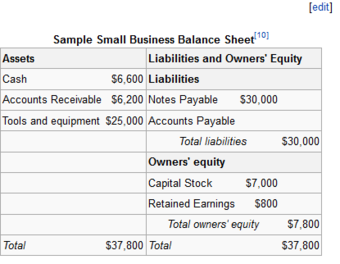
Sample Balance Sheet
A balance sheet shows how the accounting equation is applied.
18.3.2: Double-Entry Bookkeeping
A double-entry bookkeeping system requires that every transaction be recorded in at least two different nominal ledger accounts.
Learning Objective
Explain the fundamentals of accounting bookkeeping
Key Points
- In the double-entry accounting system, each accounting entry records related pairs of financial transactions for asset, liability, income, expense, or capital accounts.
- There are two different approaches to the double entry system of bookkeeping. They are Traditional Approach and Accounting Equation Approach.
- Recording of a debit amount to one account and an equal credit amount to another account results in total debits being equal to total credits for all accounts in the general ledger.
Key Terms
- debit
-
Debit and credit are the two fundamental aspects of every financial transaction in the double-entry bookkeeping system in which every debit transaction must have a corresponding credit transaction(s) and vice versa.
- debit card
-
a product that can be used to make payments by drawing money directly from the user’s bank account
Double-Entry Bookkeeping
A double-entry bookkeeping system is a set of rules for recording financial information in a financial accounting system in which every transaction or event changes at least two different nominal ledger accounts.
In the double-entry accounting system, each accounting entry records related pairs of financial transactions for asset, liability, income, expense, or capital accounts. Recording of a debit amount to one account and an equal credit amount to another account results in total debits being equal to total credits for all accounts in the general ledger. If the accounting entries are recorded without error, the aggregate balance of all accounts having positive balances will be equal to the aggregate balance of all accounts having negative balances. Accounting entries that debit and credit related accounts typically include the same date and identifying code in both accounts, so that in case of error, each debit and credit can be traced back to a journal and transaction source document, thus preserving an audit trail.
The “Golden Rules of Accounting”
The rules for formulating accounting entries are known as “Golden Rules of Accounting”. The accounting entries are recorded in the “Books of Accounts”. Regardless of which accounts and how many are impacted by a given transaction, the fundamental accounting equation A = L + OE (assets equals liabilities plus owner’s equity) will hold.
There are two different approaches to the double entry system of bookkeeping. They are the Traditional Approach and the Accounting Equation Approach. Irrespective of the approach used, the effect on the books of accounts remain the same, with two aspects (debit and credit) in each of the transactions.
Traditional Approach (British)
Following this approach, accounts are classified as real, personal, or nominal accounts. Real accounts are assets. Personal accounts are liabilities and owners’ equity and represent people and entities that have invested in the business. Nominal accounts are revenue, expenses, gains, and losses.
Transactions are entered in the books of accounts by applying the following golden rules of accounting:
- Personal account: Debit the receiver and credit the giver
- Real account: Debit what comes in and credit what goes out
- Nominal account: Debit all expenses & losses and credit all incomes & gains
Accounting Equation Approach (American)
Under this approach, transactions are recorded based on the accounting equation, i.e., Assets = Liabilities + Capital. The accounting equation is a statement of equality between the debits and the credits. The rules of debit and credit depend on the nature of an account. For the purpose of the accounting equation approach, all the accounts are classified into one of the following five types:
- Assets
- Liabilities
- Income/revenues
- Expenses
- Capital gains/losses
If there is an increase or decrease in one account, there will be an equal decrease or increase in another account. There may be equal increases to both accounts, depending on what kind of accounts they are. There may also be equal decreases to both accounts. Accordingly, the following rules of debit and credit in respect to the various categories of accounts can be obtained.
The rules may be summarized as below:
- Assets accounts: Debit increases in assets and credit decreases in assets
- Capital account: Credit increases in capital and debit decreases in capital
- Liabilities accounts: Credit increases in liabilities and debit decreases in liabilities
- Revenues or Incomes accounts: Credit increases in incomes and gains and debit decreases in incomes and gains
- Expenses or Losses accounts: Debit increases in expenses and losses and credit decreases in expenses and losses

Example of Double entry bookkeping
Purchase Invoice Daybook
18.3.3: The Accounting Cycle
The accounting cycle includes analysis of transactions, transferring journal entries into a general ledger, revenue, and expense closed.
Learning Objective
Outline the accounting cycle from point of transaction to financial statements
Key Points
- When a transaction occurs, a document is produced. Most of the time these documents are external to the business, however, they can also be internal documents, such as inter-office sales. These documents are referred to as a source document.
- The Journal entries are then transferred to a Ledger. The group of accounts is called ledger, or a book of accounts. The purpose of a Ledger is to bring together all of the transactions for similar activity.
- Financial statements are drawn from the trial balance which may include: the Income statement, the Balance sheet, and the Cash flow statement.
- 3. prepare trial balance
- 4. post adjusting entries
- 5. prepare adjusted trial balance
- 6. prepare financial statements
- 7. post closing entries
- 8. prepare a post closing trial balance
Key Term
- Journal entries
-
A journal entry, in accounting, is a logging of transactions into accounting journal items. The journal entry can consist of several items, each of which is either a debit or a credit.
When a transaction occurs, a document is produced. Most of the time these documents are external to the business, however, they can also be internal documents, such as inter-office sales.
These documents are referred to as a source document. Some examples are: the receipt you get when you purchase something at the store, interest you earned on your savings account which is documented in your monthly bank statement, and the monthly electric utility bill that comes in the mail. These source documents are then recorded in a Journal. This is also known as a book of first entry. It records both sides of the transaction recorded by the source document. These write-ups are known as Journal entries.
These Journal entries are then transferred to a Ledger, which is the group of accounts, also known as a book of accounts. The purpose of a Ledger is to bring together all of the transactions for similar activity. For example, if a company has one bank account, then all transactions that include cash would then be maintained in the Cash Ledger. This process of transferring the values is known as posting. Once the entries have all been posted, the Ledger accounts are added up in a process called Balancing.
A particular working document called an unadjusted Trial balance is created. This lists all the balances from all the accounts in the Ledger. Notice that the values are not posted to the trial balance, they are merely copied. At this point accounting happens. The accountant produces a number of adjustments which make sure that the values comply with accounting principles. These values are then passed through the accounting system resulting in an adjusted Trial balance. This process continues until the accountant is satisfied.
Financial statements are drawn from the trial balance which may include: the Income statement, the Balance sheet, and the Cash flow statement.
Finally, all the revenue and expense accounts are closed.
18.4: The Balance Sheet
18.4.1: Defining the Balance Sheet
The balance sheet is a summary of the financial balances of a company.
Learning Objective
Explain the fundamental elements of the balance sheet
Key Points
- The balance sheet is often described as a snapshot of a company’s financial condition.
- Unlike the other basic financial statements, the balance sheet only applies to a single point in time of the calendar year.
- It shows the assets, liabilities, and ownership equity of the company, and allows for an analysis of the company’s financial health.
Key Terms
- balance sheet
-
A summary of a person’s or organization’s assets, liabilities and equity as of a specific date.
- calendar year
-
The amount of time between corresponding dates in adjacent years in any calendar.
The Balance Sheet
In financial accounting, a balance sheet is a snapshot of a company’s (sole proprietorship, a business partnership, a corporation, or other business organization, such as an LLC or an LLP) financial situation. Assets, liabilities, and ownership equity are listed as of a specific date, such as the end of the company’s financial year. Of the four basic financial statements, the balance sheet is the only statement which applies to a single point in time of a business’ calendar year. A standard company balance sheet has three parts: assets, liabilities, and ownership equity. The main categories of assets are usually listed first, and typically in order of liquidity. Assets are followed by the liabilities. The difference between the assets and the liabilities is known as the equity (or the net assets, or the net worth, or capital) of the company, and according to the accounting equation, net worth must equal assets minus liabilities.
Another way to look at the same equation is that assets equals liabilities plus owner’s equity. Looking at the equation in this way shows how assets were financed: either by borrowing money (liability) or by using the owner’s money (owner’s equity). Balance sheets are usually presented with assets in one section and liabilities and net worth in the other section with the two sections “balancing. “
A business operating entirely in cash can measure its profits by withdrawing the entire bank balance at the end of the period, plus any cash in hand. However, many businesses are not paid immediately; they build up inventories of goods and they acquire buildings and equipment. In other words: businesses have assets and so they cannot, even if they want to, immediately turn these into cash at the end of each period. Often, these businesses owe money to suppliers and to tax authorities, and the proprietors do not withdraw all their original capital and profits at the end of each period. In other words, businesses also have liabilities.

Example Domestic Balance Sheet
This balance sheet shows the company’s assets, liabilities, and shareholder equity.
18.4.2: Assets
Assets are resources as a result of past events and from which future economic benefits are expected to flow to the enterprise.
Learning Objective
Define assets in financial accounting
Key Points
- Anything tangible or intangible that can be owned to produce positive economic value is considered an asset. Examples are cash, inventory, machinery, etc.
- Assets are recorded on the balance sheet. The accounting equation relating assets, liabilities, and owners’ equity is: Assets = Liabilities + Owners’ Equity.
- Tangible assets are actual physical assets, and include both current and fixed assets. Examples are inventory, buildings, and equipment.
- Intangible assets are nonphysical resources which give the firm an advantage in the marketplace. Examples are copyrights, computer programs, financial assets, and goodwill.
Key Terms
- International Accounting Standards Board
-
The independent, accounting standard-setting body of the International Financial Reporting Standards Foundation.
- tangible asset
-
Any asset, such as buildings, land, equipment etc., that has physical form.
- intangible asset
-
Any valuable property of a business that is not does not appear on the balance sheet, including intellectual property, customer lists, and goodwill.
In financial accounting, assets are economic resources. Anything tangible or intangible that is capable of being owned or controlled to produce value and that is held to have positive economic value is considered an asset.
Simply stated, assets represent ownership of value that can be converted into cash (although cash itself is also considered an asset). The balance sheet of a firm records the monetary value of the assets owned by the firm . It is money and other valuables belonging to an individual or business. Two major classes are tangible assets and intangible assets .
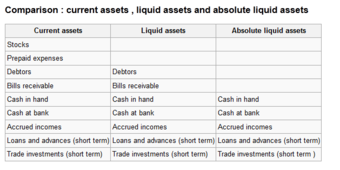
Comparison of Various types of Assets
Current assets vs. liquid assets vs. absolute liquid assets.
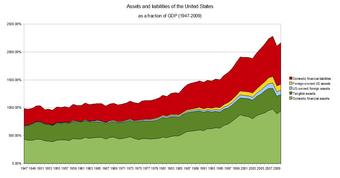
Assets and Liabilities of the US
Assets and liabilities of the US as a fraction of the GDP 1945-2009.
Tangible assets contain various subclasses, including current and fixed assets. Current assets include inventory, while fixed assets include such items as buildings and equipment.
Intangible assets are nonphysical resources and rights that have a value to the firm because they give the firm some kind of advantage in the market place. Examples of intangible assets are goodwill, copyrights, trademarks, patents, computer programs, and financial assets, including such items as accounts receivable, bonds and stocks.
The accounting equation relates assets, liabilities, and owner’s equity:
Assets = Liabilities + Stockholders’ Equity (Owners’ Equity)
That is, the total value of a firm’s assets are always equal to the combined value of its “equity” and “liabilities. ” In other words, the accounting equation is the mathematical structure of the balance sheet.
Probably the most accepted accounting definition of asset is the one used by the International Accounting Standards Board. The following is a quotation from the IFRS Framework:
“An asset is a resource controlled by the enterprise as a result of past events and from which future economic benefits are expected to flow to the enterprise. “
18.4.3: Liabilities
A “liability” is an obligation of an entity, the settlement of which may result in the yielding of economic benefits in future.
Learning Objective
Define liabilities in financial accounting
Key Points
- Liabilities in financial accounting need not be legally enforceable, but can be based on equitable obligations or constructive obligations.
- Liabilities on the balance sheet are split into two categories: current liabilities, and long-term liabilities.
- Current liabilities are those expected to be liquidated within a year.
- Long-term liabilities are those which will not be liquidated in the coming year.
Key Terms
- current liabilities
-
In accounting, current liabilities are often understood as all liabilities of the business that are to be settled in cash within the fiscal year, or the operating cycle of a given firm, whichever period is longer.
- liabilities
-
An amount of money in a company that is owed to someone and has to be paid in the future, such as tax, debt, interest, and mortgage payments.
Examples
- Examples of long-term liabilities include long-term bonds, leases, pension obligations, and debentures.
- Examples of current liabilities include wages, taxes, accounts payables, and short-term obligations (such as purchase from suppliers).
In financial accounting, a liability is defined as an obligation of an entity arising from past transactions or events, the settlement of which may result in the transfer or use of assets, provision of services or other yielding of economic benefits in the future. A liability is defined by the following characteristics:
- Any type of borrowing from persons or banks for improving a business or personal income that is payable during short or long time
- A duty or responsibility to others that entails settlement by future transfer or use of assets, provision of services, or other transaction yielding an economic benefit, at a specified or determinable date, on occurrence of a specified event, or on demand
- A duty or responsibility that obligates the entity to another, leaving it little or no discretion to avoid settlement
- A transaction or event obligating the entity that has already occurred
Liabilities in financial accounting need not be legally enforceable, but can be based on equitable obligations or constructive obligations. An equitable obligation is a duty based on ethical or moral considerations. A constructive obligation is an obligation that is implied by a set of circumstances in a particular situation, as opposed to a contractually based obligation. Examples of types of liabilities include money owing on a loan, money owing on a mortgage, or an IOU. Liabilities are debts and obligations of the business they represent that creditors claim on business assets. Liabilities are reported on a balance sheet and are usually divided into two categories:
- Current liabilities: these liabilities are reasonably expected to be liquidated within a year. They usually include payables such as wages, accounts, taxes, and accounts payables, unearned revenue when adjusting entries, portions of long-term bonds to be paid this year, short-term obligations (e.g., from purchase of equipment).
- Long-term liabilities: these liabilities are reasonably expected not to be liquidated within a year. They usually include issued long-term bonds, notes payables, long-term leases, pension obligations, and long-term product warranties.
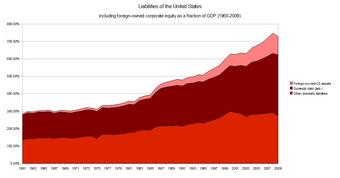
Liabilities of the United States
Liabilities of the United States as a fraction of GDP (1960-2009)
18.4.4: Owners’ Equity
Shareholders’ equity is the difference between total assets and total liabilities.
Learning Objective
Define owners’ equity
Key Points
- Shareholders’ equity tells you the “book value”, i.e., what is left over for shareholders after the company has paid off all its debt.
- Shareholders’ Equity = Total Assets – Total Liabilities.
- If liabilities exceed assets, then negative equity exists.
- Ownership equity may include both tangibles and intangibles, such as intellectual property or goodwill.
Key Terms
- capital surplus
-
A balance sheet item under shareholders’ equity. Increases by the value above an original par value per share that newly-issued shares are sold for.
- shareholders’ equity
-
The remaining interest in assets of a company, spread among individual shareholders of common or preferred stock.
- owners’ equity
-
the remaining interest in all assets after all liabilities are paid
- equity financing
-
funding obtained through the sale of ownership interests in the company
Example
- Ownership equity may include common stock, preferred stock, retained earnings, treasury stock, and reserve.
In accounting and finance, equity is the residual claim or interest of the most junior class of investors in assets, after all liabilities are paid. If liability exceeds assets, negative equity exists.
In an accounting context, shareholders’ equity (or stockholders’ equity, shareholders’ funds, shareholders’ capital or similar terms) represents the remaining interest in assets of a company, spread among individual shareholders of common or preferred stock.
At the start of a business, owners put some funding into the business to finance operations. This creates a liability on the business in the shape of capital as the business is a separate entity from its owners. Businesses can be considered, for accounting purposes, sums of liabilities and assets. After liabilities have been accounted for, the positive remainder is deemed the owners’ interest in the business.
This definition is helpful in understanding the liquidation process in case of bankruptcy. At first, all the secured creditors are paid against proceeds from assets. Afterward, a series of creditors, ranked in priority sequence, have the next claim/right on the residual proceeds. Ownership equity is the last or residual claim against assets, settled only after all other creditors are paid. In such cases where even creditors could not get enough money to pay their bills, nothing is left over to reimburse owners’ equity; which is thus reduced to zero. Ownership equity is also known as risk capital or liable capital.
In financial accounting, equity capital is the owners’ interest on the assets of the enterprise after deducting all its liabilities. It appears on the balance sheet/statement of financial position, one of the four primary financial statements. Ownership equity includes both tangible and intangible items (such as brand names and reputation/goodwill). Accounts listed under ownership equity include (for example):
- Share capital (common stock)
- Preferred stock
- Capital surplus
- Retained earnings
- Treasury stock
- Stock options
- Reserve
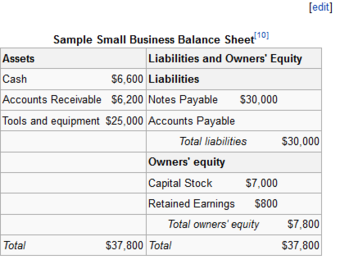
Sample Balance Sheet
Sample of a small business’s balance sheet, showing owners’ equity.
18.5: The Income Statement
18.5.1: Defining the Income Statement
The income statements reports the revenues, expenses, and overall net profit or loss over a given reporting period.
Learning Objective
Define the income statement in the broader context of financial accounting
Key Points
- The income statement ultimately provides insights on profitability through tracking revenues and the expenses incurred to gain those revenues.
- The income statement starts with revenues, which represent the overall incoming proceeds from sales of products and/or services.
- The cost of the goods sold, alongside the selling and general administrative costs, depreciation, and R&D are subtracted from those revenues as expenses.
- Non-operating items such as taxes, cost of financing, and other sources of miscellaneous revenues or expenses are calculated after that.
- This results in the net income or loss over the given reporting period. Dividing the net income by overall sales will provide the organization’s profit margin.
Key Terms
- Profitability
-
The capacity to produce capital, in this context through organizational operations.
- depreciation
-
The decline in value of assets.
What is an Income Statement
The income statement is one of the main financial statements all publicly traded organizations around the world generate on an regular basis as a reporting tool for stakeholders and the general public. The creation and maintenance of these statements is the primary responsibility of financial accountants.
The income statement (also referred to as a profit and loss account, or a profit and loss statement) answers some core questions regarding profitability and the overall utilization of raw materials to generate revenue exceeding the expenses involved. The income statement is therefore a linear assessment, starting with revenue and ending with net gains or losses, of the overall costs of a given production process. As a result, this statement is intrinsically describing a span of operational time, and the transformation of revenues into profits or losses over that given time period.

Wikimedian’s Income Statement
Understanding an income statement is best accomplished by analyzing one. The above income statement is pulled directly from Wikipedia, and is the financial information they are offering to external stakeholders and the general public. The income statement starts with revenues, minuses costs and expenses, and results in a net gain or loss.
Why They Are Useful
The income statement is a critically useful tool, particularly for product managers, strategists, operational specialists, and investors. In short, incomes statements are useful because they demonstrate an organization’s ability to turn revenues into usable cash flows (which will then be inserted into a cash flow statement on an ongoing basis). Profitability of operations is the key concept here, and it is a critical component of organizational success.
How To Create an Income Statement
As a financial accountant, understanding the inputs of an income statement is key to developing accurate and useful reports. Incomes statements can loosely be divided into the following subcategories:
Revenue
At the top, an organization should report overall revenue. The primary input here will be overall proceeds from sales, though the appreciation of assets or the acquisition of accounts receivable owed from a previous reporting period may also add to this number.
Expenses
Expenses are the overall costs of acquiring the above revenues. This can be divided into a few categories:
- Cost of Goods Sold (COGS) – All costs in material, labor, and overhead that are directly required for the production and/or manufacturing of a given good.
- Selling and General Administration (SG&A) – These costs are support costs, such as the salaries of HR staff, management, legal, accounting, marketing, and other broader corporate expenses that benefit the sale of a particular good.
- Depreciation/Amortization – Over time, fixed assets will decrease in value. This depreciation of assets is allocated as an expense over the lifetime of the assets being recorded.
- Research and Development (R&D) – Investment in the research and development of revenue-generating products will also be a business expense for the income statement.
Non-Operating Items
Other gains or losses, such as those from rent, income, patents, foreign exchange, goodwill, etc., should be included as unusual gains or losses. Financial costs from borrowing capital and taxes due will also be included in this section. An additional section of irregular items is added if necessary (though rarely), which could pertain to changing business locations (quite costly), discontinuing operations, or other unique scenarios that need to be reported but don’t fit cleanly in any given line item.
Net Income
After all of the items have been added or subtracted accordingly from the starting revenue, the income statement will display the overall net income or net loss. This is where investors and stakeholders derive profit margin: net income/revenue. This margin of profitability is a useful input for the overall value of an organization’s operational efficiency.
18.5.2: Revenues
Revenue is cash inflows or other enhancements of assets derived by delivering or producing goods.
Learning Objective
Explain how revenue is used to determine the health of a company
Key Points
- Revenue is a calculation or estimation of periodic income based on a particular standard accounting practice or the rules established by a government or government agency.
- In general usage, revenue is income received by an organization in the form of cash or cash equivalents. Sales revenue is income received from selling goods or services over a period of time. Tax revenue is income that a government receives from taxpayers.
- Revenue is a crucial part of financial statement analysis. A company’s performance is measured by the extent to which its asset inflows (revenues) compare with its asset outflows (expenses).
- Revenue is used as an indication of earnings quality. There are several financial ratios attached, the most important being gross margin and profit margin. In addition, companies use revenue to determine bad debt expense using the income statement method.
Key Terms
- cash budget
-
a prediction of future money receipts and expenditures for a particular time period
- Cash inflows
-
Cash inflows are the movement of money into a business, project or financial product.
Examples
- Lending businesses like car rentals and banks receive most of their revenue from fees and interest generated by lending assets to other organizations or individuals.
- For some businesses, such as manufacturing and/or grocery, most revenue is from the sale of goods.
Revenue is cash inflows or other enhancements of assets during a period from delivering or producing goods, rendering services or other activities that constitute an entity’s ongoing major operations. It is usually presented as sales minus sales discounts, returns and allowances.
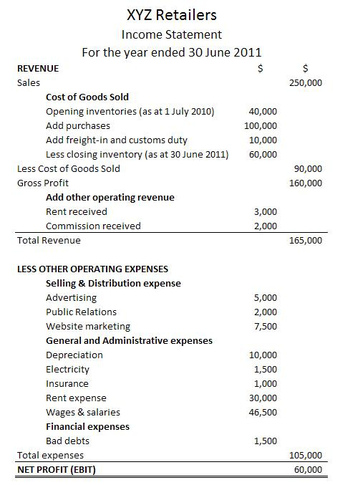
A Sample Income Statement
Expenses are listed on a company’s income statement.
In business, revenue is income that a company receives from its normal business activities, usually from the sale of goods and services to customers. Every time a business sells a product or performs a service, it obtains revenue. This is referred to as gross revenue or sales revenue.
In the United Kingdom and other countries, revenue is referred to as turnover. Some companies receive revenue from interest, dividends or royalties paid to them by other companies. Revenue may refer to business income in general or the amount, in a monetary unit, received during a period of time. For example, “Last year, Company X had revenue of $42 million. “
Revenue is a crucial part of financial statement analysis, and the income statement in particular. A company’s performance is measured to the extent to which its asset inflows (revenues) compare with its asset outflows (expenses). Net Income is the result of this equation. Consistent revenue growth, as well as net income growth, is considered essential for a company’s publicly traded stock to be attractive to investors. Revenue is used as an indication of earnings quality. There are several financial ratios attached to it, the most important being gross margin and profit margin. In addition, companies use revenue to determine bad debt expense using the income statement method.
18.5.3: Cost of Goods Sold
The cost of goods sold, calculated and recorded in the income statement, is a useful indicator of overall production costs and efficiency.
Learning Objective
Understand how to calculate COGS under various recording methods, and recognize the value of this calculation strategically in terms of production efficiency
Key Points
- Calculated and recorded on the income statement, the cost of goods sold (COGS) indicates the overall production efficiency on a unit to unit basis.
- COGS is a relevant indicator of potential profitability when used as a benchmark to the consumer willingness to pay and overall price point of the goods being sold.
- COGS includes the cost of sourcing raw materials, labor directly required for production, overhead applicable to production, warehousing, and shipping.
- Various approaches can be taken from an accounting perspective in order to record and report COGS. This includes LIFO, FIFO, average cost, and specific identification.
Key Terms
- homogeneous
-
Having the same composition throughout.
- overhead
-
The expense of a business not directly assigned to goods or services provided.
The Importance of COGS
The cost of goods sold (COGS) is a highly relevant indicator for the health of business operations, as it is a variable cost directly applied to each item sold on a per unit basis. This calculation allows the business to see just how much it costs to source, product, inventory, manage, and distribute organizational products and services. From a general strategic point of view, the COGS when compared to the consumer willingness to pay is the key indication of whether or not the production of a certain product (at a certain volume) will yield long-term sustainable profits.
How COGS is Derived
When viewing an income statement, it is useful to recall that the flow of information is top-down. At the top of the income statement is overall revenues, which are immediately applied to the cost of goods sold. This initial calculation will take into account the following costs of production:
- Sourcing of raw materials, parts and supplies used
- All labor directly involved in the production, manufacturing, and delivery of the product/service, including the benefits and payroll taxes
- All overhead directly applicable to the production process (i.e. electricity to run machines, rent for the manufacturing facility, rent for the warehouses, salaries of factory management, etc.)
- All storage and warehousing of products/services, alongside the distribution to consumers (i.e. shipping, storing, handling)
In short, COGS refers to the cost of producing the good from start to finish. This does NOT include support activities such as corporate marketing, corporate HR, senior management (unless they are actively on the production floor), IT infrastructure (unless directly integrated with manufacturing) and other sales, general, and administrative costs.

Break-even Point
The cost of goods sold often determines at what level of output (in terms of units) will produce a break-even point at the given price point the item is being sold.
Recording Methodologies
When applying this information to the income statement, different accounting tactics are used depending upon the situation of the organization. A few key record keeping concepts to keep in mind when approaching COGS:
First-In, First-Out (FIFO) – Under this COGS tracking method, the first items to be produced are the ones that are sent off the shelves first. Picture a smartphone manufacturer, where the first 50 cost $200 to produce and the second 50 cost $300 to produce. After selling the first 50 phones, the COGS under FIFO would be $10,000 (50 x $200).
Last-In, First-Out (LIFO) – Under this COGS method, the last items produced are the ones that are sent off the shelves first. So, to use the above example, the sale of the first 50 phones would have a recorded COGS of $15,000 (50 x $300).
Average Cost – Under this COGS method, the overall per unit production cost is averaged across the entire recording period. That is to say that the total COGS per unit will simply be the overall cost of all operations (during reporting period)/production volume (during reporting period). This is particularly helpful for homogeneous goods.
Specific Identification – As an antithesis to average cost calculations, this method tracks each individual item and prices the COGS according to its individual production process. This can be valuable when producing specialized and differentiated goods, which don’t always sell at the same price or compare cleanly to one another.
18.5.4: General and Administrative Expenses (G&A)
General and administrative non-production related costs provide a good indication of overall operational efficiency.
Learning Objective
Understand SG&A expenses and what they indicate about an organization
Key Points
- SG&A expenses are expressed on the income statement under operating expenses and refer to non-production related operating costs.
- SG&A costs are (relatively) fixed, and therefore they are a useful indication of efficiency when viewed as a percentage of overall revenues.
- Key items under SG&A include salary, rent, utilities, software, insurance, and a wide variety of other administrative and overhead-related costs.
- When viewing SG&A in the context of the organization and the competition, creating efficiency in spending relative to scale of production is a primary objective.
Key Term
- expenditures
-
Costs to be paid out. From an accounting perspective, these are credited costs on a given line item.
Why SG&A Costs are Relevant
In reporting expenses on an income statement, there are various expenses incurred that are not directly related to production. The primary reason tracking these expenses separately is so important is because they are independent of variable production volume, and as a result, their overall impact on the organization is largely fixed (as opposed to variable, per unit cost). This has some strategic implications.
How SG&A Costs are Calculated
Most of these expenses tend to revolve around indirect aspects of production. One way to picture this is to consider the supporting infrastructure around the core process: the office space (and the associated utility costs), for example, or the salaries of support staff and management. While the potential list of expenditures for this line item is extensive, the following are some common expenses incurred that would be filed under SG&A:
- Salary/Payroll (i.e. salary not directly related to variable production)
- Overhead
- Administration
- Software
- Rent
- Insurance
- Maintenance
- Commissions
- Utilities
What SG&A Implies
By separating these expenses from the production expenses, it provides investors, management, and other stakeholders with insights surrounding the efficiency of organizational operation. Organizations with an SG&A budget that represents a high percentage of their overall expense would be assumed to be less efficient than a similar organization producing a similar amount of revenue with a lower SG&A.
For example, company A has quite a few highly paid managers and executives on their team. They also use cutting edge software to manage the production process, which has a high annual cost. They produce slightly more revenue than their close competitor, company B (20% more revenue per annum). They create a net income of 2% on an annual basis.
Company B, on the other hand, has few managers and executives and relies on a slightly slower yet much cheaper software solution for managing operational output. As a result, they make 20% less than company A each year, but their expenses are 40% less than company. As a result, the produce a net income at almost 30% of revenue.
Company A is clearly producing more volume and making bigger strategic investments in IT, however company B is leveraging their resources better in terms of profitability by minimizing their SG&A and focusing more exclusive on investing in their production efficiency.
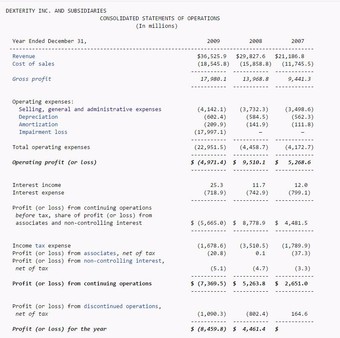
Income Statement
This image shows a basic income statement, including a line item for SG&A. This demonstrates where it is (under operating expenses).
18.5.5: Net Income
Net income in accounting is an entity’s income minus expenses for an accounting period.
Learning Objective
Define Net Income
Key Points
- Net income can be distributed among holders of common stock as a dividend or held by the firm as an addition to retained earnings.
- Net earnings and net profit are commonly found as synonyms for net income. Often, the term “income” is substituted for net income, yet this is not preferred due to the possible ambiguity.
- Net income can be distributed among holders of common stock as a dividend or held by the firm as an addition to retained earnings.
Key Terms
- minority interest
-
In accounting, minority interest (or non-controlling interest) is the portion of a subsidiary corporation’s stock that is not owned by the parent corporation.
- Common stock
-
Shares of an ownership interest in the equity of a corporation or other entity with limited liability entitled to dividends, with financial rights junior to preferred stock and liabilities.
Net income in accounting is an entity’s income minus expenses for an accounting period. It is computed as the residual of all revenues and gains over all expenses and losses for the period and has also been defined as the net increase in stockholder’s equity that results from a company’s operations. Net income is a distinct accounting concept from profit. Profit is a term that means different things to different people, and different line items in a financial statement may carry the term “profit,” such as gross profit and profit before tax. In contrast, net income is a precisely defined term in accounting.
Often, the term income is substituted for net income, yet this is not preferred due to the possible ambiguity. Net income is informally called the “bottom line,” because it is typically found on the last line of a company’s income statement (a related term is “top line,” meaning revenue, which forms the first line of the account statement). The items deducted will typically include tax expense, financing expense (interest expense), and minority interest.Likewise, preferred stock dividends will be subtracted too, though they are not an expense. For a merchandizing company, subtracted costs may be the cost of goods sold, sales discounts, and sales returns and allowances. For a product company advertising, manufacturing, and design and development costs are included.
Net income can be distributed among holders of common stock as a dividend or held by the firm as an addition to retained earnings. As profit and earnings are used synonymously for income (also depending on United Kingdom and U.S. usage), net earnings and net profit are commonly found as synonyms for net income. Often, the term “income” is substituted for net income, yet this is not preferred due to the possible ambiguity.
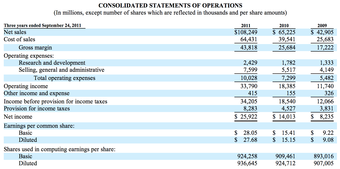
Apple Inc’s Income Statement
Apple’s revenues and net income rose greatly in 2011.
An equation for net income:
Net sales (revenue) – Cost of goods sold = Gross profit – SG&A expenses (combined costs of operating the company) = EBITDA – Depreciation & amortization = EBIT – Interest expense (cost of borrowing money) = EBT – Tax expense = Net income (EAT)
18.5.6: Sample Income Statement
The income statement displays the revenues recognized for a specified period and the costs and expenses charged against these revenues.
Learning Objective
Explain the uses and components of an income statement
Key Points
- The purpose of the income statement is to show managers and investors whether the company made or lost money during the reported period.
- An income statement differs from a balance sheet in that it represents a period of time as opposed to a single moment.
- Income statements should help investors and creditors determine the past financial performance of the enterprise, predict future performance, and assess the capability of generating future cash flows through reporting the income and expenses.
Key Terms
- depreciation
-
The measurement of the decline in value of assets. Not to be confused with impairment, which is the measurement of the unplanned, extraordinary decline in value of assets.
- goodwill
-
The value of a business entity not directly attributable to its tangible assets and liabilities. This value derives from factors such as consumer loyalty to the brand.
- income statement
-
a calculation which shows the profit or loss of an accounting unit during a specific period of time, providing a summary of how the profit or loss is calculated from gross revenue and expenses
Income Statements
The income statement (profit and loss statement), is a company’s financial statement indicating how revenue becomes net income. ‘Revenue’ is money received from the sales of products and services before expenses are deducted, also called the ‘top line. ‘ The net income is the result after all revenues and expenses have been accounted for, also known as the ‘net profit’ or the ‘bottom line. ‘ The income statement displays the revenues recognized for a specified period and the expenses charged against these revenues, including write-offs (depreciation and amortization of assets) and taxes. The purpose of income statements is showing managers and investors whether companies made profits or losses during those periods. An income statement differs from a balance sheet because it represents a period of time, not a single moment.
Preparing the income statement involves two possible methods. The Single Step income statement takes a simpler approach, adding revenues and subtracting expenses to find the bottom line. The more complex Multi-Step income statement takes several steps to find the bottom line, starting with the gross profit. It then calculates operating expenses which, when deducted from the gross profit, yield ‘income from operations. ‘ The difference of other revenues and expenses is then applied to the income from operations. When combined with ‘income from operations,’ this yields ‘income before taxes. ‘ The final step is to deduct taxes, which finally produces the net income for the period measured.
Usefulness and Limitations
Income statements should help investors and creditors determine the past financial performance of the enterprise, predict future performance, and assess the capability of generating future cash flows through income and expense reports. However, income statements have several limitations:
- Items that might be relevant but cannot be reliably measured are not reported (brand recognition and loyalty).
- Some numbers depend on the accounting methods used (using FIFO or LIFO accounting to measure inventory level).
- Some numbers depend on judgments and estimates (depreciation expense depends on estimated useful life and salvage value).
Components
Operating Section
Revenue: Cash inflows or other enhancements of an entity’s assets during periods of delivering or producing goods, rendering services, or other activities constituting the ongoing major operations. It is usually presented as sales minus discounts, returns, and allowances. Every time a business sells a product or performs a service, it obtains revenue, which is often referred to as ‘gross’ or ‘sales revenue. ‘
Expenses: Cash outflows, consumption of assets, or incurrence of liabilities during a period from delivering or producing goods, rendering services, or carrying out other activities constituting the entity’s ongoing major operations.
Cost of Goods Sold (COGS) / Cost of Sales: Represents the direct costs attributable to goods produced and sold by a business (manufacturing or merchandizing), including material costs, direct labour, and overhead costs. It excludes operating costs such as selling, administration, advertising, or R&D.
Selling, General and Administrative expenses (SG&A or SGA): Consists of the combined payroll costs. SGA is usually understood as a major portion of non-production costs, in contrast to production costs like direct labor.
Selling Expenses: Represents expenses needed to sell products (salaries of salespeople, commissions and travel expenses, advertising, freight, shipping, depreciation of sales, store buildings and equipment, et cetera).
General and Administrative (G&A) Expenses: Represents expenses necessary to manage the business (salaries of officers or executives, legal and professional fees, utilities, insurance, depreciation of office buildings and equipment, office rents, office supplies, et cetera).
Depreciation / Amortization: The charge with respect to fixed or intangible assets that have been capitalized on the balance sheet for a specific accounting period. It is a systematic and rational allocation of cost, not the recognition of market value decrement.
Expenses recognised in the income statement should be analysed either by nature (raw materials, transport costs, staffing costs, depreciation, employee benefit) or by function (cost of sales, selling, administrative).
Non-Operating Section
Other revenues or gains: Revenues and gains from non-primary business activities (rent, patent income, goodwill). It also includes gains that are either unusual or infrequent, but not both (gain from sale of securities or gain from fixed asset disposal).
Other expenses or losses: Expenses or losses not related to primary business operations (foreign exchange loss).
Finance costs: Costs of borrowing from various creditors (interest expenses, bank charges).
Income tax expense: Sum of the amount of tax payable to tax authorities in the current reporting period (current tax liabilities/tax payable) and the amount of deferred tax liabilities or assets.
Irregular Items
These are reported separately so that stakeholders can better predict future cash flows: irregular items probably won’t recur. They are reported net of taxes. Discontinued operation is the most common type of irregular item. Shifting business locations, stopping production temporarily, or changes due to technological improvement do not qualify as discontinued operations, which must be shown separately.
18.6: The Statement of Cash Flows
18.6.1: The Imperative of Liquidity
Organizations must carefully manage their cash flow statements to ensure appropriate liquidity to avoid missing investment opportunities.
Learning Objective
Consider the concept of liquidity as it pertains to an organization’s available cash flow and overall ability to capture opportunities in the market
Key Points
- Understanding a cash flow statement requires an understanding of the time value of money, the risk and return of certain investments, and the liquidity of existing capital.
- Differentiating between different investment opportunities based on liquidity can help ensure that cash flow will be available exactly when it is needed.
- When looking at overall cash flow, liquidity risk should be avoided through diversification.
Key Terms
- liquidity risk
-
The risk that an asset, security, or commodity is not easily converted in cash without impacting the price of sale.
- liquidity
-
The degree to which something is in demand and easily recovered, making it easily convertible to cash.
Why Liquidity Matters
To accurately frame the discussion of cash flows, an understanding of liquidity is integral. Having cash on hand is a seemingly simple concept. If I have capital, I can spend it. For businesses, however, it is quite a bit more complex. Cash flows must take into account not only amounts of capital, but the time value and availability of said capital.
When an organization has an opportunity to fund, or a debt to pay, they need capital on hand (i.e. capital available now) to provide funding. While an organization may have a great deal of value, this does not mean that said value equates to usable capital.
Let’s take an example. Company A and Company C want to purchase a new manufacturing machine from Company B. However, Company B will sell at their determined price to the first company with the capital to pay. Capital A has the majority of their money wrapped up in inventory (i.e. holding products for sale) which they expect to sell within 4 weeks, while Company C has their capital in a savings account. Company C will capture the opportunity, as the capital they are using is more liquid.
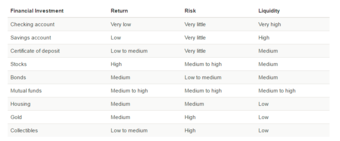
Liquidity
This chart shows some estimations of various types of capital investments, alongside their respective risk, return, and liquidity.
Liquidity Risk
When considering cash flow, it is important to understand liquidity risk. The difficulty in taking a certain asset to market, and recovering capital without incurring a loss of value, is called liquidity risk. When looking at overall cash flow, it’s important to consider how easily the available assets and investments are converted into capital to capture external opportunities.
All investments of capital can be framed with three key attributes: average expected return, degree of risk, and overall liquidity. Business managers and accountants, when considering their investment options, should keep liquidity in mind at all times. Conversely, having cash sitting without investment also incurs an opportunity cost. Inflation generally devalues any cash asset, and investing capital into money markets can generate interest. The decision of how much cash to invest, and where to invest it, is therefore a key consideration when balancing accounts for an organization.
18.6.2: Direct and Indirect Measurement
Cash flow statements can be measured via the direct method and the indirect method to determine overall liquidity.
Learning Objective
Differentiate between the direct and indirect methods of cash flow accounting, with a particular focus on the more popular indirect method
Key Points
- Statements of cash flow allow internal and external stakeholders to understand an organization’s overall liquidity, and what is presently available for utilization.
- Understanding cash flows is critical to capturing short-term opportunities and investments, while also acting as a health check for overall operational output over a given period.
- Using the direct method is simpler but less common, as the direct method does not include the valuation of non-cash items. However, most organizations using the direct method will be required to value these non-cash items in another way.
- Using the indirect method is more complex, but also more useful in truly understanding overall valuation. It is differentiated by taking into account non-cash changes in valuation. A good example is depreciation.
Key Terms
- indirect method
-
A method of cash flow accounting that takes into account everything the direct method measures, with the addition of non-cash item valuation.
- liquidity
-
The availability of cash in the short-term.
- direct method
-
A method of cash flow accounting that records all cash inflows and outflows. It does not take non-cash item valuations into account.
Why Measure Cash Flows?
When it comes to financial reporting activities, the statement of cash flows is a useful tool when it comes to understanding a business’s liquidity and available short-term cash and cash equivalent assets. In layman’s terms, the statement of cash flows identifies what resources a business can use relatively quickly. Understanding cash flows is useful because it
- provides accurate information regarding an organization’s liquidity,
- projects future cash flow expectations in terms of quantity and timing,
- acts as a point of operating performance comparison between organizations,
- and highlights key changes in asset and operational valuations.
How to Determine Cash Flows
When understanding how an organization creates a statement of cash flows, it’s important to know there are two established methods: the direct method and the indirect method.
The Direct Method
As the name implies, the direct method of reporting cash flows identifies clear circumstances of cash inflow or outflow. It is a simpler, more straight forward approach to cash flows, where each line item is a tangible form of cash credit or debit. Some common items on a direct cash flow report include:
- Cash flows from operating activities, such as payments received from customers, payments paid to suppliers and taxes.
- Cash flows from financing activities, such as dividends paid.
- Cash flows from investing activities, such as the purchase of new equipment and the sale of assets.
It’s important to note that the direct method requires additional documents to take into account indirect cash flow implications for an organization. As a result, the direct method is less often used simply because the additional requirements limit the advantage of simplicity when filing using this format.
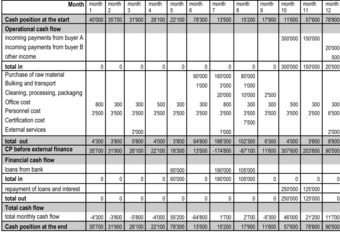
Simple Direct Cash Flow Statement
This is a simple direct monthly cash flow statement from a small business. It’s worth noting that there are no investing activities in this example.
The Indirect Method
The indirect method is quite a bit more involved than the direct method, as it incorporates valuation changes in non-cash assets as well. The structure of the indirect method is also somewhat different, as it starts with the overall net income amount for the reporting period, where operational, investing, and financial changes in valuations are then applied to this amount. The resulting balance is considered the net increase or decrease in overall cash and cash equivalents.
Let’s take a look at some examples of indirect cash flow line items for context:
- Operating items in the indirect method include depreciation and amortization, accounts receivable, inventory, and operating gains and losses.
- Investment items in the indirect method include capital expenditures and investments (i.e. in securities, other businesses, tangible and intangible assets).
- Financial items in the indirect method include dividends, stock repurchases, and changes in overall debt.
When you apply each of these items to the net income of a given period, you will derive a net increase or decrease in overall cash flow as a result of investments, financing, and operations for an organization.
Chapter 17: Marketing Communications
17.1: Promotion
17.1.1: Word of Mouth
To promote and manage word-of-mouth communications, marketers use publicity techniques to achieve desired behavioral response.
Learning Objective
Explain how marketers effectively use word-of-mouth
Key Points
- Word of mouth, or viva voce, is the passing of information from person to person by oral communication.
- Word-of-mouth marketing including buzz, blog, viral, grassroots, brand advocates, cause influencers, and social media marketing, as well as ambassador programs, work with consumer-generated media and more, can be highly valued by product, social media and performance marketers.
- To promote and manage word-of-mouth communications, marketers use publicity techniques as well as viral marketing methods to achieve desired behavioral response.
Key Terms
- viral marketing
-
the use pre-existing social networks and other technologies to produce increases in brand awareness or to achieve other objectives (such as product sales) through self-replicating processes
- marketing
-
The promotion, distribution and selling of a product or service; includes market research and advertising.
Word of mouth, or viva voce, is the passing of information from person to person by oral communication. Storytelling is the oldest form of word-of-mouth communication where one person tells others of something, whether a real event or something made up. Another important form of word of mouth is oral history—the recording, preservation, and interpretation of historical information, based on the personal experiences and opinions of the speaker. Oral history preservation is the field that deals with the care and upkeep of oral history materials collected by word of mouth, whatever format they may be in. An important area of marketing is called word-of-mouth marketing, which relies on the added credibility of person-to-person communication.
Word-of-mouth marketing, which encompasses a variety of subcategories, including buzz, blog, viral, grassroots, brand advocates, cause influencers, and social media marketing, as well as ambassador programs, work with consumer-generated media. Because of the personal nature of the communications between individuals, it is believed that product information communicated in this way has an added layer of credibility. Research points to individuals being more inclined to believe word-of-mouth marketing more than formal forms of promotion methods; the receiver of word-of-mouth referrals tends to believe that the communicator is speaking honestly and is unlikely to have an ulterior motive (i.e. they are not receiving an incentive for their referrals). Word-of-mouth depends on the extent of customer satisfaction with the product or service and on the degree of its perceived value.
To promote and manage word-of-mouth communications, marketers use publicity techniques as well as viral marketing methods to achieve desired behavioral response. Companies can focus on brand advocates, the people who proactively recommend their favorite brands and products online and offline without being paid to do so. Influencer marketing is also increasingly used to seed WOMM by targeting key individuals that have authority and a high number of personal connections.
Marketers place significant value on positive word-of-mouth, which is traditionally achieved by creating products, services, and customer experiences that generate conversation-worthy “buzz” naturally. The relatively new practice of word-of-mouth marketing attempts to inject positive “buzz” into conversations directly. While marketers have always hoped to achieve positive word-of-mouth, intentional marketing relying on such techniques is legislated in some jurisdictions. For example, in the United States, deliberate efforts to generate beneficial consumer conversations must be transparent and honestly conducted in order to meet the requirements of Section 5 of the Federal Trade Commission Act that prohibits “unfair or deceptive acts or practices. ” To help marketers understand the difference between legitimate and unfair practices, a number of professional organizations have put forward recommendations for ethical conduct.
17.1.2: Digital Marketing
Digital marketing is the use of internet connected devices to engage a customer with online advertising to promote products and services.
Learning Objective
Break down digital marketing into push and pull strategies
Key Points
- Internet marketing, also known as web marketing, online marketing, webvertising, or e-marketing, is referred to as the marketing (generally promotion) of products or services over the Internet.
- Internet marketing ties together the creative and technical aspects of the Internet, including design, development, advertising and sales.
- Websites, blogs and streaming media (audio and video) are also examples of pull digital marketing. Articles with specific target / topic are a great source to pull interested viewers.
Key Term
- customer relationship management
-
Customer relationship management (CRM) is a widely implemented model for managing a company’s interactions with customers, clients and sales prospects.
Internet marketing, also known as web marketing, online marketing, webvertising, or e-marketing, is referred to as the marketing (generally promotion) of products or services over the Internet. Internet marketing is considered to be broad in scope because it not only refers to marketing on the Internet but also includes marketing done via e-mail and wireless media. Digital customer data and electronic customer relationship management (ECRM) systems are also often grouped together under internet marketing.
Internet marketing ties together the creative and technical aspects of the Internet, including design, development, advertising, and sales. Internet marketing also refers to the placement of media along many different stages of the customer engagement cycle through search engine marketing (SEM), search engine optimization (SEO), banner ads on specific websites, email marketing, mobile advertising, and Web 2.0 strategies.
In 2008, The New York Times, working with comScore, published an initial estimate to quantify the user data collected by large Internet-based companies. Counting four types of interactions with company websites in addition to the hits from advertisements served from advertising networks, the authors found that the potential for collecting data was up to 2,500 times per user per month.
Digital marketing is the use of internet-connected devices to engage a customer with online advertising in order to promote products and services. Internet-connected devices are those such as web browsers, smart phones, and game consoles. As technology develops, more devices become capable of internet browsing and the digital marketing potential that comes with it.
Pull digital marketing is marketing in which the consumer must actively seek content—often via web searches or arrangements in which the recipient has been given permission to receive content that is sent to the consumer by email, text message, or web feed. Websites, blogs, and streaming media (audio and video) are also examples of pull digital marketing. Articles with specific target / topic are a great source to pull interested viewers. In each of these, users have to link to the website to view the content. Only current web browser technology is required to maintain static content. However, additional internet marketing technologies (search engine optimization) may be required to attract the desired consumer demographic. Research by Martin et al. (2003) found what permission email marketing content consumers find useful, such as special sales and new product information, whereas suggesting interesting hyperlinks was not seen as useful.
Push digital marketing involves a marketer sending a message without the consent of the recipients, such as display advertising on websites and news blogs. Email, text messaging, and web feeds can also be classed as push digital marketing when the recipient has not given permission for the marketer to send the marketing message. (This is also known as spam. ) Push technologies can deliver content as soon as it becomes available and are better targeted to their consumer demographics, although audiences are often smaller, and the costs of creation and distribution are higher. Push digital marketing technologies are more proper when done with prior permission—a concept called permission marketing. This is also more ethical. Permission can be obtained through subscriptions, consent to send email, etc.
Push and pull message technologies can be used in conjunction with each other. For example, an email campaign can include a banner ad or link to a content download. This enables a marketer to benefit from both types of digital marketing .

Automated online assistant
An example of E-leadership
17.1.3: Sampling
Sampling involves providing a sample of a consumer product to consumers so that they may try said product before committing to a purchase.
Learning Objective
Explain how sampling turns individuals into customers
Key Points
- The purpose of a free sample is to acquaint the consumer with a new product, and is similar to the concept of a test drive, in that a customer is able to try out a product before purchasing it.
- While placement and word of mouth impact future purchases, sampling can create an almost immediate impulse purchase.
- The success of a sampling program for a new product introduction is dependent on sound planning of overall project objectives and selection of the best distribution technique, sample design, and packager.
Key Terms
- sample
-
A part of anything taken or presented for inspection, or shown as evidence of the quality of the whole; a specimen.
- freebie
-
Something which is free; a giveaway or handout.
Sampling Defined
During the product promotion process, sampling involves providing a sample of a consumer product to consumers so that they may try said product before committing to a purchase. A free sample, or freebie, is a portion of a product (i.e., food or makeup) given to consumers in retail stores or other outlets. Sometimes samples of non-perishable items are included in direct marketing mailings . The purpose of a free sample is to acquaint the consumer with a new product, and is similar to the concept of a test drive, in that a customer is able to try out a product before purchasing it.

Product Samples
Samples are either free handouts, trial sizes, or coupons for consumer products provided to consumers in the hope that they will eventually purchase the product.
Many consumer product companies now offer free samples through their websites, to encourage consumers to regularly use the products and to gather data for mailing lists of potentially interested customers. The expansion of online marketing with regards to promotional giveaways has facilitated the rise of “freebie websites” that seek to aggregate all promotional free sample offers in one place. These sites will often compile free product samples from all over the web and categorize them by type. Some product sample offers may require consumers to complete a survey or refer a friend in order to qualify for the freebies. Additionally, the advent of the “social graph” and the realization that consumers more and more take cues from each other’s reviews, has opened up a new branch of sampling called Social Sampling.
It is also possible to purchase products in small “trial size” containers. This is common with toiletries such as shampoo. Samples may also be loaned to the customer if they are too valuable to be given for free, such as samples of a countertop or of carpet to be used for remodeling.
Effectiveness of Sampling
While placement and word of mouth impact future purchases, sampling can create an almost immediate impulse purchase. According to the Product Sampling Study by Arbitron, sampling successfully reaches 70 million consumers every quarter, and one-third of customers who try a sample will buy the sampled product in the same shopping trip, and 58 percent of those surveyed reported that they would buy the product again.
Improved Product Sampling
The success of a sampling program for a new product introduction is dependent on sound planning of overall project objectives and selection of the best distribution technique, sample design, and packager. Marketers who are considering sampling their next product introduction should define the objectives of the sampling program. Procedures and timetables should be established to correspond with the sampling program, with the overall promotion of the product in mind. There are a number of popular sampling techniques:
- Coupons in pages of newspapers or magazines
- Supermarket or department store distribution
- Direct mail
- Door-to-door
- Distributing samples in public places
- Co-op gift pack programs
- and attaching samples to retail packages
The distribution technique will not be totally effective unless it is accompanied by a proper sample design, which should have maximum visual impact and identification with the full-size package.
17.1.4: Promotion Strategies
Promotion strategies differ depending on the individual business or product, but all strive to increase product demand and awareness.
Learning Objective
Identify key promotional strategies used
Key Points
- Many times with the purchase of a product there is are incentives like discounts, free items, or contests. These methods are used to increase the sales of a given product.
- Marketing strategy is a process that can allow an organization to concentrate its limited resources on the greatest opportunities to increase sales and achieve a sustainable, competitive advantage.
- Marketing strategies may differ depending on the unique situation of the individual business or product.
Key Terms
- brand
-
A name, symbol, logo, or other item used to distinguish a product, service, or its provider.
- corporate image
-
A corporate image refers to how a business is perceived. It is a generally accepted notion or image of what a company stands for.
Promotion is one of the marketing mix elements among a system of five in a promotional plan (often known as the five Ps). These elements are personal selling, advertising, sales promotion, direct marketing, and publicity. A promotional mix specifies how much attention to pay to each of the five subcategories, and how much money to budget for each. A promotional plan can have a wide range of objectives, including: sales increases, new product acceptance, creation of brand equity, positioning, competitive retaliations, or creating a corporate image. Fundamentally, however, there are three basic objectives of promotion:
- To present information to consumers as well as others
- To increase demand
- To differentiate a product from others in the marketplace
There are different ways to promote a product in different areas of media. Promoters use Internet advertisement, special events, endorsements, and newspapers or magazines to advertise their product. Many times with the purchase of a product there are incentives like discounts, free items, or contests. These methods are used to increase the sales of a given product.
Marketing strategy is a process that can allow an organization to concentrate its limited resources on the greatest opportunities to increase sales and achieve a sustainable, competitive advantage. Marketing strategy includes all basic and long-term activities in the field of marketing that deal with the analysis of the strategic situation of a company and the formulation, evaluation and selection of market-oriented strategies and therefore contribute to the goals of the company and its marketing objectives.
Marketing strategies may differ depending on the unique situation of the individual business or product. However, there are a number of ways to categorize some generic strategies.
Strategies Based on Market Dominance
In this scheme, firms are classified based on their market share or dominance of an industry. Typically there are four types of market dominance strategies:
- Leader
- Challenger
- Follower
- Nicher
Porter Generic Strategies
These strategies concentrate on the dimensions of strategic scope and strategic strength. Strategic scope refers to the market penetration while strategic strength refers to the firm’s sustainable, competitive advantage. The generic strategy framework (porter 1984) comprises two alternatives, each with two alternative scopes: Differentiation and Low-Cost Leadership, each with a dimension of focus—which can be broad or narrow. Some of these are:
- Product differentiation
- Cost leadership
- Market segmentation
- Innovation strategies
A company or product can fall into one of three categories:
- Pioneers
- Close followers
- Late followers
If the company is not a pioneer, then it must consider growth strategies. In this scheme we ask the question, “How should the firm grow? ” There are a number of different ways to answer that question, but the most common answers are:
- Horizontal integration
- Vertical integration
- Diversification
- Intensification

Marketing Metrics Continuum
The Marketing Metrics Continuum provides a framework for how to categorize metrics from the tactical to strategic. By navigating this metrics continuum, from Activity-Based to Predictive, marketers can move towards more effective marketing measurement and align measurement and metrics with business outcomes.
17.1.5: The Promotion Mix
There are five (sometimes six) main aspects of a promotional mix: Advertising, Personal selling, Sales promotion, Public relations, and Direct marketing.
Learning Objective
List the seven main aspects of the promotion mix
Key Points
- Advertising – Presentation and promotion of ideas, goods, or services by an identified sponsor.
- Personal selling – A process of helping and persuading one or more prospects to purchase a good or service or to act on any idea through the use of an oral presentation.
- Sales promotion – Media and non-media marketing communication are employed for a pre-determined, limited time to increase consumer demand, stimulate market demand or improve product availability.
- Public relations – Paid intimate stimulation of supply for a product, service, or business unit by planting significant news about it or a favorable presentation of it in the media.
- Direct Marketing is a channel-agnostic form of advertising that allows businesses and nonprofits to communicate straight to the customer.
Key Term
- Public relations
-
Public relations (PR) is the practice of managing the flow of information between an individual or an organization and the public.
There are five (sometimes six) main aspects of a promotional mix . These are:
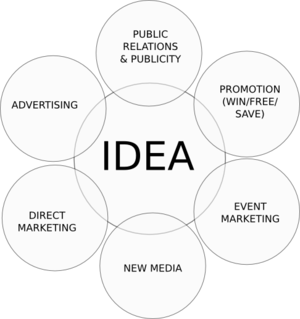
The Promotion Mix
Overview of the elements of the promotion mix.
- Advertising: Presentation and promotion of ideas, goods, or services by an identified sponsor. Examples: Print ads, radio, television, billboard, direct mail, brochures and catalogs, signs, in-store displays, posters, motion pictures, Web pages, banner ads, and emails. (Always in Paid Form non personal)
- Personal selling: A process of helping and persuading one or more prospects to purchase a good or service or to act on any idea through the use of an oral presentation. Examples: Sales presentations, sales meetings, sales training and incentive programs for intermediary salespeople, samples, and telemarketing. Can be face-to-face or via telephone.
- Sales promotion: Media and non-media marketing communication are employed for a pre-determined, limited time to increase consumer demand, stimulate market demand or improve product availability. Examples: Coupons, sweepstakes, contests, product samples, rebates, tie-ins, self-liquidating premiums, trade shows, trade-ins, and exhibitions.
- Public relations: Paid intimate stimulation of supply for a product, service, or business unit by planting significant news about it or a favorable presentation of it in the media. Examples: Newspaper and magazine articles/reports, TVs and radio presentations, charitable contributions, speeches, issue advertising, and seminars.
- Direct Marketing is a channel-agnostic form of advertising that allows businesses and nonprofits to communicate straight to the customer, with advertising techniques such as mobile messaging, email, interactive consumer websites, online display ads, fliers, catalog distribution, promotional letters, and outdoor advertising.
Corporate image may be considered as a sixth aspect of promotion mix. The Image of an organization is a crucial point in marketing. If the reputation of a company is bad, consumers are less willing to buy a product from this company as they would have been, if the company had a good image. Sponsorship is sometimes added as an seventh aspect.
New Media is also sometimes considered an element of the promotion mix.
17.1.6: A Brief Description
Promotion is one of the marketing mix elements, including personal selling, advertising, sales promotion, direct marketing, and publicity.
Learning Objective
Discuss how promotion is achieved in the 21st century
Key Points
- There are three basic objectives of promotion: To present information to consumers as well as others; to increase demand; and to differentiate a product.
- There are different ways to promote a product in different areas of media. Promoters use Internet advertising, special events, endorsements, and newspapers to advertise their products.
- Product promotion is the act of advertising goods or services with the short or long-term goal of increasing sales.
Key Term
- demand
-
The desire to purchase goods or services, coupled with the power to do so, at a particular price.
There are five components to a promotional or marketing mix (sometimes known as the Five P’s). These elements are personal selling, advertising, sales promotion, direct marketing, and publicity. A promotional mix specifies how much attention to pay to each of the five subcategories, and how much money to budget for each. A promotional plan can have a wide range of objectives, including: sales increases, new product acceptance, creation of brand equity, positioning, competitive retaliations, or creation of a corporate image. Let’s focus specifically on the promotion element of the marketing mix. There are three basic objectives of promotion and these are:
- To present information to consumers as well as others;
- To increase demand;
- To differentiate a product from other similar or competing products;
There are different ways to promote a product in different areas of media. Promoters use Internet advertisement, special events, endorsements, and newspapers or magazines to advertise their product. Many times with the purchase of a product there is an incentive like discounts, free items, or a contest. These methods are used to increase the sales of a given product.
Product promotion is the act of advertising a good or service with the short or long-term goal of increasing sales. Many companies use different techniques to promote their products through a vast array of communication mediums. In this day and age, there is not necessarily one communication medium that is better than another simply because the most effective medium depends upon on what type of product you are promoting. There is the physical form (magazines and newspapers) of product promotion and the digital form (websites and e-books), both of which require clear and concise textual information about the product being advertised.
Since the turn of the twenty-first century, many companies have been trying to utilize online social media for product promotion. Some of the most popular forms of online social media are Facebook, Twitter, and Pinterest. Within an online social media network, companies have the ability to advertise and promote their products to anyone, at any time, anywhere in the world. Because of the vast popularity and expansion of social media, companies have had great success in marketing products to the younger generation who otherwise might not see an ad in a newspaper or on TV .
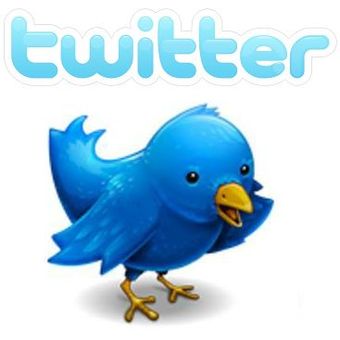
Some of the most popular forms of online social media are Facebook, Twitter, and Pinterest.
17.1.7: Promotion Objectives
Promotion is to present information to consumers to increase demand and to differentiate a product.
Learning Objective
Outline the three main objectives of promotion
Key Points
- Product promotion is the act of advertising a good or service with the short/long term goal of increasing sales.
- Since the turn of the 21st century, many companies have been trying to utilize online social media for product promotion.
- There are five market mix elements: personal selling, advertising, sales promotion, direct marketing, and publicity. A promotional plan is a marketer’s specific mix of these elements.
Key Term
- endorsements
-
In promotion and of advertising, a testimonial or show consists of a person’s written or spoken statement extolling the virtue of some product. The term “testimonial” most commonly applies to the sales-pitches attributed to ordinary citizens, whereas the word “endorsement” usually applies to pitches by celebrities. Testimonials can be part of communal marketing.
Product promotion is the act of advertising a good or service with the goal of increasing sales. Many companies use different techniques to promote their products through a vast array of communication media. In this day and age, there is not necessarily one communication medium that is better than another simply because the most effective medium is based on what type of product you are promoting. There is the physical form of product promotion and the digital form, both of which require clear and concise textual information about the product being advertised.
Since the turn of the 21st century, many companies have been trying to utilize online social media for product promotion. Some of the most popular forms of online social media are Facebook, Twitter, and MySpace. Within an online social media network, companies have the ability to advertise and promote their products to anyone, at any time, anywhere in the world. Because of the vast popularity of social media, companies have had great success on marketing products to the younger generation who otherwise might not have seen an ad in a newspaper or on TV.
Promotion is one of the five market mix elements: personal selling, advertising, sales promotion , direct marketing, and publicity. A promotional plan specifies how much attention to pay to each of the five subcategories and how much money to budget for each. A promotional plan can have a wide range of objectives, including sales increases, new product acceptance, creation of brand equity, positioning, competitive retaliations, or the creation of a corporate image. Fundamentally, however there are three basic objectives of promotion. These are to present information to consumers as well as others, to increase demand, and to differentiate a product.

Promotion
Promotion is one of the market mix elements.
There are different ways to promote a product in different media. Promoters use internet advertisement, special events, endorsements, and newspapers to advertise their product. Many times with the purchase of a product there is an incentive like discounts, free items, or a contest. This is to increase the sales of a given product.
17.2: Public Relations
17.2.1: The Purpose of Public Relations
Public relations (PR) is the practice of managing the flow of information between an individual or an organization and the public.
Learning Objective
Explain the various uses for public relations (PR)
Key Points
- A fundamental technique used in public relations is to identify the target audience, and to tailor every message to appeal to that audience.
- Lobby groups are established to influence government policy, corporate policy, or public opinion.
- Negative public relations, also called dark public relations, is a process of destroying a target’s reputation and/or corporate identity.
Key Terms
- Public relations
-
Public relations (PR) is the practice of managing the flow of information between an individual or an organization and the public.
- cognitive dissonance
-
a conflict or anxiety resulting from inconsistencies between one’s beliefs and one’s actions or other beliefs
Public Relations
Public relations, or PR, is the practice of managing the flow of information between an individual or organization and the public. Public relations provides an organization or individual exposure to their audiences using topics of public interest and news items that do not require direct payment. The aim of public relations by a company often is to persuade the public, investors, partners, employees, and other stakeholders to maintain a certain point of view about it, its leadership, products, or of political decisions. Common activities include speaking at conferences, winning industry awards, working with the press, and employee communication.
A fundamental technique used in public relations is to identify the target audience, and to tailor every message to appeal to that audience. It can be a general, nationwide, or worldwide audience, but it is more often a segment of a population. A good elevator pitch can help tailor messaging to each target audience. Marketers often refer to socio-economically driven demographics, such as “black males ages 18-49”.

Publicity
Paparazzi at work.
Stakeholder theory identifies people who have a stake in a given institution or issue. All audiences are stakeholders (or presumptive stakeholders), but not all stakeholders are audiences. For example, if a charity commissions a public relations agency to create an advertising campaign to raise money to find a cure for a disease, the charity and the people with the disease are stakeholders, but the audience is anyone who is likely to donate money.
Sometimes the interests of differing audiences and stakeholders common to a public relations effort necessitates the creation of several distinct but complementary messages. This is not always easy to do, and sometimes, especially in politics, a spokesperson or client says something to one audience that creates dissonance with another audience or group of stakeholders.
Lobby groups are established to influence government policy, corporate policy, or public opinion. Such groups claim to represent a particular interest and in fact are dedicated to doing so. When a lobby group hides its true purpose and support base, it is known as a front group. Moreover, governments may also lobby public relations firms in order to sway public opinion. A well illustrated example of this is the way civil war in Yugoslavia was portrayed. Governments of the newly seceded republics of Croatia, Bosnia, and Serbia invested heavily with British and American public relations firms to create and maintain a positive image in the United States.
Negative public relations, also called dark public relations, is a process of destroying a target’s reputation and/or corporate identity. In other words, instead of concentrating efforts in the creation and maintenance of a positive reputation or image, the objective is to discredit someone else, usually a business rival. Unlike regular services in public relations, those in negative public relations rely on the development of industries such as IT security, industrial espionage, social engineering, and competitive intelligence. A common technique is to find and reveal a dirty secret or embarrassment of the target. Dark PR can also involve twisting or producing misleading facts. An example of this is UCLA students who created a smear campaign to get people to ban dihydrogen oxide, which they said caused billions of dollars in damage yearly and killed millions. In reality, dihydrogen oxide is another name for water.
The building of a dark PR campaign, also known as a smear campaign, is a long and a complex operation. Traditionally it starts with extensive information gathering and aims to destroy the relationship between the company, its shareholders, and its customers.
Some claim that negative public relations may be highly moral and beneficial for the general public since the threat of reputation loss may be disciplining for companies, organizations, and individuals. Apart from this, negative public relations helps to expose legitimate claims against one.
17.2.2: Types of Public Relations
Public relations (PR) is the practice of managing the flow of information between an individual or an organization and the public.
Learning Objective
Explain relationship management tools used by companies
Key Points
- PR involves using technology to organize, automate, and synchronize business processes—principally sales activities, but also those for marketing, customer service, and technical support.
- Public relations provides an organization or individual exposure to their audiences using topics of public interest and news items that do not require direct payment.
- Media relations involves working with various media for the purpose of informing the public of an organization’s mission, policies and practices in a positive, consistent and credible manner.
Key Term
- stakeholders
-
Stakeholder, an entity that can be affected by the results of that in which they are said to be stakeholders, i.e., that in which they have a stake.
Public relations (PR) is the practice of managing the flow of information between an individual or an organization and the public. Public relations provides an organization or individual exposure to their audiences using topics of public interest and news items that do not require direct payment. The aim of public relations by a company often is to persuade the public, investors, partners, employees, and other stakeholders to maintain a certain point of view concerning it, its leadership, products, or political decisions. Common activities include speaking at conferences, winning industry awards, working with the press, and employee communication.
Media relations involves working with various media for the purpose of informing the public of an organization’s mission, policies, and practices in a positive, consistent, and credible manner. Typically, this means coordinating directly with the people responsible for producing the news and features in the mass media. The goal of media relations is to maximize positive coverage in the mass media without paying for it directly through advertising .

A wedding toast
The toasts that are given at a wedding are an example of special occasion speeches.
Many people use the terms public relations and media relations interchangeably; however, doing so is incorrect. “Media relations” refers to the relationship that a company or organization develops with journalists, while “public relations” is the practice of extending that relationship beyond the media to the general public.
Customer relationship management (CRM) is a widely implemented model for managing a company’s interactions with customers, clients, and sales prospects. It involves using technology to organize, automate, and synchronize business processes—principally sales activities, but also those for marketing, customer service, and technical support. The overall goals are to find, attract, and win new clients, nurture and retain those the company already has, entice former clients to return, and reduce the costs of marketing and client service. Customer relationship management describes a company-wide business strategy including customer-interface departments as well as other departments. Measuring and valuing customer relationships is critical to implementing this strategy.
Employee relationship management systems (ERM) may be defined as the information systems that support the relationship between a company and its employees. The components of an employee relationship management system are multiple, and, as in customer relationship management, achieve the goal of assisting employees in the whole life cycle of their activities in and for the company.
In the past few years, employee relationship management has focused on the set up of a do-it-yourself knowledge exploration; the target is to avoid the risk that employees refuse any IT solution in which combining information from multiple spread sheets and databases is tedious and manual. The key idea is that a good management of the relationship with employees has a great value for the company and is a driver of performance improvement both in individuals and in teams.
Employee relationship management systems are one of the SW tools that a company needs for the development of the Human Capital Management toward an Employeeship approach where the main objective is to achieve a working environment that stimulates involvement among employees and managers.
17.3: Personal Selling
17.3.1: Salesperson Personalities
According to David Jobber, there are three types of personal selling: order-takers, order-creators, and order-getters.
Learning Objective
Break down personal selling to order-takers, order-creators, and order getters
Key Points
- Inside order-takers hold positions such as that of a retail sales assistant. The customer has full freedom to choose products without the presence or influence of a salesperson. The order-taker’s task is solely transactional.
- In some industries, notably pharmaceuticals, the sales task is not to close the sale, but to persuade the customer to promote the seller’s products: these sales people are order-creators.
- Order getters attempt to persuade customers to make a direct purchase.
Key Term
- Order-takers
-
Salesperson with responsibility for handling transactions that are initiated by the customer
Salesperson Personalities
Personal selling is one of the five main aspects of the promotional mix within marketing communications. Although other marketing components are dedicated to increasing sales, their impact is often indirect. In contrast, personal selling uses personal contact with target markets to generate new sales. The importance and power of this tool might be seen in the numbers of people employed in the personal selling field .

Salesperson
Personal selling, a main tool in marketing communications, is used by retail associates, telemarketers and outside sales managers.
According to David Jobber, co-author of “Selling and Sales Management”, there are three types of personal sellers: order-takers, order-creators, and order-getters. Professionals in the order-takers category respond to already committed customers. Order-creators are outside the ordering process, speaking to specifiers rather than buyers. Order-getters attempt to persuade customers to purchase directly.
Different Roles / Personalities
Order-takers: Inside order-takers hold positions such as that of a retail sales assistant. The customer has full freedom to choose products without the presence or influence of a salesperson. The order-taker’s task is solely transactional. However, personal sellers involved in the order-taking process may also move goods along to other order-takers such as telemarketers. Telemarketers support field sales by conducting transactions over the phone. Unlike inside salespeople, outside order-takers visit the customer, but also primarily respond to customer requests rather than actively make sales.
Order-creaters: In some industries, notably pharmaceuticals, the sales task is not to close the sale, but to persuade the customer to promote the seller’s products. For example, medical representatives that market to the medical industry rely on physicians prescribing their product rather than selling drugs directly to patients.
Order-getters: These salespeople persuade customers to make a direct purchase. These are front line salespeople, who are supported by technical support teams and marketers.
Purpose of Personal Selling
Personal selling can be found in many different positions and in many different sectors, but its primary purpose is to generate revenue (and subsequently profit) for companies. This process involves finding, informing, persuading, and at times servicing customers via personal communication. It can also entail helping customers to articulate their needs, tailoring persuasive messages to answer those needs, and then handling customers’ responses. Some of the primary objectives that fall under personal selling include:
- Winning new business by identifying and selling to prospects.
- Maintaining close long-term relationships with organizational customers.
- Selling physical products and services such as books, cars and financial services.
- Supporting customers of highly technical and complex products and providing detailed technical information.
- Providing sales support in retail and wholesale selling. For example, giving advice on displays, implementing sales promotions, checking stock levels, and maintaining contact with store managers.
17.3.2: Managing Personal Selling
Personal selling is one of the main tools used in the promotional mix within marketing communications.
Learning Objective
Outline how to manage personal selling
Key Points
- A sales pitch is essentially designed to be either an introduction of a product or service to an audience who knows nothing about it, or a descriptive expansion of a product or service that an audience has already expressed interest in.
- Personal selling can be found across many different positions and in many sectors, but its primary purpose is to generate revenue (and subsequent profits) for companies.
- Some of the primary objectives that fall under personal selling include winning new business and maintaining strong relationships with customers.
Key Terms
- personal selling
-
the use of individual interaction with the potential customer to convince them to purchase a product
- closing
-
A sales term which refers to the process of making a sale
Managing Personal Selling
A sales pitch is a planned presentation of a product or service designed to initiate and close a sale of the same product or service . A sales pitch is essentially designed to be either an introduction of a product or service to an audience who knows nothing about it, or a descriptive expansion of a product or service that an audience has already expressed interest in. Sales professionals prepare and give a sales pitch, which can be either formal or informal, and might be delivered in any number of ways.

Salesperson
Personal selling, a main tool in marketing communications, is used by retail associates, telemarketers and outside sales managers.
Closing in Sales
Closing is a sales term which refers to the process of making a sale. The sales sense springs from real estate, where closing is the final step of a transaction. In sales, it is used more generally to mean achievement of the desired outcome, which may be an exchange of money or acquiring a signature. Salespeople are often taught to think of targets not as strangers, but rather as prospective customers who already want or need what is being sold. Such prospects need only be “closed. ” “Closing” is distinguished from ordinary practices such as explaining a product’s benefits or justifying an expense. It is reserved for more artful means of persuasion, which some compare with confidence tricks. For example, a salesman might mention that his product is popular with a person’s neighbors, knowing that people tend to follow perceived trends. This is known as the Jones Theory. In automobile dealerships, a “closer” is often a senior salesman experienced in closing difficult deals.
Selling technique is the body of methods used in the profession of sales, which is also often called personal selling. Techniques used in selling vary from the highly customer centric consultative selling to the heavily pressured “hard close. “
All techniques borrow a bit from experience and mix in a bit of guesswork on the psychology of what motivates others to buy something offered to them. Mastery in the techniques of selling can offer very high incomes, while failure in it is nearly proverbial. Coverage of the latter is popularized in works such as Death of a Salesman and Glengarry Glen Ross.
Handling Rejections and Objections in Sales
Because selling faces a high level of rejection, it is often difficult for the practitioner to handle emotionally, and is usually cited as the most common reason for leaving the profession. Because of this many selling and sales training techniques involve a lot of motivational material.
A selling interview based on counseling needs to be done in several steps, in a consistent order, from the identification of the needs to a close in which the prospect accepts the seller’s proposal. For example, the Sandler rules takes a relatively unusual stance when it comes to objections. While many sales techniques offer specific advice on how to handle objections and stalls, David H. Sandler suggests that only the objecting client is able to remove the objection.
Good Selling
Good selling involves asking questions to elicit the prospect’s needs and desires and finding the appropriate product or service that meets those needs and that the prospect is willing to pay for. If good prospecting (qualifying) is done, the prospect may already be well suited to the product or service. In this case, the salesperson simply needs to lead the prospect to act on the desires and needs he has. A good salesperson is much more knowledgeable about his product or service than the prospect could ever likely be and can offer valuable information and insight to the decision-making process.
17.3.3: The Sales Process
A sales process is a systematic approach to selling a product or service.
Learning Objective
Explain the importance of a formalized sales process
Key Points
- Reasons for having a well thought-out sales process include seller and buyer risk management, standardized customer interaction in sales, and scalable revenue generation.
- A major advantage of approaching the subject of sales from a “process point of view” is that it offers a host of well-tested design and improvement tools from other successful disciplines and process-oriented industries.
- Specific steps or stages in a sales process vary from company to company.
Key Terms
- Proposal
-
A business proposal is a written offer from a seller to a prospective buyer. Business proposals are often a key step in the complex sales process—i.e., whenever a buyer considers more than price in a purchase.
- sales promotion
-
when media and non-media marketing communication are employed for a pre-determined, limited time to increase consumer demand, stimulate market demand or improve product availability
The Sales Process
A sales process is a systematic approach to selling a product or service. A growing body of published literature approaches the sales process from the point of view of an engineering discipline.
Reasons for having a well thought-out sales process include seller and buyer risk management, standardized customer interaction in sales, and scalable revenue generation. A major advantage of approaching the subject of sales from a “process point of view” is that it offers a host of well-tested design and improvement tools from other successful disciplines and process-oriented industries. In turn, this offers potential for quicker progress. Quality expert Joseph Juran observed, “There should be no reason our familiar principles of quality and process engineering would not work in the sales process. ” A sales team’s fundamental job is to move a greater number of larger deals through the sales process in less time. Selling effectively enables sales teams to meet their sales goals, which are often illustrated as in .
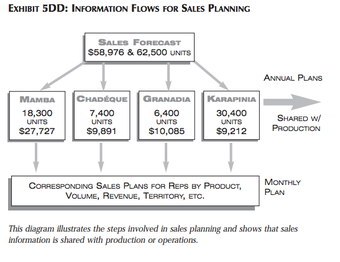
Information Flows for Sales Planning
Sales Planning
Specific steps or stages in a sales process vary from company to company but generally include the following elements:
- Initial contact
- Application of Initial Fit Criteria
- Sales lead
- Need identification
- Qualified prospect
- Proposal
- Negotiation
- Closing
- After sales service
An alternate but similar series of steps is as follows:
- Prospecting/Initial contact
- Preapproach—planning the sale
- Approach
- Need assessment
- Presentation
- Meeting objections
- Gaining commitment
- Follow-up
These eight steps of the sales process are more current and accurate than traditional sales. These are the typical steps taken, which are usually performed in the same order—however, this can vary depending on the current situation. These steps of the sales process are given (pg. 66) and explained in one of the most influential sales textbooks written by Gregory A. Rich, Rosann L. Spiro, and William J Stanton, entitled “Management of a Sales Force” Twelfth Edition.
Mapping a process provides a starting point for further careful analysis and continuous improvement. Diagramming a process flow is considered to be one of the seven basic quality improvement tools. Elements in the list above (among many others) have been described and flow-charted in the published literature. Some examples have primarily focused on functions performed by a sales “department”. At least one cross-functional approach depicts and integrates a variety of interdependent areas, such as sales, marketing, customer service, and information systems.
From a seller’s point of view, a sales process mitigates risk by stage-gating deals based on collection of information or execution of procedures that gate movement to the next step. Of the large number of initially interested persons on the narrow end of orders, only a fraction of the initially interested people remain and actually place an order. This controls seller resource expenditure on non-performing deals. Ideally this also prevents buyers from purchasing products they don’t need, though such a benefit requires ethical intentions by the seller. Because of the uncertainty of this assurance, buyers often have a buying or purchasing process. The interface between the selling and buying processes has also been diagrammed.
A formalized sales process is generally more common for companies that either have complex sales cycles, large revenue risks that require systematic assurance of revenue generation, and/or those that choose to use a more consultative sales approach (e.g. Saturn, IBM, Hewlett-Packard).
An effective sales process can be described through steps that walk a salesperson from meeting the prospect all the way through closing the sale. Often a bad sales experience can be analyzed and shown to have skipped key steps. This is where a good sales process mitigates risk for both buyer and seller. A solid sales process also has the dramatic impact of forecasting accuracy and predictability in revenue results.
Many companies develop their own sales process; however, off-the-shelf versions are available from a number of companies in the sales performance improvement industry. A large number of these methods have been described by their promoters in books available to the public, primarily addressing tactics employed by an individual sales representative. These provide a customizable process and a set of electronic tools that can be freestanding or integrated with the company’s SFA, CRM, or other opportunity management system.
17.4: Advertising
17.4.1: Social and Legal Considerations
Businesses need to understand the legal ramifications and social implications that occur from intentionally misleading the public.
Learning Objective
Explain how false advertising is prevented
Key Points
- False advertising or deceptive advertising is the use of false or misleading statements in advertising.
- Advertising is regulated by the authority of the Federal Trade Commission, a United States administrative agency, to prohibit “unfair and deceptive acts or practices in commerce”.
- The goal is prevention rather than punishment, reflecting the purpose of civil law in setting things right rather than that of criminal law.
Key Term
- Federal Trade Commission
-
The Federal Trade Commission (FTC) is an independent agency of the United States government, established in 1914 by the Federal Trade Commission Act. Its principal mission is the promotion of consumer protection and the elimination and prevention of anti-competitive business practices, such as coercive monopoly.
When crafting advertising and marketing communications, businesses need to understand the legal ramifications of false advertising as well as the social implications that occur from intentionally misleading the public.
False advertising or deceptive advertising is the use of false or misleading statements in advertising. As advertising has the potential to persuade people into commercial transactions that they might otherwise avoid, many governments around the world use regulations to control false, deceptive or misleading advertising. “Truth” refers to essentially the same concept, that customers have the right to know what they are buying, and that all necessary information should be on the label .

Listerine advertisement, 1932
From 1921 until the mid-1970s, Listerine was also marketed as a preventive and remedy for colds and sore throats. In 1976, the Federal Trade Commission ruled that these claims were misleading, and that Listerine had “no efficacy” at either preventing or alleviating the symptoms of sore throats and colds. Warner-Lambert was ordered to stop making the claims, and to include in the next $10.2 million dollars’ of Listerine ads specific mention that “contrary to prior advertising, Listerine will not help prevent colds or sore throats or lessen their severity. “
Advertising is regulated by the authority of the Federal Trade Commission, a United States administrative agency, to prohibit “unfair and deceptive acts or practices in commerce. ” While it makes laymen’s sense to assume that being deceptive is being unfair, deceptiveness in practice has been treated separately by the FTC, leaving unfairness to refer only to other types. All commercial acts may be deceptive, not just advertising, but noncommercial activity such as advertising for political candidates is not subject to prosecution under the FTC Act.
The goal is prevention rather than punishment, reflecting the purpose of civil law in setting things right rather than that of criminal law. The typical sanction is to order the advertiser to stop its illegal acts, or to include disclosure of additional information that serves to avoid the chance of deception. Corrective advertising may be mandated, but there are no fines or prison time except for the infrequent instances when an advertiser refuses to stop despite being ordered to do so. The actual statute defines false advertising as a “means of advertisement other than labeling, which is misleading in a material respect; and in determining whether an advertisement is misleading, there shall be taken into account (among other things) not only representations made or suggested by statement, word, design, device, sound, or any combination thereof, but also the extent to which the advertisement fails to reveal facts material in the light of such representations or material with respect to consequences which may result from the use of the commodity to which the advertisement relates under the conditions prescribed in said advertisement, or under such conditions as are customary or usual. “
In addition to federal laws, each state has its own unfair competition law to prohibit false and misleading advertising. In California, one such statute is the Unfair Competition Law [hereinafter “UCL”], Business and Professions Code § 17200 et seq. The UCL “borrows heavily from section 5 of the Federal Trade Commission Act” but has developed its own body of case law.
17.4.2: Types of Advertising
There are many types of advertising; each has different attributes, such as price, viewing demographic, and medium.
Learning Objective
Classify the various types of marketing and advertising
Key Points
- The TV commercial is generally considered the most effective mass-market advertising format, as is reflected by the high prices TV networks charge for commercial airtime during popular TV events.
- Radio advertising is a form of advertising via the medium of radio.
- Online advertising is a form of promotion that uses the Internet and World Wide Web for the expressed purpose of delivering marketing messages to attract customers.
- Press advertising describes advertising in a printed medium such as a newspaper, magazine, or trade journal.
Key Term
- World Wide Web
-
Collectively, all of the web pages on the Internet which hyperlink to each other and to other kinds of documents and media.
Example
- For example, following his performance of eight gold medals at the 2008 Olympic Games in Beijing, China, swimmer Michael Phelps’ contract with Kellogg’s was terminated, as Kellogg’s did not want to associate with him after he was photographed smoking marijuana. Celebrities such as Britney Spears have advertised for multiple products including Pepsi, Candies from Kohl’s, Twister, NASCAR, Toyota and many more.
There are many types of advertising; each has different attributes, such as price, viewing demographic, and medium.
The TV commercial is generally considered the most effective mass-market advertising format, as is reflected by the high prices TV networks charge for commercial airtime during popular TV events. The annual Super Bowl football game in the United States is known as the most prominent advertising event on television. The average cost of a single thirty-second TV spot during this game has reached $3.5 million (as of 2012).
Radio advertising is a form of advertising that is broadcast as radio waves through the air from a transmitter to an antenna and then to a receiving device. Airtime is purchased from a station or network in exchange for airing the commercials .

Billboard
Clarkes on Belmont billboard
Online advertising is a form of promotion that uses the Internet and World Wide Web for the expressed purpose of delivering marketing messages to attract customers. Online ads are delivered by an ad server. Examples of online advertising include:
- Contextual ads that appear on search engine results pages
- Banner ads
- In-text ads
- Rich Media Ads
- Social network advertising
- Online classified advertising
- Advertising networks
- E-mail marketing, including e-mail spam
Covert advertising, also known as guerrilla advertising, is when a product or brand is embedded in entertainment and media.
Press advertising describes advertising in a printed medium such as a newspaper, magazine, or trade journal. This encompasses everything from media with a very broad readership base, such as a major national newspaper or magazine, to more narrowly targeted media such as local newspapers and trade journals on very specialized topics.
Mobile billboards are generally vehicle mounted billboards or digital screens. These can be on dedicated vehicles built solely for carrying advertisements along routes preselected by clients, they can also be specially equipped cargo trucks or, in some cases, large banners strewn from planes. The billboards are often lighted; some being backlit, and others employing spotlights.
In-store advertising is any advertisement placed in a retail store. It includes placement of a product in visible locations in a store, such as at eye level, at the ends of aisles and near checkout counters (aka POP—Point Of Purchase display), eye-catching displays promoting a specific product, and advertisements in such places as shopping carts and in-store video displays.
Street advertising first came to prominence in the UK by Street Advertising Services to create outdoor advertising on street furniture and pavements. Working with products such as Reverse Graffiti, air dancers, and 3D pavement advertising, the media became an affordable and effective tool for getting brand messages out into public spaces.
Outdoor advertising opens the possibility of combining outdoor with indoor advertisement by placing large mobile, structures (tents) in public places on temporary bases. The large outer advertising space exerts a strong pull on the observer while the product is promoted indoors, where the creative decor can intensify the impression.
Celebrity branding focuses upon using celebrity power, fame, money, or popularity to gain recognition for their products or promote specific stores. Advertisers often advertise their products, for example, when celebrities share their favorite products or wear clothes by specific brands or designers. Celebrities are often involved in advertising campaigns such as television or print ads to advertise specific or general products. The use of celebrities to endorse a brand can have its downsides, however. One mistake by a celebrity can be detrimental to the public relations of a brand.
Sales promotions are another way to advertise. Sales promotions are double purposed because they are used to gather information about what type of customers you draw in and where they are, as well as to jumpstart sales. Sales promotions include things like contests and games, sweepstakes, product giveaways, samples coupons, loyalty programs, and discounts. The ultimate goal of sales promotions is to stimulate potential customers to take action.
17.4.3: Trends in Advertising
With the advent of the ad server, marketing through Internet opened new frontiers for advertisers with the “dot-com” boom of the 1990s.
Learning Objective
Compare guerrilla marketing and niche marketing
Key Points
- The share of advertising spending relative to GDP has changed little across large changes in media.
- At the turn of the 21st century, a number of websites, including the search engine Google, started a change in online advertising by emphasizing contextually relevant, unobtrusive ads intended to help, rather than inundate, users.
- A recent advertising innovation is “guerrilla marketing”, which involves unusual approaches, giveaways of products such as cars that are covered with brand messages, and interactive advertising where the viewer can respond to become part of the advertising message.
Key Terms
- GDP
-
Gross Domestic Product (Economics). A measure of the economic production of a particular territory in financial capital terms over a specific time period.
- advertising
-
communication whose purpose is to influence potential customers about products and services.
With the advent of the ad server, marketing through the Internet opened new frontiers for advertisers and contributed to the “dot-com” boom of the 1990s. Entire corporations operated solely on advertising revenue, offering everything from coupons to free Internet access. At the turn of the 21st century, a number of websites, including the search engine Google, started a change in online advertising by emphasizing contextually relevant, unobtrusive ads intended to help, rather than inundate, users. This has led to a plethora of similar efforts and an increasing trend of interactive advertising.
The share of advertising spending relative to GDP has changed little across large changes in media. For example, in the US in 1925, the main advertising media were newspapers, magazines, signs on streetcars, and outdoor posters. Advertising spending as a share of GDP was about 2.9 percent. By 1998, television and radio had become major advertising media. Nonetheless, advertising spending as a share of GDP was slightly lower—about 2.4 percent.
Guerilla Marketing
A recent advertising innovation is “guerrilla marketing”, which involves unusual approaches such as staged encounters in public places, giveaways of products such as cars that are covered with brand messages, and interactive advertising where the viewer can respond to or become part of the advertising message. Guerrilla advertising is becoming increasingly popular with more companies. This type of advertising is unpredictable and innovative, which causes consumers to buy the product or idea. This reflects an increasing trend of interactive and “embedded” ads, such as via product placement, having consumers vote through text messages, and various innovations utilizing social network services such as Facebook .

Candidate for Congress
Walter Faulkner, candidate for U.S. Congress, campaigning with a Tennessee farmer. Crossville, Tennessee.
Niche Marketing
Another significant trend regarding future of advertising is the growing importance of the niche market using niche—or targeted—ads. Also brought about by the Internet and the theory of The Long Tail, advertisers will have an increasing ability to reach specific audiences. In the past, the most efficient way to deliver a message was to blanket the largest mass market audience possible. However, usage tracking, customer profiles and the growing popularity of niche content brought about by everything from blogs to social networking sites, provides advertisers with audiences that are smaller but much better defined. This leads to ads that are more relevant to viewers and more effective for companies’ marketing campaigns. Among others, Comcast Spotlight is one such advertiser employing this method in their video on demand menus. These advertisements are targeted to a specific group and can be viewed by anyone wishing to find out more about a particular business or practice at any time, right from their home. This causes the viewer to become proactive and actually choose what advertisements they want to view.
With the Internet came many new advertising opportunities: popup, Flash, banner, popunder, advergaming, and email advertisements (all of which are often unwanted or spam in the case of email) are now commonplace. Particularly since the rise of “entertaining” advertising, some people may like an advertisement enough to wish to watch it later or show a friend. In general, the advertising community has not yet made this easy, although some have used the Internet to widely distribute their ads to anyone willing to see or hear them. In the last three quarters of 2009 mobile and internet advertising grew by 18.1% and 9.2% respectively. Older media advertising saw declines: −10.1% (TV), −11.7% (radio), −14.8% (magazines) and −18.7% (newspapers ).

Advertising
Advertisers will have an increasing ability to reach specific audiences due to changes in digital technology.
17.4.4: Agencies
An advertising agency or advert agency is a service business dedicated to creating, planning, and handling advertising for its clients.
Learning Objective
Explain advertising agencies’ role in communicating ideas
Key Points
- Creative agencies specialize in creative or design-based business models; their basic interest is in the creation of the advertisement or branding.
- The client who chooses to use a design-only advertising agency must assume some of the advertising purchasing.
- There are agencies that specialize in particular kinds of advertising: recruitment, help-wanted, medical, classified, industrial, financial, direct-response, retail, yellow pages, theatrical/entertainment, investment, travel, and so on.
Key Terms
- investment
-
A placement of capital in expectation of deriving income or profit from its use.
- Ad agencies
-
A service business dedicated to creating, planning, and handling advertising (and sometimes other forms of promotion) for its clients.
An advertising agency or advert agency is a service business dedicated to creating, planning, and handling advertising (and sometimes other forms of promotion ) for its clients. An ad agency is independent from the client and provides an outside point of view to the effort of selling the client’s products or services. An agency can also handle overall marketing and branding strategies and sales promotions for its clients.
Ad agencies come in all sizes and include everything from one or two-person shops (which rely mostly on freelance talent to perform most functions), small- to medium-sized agencies such as Traction (agency), large independents such as SMART, and multi-national, multi-agency conglomerates such as Omnicom Group, WPP Group, Publicis, Interpublic Group of Companies, and Havas.

Advertising
Advertisers will have an increasing ability to reach specific audiences due to changes in digital technology.
Creative agencies specialize in creative or design-based business models; their basic interest is in the creation of the advertisement or branding. Other (“full-service”) agencies offer design in conjunction with media buying. Media agencies concentrate on media buying. In the 1990s, media and creative were often unbundled in the interests of economies of scale in buying media.
The client who chooses to use a design-only advertising agency must assume some of the advertising purchasing. These are activities that are routinely handled by an agency with a media buying option. Media buying agencies are sometimes a good choice for larger businesses. These agencies can assume greater responsibility for the strategic planning and function of an advertising campaign. The advantage to a design-only agency is there is no third-party ordering the service. In turn, cost can be lower and is sometimes a good alternative for smaller businesses.
In addition to the full-service, general-line advertising agencies, there are also agencies that specialize in particular kinds of advertising: recruitment, help-wanted, medical, classified, industrial, financial, direct-response, retail, yellow pages, theatrical/entertainment, investment, travel, and so on.
Specialization occurs in such fields for a variety of reasons. Often, as in recruitment advertising, for example, specialized media or media uses are involved that require knowledge and expertise not ordinarily found in a general-line agency. In other cases, such as medical or industrial advertising, the subject is technical and requires that writers and artists have training in order to write meaningful advertising messages about it.
Such specialist advertising agencies are also usually full-service, in that they offer all of the basic advertising agency services in their area of specialization plus other, peripheral advertising services related to their area of specialization.
Some advertisers believe that they can provide these advertising services to themselves at a lower cost than would be charged by an outside agency. An In-House agency is a team that focuses on one goal to sell the company’s product; they will handle all aspects of the brand. In-House is the better option if a company is looking to build up an image over a number of years and create continuity between all aspects of separate campaigns.
Due to the social networking explosion, new types of companies are doing reputation management. This type of agency is especially important if a company needs online damage control. For example, disgruntled customers can quickly and easily damage a company’s reputation via social networking sites. Reputation management companies help stem the negative information or misinformation that might proliferate in their absence.
Social media agencies specialize in promotion of brands in various social media platforms like blogs, social networking sites, Q&A sites, discussion forums, microblogs etc. The two key services of social media agencies are social media marketing and online reputation management.
While not advertising agencies, enterprise technology agencies often work in tandem with advertising agencies to provide a specialized subset of services offered by some interactive agencies, such as Web 2.0 website design and development, content management systems, web application development, and other intuitive technology solutions for the web, mobile devices, and emerging digital platforms. The student-run advertising agency model, which mainly operates out of university classrooms or as a student groups, provides free advertising services to clients in exchange for the educational opportunity.
Chapter 16: Product Distribution
16.1: Distribution Channels
16.1.1: Marketing Intermediaries
Intermediaries are a powerful resource that enable organizations to outsource specific business functions in order to focus more on their core competency.
Learning Objective
Identify the value of various intermediaries, and understand which situations call for collaboration with them
Key Points
- Intermediaries take on key responsibilities of the value chain for organizations, such as shipping, retail, e-commerce, storage, web development, and marketing.
- Through utilizing intermediaries well, organizations can capture significant time and capital savings that can instead be invested into the core competency of the company.
- Distribution is a strong example of intermediaries, where an organization collaborates with Fedex or UPS in order to move their goods to their customers. Creating a shipping competency internally would be much more expensive.
- Retail and e-commerce are also common examples of intermediaries. Instead of purchasing expensive property to build storefronts, a fashion designer could instead sell their goods wholesale to established retail outlets.
- Understanding when to outsource something to an intermediary, and when to build the competency in house, is a key area of strategic decision-making.
Key Terms
- intermediaries
-
Organizations that act as a provider of a specific function or service for other organizations.
- e-commerce
-
A marketplace for the exchange of goods that exist solely online.
Why Use Intermediaries
Product distribution is the way an organization moves a product into the hands of their consumers. Most organizations focus on the design and production of the product or service they sell, and not on the distribution channels that connect them to the users themselves. Instead, they outsource many of these aspects to intermediaries.
Intermediaries are specialists for a specific function along the value chain. This could include distribution, marketing, sales, retail, e-commerce, web development, branding, packaging, storing, and a variety of other functions. Collaborating with one or more partners can enable an organization to focus on what it is that they do best (core competency) and, in turn, outsource other aspects of the value chain to organizations who are best at that particular function.
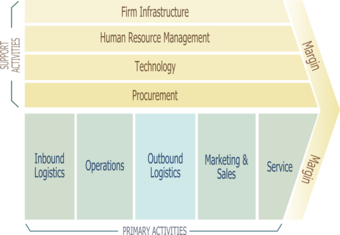
Porter Value Chain
Understanding the value chain is central to the concept of intermediaries. The value chain shows all the steps a business must take to get a product developed from the raw materials and into the hands of the consumer. Organizations benefit significantly from understanding the opportunity cost of intermediaries.
Common Intermediaries
Distribution
Some of the most common intermediaries are related to product distribution. Moving a good from the producer to the buyer is a logistically complex and resource-heavy process. Ensuring that shipping resources are available (e.g., trucks, ships, planes, and trains primarily) and that items move from supplier to warehouse to user is often handled by an intermediary such as Fedex or UPS. These organizations can utilize economies of scale and a vast network of resources to offer highly specialized delivery services at a relatively low cost and, more importantly, low risk.
Retail
Buying real estate to store and sell physical goods can be extremely cost prohibitive. Investing in retail outlets all across the world requires a huge amount of fixed investments, and likely will incur a high amount of debt. This debt is a business risk most smaller producers do not want to incur. As a result, they sell their items wholesale to various retail outlets. This allows both parties to mitigate risk, as the retailer can sell a variety of goods without having to produce them all, and the producer can acquire sales channels across the globe without investing significantly in real estate.
Consider a store like Macy’s, where the shelves are stocked with brand name goods. Macy’s in downtown Manhattan is an expensive piece of land, but the suppliers themselves are not liable for the purchase and maintenance of that property. Instead, Macy’s diversifies its portfolio of goods while producers provide them at lower wholesale prices to share risk.
Ad Agencies
Another popular intermediary is the ad agency. Ad agencies specialize in building communities and brands, utilizing a wide variety of paid and organic channels. This can include social networks such as Facebook, Linkedin, Twitter and Instagram, as well as paid ad production on popular TV channels or affiliate advertising. Ad agencies utilize the entire marketing mix (and more, nowadays) to craft customized brand building initiatives centered on the unique target market and product of their strategic partners.
E-commerce and Web Development
Maintaining an online storefront nowadays is relatively straight-forward, so more and more companies do this internally now. However, managing a large e-commerce team with strong web development skills (such as copy, graphic design, UX, and other e-commerce roles) can become a pricey endeavor. As a result, some organizations prefer outsourcing this as well.
Amazon is a great example of an e-commerce website designed to enable smaller businesses. Amazon actually handles quite a bit of intermediary responsibilities (i.e. shipping, storing, and e-commerce for starters). The value Amazon adds is not only limited to the skills of building strong websites, however. Amazon has a huge and loyal following of consumers, which makes them an attractive potential strategic alliance for many smaller firms.
Conclusion
What’s most important to understand about intermediaries is that they are a trade-off, where an organization recognizes the value of outsourcing a function relative to the opportunity cost of building that competency internally. When considering working with a third party, consider the core competency of that partner compared to the core competency of your own organization and determine if synergy exists (as opposed to redundancy).
16.1.2: The Value of Intermediaries
Utilizing intermediaries reduces organizational complexity and allows firms to focus on developing a core competency through specialization.
Learning Objective
Outline the various benefits of utilizing intermediaries, and understand how to capture value from the process
Key Points
- The primary advantage of intermediaries is the ability to focus specifically on what your organization does best. This is called specialization.
- Building internal capabilities in a variety of complicated fields, such as legal, HR, accounting, BI and countless other disciplines, is often a significant investment of time and resources as well as a source of risk.
- Organizations with many different departments focused on a wide variety of disciplines is likely to lose some agility due to complexity.
- Intermediaries that focus on doing one thing best for a wide variety of strategic partners will likely realize economies of scale. This means that by doing something in high volume, the marginal cost of additional units is significantly lower.
- Through utilizing intermediaries along the value chain, firms can maintain simple, specialized core competencies while mitigating risk and capturing economies of scale via similarly specialized partners.
Key Terms
- intermediaries
-
Organizations or individuals that fulfill tasks on behalf of other organizations.
- specialization
-
The ability to focus on one specific task, and create an advantage through excelling at this task.
Why Use Intermediaries?
Organizations use intermediaries in order to allow themselves to focus on their core competency and/or competitive advantages. This creates the economic advantage of specialization, and enables multiple strategic partners to collaborate on the design, production, and distribution of countless goods and services.
An Example
For example, assume you own a company that produces top quality audio equipment (speakers, surround sound, headphones, etc.). Your sound engineers are some of the best in the business, but you have limited resources. When it comes to retailing your items, you don’t have the capital to purchase property and open stores. So you use a marketing intermediary, and work with companies that sell music equipment. You also don’t have the capital to open a mass manufacturing facility, so you outsource your production to specialists in audio manufacturing. Instead of building a complex tax and finance team, you hire an accounting firm.
Next thing you know, your sound engineers, innovators, researchers and core managers are the only internal employees of your organization. The rest are value-adding intermediaries who limit your risk and allow you to focus on what you do best.
The Advantages of Intermediaries
Building relationships with various strategic partners along your value chain can be a significant source of competitive advantage and agility in the modern, hugely fast-paced world of business. A few key advantages in a general sense include:
- Specialization and Focus – As discussed above, often one of the primary advantages of utilizing intermediaries is the ability to increase focus on a business’ core products and core competency. Additionally, whomever the intermediary is shares this advantage. As a result, organizations with many intermediaries can benefit from the specializations of their partners.
- Economies of Scale – On a per output basis, it is often the case that higher volume leads to lower costs per unit. If an organization were to build its own shipping and logistics department, the cost per shipment would almost certainly be higher than that of Fedex or UPS. These organizations have developed scale while perfecting their process, an advantage a small organization will find nearly impossible to duplicate.
- Risk Mitigation – Trying to do everything means taking all the corresponding risks that everything has to offer. For example, an organization that takes on its own accounting and financial management will incur the risk of making tax mistakes and the fines that come along with it.
- Agility – A larger organization with more moving parts, including retail, manufacturing, taxes and accounting, finance, marketing, operational management, HR, legal, database management, IT and all the other various potential requirements of modern business must face the challenge of coordinating all of these work groups towards a shared objective. This higher degree of organizational inertia is likely to significantly reduce a business’ ability to progress and adapt to change.
While there are other advantages of intermediaries depending on the situation, this chart captures the broader reasoning behind the strategy of collaborating externally to fulfill certain operational requirements.
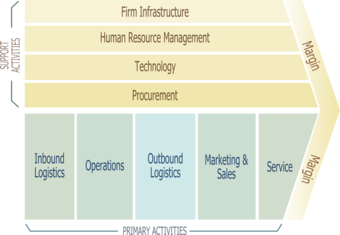
The Value Chain
The Value Chain is a great way to visualize where intermediaries could potentially exist within a given organization. Organizations tend to complete each of these tasks in some way, and outsourcing a variety of them is a useful starting point for specializing through intermediaries and strategic alliances.
16.1.3: The Cost of Intermediaries
While organizations gain advantage by collaborating with intermediaries, there are costs involved to consider.
Learning Objective
Understand the various costs which accompany product distribution when working with intermediaries
Key Points
- Distribution of goods from a provider to a consumer often includes interaction with a number of different intermediaries.
- Financial intermediaries, such as banks, enable the capital exchange behind a given transaction. This usually incurs a cost to either (or both) the consumer and the business.
- Physical storage and shipping is a resource and time intensive process, which incurs additional costs in the transaction.
- Storefronts, both digital and physical, often add a small amount to the sale price in order to cover the cost of a business’s location, staff, and other overhead.
- When considering distribution, it is important to recognize the value added by intermediaries, and the subsequent cost involved in collaboration.
Key Term
- intermediaries
-
A third-party that acts as a go-between in a given transaction
Distribution of goods is often enabled through collaboration with partners and intermediaries. While this is generally a mutually advantageous situation, where margins are captured by all parties, it is still worth briefly exploring how a given business is impacted by the cost of collaboration.
Common Costs of Intermediaries
While the intermediaries required will differ based on the product or service being discussed, there are a few common costs which most business can anticipate incurring when it comes to product distribution:
Financial Intermediaries – Transactions are the core function of exchange in the modern economy, where a good or service is transferred for a capital payment. This capital exchange is largely governed by banks. Costs are usually incurred to one or both parties during these exchanges, often as a percentage of the overall capital exchanged.
Shipping Intermediaries – Getting an item from the business to the user often requires shipping and warehousing. This service can be expensive due to the costs of transportation, and the necessity for holding inventory at various supply centers. As a result, either or both parties will likely incur costs for this service.
Marketing Intermediaries – Storefronts, be they online or physical locations, are convenient and comfortable contact points for products and consumers. As a result of the physical location, staffing, and inventory costs incurred by the storefronts themselves, either or both parties in the exchange are likely to incur costs.
There are various other intermediaries (legal, customer support, etc.), but this provides a general framework for common areas of collaboration when bringing a product or service from the business to the consumer.
Intermediaries in Context
Let’s consider an example. A consumer goes online to purchase a new tablet. For the sake of discussion, let’s say it is a Microsoft tablet being purchased from Amazon. From the perspective of the firm which created the product (Microsoft), there are quite a few intermediaries between the consumer and themselves as a producer:
- First is the storefront the consumer purchases it from, in this case Amazon. Naturally, Amazon will have marked up the price of the product in order to maintain profitability (with some exceptions).
- Next comes the payment provider. Amazon will link you with a bank or other financial provider (i.e. PayPal, bitcoin, etc.) to process the payment. This will also incur some cost.
- Following this, we still need to get the product from Amazon to the consumer’s doorstep. Shipping and handling fees will be applied.
As is demonstrated in this example, Microsoft’s product will incur various costs, some of which will be shouldered by Microsoft, and some which will be handled by the end consumer. During this process an ecosystem emerges where mutual value is gained by all parties throughout the transaction. While these costs are relevant strategically, so too are the benefits organizations derive from the process.
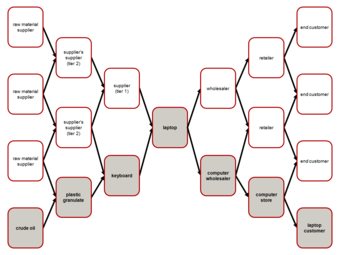
Intermediaries
This image shows a simple supply chain, including the various distribution intermediaries a company may work through in order to provide a customer with a product.
16.1.4: Channels for Consumer Goods
Marketing channels are sets of interdependent organizations involved in making a product or service available for use or consumption.
Learning Objective
Define a marketing channel in the modern complex distribution network
Key Points
- First, the channel consists of institutions, some under the control of the producer and some outside the producer’s control. Yet all must be recognized, selected, and integrated into an efficient channel arrangement.
- Second, the channel management process is continuous and requires constant monitoring and reappraisal. The channel operates 24 hours a day and exists in an environment where change is the norm.
- Finally, channels should have certain distribution objectives guiding their activities. The structure and management of the marketing channel is thus in part a function of a firm’s distribution objective. It is also a part of the marketing objectives, especially the need to make profit.
Key Term
- channels of distribution
-
Distribution of products takes place by means of channels. Channels are sets of interdependent organisations (called intermediaries) involved in making the product available for consumption.
With the growth of specialization, particularly industrial specialization, and with improvements in methods of transportation and communication, channels of distribution have become very complex. Thus, corn grown in Illinois may be processed into corn chips in West Texas, which are then distributed throughout the United States. Or, turkeys grown in Virginia are sent to New York so that they can be shipped to supermarkets in Virginia. Channels don’t always make sense. The channel mechanism also operates for service products. In the case of medical care, the channel mechanism may consist of a local physician, specialists, hospitals, ambulances, laboratories, insurance companies, physical therapists, home care professionals, and so forth. All of these individuals are interdependent, and could not operate successfully without the cooperation and capabilities of all the others.
Based on this relationship, a marketing channel can be defined as “sets of interdependent organizations involved in the process of making a product or service available for use or consumption, as well as providing a payment mechanism for the provider. ” This definition implies several important characteristics of the channel.
First, the channel consists of institutions, some under the control of the producer and some outside the producer’s control. Yet all must be recognized, selected, and integrated into an efficient channel arrangement.
Second, the channel management process is continuous and requires constant monitoring and reappraisal. The channel operates 24 hours a day and exists in an environment where change is the norm.
Finally, channels should have certain distribution objectives guiding their activities. The structure and management of the marketing channel is thus in part a function of a firm’s distribution objective. It is also a part of the marketing objectives, especially the need to make an acceptable profit. Channels usually represent the largest costs in marketing a product.

Selecting the channel
Selecting the right modes of transport is also very important in saving costs
16.1.5: Channels for Industrial Goods
Creating efficient and cost-effect channels for industrial goods can create value for business-to-business exchanges.
Learning Objective
Differentiate between consumer and industrial channels, and understand how to increase efficiency in B2B exchange
Key Points
- Industrial distribution channels mostly refer to business-to-business (B2B) transactions of relatively high volume. As a result, the channel strategy tends to be a bit different than that of consumer goods.
- One of the most important decisions in a B2B channel is choosing the way goods are transported. This could be via road, rail, ship, or plane.
- Channels of exchange are also rife with intermediaries, such as logistics companies, who expedite the process of exchange.
- In industrial distribution, contracts tend to be carefully negotiated, high volume, and continuous.
Key Term
- intermediaries
-
A person or organization in an intermediate position in a supply chain of goods or services
Industrial Goods
To understand industrial distribution channels, it’s important to realize that industrial goods generally refer to business-to-business (B2B) transactions of relatively high volume. When business enter exchange agreements, the contracts tend to involve large shipments that are repeated consistently over an agreed period of time.
With this in mind, the distribution strategy of industrial goods tends to be different than the distribution channels commonly utilized in business-to-consumer (B2C) transactions (such as retail outlets).
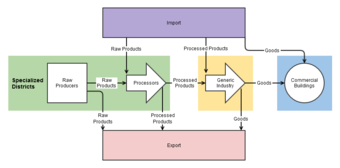
Industrial Channels
This image depicts the sourcing of raw materials, and the exchange of industrial goods between various businesses in the construction industry. As you can see, there are many channels in any given industry, and the exchange between organizations in big business.
Industrial Channel Considerations
Generally speaking, the distribution of industrial goods is planned carefully, negotiated in advance, and focused on maximizing cost savings through effective logistics. While there are many factors that may influence channel decisions, management generally needs to determine which modes of transportation to use, how to warehouse goods, environmental requirements (temperature, for example), intermediaries, and scheduling.
Mode of Transport
Getting goods from A to B requires a mode of transportation, and each will come with various tradeoffs. For the most part, these tradeoffs revolve around speed and capacity (how fast something can be moved, and how much of it). For industrial goods, the most common options are road, rail, ship, and plane.
- Ship – Cheap, slow, and limited to places with ports, ship transportation is excellent for high volume orders with no time constraints.
- Road – The trucking industry in the United States alone is a massive undertaking, with movement of goods happening around the clock. This is great for specificity in terms of location, and tends to be fairly fast.
- Rail – Rail is an extremely cheap option, due to the low labor and resources involved. Rail, however, has the key weakness of only going where there are tracks.
- Plane – The fastest, most accurate and most expensive form of transportation, air transportation is good for transporting a small volume of goods rapidly to a specific location.
Storage
Getting goods from A to B is only part of distribution. There will also be time between using a purchased asset and receiving it. This will be in the form of storage. Storage considerations are fairly simple: where to store goods, how much it will cost, how much space will be required, and what environment they should be stored in.
Intermediaries
Sometimes organizations use intermediaries, such as UPS or Fedex, to improve upon the logistics involved. These organizations specialize in minimizing the cost of transportation (through economy of scale), and take on the responsibility of moving, storing, and maintaining the goods as they are transported between the two bartering parties. Of course, intermediaries must turn a profit too, so the cost savings must offset the cost of the intermediary.
Conclusion
All and all, the channels involved in selling industrial goods between businesses are mostly about moving a high volume of goods from the producer to the buyer, often using a third party to handle the logistics.
16.2: Wholesalers
16.2.1: Merchant Wholesalers
Wholesale merchants, agents, and brokers help move goods between producers and retailers.
Learning Objective
Distinguish between the roles of wholesale merchants, agents, and brokers
Key Points
- Wholesale merchants, agents, and brokers are essential elements of the wholesale business. They help move goods between producers and retailers and the advent of modern technologies help them do this more efficiently.
- A wholesale merchant operates in the chain between producer and retail merchant. Some wholesale merchants only organize the movement of goods rather than move the goods themselves.
- In the wholesale business, wholesale agents and brokers do not take title to the merchandise being marketed, they only bring buyers and sellers together and negotiate the terms of the transaction.
Key Terms
- merchant wholesaler
-
an entity that purchases products, takes title of them, and then sells them (generally to retailers, other wholesalers, and industrial consumers)
- wholesale
-
The sale of products, often in large quantities, to retailers or other merchants.
- brokers
-
A mediator between a buyer and seller.
Wholesale merchants, agents, and brokers are essential elements of the wholesale business. They help move goods between producers and retailers and the advent of modern technologies help them do this more efficiently.
A wholesale merchant operates in the chain between the producer and the retail merchant. Some wholesale merchants only organize the movement of goods rather than move the goods themselves. Limited service merchant wholesalers take title to the merchandise and assume the risk involved in an independent operation. They buy and resell products and offer a limited range of services. Since wholesale activities can be assumed by the suppliers themselves, those merchant wholesalers who have remained viable have done so by providing improved service to suppliers and buyers. To do this at low cost, modern technologies must be increasingly integrated into the wholesale operation.
In the wholesale business, wholesale agents and brokers do not take title to the merchandise being marketed, they only bring buyers and sellers together and negotiate the terms of the transaction. Agent merchants represent their the buyer or seller, usually on a permanent basis; brokers bring parties together on a temporary basis. Brokers have the tools and resources to reach the largest possible base of buyers. They then screen these potential buyers for revenue that would support the potential acquisition. An individual producer, on the other hand, especially one new in the market, probably will not have the same access to customers as a broker. Another benefit of using a broker is cost—they might be cheaper in smaller markets, with smaller accounts, or with a limited line of products.

A Merchant
Merchants from Holland and the Middle East trading.
16.3: Retailers
16.3.1: Store Retailers
Store retailers vary in size, in the kinds of services, the assortment of merchandise they carry, and many other respects.
Learning Objective
Compare the different types of store retail facilities
Key Points
- Department stores are characterized by their very wide product mixes. That is, they carry many different types of merchandise that may include hardware, clothing, and appliances.
- Chain Stores: The 1920s saw the evolution of the chain store movement. Because chains were so large, they were able to buy a wide variety of merchandise in large quantity discounts.
- Supermarkets were among the first to experiment with such innovations as mass merchandising and low-cost distribution methods.
- Warehouse retailing is a relatively new type of retail institution that experienced considerable growth in the 1970s.
Key Term
- franchising
-
Franchising is the practice of using another firm’s successful business model.
Store Retailers
Store retailers vary in size, in the kinds of services that are provided, in the assortment of merchandise they carry, and in many other respects. Most stores are small and have daily sales of only a few hundred dollars. Few are extremely large, having sales of $500,000 or more on a single day. In fact, on special sale days, some stores have exceeded $1 million in sales.
Department Stores: Department stores are characterized by their very wide product mixes. That is, they carry many different types of merchandise that may include hardware, clothing, and appliances. Each type of merchandise is typically displayed in a different section or department within the store. The depth of the product mix depends on the store.
Chain Stores: The 1920s saw the evolution of the chain store movement. Because chains were so large, they were able to buy a wide variety of merchandise in large quantity discounts. The discounts substantially lowered their cost compared to costs of single-unit retailers. As a result, they could set retail prices that were lower than those of their small competitors and, thereby, increase their share of the market. Furthermore, chains were able to attract many customers because of their convenient locations, made possible by their financial resources and expertise in selecting locations.
Supermarkets: Supermarkets evolved in the 1920s and 1930s. For example, Piggly Wiggly Food Stores, founded by Clarence Saunders around 1920, introduced self-service and customer checkout counters. Supermarkets are large, self-service stores with central check-out facilities, they carry an extensive line of food items and often non-food products. Supermarkets were among the first to experiment with such innovations as mass merchandising and low-cost distribution methods. Their entire approach to the distribution of food and household cleaning and maintenance products was to make available to the public large assortments of a variety of such goods at each store at a minimal price.
Discount Houses: Cut-rate retailers have existed for a long time. However, since the end of World War II, the growth of discount houses as a legitimate and extremely competitive retailer has assured this type of outlet a permanent place among retail institutions. It essentially followed the growth of the suburbs. Discount houses are characterized by an emphasis on price as their main sales appeal. Merchandise assortments are generally broad, including both hard and soft goods, but assortments are typically limited to the most popular items, colors, and sizes. Such stores are usually large, self-service operations with long hours, free parking, and relatively simple fixtures.
Warehouse Retailing: Warehouse retailing is a relatively new type of retail institution that experienced considerable growth in the 1970s. Catalog showrooms are the largest type of warehouse retailer, at least in terms of the number of stores operated. Their growth rate has slowed in comparison to previous decades, but they still have a huge presence in terms of their sales.
Franchises: Over the years, particularly since the 1930s, large chain store retailers have posed a serious competitive threat to small store owners. One of the responses to this threat has been the rapid growth of franchising. Franchising is not a new development. The major oil companies such as Mobil have long enfranchised its dealers, who only sell the products of the franchiser (the oil companies). Automobile manufacturers also enfranchise their dealers, who sell a stipulated make of car (e.g., Chevrolet) end operate their business to some extent as the manufacturer wishes.
Planned Shopping Centers: After World War II, the United States underwent many changes. Among those most influential on retailing were the growth of the population and of the economy. New highway construction enabled people to leave the congested central cities and move to newly developed suburban residential communities. This movement to the suburbs established the need for new centers of retailing to serve the exploding populations. By 1960 there were 4,500 such centers with both chains and non-chains vying for location. Such regional shopping centers are successful because they provide customers with a wide assortment of products. If you want to buy a suit or a dress, a regional shopping center provides many alternatives in one location.

Macy’s Department Store
The Macy’s flagship department store with the famous brownstone at 34th and Broadway.
16.3.2: Nonstore Retailers
Non-store retailing is the selling of goods and services outside the confines of a retail facility.
Learning Objective
Discuss non-store retailing as a sales channel
Key Points
- E-commerce is growing by leaps and bounds, as consumers become more comfortable with the concept and their options increase.
- In total, non-store retailing accounts for a relatively small percentage of total retail sales, but it is growing and very important with certain types of merchandise, such as life insurance, cigarettes, magazines, books, CDs, and clothing.
- The non-store distribution channel can be divided into direct selling (off-premises sales), and distance selling, the latter include all forms of electronic commerce.
Key Term
- Direct selling
-
Direct selling is the marketing and selling of products directly to consumers away from a fixed retail location.
Non-store retailing is the selling of goods and services outside the confines of a retail facility. It is a generic term describing retailing taking place outside of shops and stores (i.e., off the premises of fixed retail locations and of markets stands). The non-store distribution channel can be divided into direct selling (off-premises sales) and distance selling, the latter including all forms of electronic commerce. Distance selling includes mail order, catalogue sales, telephone solicitations, and automated vending. Electronic commerce includes online shopping, Internet trading platforms, travel portals, global distribution systems, and teleshopping. Direct selling includes party sales and all forms of selling in consumers’ homes and offices, including even garage sales.
E-commerce is growing by leaps and bounds, as consumers become more comfortable with the concept and their options increase. Flash deal sites have been the trend of the moment, where consumers generally have a membership with a specific site and are given access to a limited-time price on a good. E-commerce sites now cover almost every nook and cranny of the retail space. You can go to the wildly successful Alibaba.com to buy machinery from Asia. You can go to CustomMade.com to purchase a good made specifically for you by one of those same machines. With all the e-commerce growth comes interesting trends relating to consumers becoming more comfortable with making purchase on their mobile phones and tablets. Mobile phones also aid purchases everywhere now more than ever, and play a crucial role in any retailer’s marketing strategy.
In total, non-store retailing accounts for a relatively small percentage of total retail sales, but it is growing and very important with certain types of merchandise, such as life insurance, cigarettes, magazines, books, CDs, and clothing. One type of non-store retailing used by such companies as Avon, Electrolux, and many insurance agencies is in-home selling. Such sales calls may be made to preselected prospects or in some cases on a cold call basis. A variation of door-to-door selling is the demonstration party. Here one customer acts as a host and invites friends. Tupperware has been very successful with this approach. Vending machines are another type of non-store retailing. Mail order is a form of non-store retailing that relies on product description to sell merchandise. The communication with the customer can be by flyer or catalog. Magazines, CDs, clothing, and assorted household items are often sold in this fashion. Mail order offers convenience but limited service, and it is an efficient way to cover a very large geographical area when shoppers are not concentrated in one location.

Tupperware Party
Tupperware party in the 1960’s.
16.3.3: Internet Retailers
Online retailing is a form of electronic commerce where consumers directly buy goods or services from a seller using the Internet.
Learning Objective
Outline the process of online shopping
Key Points
- An online shop, e-store, or virtual store evokes the physical analogy of buying products or services at a shopping center. The process is called business-to-consumer (B2C) online shopping. When a business buys from another business, it is called business-to-business (B2B) online shopping.
- Consumers find a product of interest by visiting the website of the retailer directly or by searching among alternative vendors using a shopping search engine. A “checkout” process follows in which payment and delivery information is collected, if necessary.
- Once a payment has been accepted the goods or services can be delivered in the following ways: downloading, shipping, in-store pick up, “at the door” pick up, and printing out or emailing.
Key Term
- electronic commerce
-
Electronic commerce, commonly known as e-commerce, is the buying and selling of products or services over electronic systems such as the Internet and other computer networks.
Internet Retailers
Online retailing is a form of electronic commerce whereby consumers directly buy goods or services from a seller over the Internet without an intermediary. An online shop, eshop, e-store, Internet shop, webshop, webstore, online store, or virtual store evokes the physical analogy of buying products or services at a bricks-and-mortar retailer or shopping center. The process is called business-to-consumer (B2C) online shopping. When a business buys from another business it is called business-to-business (B2B) online shopping. The largest online retailing corporations are eBay and Amazon.com, both of which are US-based .

Amazon.com Headquarters
This is the headquarters of Amazon.com, the largest online retailer in the world.
The Process of Shopping Online
Consumers find a product of interest by visiting the website of the retailer directly or by searching among alternative vendors using a shopping search engine. Once a particular product has been found on the web site of the seller, most online retailers use shopping cart software to allow the consumer to accumulate multiple items and to adjust quantities, much similar to the process of filling a physical shopping cart or basket in a conventional store. A “checkout” process follows (continuing the physical-store analogy) in which payment and delivery information is collected, if necessary.
Some stores allow consumers to sign up for a permanent online account so that some or all of this information only needs to be entered once. The consumer often receives an e-mail confirmation once the transaction is complete. Less sophisticated stores may rely on consumers to phone or e-mail their orders (though credit card numbers are not accepted by e-mail, for security reasons). Online shoppers commonly use a credit card to make payments, but some systems enable users to create accounts and pay by alternative means, such as: billing to mobile phones and landlines, cash on delivery (or C.O.D., which is offered by very few online stores), checks, and wire transfers.
The Methods of Delivery
Once a payment has been accepted, the goods or services can be delivered in the following ways:
Downloading: This method is often used for digital media products such as software, music, movies, or images.
Drop shipping: The order is passed to the manufacturer or third-party distributor, who ships the item directly to the consumer, bypassing the retailer’s physical location to save time, money, and space.
In-store pickup: The customer orders online, finds the closest local store using locator software and picks the product up there. This method is often used in the bricks and clicks business model.
Printing out, provision of a code for, or emailing of such items as admission tickets and scrip (e.g., gift certificates and coupons): The tickets, codes, or coupons may be redeemed at the appropriate physical or online premises and their content reviewed to verify their eligility (e.g., assurances that the right of admission or use is redeemed at the correct time and place, for the correct dollar amount, and for the correct number of uses).
Shipping: The product is shipped to the customer’s address or that of a customer-designated third party.
Will call, in care of box office (ICOBO), or “at the door” pickup: The patron picks up pre-purchased tickets for an event, such as a play, sporting event, or concert, either just before the event or in advance. With the onset of the Internet and e-commerce sites, which allow customers to buy tickets online, the popularity of this service has increased.
16.3.4: Telemarketing
Telemarketing is a method of direct marketing where a salesperson solicits prospective customers directly, usually over the phone.
Learning Objective
Break down the elements of telemarketing
Key Points
- Telemarketing can also be done through a subsequent face-to-face or Web conferencing appointment scheduled during the call, and can include recorded sales pitches programmed to be played over the phone via automatic dialing.
- Telemarketing has come under fire in recent years, being viewed as an annoyance and a disturbance by many.
- Prospective customers are identified by various means, including past purchase history, previous requests for information, credit limit, competition entry forms, application forms, or purchases from another company’s consumer database or obtained from a telephone directory or another public list.
Key Term
- robocalling
-
a form of voice broadcasting which is most frequently associated with political messages.
Telemarketing
Telemarketing is a method of direct marketing in which a salesperson solicits prospective customers to buy products or services, either over the phone or through a subsequent face-to-face or Web conferencing appointment scheduled during the call . Telemarketing can also include recorded sales pitches programmed to be played over the phone via automatic dialing. Telemarketing has come under fire in recent years, being viewed as an annoyance and a disturbance by many. While many methods of marketing will suffer this criticism to some degree by those who prefer not to be disturbed, telemarketing seems to be criticized particularly because of its direct, intrusive nature. The two major categories of telemarketing are business-to-business and business-to-consumer.

Telemarketing
Author and activist Bob Wood places one of his numerous phone calls to residents in Muskegon County, Michigan.
Some important terms used in telemarketing are:
- Lead Generation – the gathering of information and contacts.
- Sales – using persuasion to sell a product or service.
- Outbound – proactive marketing in which prospective and preexisting customers are contacted directly.
- Inbound – reception of incoming orders and requests for information.
Demand is generally created by advertising, publicity, or the efforts of outside salespeople. Telemarketing may be done from a company office, from a call center, or from home. It may involve either a live operator or a recorded message, in which case it is known as “automated telemarketing” using voice broadcasting. “Robocalling” is a form of voice broadcasting that is most frequently associated with political messages. An effective telemarketing process often involves two or more calls. The first call (or series of calls) determines the customer’s needs. The final call (or series of calls) motivates the customer to make a purchase.
Prospective customers are identified by various means, including past purchase history, previous requests for information, credit limit, competition entry forms, and application forms. Names may also be purchased from another company’s consumer database or obtained from a telephone directory or another public list. The qualification process is intended to determine which customers are most likely to purchase the product or service. Charitable organizations, alumni associations, and political parties often use telemarketing to solicit donations. Marketing research companies use telemarketing techniques to survey the prospective or past customers of a client’s business in order to assess market acceptance of or satisfaction with a particular product, service, brand, or company. Public opinion polls are conducted in a similar manner. Telemarketing techniques are also applied to other forms of electronic marketing using e-mail or fax messages, in which case they are frequently considered spam by receivers.
16.3.5: Vending Machines
A vending machine can dispense a wide variety of merchandise when the consumer inserts money into it.
Learning Objective
Explain the vending machine process
Key Points
- Vending machines have a huge variety of goods that they may dispense: snacks, beverages, alcohol, cigarettes, lottery tickets, consumer products, electronics, full meals, and even jewellery.
- The main example of a vending machine giving access to all merchandise after paying for one item is a newspaper vending machine (also called vending box) found mainly in the U.S. and Canada.
- Some products need to be prepared to become available. For example, tickets are printed or magnetized on the spot, and coffee is freshly concocted. Others, such as newspapers, are already ready for use.
Key Term
- vending machine
-
A automatic machine that accepts money and dispenses merchandise.
A vending machine is a machine which dispenses items such as snacks, beverages, alcohol, cigarettes, lottery tickets, consumer products and even gold and gems to customers automatically, after the customer inserts currency or credit into the machine . After paying, a product may become available by: the machine releasing it, so that it falls in an open compartment at the bottom, or into a cup, either released first, or put in by the customer; the unlocking of a door or drawer; or the turning of a knob. Some products need to be prepared to become available. For example, tickets are printed or magnetized on the spot, and coffee is freshly concocted. The most common form of vending machine, the snack machine, often uses a metal coil which rotates to release an ordered product.
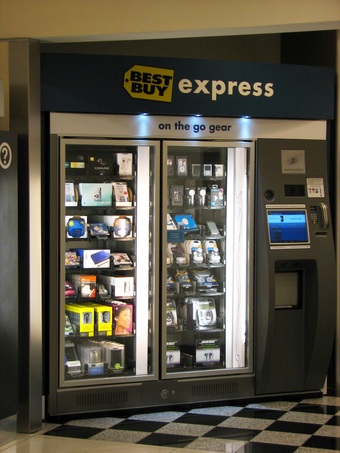
Best Buy Vending Machine
This is a Best Buy Express vending machine at an airport terminal, stocked with electronics. These are referred to as automated retail kiosks.
The main example of a vending machine giving access to all merchandise after paying for one item is a newspaper vending machine (also called vending box) found mainly in the U.S. and Canada. It contains a pile of identical newspapers. After a sale, the door automatically returns to a locked position. A customer could open the box and take all of the newspapers or, for the benefit of other customers, leave all of the newspapers outside of the box, slowly return the door to an unlatched position, or block the door from fully closing. All of these possibilities are frequently discouraged, sometimes by a security clamp. The success of such machines is predicated on the assumption that the customer will be honest (hence the nickname “honor box”), and need only one copy.
A wide variety of goods can be dispensed by vending machines, and in some places, even burgers and steaks!
16.3.6: Mall Kiosks
A retail kiosk (or mall kiosk) is a store operated out of a merchant supplied kiosk.
Learning Objective
Explain the benefits and drawbacks of employing a retail kiosk (RMU)
Key Points
- Kiosks are located in shopping malls, airports, stadiums, or larger stores. Their placement guarantees high foot traffic from shoppers and offers opportunities for impulse sales.
- Holiday rents are generally term rents that encompass both November and December. These holiday rents are often three to four times the non-holiday rents for each of these two months.
- Benefits of kiosks include high visibility, low overhead, small inventories, and low or non-existent CAM, tax, utility, and marketing fees, as compared to their in-line storefront counterparts.
Key Term
- kiosk
-
A small enclosed structure, often freestanding, open on one side or with a window, used as a booth to sell newspapers, cigarettes, etc.
A retail kiosk (or mall kiosk) is a store operated out of a merchant supplied kiosk. It is typically enclosed with the operator located in the center and the customer approaching the vendor from across a counter. These units are located in shopping malls, airports, stadiums, or larger stores. The industry term for smaller units is retail merchandising unit (RMU) cart or mall cart. These smaller desk size units were created to avoid lease conflicts with existing stores with “kiosk” language exclusions and local fire codes requiring greater distance between units by placing them on wheels. RMUs function with the operator approaching the customer from the area surrounding the unit and showing or even demonstrating the product firsthand. Their placement guarantees high foot traffic from shoppers and offers opportunities for impulse sales .

Mall Kiosk
These are mall kiosks in Haifa Mall, Haifa, Israel.
RMUs are usually supplied by the property owner and licensed rather than leased. Kiosks are also available under the same conditions and may even be supplied by the property owner when they have been abandoned by former tenants. Rents vary by market conditions and mall traffic. Holiday rents are generally term rents that encompass both November and December with a combined sales breakpoint for the holiday term on short-term agreements or annual sales breakpoints on permanent agreements. These holiday rents are often three to four times the non-holiday rents for each of these two months.
Due to the high visibility of these units, which are most often located in the common areas of malls, these businesses can often gain a relatively trackable monthly sales figure after a three or four month trial. Many other benefits exist, such as low overhead, small inventories, and low or non-existent CAM, tax, utility, and marketing fees, as compared to their in-line storefront counterparts, which can often have fees equal to or in excess of the rents themselves.
16.3.7: Direct Selling
Direct selling is the marketing and selling of products directly to consumers, away from a fixed retail location.
Learning Objective
Explain the role of direct selling in retail
Key Points
- In contrast to franchising, the cost for an individual to start an independent direct selling business is typically very low with little or no required inventory or other cash commitments in the beginning.
- The World Federation of Direct Selling Associations (WFDSA) reports that its 59 regional member associations accounted for more than U.S. $114 billion in retail sales in 2007 through the activities of more than 62 million independent sales representatives.
- Direct selling is distinct from direct marketing because it is about individual sales agents reaching and dealing directly with clients, while direct marketing is about business organizations seeking a relationship with their customers without going through an agent/consultant or retail outlet.
Key Term
- Direct Marketing
-
is a channel-agnostic form of advertising that allows businesses and nonprofits organizations to communicate straight to the customer
Direct Selling in Retail
Direct selling is the marketing and selling of products directly to consumers, away from a fixed retail location. Peddling is the oldest form of direct selling. Modern direct selling is done through personal presentation and includes sales made through the party plan, one-on-one demonstrations, and other personal contact arrangements as well as internet sales.
The World Federation of Direct Selling Associations (WFDSA) reports that its 59 regional member associations accounted for more than U.S. $114 billion in retail sales in 2007 through the activities of more than 62 million independent sales representatives. The United States Direct Selling Association (DSA) reported that in 2000, 55 percent of adult Americans had at some point purchased goods or services from a direct selling representative, and 20 percent reported that they were currently (6 percent) direct selling representatives or had been in the past (14 percent).
According to the WFDSA, consumers benefit from direct selling because of the convenience and service it provides, including personal demonstrations and explanations of products, home delivery, and generous satisfaction guarantees. In contrast to franchising, the cost for an individual to start an independent direct selling business is typically very low with little or no required inventory or other cash commitments in the beginning.
Most direct selling associations, including the Bundesverband Direktvertrieb Deutschland (the direct selling association of Germany), the WFDSA, and the DSA, require their members to abide by a code of conduct ensuring a fair partnership both with customers and salesmen. Most national direct selling associations are represented in the World Federation of Direct Selling Associations (WFDSA).
Direct selling is distinct from direct marketing because it is about individual sales agents reaching and dealing directly with clients. Direct marketing is about business organizations seeking a relationship with their customers without going through an agent, consultant, or retail outlet. Direct selling frequently uses multi-level marketing rather than single-level marketing. In multi-level marketing, the salesperson is paid both for selling and for the sales made by the people he or she recruits or sponsors. In single-level marketing, the salesperson is paid only for the sales he or she makes individually.
Largest Direct Selling Companies
According to Direct Selling News, the largest direct selling companies by ‘revenue in 2011’ were:
- Avon Products, founded 1886, U.S. $ 11.3 billion
- Amway, founded 1959, U.S. $ 10.9 billion
- Herbalife, founded 1980, U.S. $ 3.5 billion
- Natura, founded 1969, U.S. $ 3.01 billion
- Vorwerk, founded 1883, U.S. $ 3.0 billion
- Mary Kay, founded 1963, U.S. $ 2.9 billion
- Tupperware, founded 1946, U.S. $ 2.6 billion
- Oriflame, founded 1967, U.S. $ 2.1 billion
- Nu Skin Enterprises, founded 1984, U.S. $ 1.7 billion
- Belcorp, founded 1967, U.S. $ 1.6 billion

Direct Selling
A peddler in Vietnam
16.4: Logistics
16.4.1: Distribution Modes
Cargo (or freight) is goods or produce transported, generally for commercial gain, by ship, aircraft, intermodal train, van, or truck.
Learning Objective
Compare aircraft cargo, train cargo and road cargo
Key Points
- Air cargo, commonly known as air freight, is collected by firms from shippers and delivered to customers. Aircraft were first used for carrying mail as cargo in 1911.
- Trains are capable of transporting large numbers of containers that come from shipping ports. Trains also are used for the transportation of steel, wood, and coal.
- Feight transport by rail is more economical and energy efficient than by road, especially when carried in bulk or over long distances. The main disadvantage of rail freight is its lack of flexibility. For this reason, rail has lost much of the freight business to road transport.
Key Term
- Cargo
-
(or freight) is goods or produce transported, generally for commercial gain, by ship, aircraft, intermodal train, van, or truck. In modern times, containers are used in most intermodal freight transport.
Cargo (or freight) is goods or produce transported, generally for commercial gain, by ship, aircraft, intermodal train, van, or truck. In modern times, containers are used in most intermodal freight transport.
Air cargo, commonly known as air freight, is collected by firms from shippers and delivered to customers. Aircraft were first used for carrying mail as cargo in 1911. Eventually, manufacturers started designing aircraft for other types of freight as well. There are many commercial aircraft suitable for carrying cargo such as the Boeing 747 and the bigger An-124, which was purposely built for easy conversion into a cargo aircraft. Such large aircraft employ quick-loading containers known as “unit load devices (ULDs)”, much like containerized cargo ships. The ULDs are located in front section of the aircraft. Most nations own and utilize large numbers of cargo aircraft, such as the C-17 Globemaster III, for their logistical needs.
Trains are capable of transporting large numbers of containers that come from shipping ports. Trains are also used for the transportation of steel, wood, and coal. They are used because they can carry a large amount and, generally, have a direct route to the destination. Under the right circumstances, freight transport by rail is more economical and energy efficient than by road, especially when carried in bulk or over long distances. The main disadvantage of rail freight is its lack of flexibility. For this reason, rail has lost much of the freight business to road transport. Rail freight is often subject to trans-shipment costs, since it must be transferred from one mode of transportation to another. Practices, such as containerization, aim at minimizing these costs. Many governments are currently trying to encourage shippers to use trains more often because of the environmental benefits. Many firms, such as Parcelforce, FedEx, R+L Carriers, and U-Haul, transport all types of cargo by road. Delivering everything from letters to houses to cargo containers, these firms offer fast, sometimes same-day, delivery. A good example of road cargo is food, as supermarkets require deliveries every day to keep their shelves stocked with goods. Retailers of all kinds rely upon delivery trucks, be they full-size, semi trucks or smaller delivery vans.

Cargo
Cargo net being used to unload sacks from a ship at Haikou New Port, Haikou City, Hainan, China.
16.4.2: Inventory Management
Inventory represents finished and unfinished goods that have not yet been sold by a company.
Learning Objective
Explain why and how companies keep inventory
Key Points
- Inventories are maintained because time lags in moving goods to customers could otherwise put sales at risk.
- Inventories are maintained as buffers to meet uncertainties in demand, supply and movements of goods.
- There are four stages of inventory: raw material, work in progress, finished goods, and goods for resale.
Key Terms
- raw materials
-
Materials and components scheduled for use in making a product.
- Finished goods
-
Goods ready for sale to customers.
- Work in process
-
Materials and components that have began their transformation to finished goods.
Example
- A canned food manufacturer’s materials inventory includes the ingredients to form the foods to be canned, empty cans and their lids (or coils of steel or aluminum for constructing those components), labels, and anything else (solder, glue, etc.) that will form part of a finished can. The firm’s work in process includes those materials from the time of release to the work floor until they become complete and ready for sale to wholesale or retail customers. This may be vats of prepared food, filled cans not yet labeled or sub-assemblies of food components. It may also include finished cans that are not yet packaged into cartons or pallets. Its finished good inventory consists of all the filled and labeled cans of food in its warehouse that it has manufactured and wishes to sell to food distributors (wholesalers), to grocery stores (retailers), and even perhaps to consumers through arrangements like factory stores and outlet centers.
Reasons for Keeping Inventory
In many cases (such as retail), a business must have its product on hand in order to complete a sale. For these companies, the reason for keeping one of each item on hand (in inventory) is that it enables them to make sales and capture revenue. However, many businesses keep more than one of every item on hand and also keep raw materials and unfinished goods on stock in factories. Why do they do this?
There are three basic reasons for keeping an inventory:
- Time: The time lags present in the supply chain, from supplier to user at every stage, requires that you maintain certain amounts of inventory to use in this lead time. However, in practice, inventory is to be maintained for consumption during variations in lead time. Lead time itself can be addressed by ordering that many days in advance.
- Uncertainty: Inventories are maintained as buffers to meet uncertainties in demand, supply and movements of goods.
- Economies of scale: Ideal condition of “one unit at a time, at a place where a user needs it, when he needs it” principle tends to incur lots of costs in terms of logistics. So bulk buying, movement and storing brings in economies of scale, thus inventory. All these stock reasons can apply to any owner or product.
Managing Inventory
Inventory management is primarily about specifying the location and amount of stocked goods. Optimizing inventory management requires balancing many factors, including:
- Replenishment lead time
- Carrying costs of inventory
- Asset management
- Inventory forecasting
- Inventory valuation
- Inventory visibility
- Future inventory price forecasting
- Physical inventory
- Available physical space for inventory
- Quality management
- Replenishment
- Returns and defective goods
- Demand forecasting
Balancing these competing requirements leads to optimal inventory levels, which is an on-going process as the business needs to react to the wider environment. Optimal inventory levels are those that maximize profit from sales, while minimizing cost from storage, shipping, and working capital deployment.
While accountants often discuss inventory in terms of goods for sale, other organizations (such as manufacturers, service-providers and not-for-profits) also have inventories (fixtures, furniture, supplies, etc.) that they do not intend to sell. Manufacturers’, distributors’, and wholesalers’ inventory tends to cluster in warehouses. Retailers’ inventory may exist in a warehouse or in a shop or store accessible to customers. Inventories not intended for sale to customers or to clients may be held in any premises an organization uses. Stock ties up cash and, if uncontrolled, it will be impossible to know the actual level of stocks, and therefore impossible to control them.
Stages of Inventory
While the reasons for holding stock were covered earlier, most manufacturing organizations usually divide their “goods for sale” inventory into:
- Raw materials: materials and components scheduled for use in making a product
- Work in process (WIP): materials and components that have began their transformation to finished goods
- Finished goods: goods ready for sale to customers
- Goods for resale: returned goods that are salable

Inventory
Inventory in a warehouse
16.4.3: Warehousing
A warehouse is a commercial building for storage of goods.
Learning Objective
Explain the logistics of warehousing
Key Points
- Warehouses are used by manufacturers, importers, exporters, wholesalers, transport businesses, customs, etc.
- Some warehouses are completely automated, and require only operators to work and handle all the task.
- Warehouse management monitors the progress of products through the warehouse. It involves the physical warehouse infrastructure, tracking systems, and communication between product stations.
Key Terms
- Auto ID Data Capture (AIDC)
-
Warehouse management systems often utilize AIDC technology, such as barcode scanners, mobile computers, wireless LANs and potentially radio-frequency identification (RFID) to efficiently monitor the flow of products.
- Warehouse management
-
The progress of products through the warehouse. It involves the physical warehouse infrastructure, tracking systems, and communication between product stations.
A warehouse is a commercial building for storage of goods. Warehouses are used by manufacturers, importers, exporters, wholesalers, transport businesses, customs, etc. They are usually large plain buildings in industrial areas of cities and towns and villages. They usually have loading docks to load and unload goods from trucks. Sometimes warehouses are designed for the loading and unloading of goods directly from railways, airports, or seaports. They often have cranes and forklifts for moving goods, which are usually placed on ISO standard pallets and loaded into pallet racks. Stored goods can include any raw materials, packing materials, spare parts, components, or finished goods associated with agriculture, manufacturing, or commerce.
Some warehouses are completely automated, and require only operators to work and handle all the tasks. Pallets and products move on a system of automated conveyors, cranes, and automated storage and retrieval systems coordinated by programmable logic controllers and computers running logistics automation software. These systems are often installed in refrigerated warehouses where temperatures are kept very cold to keep product from spoiling, especially in electronics warehouses where they require specific temperatures to avoid damaging the parts, and also where land is expensive, as automated storage systems can use vertical space efficiently. These high-bay storage areas are often more than ten meters (33 feet) high, with some over 20 meters (65 feet) high. Automated storage systems can be built up to 40m high.
Warehouse management monitors the progress of products through the warehouse. It involves the physical warehouse infrastructure, tracking systems, and communication between product stations. Warehousing is critical in saving costs and timely order fulfillment, and today it is a vital part of supply chain management demand management. Even production management is to a great extent dependent on warehouse management. Efficient warehouse management gives a cutting edge to a retail chain distribution company. It should start at the container design stage of a product and not at the delivery of material in the warehouse.
Warehouse management systems often utilize Auto ID Data Capture (AIDC) technology, such as barcode scanners, mobile computers, wireless LANs and potentially radio-frequency identification (RFID) to efficiently monitor the flow of products. Once data has been collected, there is either a batch synchronization with, or a real-time wireless transmission to a central database. The database can then provide useful reports about the status of goods in the warehouse. A set of computerized procedures handle the receipt of stock and returns into a warehouse facility, model and manage the logical representation of the physical storage facilities (e.g., racking), manage the stock within the facility, and enable a seamless link to order processing and logistics management in order to pick, pack and ship product out of the facility.

A Warehouse
Inside Green Logistics Co., Kotka, Finland. The image shows goods loaded on pallets to the left of the aisle, and stacked pallets with no loads to the right of the aisle.
16.4.4: Materials Handling
Materials handling is the movement, storage, control, and protection of materials during their manufacturing, distribution, consumption, and disposal.
Learning Objective
Explain the importance of efficient material handling
Key Points
- Material handling systems range from simple pallet rack and shelving projects to complex overhead conveyor systems and automated storage and retrieval systems (AS/RS). Material handling can also consist of sorting and picking, as well as automatic guided vehicles.
- The Material Handling System (MHS) is a fundamental part of a flexible manufacturing system, since it interconnects the different processes supplying and taking out raw material, workpieces, subproducts, parts, and final products.
- There are several ways to determine if the material handling equipment is achieving peak efficiency. These include capturing all relevant data related to the warehouse’s operations, such as the Stock Keeping Unit (SKU).
Key Terms
- Material Handling System (MHS)
-
A fundamental part of a flexible manufacturing system, since it interconnects the different processes supplying and taking out raw material, workpieces, subproducts, parts, and final products.
- Stock Keeping Unit (SKU)
-
A unique identifier for each distinct product and service that can be purchased in business.
Material Handling is the movement, storage, control and protection of materials, goods, and products throughout the process of manufacturing, distribution, consumption, and disposal. This trade channel is necessary when agents cannot directly sell to industrial users. The focus is on the methods, mechanical equipment, systems, and related controls used to achieve these functions.
The material handling industry manufactures and distributes the equipment and services required to implement material handling systems. Material handling systems range from simple pallet rack and shelving projects, to complex overhead conveyor systems and automated storage and retrieval systems (AS/RS). Material handling also can consist of sorting and picking, as well as automatic guided vehicles. The material handling system (MHS) is a fundamental part of a flexible manufacturing system, since it interconnects the different processes supplying and taking out raw material, workpieces, sub-products, parts, and final products. Due to the automated nature of the whole production process, the MHS must respond in concert with timeliness for all requirements of the processes and systems. The MHS is composed of warehouses, buffers, conveyors, transportation vehicles or systems, part sorters, feeders, and manipulators. Specialized material handling equipment is used to increase output, control costs, and maximize productivity.
There are several ways to determine if the material handling equipment is achieving peak efficiency. These include capturing all relevant data related to the warehouse’s operation (such as the stock keeping unit (SKU)), measuring how many times an item is “touched” from the time it is ordered until it leaves the building, making sure you are using the proper picking technology, and keeping system downtime to a minimum.

A Forklift
Forklift trucks are common in material handling.
16.4.5: Shipping and Transportation
Shipping is a physical process of transporting commodities and merchandise goods and cargo, by land, air, and sea.
Learning Objective
Compare land, air, and sea methods of shipment
Key Points
- Cost, insurance, and freight (CIF): Insurance and freight are paid by the exporter to the specified location. For example, at CIF Los Angeles, the exporter pays the ocean shipping/air freight costs to Los Angeles including the insurance of cargo.
- Shipment of cargo by trucks, directly from the shipper’s place to the destination, is known as a door to door shipment, and more commonly called multimodal transport system. Trucks and trains make deliveries to sea ports and air ports where cargo is moved in bulk.
- Freight on board, or free on board (FOB): the exporter delivers the goods at the specified location (and on board the vessel). Costs paid by the exporter include loading, securing, etc.
Key Term
- insurance
-
A means of indemnity against a future occurrence of an uncertain event.
Shipping is a physical process of transporting commodities, merchandise goods, and cargo, by land, air, and sea.
Land or “ground” shipping can be by train or by truck. In air and sea shipments, ground transportation is required to take the cargo from its place of origin to the airport or seaport, and then to its destination, since it is not always possible to establish a production facility near ports due to limited coastlines of countries. Ground transportation is typically more affordable than air shipments, but more expensive than shipping by sea, especially in developing countries, where inland infrastructure is not efficient.
Shipment of cargo by trucks, directly from the shipper’s place to the destination, is known as a door to door shipment, and more commonly called multimodal transport system. Trucks and trains make deliveries to sea ports and air ports where cargo is moved in bulk.
Much shipping is done aboard actual ships. An individual nation’s fleet, and the people that crew it, are referred to as its merchant navy or merchant marine. Merchant shipping is lifeblood to the world economy, carrying 90% of international trade with 102,194 commercial ships worldwide. The term “shipping” in this context originated from the shipping trade of wind power ships, and has come to refer to the delivery of cargo and parcels of any size above the common mail of letters and postcards.
Common trading terms used in shipping goods internationally include:
- Freight on board, or free on board (FOB): the exporter delivers the goods at the specified location (and on board the vessel). Costs paid by the exporter include loading, securing, etc. For example, “FOB JNPT” means that the exporter delivers the goods to the Jawahar lal Nehru Port, India, and pays for the cargo to be loaded and secured on the ship.
- Cost and freight (C&F, CFR, CNF): Insurance is payable by the importer, and the exporter pays all expenses incurred in transporting the cargo from its place of origin to the port/airport and ocean freight/air freight to the port/airport of destination. For example, C&F Los Angeles (the exporter pays the ocean shipping/air freight costs to Los Angeles). Most governments ask their exporters to trade on these terms to promote their exports.
- Cost, insurance, and freight (CIF): Insurance and freight are paid by the exporter to the specified location. For example, at CIF Los Angeles, the exporter pays the ocean shipping/air freight costs to Los Angeles including the insurance of cargo. This also states that responsibility of the shipper ends at the Los Angeles port.

Shipping
Harbour cranes unloading cargo from a container ship at the Jawaharlal Nehru Port, Navi Mumbai, India
16.4.6: Supply Chain Management
Supply chain management is the management of the network of interconnected steps involved in the provision of product and service packages.
Learning Objective
Explain the problems that are solved by supply chain management
Key Points
- Supply chain management spans all movement and storage of raw materials, work-in-process inventory, and finished goods from point of origin to point of consumption.
- Distribution Network Configuration: number, location, and network missions of suppliers; production facilities; distribution centers; warehouses; cross-docks; and customers.
- Supply chain management addresses the following issues: distribution network configuration, distribution strategy, logistical activities, information, and cash flow.
Key Terms
- Work in process
-
Work in process (acronym: WIP) or in-process inventory includes the set at large of unfinished items for products in a production process.
- raw materials
-
A raw material is the basic material from which a good product is manufactured or made, frequently used with an extended meaning.
- Finished goods
-
goods that are completed as to manufacturing but not yet sold or distributed to the end-user.
Supply chain management (SCM) is the management of a network of interconnected businesses involved in the provision of product and service packages required by the end customers in a supply chain. Supply chain management spans all movement and storage of raw materials, work-in-process inventory, and finished goods from point of origin to point of consumption.
Another definition is provided by the APICS Dictionary, when it defines SCM as the “design, planning, execution, control, and monitoring of supply chain activities with the objective of creating net value, building a competitive infrastructure, leveraging worldwide logistics, synchronizing supply with demand and measuring performance globally. “
Supply chain management must address the following problems:
Distribution network configuration: number, location and network missions of suppliers, production facilities, distribution centers, warehouses, cross-docks and customers.
Distribution strategy: questions of operating control (centralized, decentralized or shared); delivery scheme (e.g., direct shipment, pool point shipping, or cross docking), DSD (direct store delivery), closed loop shipping; mode of transportation (e.g., motor carrier, including truckload, LTL, or parcel); railroad; intermodal transport, including TOFC (trailer on flatcar), and COFC (container on flatcar); ocean freight; airfreight; replenishment strategy (e.g., pull, push or hybrid); and transportation control (e.g., owner-operated, private carrier, common carrier, contract carrier, or 3PL).
Trade-offs in logistical activities: The above activities must be well coordinated in order to achieve the lowest total logistics cost. Trade-offs may increase the total cost if only one of the activities is optimized. For example, full truckload (FTL) rates are more economical on a cost per pallet basis than less than truckload (LTL) shipments. If, however, a full truckload of a product is ordered to reduce transportation costs, there will be an increase in inventory holding costs, which may increase total logistics costs. It is, therefore, imperative to take a systems approach when planning logistical activities. These trade offs are key to developing the most efficient and effective Logistics and SCM strategy.
Information: Integration of processes through the supply chain to share valuable information, including demand signals, forecasts, inventory, transportation, potential collaboration, etc.
Inventory management: Quantity and location of inventory, including raw materials, work-in-process (WIP), and finished goods.
Cash-flow: Arranging the payment terms and methodologies for exchanging funds across entities within the supply chain.
Supply chain execution means managing and coordinating the movement of materials, information, and funds across the supply chain. The flow is bi-directional.
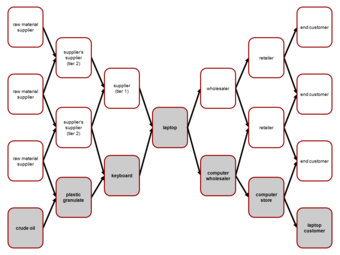
Supply Chain
A supply and demand network
Chapter 15: Product and Pricing Strategies
15.1: Pricing Methods
15.1.1: Cost-Based Pricing
Cost-based pricing involves calculating the cost of the product, and then adding a percentage mark-up to determine price.
Learning Objective
Analyze the use of cost-plus pricing as a pricing method
Key Points
- Cost based pricing is the easiest way to calculate what a product should be priced at. This appears in two forms: full cost pricing and direct-cost pricing. Full cost pricing takes into consideration both variable, fixed costs and a % markup. Direct-cost pricing is variable costs plus a % markup.
- Cost-plus pricing is a pricing method used by companies to maximize their profits. The firms accomplish their objective of profit maximization by increasing their production until marginal revenue equals marginal cost, and then charging a price which is determined by the demand curve.
- Cost-plus pricing is used primarily because it is easy to calculate and requires little information.
Key Terms
- rate of return
-
Rate of return (ROR), also known as return on investment (ROI), rate of profit or sometimes just return, is the ratio of money gained or lost (whether realized or unrealized) on an investment relative to the amount of money invested.
- markups
-
Markup is the difference between the cost of a good or service and its selling price. A markup is added on to the total cost incurred by the producer of a good or service in order to create a profit.
- variable cost
-
the amount of resources used that changes with the change in volume of activity of an organization
Examples
- Cost-plus pricing is the simplest pricing method used by companies. It is primarily used because it is easy to calculate, requires little information, and allows them to maximize their profits. They first calculate the cost of the product, and then add a percentage mark-up. This approach sets prices that cover the cost of production and provide enough profit-margin to the firm to earn its target rate of return. This method, although simple, has two flaws; it takes no account of demand and there is no way of determining if potential customers will purchase the product at the calculated price.
- Information on demand and costs is not easily available, and managers have limited knowledge as far as demand and costs are concerned. This additional information is necessary to generate accurate estimates of marginal costs and revenues. However, the process of obtaining this additional information is expensive. Therefore, cost-plus pricing is often considered the most rational approach in maximizing profits because it relies on arbitrary costs and arbitrary markups.
Cost-plus pricing is the simplest pricing method. A firm calculates the cost of producing the product and adds on a percentage (profit) to that price to give the selling price. This appears in two forms: the first, full cost pricing, takes into consideration both variable and fixed costs and adds a % markup. The other is direct cost pricing, which is variable costs plus a % markup. The latter is only used in periods of high competition as this method usually leads to a loss in the long run.This method, although simple, does not take demand into account, and there is no way of determining if potential customers will purchase the product at the calculated price.
Cost-plus pricing is a method used by companies to maximize their profits. There are several varieties, but the common thread is that one first calculates the cost of the product, then adds a proportion of it as markup. Basically, this approach sets prices that cover the cost of production and provide enough profit margin to the firm to earn its target rate of return. It is a way for companies to calculate how much profit they will make.
Cost-plus pricing is used primarily because it is easy to calculate and requires little information, therefore it is useful when information on demand and costs is not easily available. This additional information is necessary to generate accurate estimates of marginal costs and revenues. However, the process of obtaining this additional information is expensive. Therefore, cost-plus pricing is often considered the most rational approach in maximizing profits. This approach relies on arbitrary costs and arbitrary markups.

Cost-based Pricing
Cost-based pricing model
15.1.2: Demand-Based Pricing
Demand-based pricing uses consumer demand (and therefore perceived value) to set a price of a good or service.
Learning Objective
Compare various methods of price-setting
Key Points
- Demand-based pricing uses consumer demand (and therefore perceived value) to set a price of a good or service.
- Methods of demand-based pricing can include price skimming, price discrimination and yield management, price points, psychological pricing, bundle pricing, penetration pricing, price lining, value-based pricing, geo and premium pricing.
- Pricing factors include manufacturing cost, market location, competition, market condition, and the quality of the product.
Key Terms
- yield management
-
The method of analyzing information to forecast market conditions and implications for the firm
- Price skimming
-
Price skimming is a pricing strategy in which a marketer sets a relatively high price for a product or service at first, then lowers the price over time. It is a temporal version of price discrimination/yield management.
Examples
- Price skimming is a pricing strategy where initially a product price is set very high, but lowered over time. By using this pricing method, the firm can recover its sunk costs quickly (before competition lowers the market price). Price skimming is sometimes referred to as “riding down the demand curve.” By using this strategy, a company is able to capture consumer surplus. If done successfully, then in theory no customer will pay less for the product than the maximum they are willing to pay. In practice, it is almost impossible for a firm to capture the entire consumer surplus.
- Value based pricing (aka value optimized pricing) sets prices primarily on the perceived or estimated value to the customer (rather than on the cost of the product, the market price, competitors’ prices, or historical prices). The goal of value-based pricing is to align the price with the value of the product. Value-based pricing is based on the idea that a customer receiving high levels of value will pay a higher price compared to a customer receiving lower levels of value for the same product/service.
- Yield management is the process of understanding, anticipating and influencing consumer behavior. The purpose of it is to maximize profits from a fixed, perishable resource. Examples include airline seats or hotel rooms. This process involves strategic control of inventory in order to sell items to the correct customer at the correct time. Yield management can result in price discrimination. Yield management is a large revenue generator for several major industries (including airlines and hotels). The former Chairman and CEO of American Airlines, Robert Crandall, named this process “Yield Management” and said that it was “the single most important technical development in transportation management since we entered deregulation. “
- Psychological pricing (aka price ending) is a marketing practice based on the idea that certain price have a psychological impact. For example, items are typically priced at a point a little less than a round number ($2.99). The theory is that this causes demand to be greater than it would be if consumers were perfectly rational. In other words, because they see the 2 at the front of the price, they ignore that it is only 1 penny away from $3.
- Product bundling is a very common marketing strategy which involves offering several products for sale as a combined unit. It is common in the software business (Microsoft Office package), cable TV (basic cable, internet, phone), and food as well (burger, fries and a soda).
- When a company sets an initially low entry price (lower than the eventual market equilibrium price) to attract customers, they are engaging in penetration pricing. This strategy operates under the expectation that customers will switch to the new item because of its low price. Penetration pricing is used when the marketing objective is to increase market share/sales volume. It is not used to make short-term profit.
- Value based pricing (aka value optimized pricing) sets prices primarily on the perceived or estimated value to the customer (rather than on the cost of the product, the market price, competitors’ prices, or historical prices). The goal of value-based pricing is to align the price with the value of the product. Value-based pricing is based on the idea that a customer receiving high levels of value will pay a higher price compared to a customer receiving lower levels of value for the same product/service.
Demand-based pricing is any pricing method that uses consumer demand, based on perceived value, as the central element. These include: price skimming, price discrimination and yield management, price points, psychological pricing, bundle pricing, penetration pricing, price lining, value-based pricing, geo and premium pricing. Pricing factors are manufacturing cost, market place, competition, market condition, and quality of product.
Price skimming is a pricing strategy in which a marketer sets a relatively high price for a product or service at first, then lowers the price over time. It is a temporal version of price discrimination/yield management. It allows the firm to recover its sunk costs quickly before competition steps in and lowers the market price. Price skimming is sometimes referred to as riding down the demand curve. The objective of a price skimming strategy is to capture the consumer surplus. If this is done successfully, then theoretically no customer will pay less for the product than the maximum they are willing to pay. In practice, it is almost impossible for a firm to capture all of this surplus.
Price discrimination or price differentiation exists when sales of identical goods or services are transacted at different prices from the same provider.
Yield management is the process of understanding, anticipating and influencing consumer behavior in order to maximize yield or profits from a fixed, perishable resource, such as airline seats or hotel room reservations. As a specific, inventory-focused means of revenue management, yield management involves strategic control of inventory to sell it to the right customer at the right time for the right price. This process can result in price discrimination, where a firm charges customers consuming otherwise identical goods or services a different price for doing so. Yield management is a large revenue generator for several major industries; Robert Crandall, former Chairman and CEO of American Airlines, gave yield management its name and has called it “the single most important technical development in transportation management since we entered deregulation. “
Price points are prices at which demand for a given product is supposed to stay relatively high .

Demand-based Pricing
Illustration of price points, or concave-downward cusps on a demand curve (P is price; Q is quantity demanded; A, B, and C are the price points)
Psychological pricing or price ending is a marketing practice based on the theory that certain prices have a psychological impact. The retail prices are often expressed as “odd prices”: a little less than a round number, e.g. $19.99 or £2.98. The theory is this drives demand greater than would be expected if consumers were perfectly rational. Psychological pricing is one cause of price points.
Product bundling is a marketing strategy that involves offering several products for sale as one combined product. This strategy is very common in the software business (e.g., bundle a word processor, a spreadsheet, and a database into a single office suite), in the cable television industry (e.g., basic cable in the United States generally offers many channels at one price), and in the fast food industry in which multiple items are combined into a complete meal. A bundle of products is sometimes referred to as a package deal or a compilation or an anthology.
Penetration pricing is the pricing technique of setting a relatively low initial entry price, often lower than the eventual market price, to attract new customers. The strategy works on the expectation that customers will switch to the new brand because of the lower price. Penetration pricing is most commonly associated with a marketing objective of increasing market share or sales volume, rather than to make profit in the short term.
Value-based pricing, or value-optimized pricing is a business strategy. It sets prices primarily, but not exclusively, on the value, perceived or estimated, to the customer rather than on the cost of the product, the market price, competitors’ prices, or historical prices. The goal of value-based pricing is to align a price with the value delivered. It is based on the notion that a customer receiving high levels of value will pay a higher price than a customer receiving lower levels of value for the same product or service.
Geo (also called marketing geography or geomarketing) is a discipline within marketing analysis which uses geolocation (geographic information) in the process of planning and implementation of marketing activities. It can be used in any aspect of the marketing mix: the product, price, promotion, or place (geo targeting).
15.1.3: Competition-Based Pricing
Competitive-based pricing occurs when a company sets a price for its good based on what competitors are selling a similar product for.
Learning Objective
Explain the competitive-based pricing model
Key Points
- If competitors are pricing their products at a lower price, then it’s up to the company to either price their goods at a higher or lower price, all depending on what they want to achieve.
- One advantage of competitive-based pricing is that it avoids price competition that can damage the company.
- Potential disadvantages include that businesses may need to engage in other tactics to engage customers (if the price is not enough of an incentive).
- Another concern for companies is that this pricing method may barely cover production costs, resulting in low profits.
- Another concern for companies is that this pricing method may only cover production costs, resulting in low profits.
Key Term
- competitive-based pricing
-
Competitive-based pricing occurs when a company sets a price for its good based on what competitors are selling a similar product for.
Example
- Walmart is selling a face wash for $3.99. NuMart, who is looking to sell this product in the same area, also prices their product at $3.99 in order to capture market share. They will not receive higher profits per unit than Walmart with this pricing strategy, and will have to engage in marketing tactics to engage customers, since the price itself is not an incentive.
In economics, competition is the rivalry among sellers trying to achieve such goals as increasing profits, market share, and sales volume by varying the elements of the marketing mix: price, product, distribution, and promotion. Merriam-Webster defines competition in business as “the effort of two or more parties acting independently to secure the business of a third party by offering the most favorable terms. ” It was described by Adam Smith in The Wealth of Nations (1776) and later economists as allocating productive resources to their most highly-valued uses and encouraging efficiency. Smith and other classical economists before Cournot were referring to price and non-price rivalry among producers to sell their goods on best terms by the bidding of buyers, and not necessarily to a large number of sellers or to a market in final equilibrium.
Competitive-based pricing, or market-oriented pricing, involves setting a price based upon analysis and research compiled from the target market . With competition pricing, a firm will base what they charge on what other firms are charging. This means that marketers will set prices depending on the results from their research. For instance, if the competitors are pricing their products at a lower price, then it’s up to them to either price their goods at a higher or lower price, all depending on what the company wants to achieve.
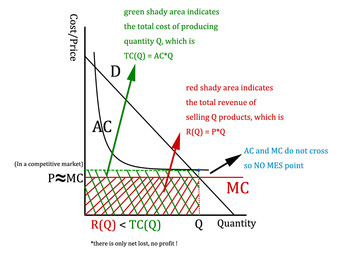
Competitive Market Pricing
Status-quo pricing, also known as competition pricing, involves maintaining existing prices or basing prices on what other firms are charging.
One advantage of competitive-based pricing is that it avoids price competition that can damage the company. Disadvantages include that businesses have to attract customers in other ways, since the price will not grab the customer’s interest. The price may also barely cover production costs, resulting in low profits.
15.1.4: Break-Even Analysis
The break-even point (BEP) is the point where expenses and revenue intersect.
Learning Objective
Explain the break-even point (BEP)
Key Points
- At this point there is no loss or gain to the company. On a graph, it appears as the point where the cost and revenue curves intersect.
- In an instance when costs are linear, the break-even point is equal to the fixed costs divided by the contribution margin per unit.
- The break-even point is one of the simplest yet least used analytical tools in management. It helps to provide a dynamic view of the relationships between sales, costs and profits.
Key Terms
- price
-
The price is the amount a customer pays for the product.
- expense
-
A spending or consuming. Often specifically an act of disbursing or spending funds.
Example
- If a business sells less than 200 units each month, it will record a loss. In the event it sells more, it will show a profit. Based off of this information, the business owners will need to determine if they can make and sell at least 200 tables a month. If they are not able to currently, adjusting other variables may help them reach this goal. For instance, reducing fixed costs (finding a building with cheaper rent), reducing variable costs (finding a cheaper supplier for table-making goods), and/or increasing the price of their tables. By performing any of these actions, the break-even point would be reduced, meaning that the owners do not need to sell as many tables in order to pay off fixed costs.
In Business Economics, specifically cost accounting, the break-even point (BEP) is the point at which cost (or expenses) and revenue are equal—there is no net loss or gain, i.e., one can “break even. ” No profit is achieved nor loss incurred, although opportunity costs are reconciled, and capital receives the risk-adjusted, expected return. Shown graphically, it is seen at the point where the total revenue and total cost curves meet. In the linear model, the break-even point is equal to the fixed costs divided by the contribution margin per unit .

Break-Even Analysis
This graphs depicts an example of a break-even point based on sales and total costs.
Example: Suppose that if a business sells fewer than 200 tables each month it will incur a loss, and if it sells more it will turn a profit. Given this scenario, the company’s business managers will need to compile information to determine if they can reasonably manufacture and sell 200 tables per month.
If they think they cannot sell that many, to ensure continued viability they might:
- Try reducing their fixed costs (e.g., by renegotiating rent, or by better controlling utility telephone bills or other costs)
- Try reducing their variable costs (the price paid for the tables by finding a new supplier)
- Consider increasing the selling price of their tables
Any of these would reduce the break-even point, meaning the business would not need to sell so many tables to ensure it could pay its fixed costs.
By inserting different prices into the formula, you will obtain a number of break-even points, one for each possible price point. If in the above example the firm changes the selling price for its product, say from $2 to $2.30, then it would have to sell only 589 units (1000/(2.3 – 0.6) = 589) to break even rather than 715.
Graphing these results can make them more clear. To do this, draw the total cost curve (TC in the diagram), showing total cost associated with each possible level of output; the fixed cost curve (FC), showing costs that do not vary with output level; and finally, the various total revenue lines (R1, R2, and R3), showing the total amount of revenue received at each output level given the chosen price point.
The break-even point is one of the simplest yet least used analytical tools in management. It helps provide a dynamic view of the relationships between sales, costs and profits. For an even clearer understanding, break-even sales can be expressed as a percentage of actual sales. By linking the percent to a point (during the week or month) that the percent of sales might occur, managers can glean when they might expect to break even.
15.2: Pricing Objectives
15.2.1: Profit Optimization
Firms utilize strategies such as price and promotional reduction to minimize cost, maximize revenue, and thereby optimize profits.
Learning Objective
Explain managerial methods of profit optimization
Key Points
- Firms can employ a number of methods to optimize profit including employing yield management and revenue optimization strategies.
- Yield optimization is the practice of using models to analyze data and information to forecast the best quantity of output a firm should produce to meet the total demand, thereby optimizing revenue.
- Optimization attempts to take information on a firm’s operating constraints, market demand, and factors influencing these to find the optimal selling prices and optimal production quantities for a firm’s goods.
- Revenue optimization is the mathematical process of finding the highest possible revenue a firm can make, using quadratic equations.
Key Terms
- Revenue optimization
-
A method of finding the best possible combination of output and price level to give the most possible revenue.
- revenue
-
the total income received from a given source
- yield management
-
The analysis of qualitative and quantitative information on factors driving demand for a good in order to forecast the most profitable production decisions for a firm.
Example
- Hypothetically, a lemonade stand may engage in yield management. Reviewing historical sales records in the neighborhood, looking up the weather forecasts, noting the hours of highest traffic in the area and other factors that may affect sales can help determine how many ingredients to purchase and how much lemonade to make.
Traditional profit optimization includes methods for reduction of pricing, promotional, and markdown losses.
Yield management can help firms optimize profits. Firms that engage in yield management usually do so via computer yield management systems, and periodically review transactions for goods or services already supplied as well as those being supplied in the future. They may also review information (including statistics) about events (known future events such as holidays, or unexpected past events such as terrorist attacks), competitive information (including prices), seasonal patterns, and other pertinent factors affecting sales. The models use market segment and price point to forecast total demand for all products or services they provide. Since total demand normally exceeds what the particular firm can produce in that period, the models attempt to optimize the firm’s outputs to maximize revenue. This optimization seeks to address key questions, such as: “Given our operating constraints, what is the best mix of products and/or services for us to produce and sell in the period; and at what prices do we sell those products and/or services to generate the highest expected revenue? ” Optimization can help the firm adjust prices and allocate capacity among market segments to maximize expected revenues. This can be done at different levels:
- By goods (such as a seat on a flight or a seat at an opera production)
- By group of goods (such as the entire opera house or all seats on a flight)
- By market (such as sales from Seattle and Minneapolis for a flight via Seattle-Minneapolis-Boston)
- Overall (such as on all routes of an airline, or on all seats during an opera production season)
Revenue optimization is a method of determining ‘optimal’ profits or expenditures, and can be related to quadratics, as the vertex of a parabola can illustrate the point where the ‘maximum’ revenue can be attained. Revenue optimization requires finding the x-intercepts and vertex, which can be done utilizing the quadratic formula (x-intercepts), and completing the square (vertex/ maximum). By finding these, one can then determine the highest or lowest cost and where the costs and quantities must lie in accordance to the vertex. This method is effective for maximizing profits for companies and families, as it can ensure the highest profit for sales and the lowest amounts for expenditures.
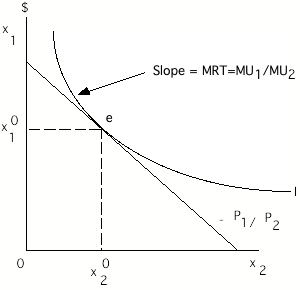
Optimization
Optimization point at x1, x2.
15.2.2: Return on Investment
Return on investment (ROI) is one way of considering profits in relation to capital invested.
Learning Objective
Explain the effect of marketing on return on investment (ROI)
Key Points
- Marketing not only influences net profits but also can affect investment levels, too. New plants and equipment, inventories, and accounts receivable are three of the main categories of investments that can be affected by marketing decisions.
- The purpose of the “return on investment” metric is to measure per-period rates of return on dollars invested in an economic entity.
- Return on investment (%) = Net profit ($) / Investment ($) × 100; or: Return on investment = (gain from investment – cost of investment) / cost of investment.
- Interest on a second (or refinanced) loan may increase, and loan fees may be charged, both of which can reduce the ROI when the new numbers are used in the ROI equation.
Key Terms
- profits
-
Collective form of profit.
- return on investment
-
One way of considering profits in relation to capital invested.
Example
- Suppose a lemonade stand wanted to use a yield management method. They could look at historical pricing and sales performance of past lemonade stands in the neighborhood, and traffic patterns in the area. At what time of day are more people (possible customers) outside? And what about the weather (does lemonade sell better in sunny or rainy weather)? All this information can give the lemonade entrepreneurs a better idea of how much to make and how much to charge.
Return on Investment
Return on investment (ROI) is one way of considering profits in relation to capital invested. Return on assets (ROA), return on net assets (RONA), return on capital (ROC) and return on invested capital (ROIC) are similar measures with variations on how ‘investment’ is defined .

Assets
Return on assets (ROA), return on net assets (RONA), return on capital (ROC) and return on invested capital (ROIC) are similar measures with variations on how ‘investment’ is defined.
Marketing not only influences net profits but also can affect investment levels too. New plants and equipment, inventories, and accounts receivable are three of the main categories of investments that can be affected by marketing decisions.
In a survey of nearly 200 senior marketing managers, 77 percent responded that they found the “return on investment” metric very useful.
Purpose
The purpose of the “return on investment” metric is to measure per-period rates of return on dollars invested in an economic entity. ROI and related metrics (ROA, ROC, RONA and ROIC) provide a snapshot of profitability adjusted for the size of the investment assets tied up in the enterprise. Marketing decisions have obvious potential connection to the numerator of ROI (profits), but these same decisions often influence asset usage and capital requirements (for example, receivables and inventories). Marketers should understand the position of their company and the returns expected. ROI is often compared to expected (or required) rates of return on dollars invested.
Construction
For a single-period review, just divide the return (net profit) by the resources that were committed (investment):
Return on investment (%) = Net profit ($) / Investment ($) × 100
or
Return on investment = (gain from investment – cost of investment) / cost of investment
Problems in Calculating ROI
Complications in calculating ROI can occur when a real estate property is refinanced, or a second mortgage is taken out. For example, interest on a second (or refinanced) loan may increase or loan fees may be charged. Both of these factors can reduce the ROI when the new numbers are used in the ROI equation. There may also be an increase in maintenance costs and property taxes, or an increase in utility rates if the owner of a residential rental or commercial property pays these expenses.
Complex calculations may also be required for property bought with an adjustable rate mortgage (ARM) with a variable escalating rate charged annually through the duration of the loan. (To know more about ARM, check out: Mortgages: Fixed-Rate Versus Adjustable-Rate. )
15.2.3: Market Share
Market share is an indicator of how well a firm is doing against its competitors and can often be influenced through pricing.
Learning Objective
Explain the importance of market share
Key Points
- Market share, usually measured as a percentage of a market’s total revenue captured by a single entity, is a key indicator of market competitiveness.
- Managers can use market share data to evaluate a firm’s overall performance, market demand, market growth, and customer preference trends.
- Market share is measured by looking at a firm’s sales revenue as a percentage of the total market revenue.
Key Term
- Market Share
-
The percentage amount of a market captured by a single firm
Example
- For a very basic example, let’s look at the market for baubles. Suppose there are 1000 total baubles sold in the U.S. per year for $1 each. If company A sold 600 of those baubles, they have 60% of the market share.
Market share is the percentage of a market (defined in terms of either units or revenue) accounted for by a specific entity.
Market share is a key indicator of market competitiveness—that is, how well a firm is doing in terms of its competition. This metric, supplemented by changes in sales revenue, helps managers evaluate both primary and selective demand in their market. It enables them to judge not only total market growth or decline, but also trends in customers’ selections among competitors. Generally, sales growth resulting from primary demand (total market growth) is less costly and more profitable than that achieved by capturing share from competitors. Conversely, losses in market share can signal serious long-term problems that require strategic adjustments. Firms with market shares below a certain level may not be viable. Similarly, within a firm’s product line, market share trends for individual products are considered early indicators of future opportunities or problems.
Increasing market share is one of the most important objectives of business. The main advantage of using market share as a measure of business performance is that it is less dependent upon macroenvironmental variables, such as the state of the economy or changes in tax policy. However, increasing market share may be dangerous for makers of fungible hazardous products, particularly products sold into the United States market, where they may be subject to market share liability.
Although market share is likely the single most important marketing metric, there is no generally acknowledged best method for calculating it. This is unfortunate as different methods may yield not only different computations of market share at a given moment but also widely divergent trends over time. The reasons for these disparities include variations in the lenses through which share is viewed (units versus dollars), where in the channel the measurements are taken (shipments from manufacturers versus consumer purchases), market definition (scope of the competitive universe), and measurement error.

Market Share
Mobile phone market share in Q3 2008
15.2.4: Demanding a Premium
Firms can engage in premium pricing by keeping the price of their good artificially higher than the benchmark price.
Learning Objective
Explain why business owners sometimes price at a premium
Key Points
- Premium pricing is used to maximize profit in areas where customers are happy to pay more, where there are no substitutes for the product, where there are barriers to entering the market, or when the seller cannot save on costs by producing at a high volume.
- More expensive items are perceived to be of better quality or have a better reputation by virtue of their price.
- Luxury has a psychological association with price premium pricing.
Key Terms
- prestige
-
The quality of how good the reputation of something or someone is.
- Price premium
-
The percentage by which a product’s selling price exceeds a benchmark price.
Example
- Brands like Pepsi or Coke can price their goods at a premium, charging more than a generic soda brand due to its brand name.
Pricing strategies for products or services encompass three main ways to improve profits. The business owner can cut costs or sell more, or find more profit with a better pricing strategy. When costs are already at their lowest and sales are hard to find, adopting a better pricing strategy is a key option to stay viable.
Premium Pricing
Premium pricing is the practice of keeping the price of a product or service artificially high in order to encourage favorable perceptions among buyers, based solely on the price. The practice is intended to exploit the (not necessarily justifiable) tendency for buyers to assume that expensive items enjoy an exceptional reputation or represent exceptional quality and distinction . A premium pricing strategy involves setting the price of a product higher than similar products . This strategy is sometimes also called skim pricing because it is an attempt to “skim the cream” off the top of the market. It is used to maximize profit in areas where customers are happy to pay more, where there are no substitutes for the product, where there are barriers to entering the market, or when the seller cannot save on costs by producing at a high volume. It is also called image pricing or prestige pricing.

Premium-Priced Good
Gold mined from different sources demand different premiums.

Mercedes Benz SLR McLaren
Mercedes Benz executes a premium pricing strategy.
Luxury has a psychological association with price premium pricing. The implication for marketing is that consumers are willing to pay more for certain goods and not for others. To the marketer, it means creating a brand equity or value for which the consumer is willing to pay extra. Marketers view luxury as the main factor differentiating a brand in a product category.
15.2.5: Status-Quo Pricing of Existing Products
Status quo pricing is the practice of maintaining current price levels that other firms are charging.
Learning Objective
Compare Nagle and Holden’s nine laws of price sensitivity with status-quo pricing
Key Points
- Pricing strategies for products or services encompass three main ways to improve profits. These are that the business owner can cut costs or sell more, or find more profit with a better pricing strategy.
- Merely raising prices is not always the answer, especially in a poor economy. One strategy does not fit all, so adopting a pricing strategy is a learning curve when studying the needs and behaviors of customers and clients.
- Status-quo pricing advantages: Avoids price competition that can damage the company. Disadvantages: Because the price may not grab the customer’s interest, businesses may have to attract customers in other ways. Also, these prices may barely cover production costs, resulting in low profits.
Key Term
- status-quo pricing
-
The practice of pricing goods such that the current market price level is maintained.
Pricing strategies for products or services encompass three main methods of improving profits: the business owner can cut costs, sell more, or implement a better pricing strategy. When costs are already at their lowest and increasing sales becomes difficult, adopting a better pricing strategy may be a key option for staying viable.
However, merely raising prices is not always the best solution, particularly in poorer economies. Many businesses fold because as a result of pricing themselves out of the marketplace. On the other hand, many business and sales staff leave “money on the table”. One strategy does not fit all, so adopting a pricing strategy is a learning curve—studying the needs and behaviors of customers and clients is essential.
Nine Laws of Price Sensitivity and Consumer Psychology
In their book The Strategy and Tactics of Pricing, Thomas Nagle and Reed Holden outline nine “laws”—factors they say influence how a consumer perceives a given price, and how price-sensitive they may be with respect to different purchase decisions.
- Reference Price Effect: Buyer’s price sensitivity for a given product increases the higher the product’s price relative to perceived alternatives. Perceived alternatives can vary by buyer segment, occasion, or other factors.
- Difficult Comparison Effect: Buyers are less sensitive to the price of a known or more reputable product when they have difficulty comparing it to potential alternatives.
- Switching Costs Effect: The higher the product-specific investment a buyer must make to switch suppliers, the less price sensitive that buyer is when choosing between alternatives.
- Price-Quality Effect: Buyers are less sensitive to price the more higher prices signal higher quality. Products for which this effect is particularly relevant include image products, exclusive products, and products with minimal cues for quality.
- Expenditure Effect: Buyers are more price sensitive when the expense accounts for a large percentage of buyers’ available income or budget.
- End-Benefit Effect: This effect refers to the relationship of a given purchase to a larger overall benefit, and is divided into two parts. The first, derived demand, referes to buying sensitivity relative to the price of the end benefit; the more sensitive they will be to the prices of those products that contribute to that benefit. The second, price proportion cost refers to the percent of the total cost of the end benefit accounted for by a given component that helps produce the end benefit (e.g., CPU and PCs). The smaller the given components share of the total cost of the end benefit, the less sensitive buyers will be to the component’s price.
- Shared-cost Effect: The smaller the portion of the purchase price buyers must pay for themselves, the less price sensitive they will be.
- Fairness Effect: Buyers are more sensitive to the price of a product when the price is outside the range they perceive as “fair” or “reasonable” given the purchase context.
- The Framing Effect: Buyers are more price sensitive when they perceive the price as a loss rather than a forgone gain, and they have greater price sensitivity when the price is paid separately rather than as part of a bundle.
Status-quo Pricing
Status-quo pricing, also known as competition pricing, involves maintaining existing prices (status quo) or basing prices on the prices of competitor firms .

Competitive Market Pricing
Status-quo pricing, also known as competition pricing, involves maintaining existing prices or basing prices on what other firms are charging.
Advantages: Avoids price competition that can damage the company.
Disadvantages: Because the price will not grab the customer’s interest, businesses must attract customers in other ways. Also, these prices may barley cover production costs, resulting in low profits.
15.3: Pricing Strategies
15.3.1: New Product
Penetration and skimming are two strategies employed in pricing new products.
Learning Objective
Compare penetration and skimming as two strategies for setting a price level
Key Points
- Penetration pricing in the introductory stage of a new product’s life cycle involves accepting a lower profit margin and pricing relatively low.
- Price skimming involves setting the price relatively high to generate a high profit margin.
- A premium product generally supports a skimming strategy.
Key Terms
- pull strategy
-
communication not demanded by the buyer
- Price skimming
-
This involves the top part of the demand curve. The price is set relatively high to generate a high profit margin, and sales are limited to those buyers willing to pay a premium to get the new product.
- Penetration pricing
-
The introductory stage of a new product’s life cycle means accepting a lower profit margin and to price relatively low. Such a strategy should generate greater sales and establish the new product in the market more quickly.
- push strategy
-
communication demanded by the buyer
With a totally new product, competition does not exist or is minimal. What price level should be set in such cases? Two general strategies are most common: penetration and skimming. Penetration pricing in the introductory stage of a new product’s life cycle involves accepting a lower profit margin and pricing relatively low. Such a strategy should generate greater sales and establish the new product in the market more quickly. Price skimming involves the top part of the demand curve. Price is set relatively high to generate a high profit margin, and sales are limited to those buyers willing to pay a premium to get the new product.

Price Skimming
Video game systems, such as the Sony PS3, usually employ the classic new product pricing strategy, known as skimming.
Which strategy is best depends on a number of factors. A penetration strategy would generally be supported by the following conditions: price-sensitive consumers, opportunity to keep costs low, the anticipation of quick market entry by competitors, a high likelihood for rapid acceptance by potential buyers, and an adequate resource base for the firm to meet the new demand and sales. A skimming strategy is most appropriate when the opposite conditions exist. A premium product generally supports a skimming strategy. In this case, “premium” doesn’t just denote high cost of production and materials, it also suggests that the product may be rare or that the demand is unusually high. An example would be a $500 ticket for the World Series or an $80,000 price tag for a limited-production sports car. Having legal protection via a patent or copyright may also allow for an excessively high price. Intel and their Pentium chip possessed this advantage for a long period of time. In most cases, the initial high price is gradually reduced to match new competition and allow new customers access to the product.
15.3.2: Differential
Differential pricing exists when sales of identical goods or services are transacted at different prices from the same provider.
Learning Objective
Analyze the situations in which price differentiation works
Key Points
- Product heterogeneity, market frictions, or high fixed costs (which make marginal-cost pricing unsustainable in the long run) can allow for differential pricing to different consumers, even in fully competitive retail or industrial markets.
- Price differentiation requires market segmentation and some means to discourage discount customers from becoming resellers and, by extension, competitors.
- There are two conditions that must be met if a price differentiation scheme is to work. First, the firm must be able to identify market segments by their price elasticity of demand. Second, the firm must be able to enforce the scheme.
Key Term
- arbitrage
-
Any market activity in which a commodity is bought and then sold quickly, for a profit which substantially exceeds the transaction cost
Price differentiation, or price discrimination, exists when sales of identical goods or services are transacted at different prices from the same provider. In a theoretical market with perfect information, perfect substitutes, and no transaction costs or prohibition on secondary exchange (re-selling) to prevent arbitrage, price differentials can only be a feature of monopolistic and oligopolistic markets, where market power can be exercised. However, product heterogeneity, market frictions, or high fixed costs (which make marginal-cost pricing unsustainable in the long run) can allow for some degree of differential pricing to different consumers, even in fully competitive retail or industrial markets.
Price differentiation requires market segmentation and some means to discourage discount customers from becoming resellers and, by extension, competitors. This usually entails using one or more means of preventing any resale: keeping the different price groups separate, making price comparisons difficult, or restricting pricing information. The boundary set up by the marketer to keep segments separate is referred to as a rate fence. Price differentiation is thus very common in services where resale is not possible, such as airlines and movie theaters.
Price differentiation can also be seen where the requirement that goods be identical is relaxed. For example, so-called “premium products” (including relatively simple products, such as cappuccino compared to regular coffee with cream) have a price differential that is not explained by the cost of production. Some economists have argued that this is a form of price discrimination exercised by providing a means for consumers to reveal their willingness to pay.
There are two conditions that must be met if a price differentiation scheme is to work. First, the firm must be able to identify market segments by their price elasticity of demand. Second, the firm must be able to enforce the scheme. For example, airlines routinely engage in price differentiation by charging high prices for customers with relatively inelastic demand (business travelers) and discount prices for tourists who have relatively elastic demand . The airlines enforce the scheme by making the tickets non-transferable, thus preventing a tourist from buying a ticket at a discounted price and selling it to a business traveler (arbitrage). Airlines must also prevent business travelers from directly buying discount tickets. Airlines accomplish this by imposing advance ticketing requirements or minimum stay conditions that would be difficult for the average business traveler to meet.

Price Differentiation
The airline industry implements price differentiation schemes.
15.3.3: Psychological Pricing
Psychological pricing or price ending is a marketing practice based on the theory that certain prices have a psychological impact.
Learning Objective
Apply the discipline of psychology to pricing
Key Points
- Psychology is an academic and applied discipline that involves the scientific study of mental functions and behaviors.
- While psychological knowledge is often applied to the assessment and treatment of mental health problems, it is also directed towards understanding and solving problems in many different spheres of human activity.
- Psychological pricing can be used to increase the perceived value of a product as well.
Key Term
- psychological pricing
-
Psychological pricing or price ending is a marketing practice based on the theory that certain prices have a psychological impact.
Psychological
Psychology is an academic and applied discipline that involves the scientific study of mental functions and behaviors. Psychology has the immediate goal of understanding individuals and groups by both establishing general principles and researching specific cases and, by many accounts, ultimately aims to benefit society. In this field, a professional practitioner or researcher is called a psychologist, and can be classified as a social, behavioral, or cognitive scientist. Psychologists attempt to understand the role of mental functions in individual and social behavior, while also exploring the physiological and neurobiological processes that underlie certain cognitive functions and behaviors.
While psychological knowledge is often applied to the assessment and treatment of mental health problems, it is also directed towards understanding and solving problems in many different spheres of human activity. The majority of psychologists are involved in some kind of therapeutic role, practicing in clinical, counseling, or school settings. Many do scientific research on a wide range of topics related to mental processes and behavior, and typically work in university psychology departments or teach in other academic settings (e.g., medical schools or hospitals). Some are employed in industrial and organizational settings, or in other areas such as human development and aging, sports, health, and the media, as well as in forensic investigation and other aspects of law.
Psychological pricing or price ending is a marketing practice based on the theory that certain prices have a psychological impact. The retail prices are often expressed as odd prices: a little less than a round number, such as $19.99 or £2.98. The theory is that this drives demand greater than would be expected if consumers were perfectly rational.
Psychological pricing can be used to the perceived value of a product up as well. By charging $350 for designer jeans, retailers are at times able to create more demand for the product than if they were priced at $19.99 for example.

Stop & Shop Price Cruncher
A British Stop & Shop ad from the 1994 holiday season, informing consumers what they would save on the purchase of each item.
15.3.4: Product Line
Product lining is the marketing strategy of offering several related products for sale as individual units.
Learning Objective
Explain the strategies of creating a product line
Key Points
- Line extensions strategies involve adding goods related to the initial product, whose purchase or use is keyed to the product.
- A line extension strategy should only be considered when the producer is certain that the capability exists to efficiently manufacture a product that compares well with the base product.
- Line-filling strategies occur when a void in the existing product line has not been filled or a new void has developed due to the activities of competitors or the request of consumers.
- Line-pruning strategies involve the process of getting rid of products that no longer contribute to company profits.
Key Terms
- product line
-
a series of several related goods or services for sale as individual units
- line vulnerability
-
the percentage of sales or profits that are derived from only a few products in the line.
- product mix
-
the number of different categories and lines of goods or services offered by a company
- line depth
-
the number of subcategories a product category has.
- line consistency
-
how closely related the products that make up the line are.
Product lining is the marketing strategy of offering several related products for sale as individual units. A product line can comprise related products of various sizes, types, colors, qualities, or prices. Line depth refers to the number of subcategories a category has. Line consistency refers to how closely related the products that make up the line are. Line vulnerability refers to the percentage of sales or profits that are derived from only a few products in the line. The number of different categories of a company is referred to as width of product mix. The total number of products sold in all lines is referred to as length of product mix. If a line of products is sold with the same brand name, this is referred to as family branding.

Walmart Exterior
Large companies, such as Walmart, often have product lines that cover a wide variety of similar or related needs.
Variables to Consider When Selecting a Product Line Strategy
There are two basic strategies for dealing with whether the company will attempt to carry every conceivable product needed and wanted by the consumer or whether they will carry selected items. The first is a full-line strategy while the second is called a limited line strategy. Few full-line manufacturers attempt to provide items for every conceivable market niche. And few limited-line manufacturers would refuse to add an item if the demand were great enough. Each strategy has its advantages and disadvantages.
Line extensions strategies involve adding goods related to the initial product, whose purchase or use is keyed to the product. For example, a computer company may provide an extensive selection of software to be used with its primary hardware. This strategy not only increases sales volume, it also strengthens the manufacturer’s name association with the owner of the basic equipment and offers dealers a broader line. These added items tend to be similar to existing brands with no innovations. They also have certain risks. Often the company may not have a high level of expertise with either producing or marketing these related products. Excessive costs, inferior products, and the loss of goodwill with distributors and customers are all possible deleterious outcomes.
There is also a strong possibility that such a product decision could create conflict within the channel of distribution. In the computer example just described, this company may have entered the software business over the strong objection of their long-term supplier of software. If their venture into the software business fails, re-establishing a positive relationship with this supplier could be quite difficult. A line extension strategy should only be considered when the producer is certain that the capability exists to efficiently manufacture a product that compares well with the base product. The producer should also be sure of profitable competition in this new market.
Line-filling strategies occur when a void in the existing product line has not been filled or a new void has developed due to the activities of competitors or the request of consumers. Before considering such a strategy, several key questions should be answered:
- Can the new product support itself?
- Will it cannibalize existing products?
- Will existing outlets be willing to stock it?
- Will competitors fill the gap if we don’t?
- What will happen if we don’t act?
Assuming a firm decides to fill out its product line further, there are several ways of implementing this decision.
Ways to Implement the Filling Out of a Product Line
- Product proliferation: The introduction of new varieties of the initial product or products that are similar.
- Brand extension: Strong brand preference allows the company to introduce the related product under the brand umbrella.
- Private branding: Producing and distributing a related product under the brand of a distributor or other producers.
In addition to the demand of consumers or pressures from competitors, there are other legitimate reasons to engage in these tactics. First, the additional products may have a greater appeal and serve a greater customer base than did the original product. Second, the additional product or brand can create excitement both for the manufacturer and distributor. Third, shelf space taken by the new product means it cannot be used by competitors. Finally, the danger of the original product becoming outmoded is hedged.
Yet, there is serious risk that must be considered as well. Unless there are markets for the proliferations that will expand the brand’s share, the newer forms will cannibalize the original product and depress profits. Line-pruning strategies involve the process of getting rid of products that no longer contribute to company profits. A simple fact of marketing is that sooner or later a product will decline in demand and require pruning.
15.3.5: Promotions
Promotional pricing means temporarily reducing the price of an established product in order to increase interest in customers.
Learning Objective
Explain why and how marketers use promotion
Key Points
- Promotion is one of the market mix elements, and a term used frequently in marketing.
- Fundamentally, however, there are three basic objectives of promotion: to present information to consumers as well as others, to increase demand, and to differentiate a product.
- Promotional pricing often involves reducing prices to unsustainably low levels. In some cases, products and services may be sold at or below cost.
Key Term
- Promotional pricing
-
The temporary reduction of the price of an established product in order to increase interest in customers.
Promotion is one of the market mix elements, and a term used frequently in marketing. Fundamentally, there are three basic objectives of promotion:
- To present information to consumers as well as others.
- To increase demand.
- To differentiate a product.
There are different ways to promote a product in different areas of media. Promoters use internet advertisement, special events, endorsements, and newspapers to advertise their product. Many times with the purchase of a product there is an incentive like discounts, free items, or a contest. This is to increase the sales of a given product.
Promotional Pricing
Promotional pricing means temporarily reducing the price of an established product in order to increase interest in customers. This is sometimes done because the sales of the product are falling and the firm wants to renew customer’s interest in it. Or perhaps the product has gone out of fashion, and the firm wants to clear their stock (e.g., sales on last season’s clothes).
Promotional pricing often involves reducing prices to unsustainably low levels. In some cases, products and services may be sold at or below cost. A buy-one-get-one-free scheme may even be used. When this is done, interest in goods can be greatly increased, meaning sales are also likely to increase dramatically.
This technique may be used by retailers or producers alike. When it is used by retailers, the goal is generally to attract attention to the business and to attract regular customers. When the technique is used by producers, the goal is generally to attract customers to a product or brand and to encourage brand loyalty.

Quaker Oats man
A Quaker Oats promotion at a Publix grocery store.
15.4: Pricing Products
15.4.1: The Meaning of Price
Price is both the money someone charges for a good or service and what the consumer is willing to give up to receive a good or service.
Learning Objective
Differentiate between cost, customer’s view of price, and society’s view of price
Key Points
- When you ask about the cost of a good or service, you’re really asking how much you will have to give up in order to get it.
- For the business to increase value, it can either increase the perceived benefits or reduce the perceived costs. Both of these elements should be considered elements of price.
- Viewing price from the customer’s perspective helps define value — the most important basis for creating a competitive advantage.
- There are two different ways to look at the role price plays in a society; rational man and irrational man.
Key Term
- value
-
The degree of importance you give to something.
Examples
- Wedding photographers frequently charge thousands of dollars for a wedding, be it a large, opulent event, or a small scale affair. Unlike Louis Vuitton, most wedding photographers are individuals working from home, or small studios, and so charging a high price is not purely about protecting the brand, or about the cost of the equipment (although there is certainly a high initial cost to starting out). Rather, it is about the need that customers have to capture these memories. Because the customer feels there is value in having a good wedding photographer, they are willing to pay prices that are not related to the cost.
- Louis Vuitton is a designer of luxury goods such as handbags, luggage, watches, etc. The company has been criticised for burning unsold merchandise, rather than putting them back on the market at discounted prices. This action is defended by saying that it must be done in order to maintain the value of the brand – if discounted items enter the market place, the brand value would fall.
What does a Price Convey
Buying something means paying a price. But what exactly is “price? “
- Price is the money someone charges for a good or service. For example, an item of clothing will cost a certain amount of money. Or a computer specialist will charge a certain amount of money for fixing your computer.
- Price is also that which you, a consumer, has to give up in order to receive a product or service. Price does not necessarily always mean money. Bartering is when you exchange goods or services in return for goods or services. For example, I teach you English in exchange for you teaching me about graphic design. In that case, I give up my time and knowledge.
Even though the question, “How much? ” could be phrased as “How much does it cost? ” price and cost are two different things. Whereas the price of a product is what you, the consumer has to pay to obtain it, the cost is what the business pays to make it. When you ask about the cost of a good or service, you’re really asking how much will you have to give up to get it.
Different Perspectives on Price
The perception of price differs based on the perspective from which it is beign viewed.

Louis Vuitton
Louis Vuitton sells luxury designer goods such as these suitcases. If Louis Vuitton merchandise was offered at low prices it might significantly undermine the brand value, much of which is based upon exclusivity.
The Customer’s View
A customer can either be the ultimate user of the finished product or a business that purchases components of the finished product. It is the customer that seeks to satisfy a need or set of needs through the purchase of a particular product or set of products. Consequently, the customer uses several criteria to determine how much they are willing to expend, or the price they are willing to pay, in order to satisfy these needs. Ideally, the customer would like to pay as little as possible.
For the business to increase value, it can either increase the perceived benefits or reduce the perceived costs. Both of these elements should be considered elements of price.
To a certain extent, perceived benefits are the opposite of perceived costs. For example, playing a premium price is compensated for by having this exquisite work of art displayed in one’s home. Other possible perceived benefits directly related to the price-value equations are:
- Status
- Convenience
- The deal
- Brand
- Quality
- Choice
Many of these benefits tend to overlap. For instance, a Mercedes Benz E750 is a very high-status brand name and possesses superb quality. This makes it worth the USD 100,000 price tag. Further, if one can negotiate a deal reducing the price by USD 15,000, that would be his incentive to purchase. Likewise, someone living in an isolated mountain community is willing to pay substantially more for groceries at a local store than drive 78 miles (25.53 kilometers) to the nearest Safeway. That person is also willing to sacrifice choice for greater convenience.
Increasing these perceived benefits are represented by a recently coined term, value-added. Providing value-added elements to the product has become a popular strategic alternative.
Perceived costs include the actual dollar amount printed on the product, plus a host of additional factors. As noted, perceived costs are the mirror-opposite of the benefits. When finding a gas station that is selling its highest grade for USD 0.06 less per gallon, the customer must consider the 16 mile (25.75 kilometer) drive to get there, the long line, the fact that the middle grade is not available, and heavy traffic. Therefore, inconvenience, limited choice, and poor service are possible perceived costs. Other common perceived costs include risk of making a mistake, related costs, lost opportunity, and unexpected consequences.
Ultimately, it is beneficial to view price from the customer’s perspective because it helps define value — the most important basis for creating a competitive advantage.
Society’s View
Price, at least in dollars and cents, has been the historical view of value. Derived from a bartering system (exchanging goods of equal value), the monetary system of each society provides a more convient way to purchase goods and accumulate wealth. Price has also become a variable society employs to control its economic health. Price can be inclusive or exclusive. In many countries, such as Russia, China, and South Africa, high prices for products such as food, health care, housing, and automobiles, means that most of the population is excluded from purchase. In contrast, countries such as Denmark, Germany, and Great Britain charge little for health care and consequently make it available to all.
There are two different ways to look at the role price plays in a society; rational man and irrational man. The former is the primary assumption underlying economic theory, and suggests that the results of price manipulation are predictable. The latter role for price acknowledges that man’s response to price is sometimes unpredictable and pretesting price manipulation is a necessary task.
15.4.2: Impacts of Supply and Demand on Pricing
The supply and demand model states that the price of a good will be the level where the quantity demanded equals the quantity supplied.
Learning Objective
Apply the concept of supply and demand to price determination
Key Points
- In the supply and demand model of price determination, there is never a surplus or shortage of goods at the equilibrium level. The market always settles at the point where supply equals demand.
- If demand increases (decreases) and supply is unchanged, then it leads to a higher (lower) equilibrium price and quantity.
- If supply increases (decreases) and demand is unchanged, then it leads to a lower (higher) equilibrium price and higher (lower) quantity.
- If a price for a particular product goes up and the customer is aware of all relevant information, demand will be reduced for that product.
- Demand-oriented pricing focuses on the nature of the demand curve for the product or service being priced.
Key Terms
- Supply and demand model
-
An economic model of price determination in a market.
- demand-oriented pricing
-
A pricing model focused on the nature of the demand curve for the product or service being priced.
- demand curve
-
An economic model showing the quantity demanded at various price levels.
Example
- Suppose the equilibrium price of burgers is $10, and 200 widgets are eaten every day in a particular town. A sudden outbreak of mad cow disease leads to people not wanting to eat burgers at all–demand drops. Now, only 50 burgers are eaten per day. As a result of the fall in demand, price drops as well (while the actual quantities of demand and supply will depend on the shape of the demand and supply curves, for the sake of example, let’s say the price drops to $4).
Supply, Demand, and Pricing
Supply and demand is an economic model of price determination in a market. It concludes that in a competitive market, the unit price for a particular good will vary until it settles at a point where the quantity demanded by consumers (at current price) will equal the quantity supplied by producers (at current price), resulting in an economic equilibrium of price and quantity.
The four basic laws of supply and demand are:
- If demand increases and supply remains unchanged, then it leads to higher equilibrium price and higher quantity.
- If demand decreases and supply remains unchanged, then it leads to lower equilibrium price and lower quantity.
- If supply increases and demand remains unchanged, then it leads to lower equilibrium price and higher quantity.
- If supply decreases and demand remains unchanged, then it leads to higher equilibrium price and lower quantity.
Equilibrium is defined as the price-quantity pair where the quantity demanded is equal to the quantity supplied, represented by the intersection of the demand and supply curves. Market equilibrium is a situation in a market when the price is such that the quantity that consumers wish to demand is correctly balanced by the quantity that firms wish to supply.
Economics assumes that the consumer is a rational decision maker and has perfect information. Therefore, if a price for a particular product goes up and the customer is aware of all relevant information, demand will be reduced for that product. Should price decline, demand would increase. That is, the quantity demanded typically rises causing a downward sloping demand curve. A demand curve shows the quantity demanded at various price levels.

Price affected by supply and demand
The price P of a product is determined by a balance between production at each price (supply S) and the desires of those with purchasing power at each price (demand D). The diagram shows a positive shift in demand from D1 to D2, resulting in an increase in price (P) and quantity sold (Q) of the product.
As a seller changes the price requested to a lower level, the product or service may become an attractive use of financial resources to a larger number of buyers, thus, expanding the total market for the item. This total market demand by all buyers for a product type (not just for the company’s own brand name) is called “primary demand. ” Additionally, a lower price may cause buyers to shift purchases from competitors, assuming that the competitors do not meet the lower price. If primary demand does not expand and competitors meet the lower price, the result will be lower total revenue for all sellers.
Demand-oriented pricing focuses on the nature of the demand curve for the product or service being priced. The nature of the demand curve is influenced largely by the structure of the industry in which a firm competes. That is, if a firm operates in an industry that is extremely competitive, price may be used to some strategic advantage in acquiring and maintaining market share. On the other hand, if the firm operates in an environment with a few dominant players, the range in which price can vary may be minimal.
15.5: New Product Development
15.5.1: Innovation
Innovation is the creation of better, more effective products, processes, services, or technologies.
Learning Objective
Subdivide the innovation process in to sources, goals, failures, and diffusion
Key Points
- Innovation is defined in this context as the development of better products or services.
- In business and economics, innovation is the catalyst to growth. With rapid advancements in transportation and communications over the past few decades, the old-world concepts of factor endowments and comparative advantage, which focused on an area’s unique inputs, are outmoded for today’s economy.
- In the organizational context, innovation may be linked to positive changes in efficiency, productivity, quality, competitiveness, market share, and others. All organizations can innovate, including hospitals, universities, and local governments.
Key Term
- innovation
-
The creation of better or more effective products, processes, services, technologies, or ideas that are not readily available but will soon be.
Example
- Innovations in the method of iron production catalyzed the Industrial Revolution of the nineteenth century.
In business and economics, innovation is the catalyst to growth. With rapid advancements in transportation and communications over the past few decades, the old-world concepts of factor endowments and comparative advantage, which focused on an area’s unique inputs, are outmoded for today’s global economy.
Organizations
In the organizational context, innovation may be linked to positive changes in efficiency, productivity, quality, competitiveness, market share, and others. All organizations can innovate, including hospitals, universities, and local governments.
Sources of Innovation
The famous robotics engineer Joseph F. Engelberger asserts that innovations require only three things: (1) A recognized need; (2) competent people with relevant technology; (3) financial support.
The Kline Chain-linked model of innovation places emphasis on potential market needs as drivers of the innovation process, and describes the complex and often iterative feedback loops between marketing, design, manufacturing, and research and development (R&D). Innovation by businesses is achieved in many ways, with much attention now given to formal research and development for “breakthrough innovations. ” R&D helps spur on patents and other scientific innovations that lead to productive growth in such areas as industry, medicine, engineering, and government. Yet, innovations can be developed by less formal on-the-job modifications of practice, through exchange and combination of professional experience and by many other routes. The more radical and revolutionary innovations tend to emerge from R&D, while more incremental innovations may emerge from practice—but there are many exceptions to each of these trends. An important innovation factor includes customers buying products or using services. As a result, firms may incorporate users in focus groups (user-centered approach), work closely with so-called lead users (lead user approach) or users might adapt their products themselves.
Goals and Failures
Programs of organizational innovation are typically tightly linked to organizational goals and objectives, to the business plan, and to market competitive positioning. One driver for innovation programs in corporations is to achieve growth objectives. A survey across a large number of manufacturing and services organizations found that systematic programs of organizational innovation are most frequently driven by (ranked in decreasing order of popularity): Improved quality, creation of new markets, extension of the product, range, reduced labor costs, improved production processes, reduced materials, reduced environmental damage, replacement of products/services, reduced energy consumption, and conformance to regulations. These goals vary between improvements to products, processes and services and dispel a popular myth that innovation deals mainly with new product development. Most of the goals could apply to any organization, be it a manufacturing facility, marketing firm, hospital or local government. Whether innovation goals are successfully achieved depends greatly on the environment prevailing in the firm. Conversely, failure can develop in programs of innovations. The causes of failure have been widely researched and can vary considerably. Some causes will be external to the organization and outside its influence of control while others will be internal and ultimately within the control of the organization. Internal causes of failure can be divided into causes associated with the cultural infrastructure and causes associated with the innovation process itself. Common causes of failure within the innovation process in most organizations can be distilled into five types: (1) Poor goal definition; (2) poor alignment of actions to goals; (3) poor participation in teams; (4) poor monitoring of results; (5) poor communication and access to information.
Diffusion of Innovations
Once innovation occurs, innovations may be spread from the innovator to other individuals and groups. This process has been proposed that the life cycle of innovations can be described using the “S-curve’ or diffusion curve. The S-curve maps growth of revenue or productivity against time. In the early stage of a particular innovation, growth is relatively slow as the new product establishes itself. At some point customers begin to demand and the product growth increases more rapidly. New incremental innovations or changes to the product allow growth to continue. Toward the end of its life cycle growth slows and may even begin to decline. In the later stages, no amount of new investment in that product will yield a normal rate of return.
Innovative companies will typically be working on new innovations that will eventually replace older ones. Successive S-curves will come along to replace older ones and continue to drive growth upwards . The S-curve derives from an assumption that new products are likely to have “product life” (i.e. a start-up phase, a rapid increase in revenue and eventual decline). In fact the great majority of innovations never get off the bottom of the curve, and never produce normal returns.
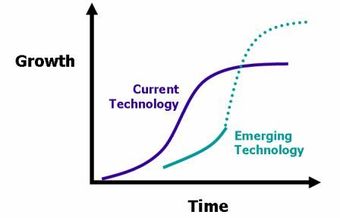
Technological Innovation Chart
In the figure above the first curve shows a current technology. The second shows an emerging technology that currently yields lower growth but will eventually overtake current technology and lead to even greater levels of growth.
15.5.2: New Product Ideas
New product ideas can generate from existing frustrations using a certain product, or a desire to do something better or more simply.
Learning Objective
Explain the front-end process of new product development (NPD) and the characteristics of a SWOT analysis
Key Points
- Most new product ideas come from experiences, like frustrations with an existing product.
- There are two parallel paths involved in the NPD process: one involves the idea generation, product design and detail engineering; the other involves market research and marketing analysis.
- Lots of ideas are generated about the new product. Out of these ideas many are implemented. The ideas are generated in many forms. There are many factors responsible for generation of an idea.
Key Terms
- life cycle
-
The useful life of a product or system; the developmental history of an individual or group in society.
- SWOT Analysis
-
a structured planning method used to evaluate the strengths, weaknesses, opportunities, and threats involved in a project or in a business venture
- product life cycle
-
the stages that a good or service goes through from when it is first introduced to when it is taken off the market
Example
- Airbnb.com, which has been wildly successful, started when their founders needed to generate $100 in order to pay their rent. A conference in a nearby town prompted them to rent out air mattresses in their apartment. They realized might have a good business idea.
In business and engineering, new product development (NPD) is the complete process of bringing a new product to market. A product is a set of benefits offered for exchange. It can be tangible (something physical you can touch) or intangible (like a service, experience, or belief). There are two parallel paths involved in the NPD process: idea generation, including product design and detail engineering; and market research and marketing analysis. Companies typically see new product development as the first stage in generating and commercializing a new product within the overall strategic process of product life cycle management, used to maintain or grow their market share.
Ideas for new products can be obtained from basic research using SWOT analysis: Strengths, Weaknesses, Opportunities & Threats. Many methods may be used to gain insight into new product lines or product features, including:

SWOT Analysis
Here is an example of the SWOT analysis matrix.
- Market and consumer trends
- Research and development
- Competitors
- Focus groups and trade shows
- Employees and corporate spies
- Salespeople
- Ethnographic discovery methods (searching for user patterns and habits)
Five Different Front-End Elements
- Opportunity identification: Large or incremental business and technological chances are identified in a relatively structured way. Using the guidelines established here, resources are allocated to new projects, leading to a structured New Product & Process Development or NPPD strategy.
- Opportunity analysis: This element translates identified opportunities into implications for the business and technology specific context of the company. This element focuses on aligning ideas to target customer groups, and can include market studies and/or technical trials and research.
- Idea genesis: The evolutionary and iterative process of progressing an initial idea from birth to maturation into a tangible idea. This process can occur internally or externally (e.g., a supplier offering a new material or technology, or a customer presenting an unusual request.
- Idea selection: The decision to pursue an idea is determined by analyzing its potential business value.
- Concept and technology development: During this part of the front-end, the business case is developed based on estimates of the total available market, customer needs, investment requirements, competition analysis and project uncertainty. Some organizations consider this the first stage of the NPPD process
15.5.3: Following a Product Development Process
Product development is idea generation, screening, business analysis, technical development, manufacturing, testing, and commercialization.
Learning Objective
Outline the several stages in new product development
Key Points
- Ideas for new products can be obtained from customers (employing user innovation), the company’s research and development department, competitors, focus groups, employees, salespeople, and more.
- The object of idea screening is to eliminate unsound concepts prior to devoting resources to them.
- The focus of the business analysis is primarily on profits, but other considerations, such as social responsibilities, may also be involved.
- Manufacturing planning must consider how to secure the availability of required funds, facilities, and personnel at the intended time, as well as the methods of coordinating this effort.
- Test marketing is the final step before commercialization; the objective is to test all the variabilites in the marketing plan including elements of the product.
Key Term
- Focus Group
-
A group of people, sampled from a larger population, interviewed in open session for market research or political analysis
New Product Development Process
There are several stages in the new product development process–not always followed in order:
Idea Generation
Generating new product ideas is a creative task that requires a specific way of thinking. Ideas for new products can be obtained from customers (employing user innovation), the company’s R&D department, competitors, focus groups, employees, sales people, corporate spies, trade shows, or through a policy of Open Innovation. Formal idea generating techniques include attribute listing, forced relationships, brainstorming, morphological analysis, and problem analysis.
Idea Screening
The second step in the product development process is screening. It is a critical part of the development activity. The object is to eliminate unsound concepts prior to devoting resources to them. The screeners must ask at least three questions:
- Will the customer in the target market benefit from the product?
- Is it technically feasible to manufacture the product?
- Will the product be profitable when manufactured and delivered to the customer at the target price?
Business Analysis
After the various product ideas survive their initial screening, very few viable proposals will remain. Before the development of prototypes can be decided upon, however, a further evaluation will be conducted to gather additional information on these remaining ideas in order to justify the enormous costs required. The focus of the business analysis is primarily on profits, but other considerations, such as social responsibilities, may also be involved. Management must:
- Estimate the likely selling price based upon competition and customer feedback.
- Estimate sales volume based upon size of market.
- Estimate profitability and the break even point.
Technical and Marketing Development
A product that has passed the screening and business analysis stages is ready for technical and marketing development. Technical development involves two steps. The first is the applied laboratory research required to develop exact product specifications.The goal of this research is to construct a prototype model of the product that can be subjected to further study. Once the prototype has been created, manufacturing-methods research can be undertaken to plan the best way of making the product in commercial quantities under normal manufacturing conditions. This is an extremely important step, because there is a significant distinction between what an engineer can assemble in a laboratory and what a factory worker can produce.

Prototypes
One step in the product development process is technical development.
While the laboratory technicians are working on the prototype, the marketing department is responsible for testing the new product with its intended consumers and developing the other elements of the marketing mix. They must ask the following questions:
- Who is the target market, and who is the decision maker in the purchasing process?
- What product features must the product incorporate?
- What benefits will the product provide?
- How will consumers react to the product?
- How will the product be produced most cost effectively?
- What will it cost to produce it?
Marketers must then prove feasibility through a virtual computer-aided rendering and rapid prototyping, and test the concept by asking a sample of prospective customers what they think of the idea.
Manufacturing Planning
Assuming that the product has cleared the technical and marketing development stage, the manufacturing department is asked to prepare plans for producing it. The plan begins with an appraisal of the existing production plant and the necessary tooling required to achieve the most economical production. Compromise between attractiveness and economy is often necessary. Finally, manufacturing planning must consider how to secure the availability of required funds, facilities, and personnel at the intended time, as well as the methods of coordinating this effort.
Marketing Planning
It is at this point that the product planner must prepare a complete marketing plan–one that starts with a statement of objectives and ends with the fusion of product, distribution, promotion, and pricing into an integrated program of marketing action.
Test Marketing
Test marketing is the final step before commercialization; the objective is to test all the variabilites in the marketing plan including elements of the product.
Commercialization (often considered post-NPD)
At last, the product is ready to go. It has survived the development process, and it is now on the way to commercial success. How can it be guided to that marketing success? It is the purpose of the lifecycle marketing plan to answer this question. Such a complete marketing program will, of course, involve additional decisions about distribution, promotion, and pricing.
15.5.4: Screening
Idea screening attempts to eliminate unsound product concepts prior to devoting resources to them.
Learning Objective
Explain how product developers use a simple checklist and assign weights of importance in order to best screen ideas
Key Points
- If a poor product idea is allowed to pass the screening state, it wastes effort and money in subsequent stages until it is later abandoned. However, the possibility of screening out a worthwhile idea is even more serious.
- The first technique of screening is a simple checklist. For example, new product ideas can be rated on a scale ranging from very good to poor.
- A second technique goes beyond the first, in which criteria are assigned importance weights, with products rated on a point scale measuring product compatibility.
- New product criteria include value added, sales volume, patent protection and affect on present products.
Key Terms
- patent
-
A declaration issued by a government agency declaring someone the inventor of a new invention and having the privilege of stopping others from making, using or selling the claimed invention; a letter patent.
- idea screening
-
the process of testing concepts and eliminating unsound ones
Idea screening is an early step in the new product development process and is a critical part of the development activity. If a poor product idea is allowed to pass the screening state, it wastes effort and money in subsequent stages until it is later abandoned. However, the possibility of screening out a worthwhile idea is even more serious, There are two common techniques for screening new product ideas. Both involve the comparison of a potential product idea against criteria of acceptable new products.
The first technique is a simple checklist. For example, new product ideas can be rated on a scale ranging from very good to poor by such criteria as value added, sales volume, patent protection and affect on present products. Unfortunately, it is quite difficult for raters to define what is fair or poor. In addition, the rating system does not address the issue of the time and expense associated with each idea, nor does it instruct with regard to scores. A second technique goes beyond the first, in which criteria are assigned importance weights, with products rated on a point scale measuring product compatibility. These scores are then multiplied by their respective weights and added to yield a total score for the new product idea.
In summary:
The object is to eliminate unsound concepts prior to devoting resources to them.
The screeners should ask several questions:
- Will the customer in the target market benefit from the product?
- What is the size and growth forecast of the market segment / target market?
- What is the current or expected competitive pressure for the product idea?
- What are the industry sales and market trends the product idea is based on?
- Is it technically feasible to manufacture the product?
- Will the product be profitable when manufactured and delivered to the customer at the target price?

Product Screening
Before introducing the iPad to market, Apple had to go through a process of screening in order to conclude the new product would be a worthwhile investment.
15.5.5: Analysis
The focus of the business analysis is primarily on profits, but other considerations such as social responsibilities may also be involved.
Learning Objective
Explain the business analysis stage of new product development
Key Points
- Before the development of prototypes can be decided upon, a further evaluation will be conducted to gather additional information on these remaining ideas in order to justify the enormous costs.
- The first step in the business analysis is to examine the projected demand. This would include two major sources of revenue: The sales of the product and the sales or license of the technology developed for or generated as a by-product of the given product.
- A complete cost appraisal is also necessary as a part of the business analysis.
- The Fourt-Woodlock equation is a market research tool to describe the total volume of consumer product purchases per year based on households which initially make trial purchases of the product and those households which make a repeat purchase within the first year.
Key Terms
- learning curve
-
An experience or graphic representation of progress in learning measured against the time required to achieve mastery of something.
- economies of scale
-
The characteristics of a production process in which an increase in the scale of the firm causes a decrease in the long-run average cost of each unit.
After the various product ideas survive their initial screen, very few viable proposals will remain. Before the development of prototypes can be decided upon, however, a further evaluation will be conducted to gather additional information on these remaining ideas in order to justify the enormous costs. The focus of the business analysis is primarily on profits, but other considerations such as social responsibilities may also be involved. The first step in the business analysis is to examine the projected demand. This would include two major sources of revenue: The sales of the product and the sales or license of the technology developed for or generated as a by-product of the given product. A complete cost appraisal is also necessary as a part of the business analysis. It is difficult to anticipate all the costs that will be involved in product development, but the following cost items are typical:
- Expected development cost, including both technical and marketing research and development.
- Expected set-up costs. These can include production, manufacturing equipment, distribution, etc.
- Operating costs that account for possible economies of scale and learning curves.
- Marketing costs, especially promotion and distribution.
- Management costs.
Other necessary steps in business analysis include:
- Estimating the likely selling price based upon competition and customer feedback.
- Estimating sales volume based upon the size of the target market and such tools as the Fourt-Woodlock equation.
- Estimating profitability and the break-even point.
The Fourt-Woodlock equation is a market research tool to describe the total volume of consumer product purchases per year based on households which initially make trial purchases of the product and those households which make a repeat purchase within the first year. Since it includes the effects of initial trial and repeat rates, the equation is useful in new product development .

The Fourt-Woodlock Equation
The left-hand-side of the equation is the volume of purchases per unit time (usually taken to be one year). On the right-hand-side, the first parentheses describes trial volume, and the second describes repeat volume. HH is the total number of households in the geographic area of projection, and TR (“trial rate”) is the percentage of those households which will purchase the product for the first time in a given time period. TU (“trial units”) is the number of units purchased on this first purchase occasion. MR is “measured repeat,” or the percentage of those who tried the product who will purchase it at least one more time within the first year of the product’s launch. RR is the repeats per repeater ( the number of repeat purchases within that same year). RU is the number of repeat units purchased on each repeat event.
15.5.6: Testing
The objective of testing is to test all the variabilites in the marketing plan, including elements of the product.
Learning Objective
Compare and contrast initial product testing and test marketing
Key Points
- Product testing is totally initiated by the producer. He or she selects the sample of people, provides the consumer with the test product, and offers the consumer some sort of incentive to participate.
- In test marketing, the consumer must make the decision him- or herself, must pay using his or her money, and the test product must compete with the existing products in the actual marketing environment.
- Because of the special expertise needed to conduct test markets and the associated expenses, most manufacturers employ independent marketing research agencies with highly trained project directors, statisticians, psychologists, and field supervisors.
Key Terms
- marketing mix
-
The marketing mix is a business tool used in marketing products. The marketing mix is often crucial when determining a product or brand’s unique selling point and is often synonymous with the four Ps: price, product, promotion, and place.
- Market Share
-
Percentage of some market held by a company.
Example
- In this stage, one of the best things you can do as an entrepreneur is find cheap easy ways to test the market for your product. One way to do that might be spending $50 on Facebook or Google ads, before you even go and build a product.
Testing is the final step before commercialization. The objective is to test all the variabilites in the marketing plan including elements of the product. Test marketing represents an actual launching of the total marketing program, but on a limited basis.
Three general issues are addressed through test marketing. First, the overall workability of the marketing plan is assessed. Second, alternative allocations of the budget are evaluated. Third, whether the new product is inspiring users to switch from other brands is determined. In the end, the test market should include an estimate of sales, market share, and financial performance over the life of the product.

Product Testing
This is a photo of a temperature and humidity chamber used to simulate transport, warehouse environments, and shelf life conditions of a packaged product.
Initial product testing and test marketing are not the same. Product testing is totally initiated by the producer. He or she selects a sample of people, provides the consumer with the test product, and offers the consumer some sort of incentive to participate. Test marketing, on the other hand, is distinguished by the fact that the test cities should represent the national market. The consumer must make the decision him- or herself, must pay with his or her money, and the test product must compete with the existing products in the actual marketing environment. For these and other reasons, a market test is an accurate simulation of the national market and serves as a method for reducing risk. It should enhance the new product’s probability of success and allow for final adjustment in the marketing mix before the product is introduced on a large scale.
However, running a test marketing simulation has inherent risks. First, there are substantial costs in buying the necessary plant and machinery needed to manufacture the product or locating manufacturers willing to make limited runs. There are also promotional costs, particularly advertising and personal selling. Although not always easy to identify, there are indirect costs as well. For example, the money used to test market could be used for other activities; in other words, there is an opportunity cost. There is also a risk of losing consumer goodwill through the testing of an inferior product. Finally, engaging in a test market might allow competitors to become aware of a new product and quickly copy it.
Because of the special expertise needed to conduct test markets and take on associated expenses, most manufacturers employ independent marketing research agencies with highly trained project directors, statisticians, psychologists, and field supervisors. Such firms assist the product manager in making the remaining test market decisions. These include:
- Duration of testing: the product should be tested long enough to account for market factors to even out, allow for repeat purchases, and account for deficiencies in any other elements in the new product (three to six months of testing may be sufficient for a frequently purchased and rapidly consumed convenience item).
- Selection of test market cities: the test market cities should reflect the norms for the new product in such areas as advertising, competition, distribution system, and product usage.
- Number of test cities: should be based on the number of variations considered (i.e., price, package, or promotion), representativeness, and cost.
- Sample size determination: the number of stores used should be adequate to represent the total market.
Even after all the test results are in, adjustments in the product are still made. Additional testing may be required, or the product may be discontinued.
15.5.7: Commercialization
Once a product is ready to take to market, commercialization involves key decisions about distribution, promotion, and pricing.
Learning Objective
Outline the basics of commercialization
Key Points
- The actual launch of a new product is the final stage of new product development, and the one where the most money will have to be spent for advertising, sales promotion, and other marketing efforts.
- Commercialization of a product will only take place if the following three questions can be answered: When is the appropriate time to introduce the product? Where is the appropriate market to launch the product? To whom will the product be targeted primarily?
- The company has to decide on an action plan for introducing the product by implementing the above decisions.
Key Term
- marketing mix
-
The marketing mix is a business tool used in marketing products. The marketing mix is often crucial when determining a product or brand’s unique selling point and is often synonymous with the four Ps: price, product, promotion, and place.
Commercialization is the process or cycle of introducing a new product or production method into the market . This actual launch of a new product is the final stage of new product development, and the one where the most money will have to be spent for advertising, sales promotion, and other marketing efforts. Commercialization is often confused with sales, marketing or business development. The commercialization process has three key aspects:

Commercialization
Bringing new products to market will require creative marketing techniques to achieve success like Red Bull did by creating mascot automobiles.
- It is essential to look at many ideas to get one or two products or businesses that can be sustained long-term. This is often known as the funnel.
- Commercialization is a stage-wise process, and each stage has its own key goals and milestones.
- It is vital to involve key stakeholders early on, including customers.
Commercialization of a product will only take place if the following three questions can be answered:
- When is the appropriate time to introduce the product? When facing the danger of cannibalizing the sales of the company’s other products, if the product can be improved further, or if the economy is down, the launch should be delayed.
- Where is the appropriate market to launch the product? It can be in a single location, in several regions, or it might be more appropriate for a national or international market. This decision will be strongly influenced by the company’s resources in terms of capital, managerial confidence and operational capacities. Smaller companies usually launch in attractive cities or regions, while larger companies enter a national market all at once. Global roll outs are generally only undertaken by multinational conglomerates, since they have the necessary size and make use of international distribution systems. Other multinationals use the “lead-country” strategy by introducing the new product in one country/region at a time.
- To whom will the product be targeted primarily? These primary consumer groups should consist of innovators, early adopters, heavy users and/or opinion leaders. This will ensure adoption by other buyers in the marketplace during the product growth period.
The company has to decide on an action plan for introducing the product by thinking about the questions above and making informed decisions. It has to develop a viable marketing mix and create a respective marketing budget.
15.6: Product Strategy
15.6.1: Developing Products
Organizations assess the current market for new product opportunities and, when potentially profitable, develop new product prototypes to test feasibility of production.
Learning Objective
Outline the steps involved in new product development, understanding the logic behind them
Key Points
- Product development is the process of identifying consumer needs within a market and innovating towards developing a product to fulfill those needs.
- Internal and external factors impacting production and demand should all be considered during the product development period.
- The eight steps of Koen provide useful context on how organizations develop products. Market research, brainstorming, screening, prototyping, testing, process engineering, and distribution are all key phases in development.
- Another useful concept is the idea of a minimum viable product (MVP). Due to the cost of mass production and perfecting a product, MVP allows rapid prototyping and testing to ensure a demand exists.
Key Terms
- scale
-
To grow and expand rapidly.
- conceptualizing
-
To conceive an idea for something.
New Product Opportunities
The process of identifying consumer needs within a market, and innovating towards developing a product to fulfill those needs, is referred to as new product development. When developing new products, the most important thing to keep in mind is that the product itself must successfully fill an existing need in the market, transforming a market opportunity into a tangible and marketable product.
Cost, time of development, price points, ability to scale, distribution, legalities, and competition should all be considered during the product development period. Through assessing the opportunity, risks, costs and external environment, organizations can ensure they focus on developing and investing in the products with the highest potential.
How To Develop Products
There are a number of useful frameworks for product development and product design, each of which focus on a full process of identifying market needs, ideating upon solutions, conceptualizing these solutions, and ultimately prototyping the new product for testing. One of the more well-known approaches is called eight stages of Koen:
Eight Stages of Koen
- Idea generation – Using market research, SWOT assessments, industry trends, trade shows, and data gathering techniques, organizations identify the existing opportunities in the market. Ideas to fill these consumer needs are brainstormed. When brainstorming, any and all ideas are valid and should be considered thoroughly.
- Idea screening – Once all of the ideas are on the board, the screening process can begin. Screening revolves around identifying which products best align with the target market and the need being filled, along with the technical feasibility and potential profitability of producing it.
- Idea development and testing – In this phase, the organization focuses on identifying marketing and engineering needs for production. The idea, concept, and brand identity of the new product should be considered, and technical aspects such as patents, features, and cost saving should be considered. 3D printing is an excellent advantage for prototyping as well, and consumers can be invited to test 3D printed models of the product.
- Business analysis – At this point, estimated selling prices, volume and profitability should be projected, researched, and confirmed.
- Beta testing and market testing – After producing and testing the prototype, an organization can now package and send this to small focus groups, trade shows and user testing sessions. This initial run through will allow comments from real consumers and criticisms to be addressed before mass marketing.
- Technical implementation – Assuming the beta testing goes well, the technical aspects of larger scale manufacturing must be organized. This includes building in quality management, resource estimations, technical spec sheets, engineering planning, department scheduling, sourcing, logistics, and all the other various inputs specific products may need for production.
- Commercialization – The product is finally ready for commercialization. At this point, the organization can officially launch the product, advertise, fill distribution pipelines, and refine the process.
- New product pricing – Once the product has been on the shelves for a some time, sufficient data can be collected to identify the financial impacts of this new product. Differentiating between segments, price points, consumer groups, and competitive markets can yield useful strategic information for the firm.
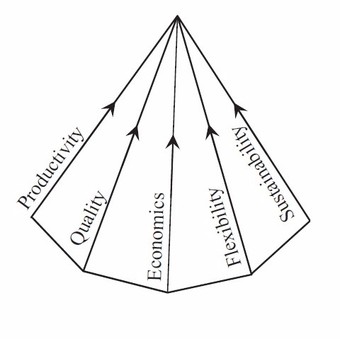
Pyramid of Production Systems
Refining production for a new product requires consideration of a variety of factors, including productivity, quality, economics, flexibility, and sustainability.
Through executing these eight steps, organizations can effectively mitigate risk while capturing new and interesting opportunities in the external markets.
Minimum Viable Product
Another useful concept to learn in regards to product development is referred to as the minimum viable product (MVP). A minimum viable product is the least investment of time and resources required to bring the product to market for testing. Often an MVP project will be developed rapidly and distributed in one or two locales, representative of the general market population. This mitigates risk and exposure while ensuring the organization can confirm the demand for a given product at a given price point.
15.6.2: Developing Services
Service products are offered by a wide variety of industries such as barbers, travel agencies, and consulting firms.
Learning Objective
Explain how services are a key aspect of the goods industry
Key Points
- It is important to remember that all products – whether they are goods, services, blankets, diapers, or plate glass – possess peculiarities that require adjustments in the marketing effort.
- Behind every product is a series of supporting services, such as warranties and money-back guarantees.
- An industrial customer might be keenly interested in related services such as prompt delivery, reliable price quotations, credit, test facilities, demonstration capabilities, liberal return policies, engineering expertise, and so forth.
Key Term
- credit
-
A privilege of delayed payment extended to a buyer or borrower on the seller’s or lender’s belief that what is given will be repaid.
Example
- The price of your merchandise or service tells the customer a lot about what they can expect from your business. This is why in some instances, salons and other services are able to charge a premium. Although they are delivering a product/service that is similar to competitors, the higher price suggests theirs has greater value.
Service products are reflected by a wide variety of industries: utilities, barbers, travel agencies, health spas, consulting firms, medical care and banking, to name but a few. They account for nearly 50% of the average consumer’s total expenditures, 70% of the jobs, and two-thirds of the GNP. Clearly, the service sector is large and is growing. It is important to remember that all products—whether they are goods, services, blankets, diapers, or plate glass—possess peculiarities that require adjustments in the marketing effort. However, offering an exceptional product at the right price, through the most accessible channels, promoted extensively and accurately, should work for any type of product.

Service Development
Dog walking is a service industry that has developed in recent years.
Moreover, behind every product is a series of supporting services, such as warranties and money-back guarantees. In many instances, such services may be as important as the product itself. In fact, at times it is difficult to separate the associated services from the product features. Consequently, companies must constantly monitor the services offered by the company and its competitors. Based on the results of data-gathering devices such as customer surveys, consumer complaints, and suggestion boxes, the product manager can determine the types of services to offer, the form the service will take, and the price charged.
An industrial customer might be keenly interested in related services such as prompt delivery, reliable price quotations, credit, test facilities, demonstration capabilities, liberal return policies, engineering expertise, and so forth. Although there are a wide range of supportive services, the following are most prevalent:
- Credit and financing: With the increased acceptance of debt by the consumer, offering credit and/or financing has become an important part of the total product. For certain market segments and certain products, the availability of credit may make the difference between buying or not buying the product.
- Warranty: There are several types of durable products, retail stores, and even service products where warranties are expected. These warranties can provide a wide array of restitution, with a very limited warranty at one end of the continuum and extended warranties at the other.
- Money-back guarantees: The ultimate warranty is the money-back guarantee. To the customer, a money-back guarantee reduces risk almost totally. There are certain market segments (e.g., low risk takers) that perceive this service as very important. Obviously this service is effective only if the product is superior and the product will be returned by only a few people.
- Delivery, installation, and training: Firms that sell products that tend to be physically cumbersome or located far from the customer might consider delivery to be an integral part of the new product. Very few major appliance stores, lumber yards, or furniture stores could survive without provisions for this service. Similarly, there are products that are quite complicated and/or very technical, and whose average consumer could neither learn how to install or use it without assistance from the manufacturer. Both professional and home computer companies have been forced to provide such services.
15.6.3: Classifying Consumer Products
Consumer products can be classified as convenience, shopping, or specialty goods.
Learning Objective
Categorize consumer product into three groups: convenience, shopping, specialty
Key Points
- A convenience good is one that requires a minimum amount of effort on the part of the consumer.
- Goods that consumers want to be able to compare, such as automobiles, appliances, and homes,are categorized as shopping goods.
- Specialty goods are products so unique that consumers will go to any lengths to seek out and purchase them.
Key Terms
- wholesaler
-
a person or company that sells goods wholesale is a middleman that buys its merchandise from a third party supplier and resells the merchandise to retail businesses or the end consumer. A wholesaler normally does not sell to other wholesalers.
- reseller
-
a company or individual that purchases goods or services with the intention of reselling them rather than consuming or using them
Examples
- In its online product catalog, retailer Sears divides its products into “departments”, then presents products to potential shoppers according to (1) function or (2) brand. Each product has a Sears item-number and a manufacturer’s model-number. Sears uses the departments and product groupings with the intention of helping customers browse products by function or brand within a traditional Raj department-store structure.
- Intangible Data Products can further be classified into Virtual Digital Goods (“VDG”) that are virtually located on a computer OS and accessible to users as conventional file types, such as JPG and MP3 files. Open Source Code, GNU Linux, or even Android, may manipulate and/or convert base Virtual Digital Goods (“VDG”) into process-oriented Real Digital Goods (“RDG”), as part of an application process or manufactured service that may be viewed on Personal Data Assistant (“PDA”) or other hand-held tangible devices or OS computer.
Classifying Consumer Products
A classification long used in marketing separates products targeted at consumers into three groups:
- Convenience
- Shopping
- And specialty
Convenience Goods
A convenience good is one that requires a minimum amount of effort on the part of the consumer. Extensive distribution is the primary marketing strategy. The product must be available in every conceivable outlet and must be easily accessible in these outlets. Vending machines typically dispense convenience goods, as do automatic teller machines. These products are usually of low unit value, they are highly standardized, and, frequently, they are nationally advertised. Yet, the key is to convince resellers (i.e., wholesalers and retailers) to carry the product. If the product is not available when, where, and in a form desirable by the consumer, the convenience product will fail. From the consumer’s perspective, little time, planning, or effort go into buying convenience goods. Consequently, marketers must establish a high level of brand awareness and recognition. This is accomplished through extensive mass advertising; sales promotion devices, such as coupons and point-of-purchase displays; and effective packaging. The fact that many of our product purchases are often on impulse is evidence that these strategies work. Availability is also important. Consumers have come to expect a wide spectrum of products to be conveniently located at their local supermarkets, ranging from packaged goods used daily (e.g., bread and soft drinks) to products purchased rarely or in an emergency, such as snow shovels, carpet cleaners, and flowers.

Convenience Goods
Convenience goods are typically found in convenience stores, such as the one pictured here.
Shopping Goods
In contrast, consumers want to be able to compare products categorized as shopping goods. Automobiles, appliances, furniture, and homes are in this group. Shoppers are willing to go to some lengths to compare values, and, therefore, these goods need not be distributed so widely. Although many shopping goods are nationally advertised, often, it is the ability of the retailer to differentiate itself that creates the sale. The differentiation could be equated with a strong brand name, such as Sears Roebuck, effective merchandising, aggressive personal selling, or the availability of credit. Discounting, or promotional price-cutting, is a characteristic of many shopping goods because of retailers’ desire to provide attractive shopping values. In the end, product turn over is slower, and retailers have a great deal of their capital tied-up in inventory. This, combined with the necessity to price discount and provide exceptional service, means that retailers expect strong support from manufacturers with shopping goods.
Specialty Goods
Specialty goods represent the third product classification. From the consumer’s perspective, these products are so unique that they will go to any lengths to seek out and purchase them. Almost without exception, price is not a principle factor affecting the sales of specialty goods. Although these products may be custom-made (e.g., a hairpiece) or one-of-a-kind (e.g., a statue), it is also possible that the marketer has been very successful in differentiating the product in the mind of the consumer. Crisco shortening, for instance, may be a unique product in the mind of a consumer, and the consumer would pay any price for it. Such a consumer would not accept a substitute and would be willing to go to another store or put off their pie baking until the product arrives. Another example might be the strong attachment some people feel toward a particular hair stylist or barber. A person may wait a long time for that individual and might even move with that person to another hair salon. It is generally desirable for a marketer to lift the product from the shopping to the specialty class. With the exception of price cutting, the entire range of marketing activities are required to accomplish this goal.
15.6.4: Classifying Business Products
Business products are goods or services that are sold to other businesses rather than to end-consumers.
Learning Objective
Explain the different marketing strategies of various types of indistrial goods
Key Points
- Forests, mines, and quarries provide extractiveproducts to producers.
- Manufactured products are those that have undergone some processing. Semi-manufactured goods are raw materials that have received some processing but require more before they are useful to the purchaser.
- Parts are manufactured items that are ready to be incorporated into other products.
- Process machinery (sometimes called installations) refers to major pieces of equipment used in the manufacture of other goods.
- Equipment is made up of portable factory equipment (e.g., fork lift trucks, fire extinguishers) and office equipment (e.g., computers, copier machines).
- Supplies and service do not enter the finished product at all, but are nevertheless consumed in conjunction with making the product.
Key Terms
- lathe
-
A machine tool used to shape a piece of material, or workpiece, by rotating the workpiece against a cutting tool.
- process
-
A series of events to produce a result, especially as contrasted to product.
Although consumer products are more familiar to most individuals, business and industrial goods represent very important product categories as well. In the case of some manufacturers, business products are their entire focus. Industrial products can either be categorized from the perspective of the producer and how they shop for the product, or the perspective of the manufacturer and how they are produced and how much they cost. The latter criteria offers a more insightful classification for industrial products.
Forests, mines, and quarries provide extractive products to producers. Although there are some farm products that are ready for consumption when they leave the farm, most farm and other extractive products require some processing before purchase by the consumer. A useful way to divide extractive products is into farm products and natural products, since they are marketed in slightly different ways.

Extractive Products
Quarries are examples of business that provide extractive products for other businesses.
Manufactured products are those that have undergone some processing. The demands for manufactured industrial goods are usually derived from the demands for ultimate consumer goods. There are a number of specific types of manufactured industrial goods.
Semi-manufactured goods are raw materials that have received some processing but require more before they are useful to the purchaser. Lumber and crude oil are examples of these types of products. Since these products tend to be standardized, there is a strong emphasis on price and vendor reliability.
Parts are manufactured items that are ready to be incorporated into other products. For instance, the motors that go into lawn mowers and steering wheels on new cars are carefully assembled when they arrive at the manufacturing plant. Since products such as these are usually ordered well in advance and in large quantities, price and service are the two most important marketing considerations.
Process machinery (sometimes called installations) refers to major pieces of equipment used in the manufacture of other goods. This category would include the physical plant of a manufacturer (boilers, lathes, blast furnaces, elevators, and conveyor systems). The marketing process would incorporate the efforts of a professional sales force, supported by engineers and technicians, and a tremendous amount of personalized service.
Equipment is made up of portable factory equipment (e.g., fork lift trucks, fire extinguishers) and office equipment (e.g., computers, copier machines). Although these products do not contribute directly to the physical product, they do aid in the production process. These products may be sold directly from the manufacturer to the user, or a middleman can be used in geographically dispersed markets. The marketing strategy employs a wide range of activities, including product quality and features, price, service, vendor deals, and promotion.
Supplies and service do not enter the finished product at all, but are nevertheless consumed in conjunction with making the product. Supplies would include paper, pencils, brooms, soap, etc. These products are normally purchased as convenience products with a minimum of effort and evaluation. Business services include maintenance (e,g., office cleaning), repairs (e.g., plumbing), and advisory (e.g., legal). Because the need for services tends to be unpredictable, they are often contracted for a relatively long period of time.
15.6.5: Marketing Classes of Products
Products can be classified based on consumer versus industrial goods and goods versus services.
Learning Objective
Categorize products into consumer goods, industrial goods, goods, services
Key Points
- When we purchase products for our own consumption with no intention of selling these products to others, we are referring to consumer goods.
- Industrial goods are purchased by an individual or organization in order to modify them or simply distribute them to the ultimate consumer in order to make a profit or meet some other objective.
- Consumer goods can be classified as convenience, shopping, or specialty goods.
- Service products are characterized as being intangible, produced and consumed simultaneously, lacking standardization, and having high buyer involvement.
- All intermediaries that buy finished or semi-finished products and resell them for profit are part of the reseller market. This market includes approximately 383,000 wholesalers and 1,300,000 retailers that operate in the United States, with the exception of products obtained directly from the producer, all products are sold through resellers. Since resellers operate under unique business characteristics, they must be approached carefully. Producers are always cognizant of the fact that successful marketing to resellers is just as important as successful marketing to consumers.
Key Terms
- intangible
-
incapable of being perceived by the senses; incorporeal
- Consumer
-
Someone who acquires goods or services for direct use or ownership rather than for resale or use in production and manufacturing.
- marketing
-
The promotion, distribution and selling of a product or service; includes market research and advertising.
Example
- Industrial market example: A steel mill might purchase computer software, pencils, and flooring as part of the operation and maintenance of its business. Likewise, a refrigerator manufacturer might purchase sheets of steel, wiring, and shelving in order to produce its final product. These purchases occur in the industrial market. Evidence suggests that industrial markets function differently from consumer markets, and that the buying process is particularly different.
The two most commonly used methods of classifying products are: (1) Consumer goods versus industrial goods, and (2) goods products (i.e., durables and non-durables) versus service products.
Consumer Goods and Industrial Goods
The traditional classification of products is to dichotomize all products as being either consumer goods or industrial goods. When we purchase products for our own consumption with no intention of selling these products to others, we are referring to consumer goods . Conversely, industrial goods are purchased by an individual or an organization in order to modify them or simply distribute them to the ultimate consumer in order to make a profit or meet some other objective.

Olympus Camera
This Olympus camera is considered to be a consumer good.
Classification of Consumer Goods
A classification long used in marketing separates products targeted at consumers into three groups: (1) Convenience goods, (2) shopping goods and (3) specialty goods.
A convenience good is one that requires a minimum amount of effort on the part of the consumer. Extensive distribution is the primary marketing strategy. The product must be available in every conceivable outlet and must be easily accessible in these outlets. These products are usually of low unit value, they are highly standardized, and frequently they are nationally advertised.
Consumers desire to compare products categorized as shopping goods. Automobiles, appliances, furniture, and homes are in this group. Shoppers are willing to go to some lengths to compare values; therefore, these goods need not be distributed so widely. Although many shopping goods are nationally advertised, often it is the ability of the retailer to differentiate itself that creates the sale. Discounting, or promotional price-cutting, is a characteristic of many shopping goods because of retailers’ desire to provide attractive shopping values.
Specialty goods represent the third product classification. From the consumer’s perspective, these products are so unique that they will go to any lengths to seek out and purchase them. Almost without exception, price is not a principle factor affecting the sales of specialty goods.
Classification of Industrial Goods
Although consumer products are more familiar to most readers, industrial goods represent a very important product category. For some manufacturers, industrial goods are the only product sold. The methods of industrial marketing are somewhat more specialized. Industrial products can either be categorized from the perspective of the producer and how they shop for the product, or the perspective of the manufacturer and how they are produced and how much they cost. The latter criteria offers a more insightful classification for industrial products.
Forests, mines, and quarries provide extractive products to producers. Most extractive products require some processing before purchase by the consumer. Manufactured products are those that have undergone some processing. The demand for manufactured industrial goods are usually derived from the demand for ultimate consumer goods.
Goods Versus Services
Service products are reflected by a wide variety of industries—utilities, barbers, travel agencies, health spas, consulting firms, medical facilities and banks are but a few. They account for nearly 50 percent of the average consumer’s total expenditures and 70 percent of jobs. Like goods products, service products are quite heterogeneous. Nevertheless, there are several characteristics that are generalized to service products.
Intangible: With the purchase of a good, one has something that can be seen, touched, tasted, worn or displayed. This is not true with a service. Although one pays money and consumes the service, there is nothing tangible to show for it.
Simultaneous Production and Consumption: Service products are characterized as those that are being consumed at the same time they are being produced. In contrast, goods products are produced, stored, and then consumed. A result of this characteristic is that the provider of the service is often present when consumption takes place.
Little Standardization: Because service products are so closely related to the people providing the service, ensuring the same level of satisfaction from time to time is quite difficult.
High Buyer Involvement: With many service products, the purchaser may provide a great deal of input into the final form of the product. For example, in the case of a cruise, a good travel agent would provide a large selection of brochures and pamphlets describing the various cruise locations, options provided in terms of cabin location and size, islands visited, food, entertainment, prices, and whether there are facilities for children.
It should be noted that these four characteristics associated with service products vary in intensity from product to product. In fact, service products are best viewed as being on a continuum in respect to these four characteristics.
15.6.6: Using a Product Life Cycle Framework
Evidence suggests that every product goes through a lifecycle with different phases of sales and profits.
Learning Objective
Explain the five stages of the product life cycle
Key Points
- A company has to be good at both developing new products and managing them in the face of changing tastes, technologies, and competition.
- It should be noted that the predictive capabilities of the product lifecycle are dependent upon several factors, both controllable and uncontrollable, and that no two companies may follow the same exact pattern or produce the same results.
- Some argue that the competitive situation is the single most important factor influencing the duration of height of a product lifecycle curve.
- Almost all new products can expect fewer than 5, 10, or 15 years of market protection.
- Usually the improvements brought about by non-product tactics are relatively short-lived, and basic alterations to product offerings provide longer benefits.
Key Terms
- patent
-
A declaration issued by a government agency declaring someone the inventor of a new invention and having the privilege of stopping others from making, using or selling the claimed invention; a letter patent.
- distinctiveness
-
Something which distinguishes something from anything else
- obsolete
-
no longer in use; gone into disuse; disused or neglected (often by preference for something newer, which replaces the subject).
Example
- Product life-cycle predictions are dependent upon controllable and uncontrollable factors. For example, differences in the competitive situation during each of these stages may dictate different marketing approaches.
The Product Lifecycle
A company has to be good at both developing new products and managing them in the face of changing tastes, technologies, and competition. Evidence suggests that every product goes through a lifecycle with different phases of sales and profits. As such, the manager must find new products to replace those that are in the declining stage of the product lifecycle and learn how to manage products optimally as they move from one stage to the next. The five stages of the product life cycle and their components can be defined as follows:
- Product development: the period during which new product ideas are generated, operationalized, and tested prior to commercialization.
- Introduction: the period during which a new product is introduced. Initial distribution is obtained and promotion is obtained.
- Growth: the period during which the product is accepted by consumers and the trade. Initial distribution is expanded, promotion is increased, repeat orders from initial buyers are obtained, and word-of-mouth advertising leads to more and more new users.
- Maturity: the period during which competition becomes serious. Towards the end of this period, competitors’ products cut deeply into the company’s market position.
- Decline: the product becomes obsolete and its competitive disadvantage result in decline in sales and, eventually, deletion.
It should be noted that the predictive capabilities of the product lifecycle are dependent upon several factors, both controllable and uncontrollable, and that no two companies may follow the same exact pattern or produce the same results. For example, differences in the competitive situation during each of these stages may dictate different marketing approaches. Some argue that the competitive situation is the single most important factor influencing the duration of height of a product lifecycle curve. A useful way of looking at this phenomenon is in terms of competitive distinctiveness.
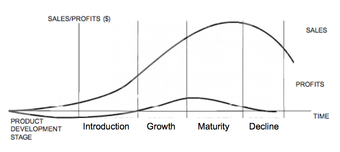
Product Lifecycle
The product lifecycle.
Often, new products may, upon introduction, realistically expect a long period of lasting distinctiveness or market protection—through such factors as secrecy, patent protection, and the time and cash required to develop competitive products. However, almost all new products can expect fewer than 5, 10, or 15 years of market protection.
Of course, changes in other elements of the marketing mix may also affect the performance of the product during its lifecycle. For example, a vigorous promotional program or a dramatic lowering of price may improve the sales picture in the decline period, at least temporarily. The black-and-white TV market illustrated this point. Usually the improvements brought about by non-product tactics are relatively short-lived, and basic alterations to product offerings provide longer benefits. Whether one accepts the S-shaped curve as a valid product-sales pattern or as a pattern that holds only for some products (but not for others), the product lifecycle concept can still be very useful. It offers a framework for dealing systematically with product management issues and activities. Thus, the marketer must be cognizant of the generalizations that apply to a given product as it moves through the various stages. This process begins with product development and ends with the deletion (discontinuation) of the product.
15.7: Product Packaging and Branding
15.7.1: A Brief Definition of Brand
A brand refers to a name, term, symbol, or any other type of feature that defines or identifies a seller’s product or service.
Learning Objective
Explain the history and importance of branding
Key Points
- The word “brand” is derived from the Old Norse brand meaning “to burn,” which refers to the practice of producers burning their mark (or brand) onto their products.
- During the Industrial Revolution, the production of many household items, such as soap, was moved from local communities to centralized factories where they were branded with a logo or insignia, extending the meaning of “brand” to that of trademark.
- All of a brand’s elements (i.e., logo, color, shape, letters, images) work as a psychological trigger or stimulus that causes an association to all other thoughts we have about a brand.
- Brands provide external cues to taste, design, performance, quality, value, and prestige if they are developed and managed properly.
- Brands convey positive or negative messages about a product. They also indicated the company or service to the consumer, which is a direct result of past advertising, promotion, and product reputation.
- A brand can convey up to six levels of meaning: Attributes, Benefits, Values, Culture, Personality and User.
Key Term
- brand
-
A name, symbol, logo, or other item used to distinguish a product, service, or its provider.
Example
- Campbell Soup, Coca-Cola, Juicy Fruit gum, Aunt Jemima, and Quaker Oats were among the first products to be “branded. “
Defining a Brand
A brand consists of any name, term, design, style, words, symbols or any other feature that distinguishes the goods and services of one seller from another. A brand also distinguishes one product from another in the eyes of the customer. All of its elements (i.e., logo, color, shape, letters, images) work as a psychological trigger or stimulus that causes an association to all other thoughts we have about this brand. Tunes, celebrities, and catchphrases are also oftentimes considered brands.

Coca-Cola Brand Logo
The Coca-Cola logo is an example of a widely-recognized trademark and global brand.
History
The word “brand” is derived from the Old Norse ‘brand’ meaning “to burn,” which refers to the practice of producers burning their mark (or brand) onto their products. Italians are considered among the first to use brands in the form of watermarks on paper in the 1200s. However, in mass-marketing, this concept originated in the 19th century with the introduction of packaged goods.
During the Industrial Revolution, the production of many household items, such as soap, was moved from local communities to centralized factories to be mass-produced and sold to the wider market. Illiteracy was still prevalent and packing crates were handled by stevedores who couldn’t read. Factories branded their logo or insignia on the barrels used and the logo of the companies to which the cargo was being shipped. This allowed the products to be delivered to the proper location. The meaning of “brand” extended to that of the trademark symbol, and communicated to retailers and their customers that mass produced products should be trusted as much as local competitors. Campbell Soup, Coca-Cola , Juicy Fruit gum, Aunt Jemima, and Quaker Oats were among the first U.S. products to be “branded. “
Connotations
A successful brand can create and sustain a strong, positive, and lasting impression in the mind of a consumer. Brands provide external cues to taste, design, performance, quality, value and prestige if they are developed and managed properly. Brands convey positive or negative messages about a product, along with indicating the company or service to the consumer, which is a direct result of past advertising, promotion, and product reputation.
A brand can convey up to six levels of meaning:
- Attributes: The Mercedes-Benz brand, for example, suggests expensive, well-built, well-engineered, durable, high-prestige automobiles.
- Benefits: attributes must be translated into functional and emotional benefits.
- Values: Mercedes stands for high performance, safety, and prestige.
- Culture: Mercedes represents German culture, organized, efficient, high quality.
- Personality: the brand projects a certain personality.
- User: the brand suggests the kind of consumer who buys and uses the product.
15.7.2: Brand Categories
Similar goods and services are classified in brand categories.
Learning Objective
Define a brand
Key Points
- Brand categories, or generic classification of products, group similar goods and services.
- A brand is a name, term, design, symbol, or any other feature that identifies one seller’s good or service as distinct from those of other sellers.
- Brand awareness refers to the customer’s ability to recall and recognize the brand under different conditions, using memory associations to link to the brand name, logo, jingles, and so forth.
Key Terms
- Brand Equity
-
the value of having a well-known name, logo, or other identifier
- Brand categories
-
A generic classification of products or services.
Example
- Coke, Pepsi, Sprite, and all other soda brand products fall into the same brand category of soft drinks.
Brand Categories
A brand is a name, term, design, symbol, or any other feature that identifies one seller’s good or service as distinct from those of other sellers.
Branding began as a functional marketing tool. Italians are considered among thefirst to use brands in the form of watermarks on paper in the 1200s. People in the Middle Ages were illiterate. Medieval guilds — candle makers, goldsmiths,cobblers; carpenters, painters and masons; bakers and fishmongers — created symbols to be etched or stamped into their work, products or crates which represented and certified the quality of a guild’s work.
Brand categories are generic classifications of products or services. Similar and competing products (or services) all fall into the same brand category. For example, all the different perfumes fall into the brand category of perfume because they all satisfy the same consumer need.
Brand awareness refers to the customer’s ability to recall and recognize the brand under different conditions, using memory associations to link to the brand name, logo, jingles, and so forth. It consists of both brand recognition and brand recall. It helps the customers understand to which product or service category the particular brand belongs and what products and services are sold under the brand name. It also ensures that customers know which of their needs are satisfied by the brand through its products (Keller). Brand awareness is of critical importance, since customers will not consider your brand if they are not aware of it .

Brand logo
Brand awareness refers to thecustomer’s ability to recall and recognize the brand under different conditions,using memory associations to link to the brand name, logo, jingles, and so forth.
There are various levels of brand awareness that require different levels and combinations of brand recognition and recall. Top-of-Mind is the goal of most companies. Top-of-Mind Awareness occurs when your brand is what pops into a consumer’s mind when asked to name brands in a product category. For example, when someone is asked to name a type of facial tissue, the common answer is Kleenex, which is a top-of-mind brand. Aided Awareness occurs when a consumer is shown or reads a list of brands, and expresses familiarity with your brand only after they hear or see it as a type of memory aid. Strategic Awareness occurs when your brand is not only top-of-mind to consumers, but also has distinctive qualities that stick out to consumers as making it better than the other brands in your market. The distinctions that set your product apart from the competition are also known as the Unique Selling Points or USP.
15.7.3: The Benefits of a Good Brand
Good branding gives a company several advantages including establishing a positive reputation and building an image attractive to consumers.
Learning Objective
Explain the components of a strong brand
Key Points
- Branding develops an image of a company’s products in the minds of consumers, attributing goods with certain unique qualities or characteristics that, if done effectively, are attractive to the target audience.
- A brand widely known in the market has brand recognition and builds up positive sentiment which further strengthens the company position amongst competitors.
- Benefits of a strong brand include: being able to command higher prices, speeding up new product acceptance, enabling market share penetration by advertising, and resisting price erosion.
Key Terms
- good
-
an object produced for market
- brand image
-
The set of emotional and sensory perceptions a consumer associates with a particular product or service in their mental construct of a brand.
Example
- Disney has brand recognition worldwide; its castle logo with Walt Disney’s signature, as well as its characters (like Mickey Mouse) are instantly recognizable.
Benefits of a Strong Brand
A brand is the personality that identifies a product, service or company (name, term, sign, symbol, design, or combination thereof); it also represents a relationship to key constituencies: customers, staff, partners, investors etc. Proper branding can yield higher product sales, and higher sales of products associated with the brand (or brand association). For example, a a customer who loves Pillsbury biscuits (and trusts the brand) is more likely to try other products the company offers, such as chocolate chip cookies.
Some people distinguish the psychological aspect of brand associations (e.g., thoughts, feelings, perceptions, images, experiences, beliefs, attitudes, etc.) that become tied to the brand from the experiential aspect—the sum of all points of contact with the brand, otherwise known as brand experience. Brand experience is a brand’s action perceived by a person. The psychological aspect, sometimes referred to as the brand image, is a symbolic construct created within the minds of people, consisting of all the information and expectations associated with a product, service, or company providing them .

Brands
Good branding gives a company several advantages, including establishing a positive reputation and building an image attractive to consumers.
The branding process seeks to develop or align the expectations behind the brand experience, creating an impression that a product or service associated with a brand possesses certain qualities or characteristics that set it apart from other (e.g., competitor) products or services. A brand is therefore one of the most valuable elements in an advertising theme, as it demonstrates the uniqueness of what the brand owner is able to offer in the marketplace. Orientation of the whole organization towards its brand is called brand orientation. Brand orientation is developed in response to market intelligence. Brand strength analysis describes efforts to determine the strength a brand has compared with its competitors. The art of creating and maintaining a brand is called brand management.
Careful brand management seeks to make the product or services appealing and/or relevant to the target audience. Brands should reflect more than mere differential of product cost versus selling price. They should represent the sum of all valuable qualities of a product to the consumer.
A brand which is widely known in the marketplace acquires brand recognition. When brand recognition builds to the point of a critical mass of positive sentiment in the marketplace, it is said to have achieved brand franchise. Brand recognition is most successful when a brand is recognized independent of the company’s name, but rather through visual signifiers like logos, slogans, and colors. For example, Disney has been successful branding with their particular script font, originally created for Walt Disney’s “signature” logo, and which it now uses in the logo for the website GO.com.
Consumers may view branding as an aspect of products or services, as it often serves to denote certain attractive qualities or characteristics. From the perspective of brand owners, branded products or services also command higher prices. Where two products resemble each other, but one of the products has no associated branding (such as a generic, store-branded product), people may often select the more expensive branded product on the basis of the quality or reputation of the brand or brand owner. Benefits of good brand recognition include facilitating of new product acceptance, enabling market share penetration by advertising, and resisting price erosion.
15.7.4: Developing a Brand
Developing a brand successfully requires a company to analyze the characteristics and values a customer base desires.
Learning Objective
Explain how companies can develop their brand
Key Points
- Brands have intrinsic attributes (functional characteristics and design of the products) and extrinsic attributes (packaging, pricing, marketing tactics) that develops the brand image and personality.
- A well-developed brand creates value beyond the actual product.
- Every design shown and communication made to the consumer are related to branding.
Key Terms
- advertising
-
communication whose purpose is to influence potential customers about products and services.
- marketing
-
Marketing is the process of communicating the value of a product or service to customers.
Examples
- Extrinsic attributes of a brand include Oreo cookie packaging, celebrity spokespersons, and marketing slogans.
- Extrinsic attributes of a brand include oreo cookie packaging, celebrity spokespersons, and marketing slogans.
Developing a Brand
The goal when developing a brand is to create value. You do that by emulating the characteristics and values that your customers desire. Branding is present throughout everything your company touches—it is not just a logo. Every design shown and communication made to the consumer are examples of branding.
Branding Attributes
Brands have intrinsic and extrinsic attributes. Intrinsic attributes refer to functional characteristics of the brand: its shape, performance, and physical capacity (e.g. Gillette razors shave unwanted hair and are able to do so more closely than most products in their product class because of their curved shape). Should any of these attributes be changed, they will not function in the same way or be the same product.
Examples of extrinsic attributes are features like the price of the Gillette razors, their packaging, the Gillette brand name, and mechanisms that enable consumers to form associations that give meaning to the brand. For example, it can appear more desirable because David Beckham, who is a brand himself, advertizes it.
Some refer to a brand’s function as the creation and communication of a multidimensional character of a product—one that is not easily copied and damaged by competitors’ efforts.
Brands have different elements, namely brand personality (functional abilities), brand skill (its fundamental traits—e.g. Chanel No 5 is seen as sexy) and brand relationships (with buyers) or brand magic. These elements are what give the brand added value.
Marketing and advertising are about selling your products and services. Branding is about selling everything associated with your organization . The consumer perception of brands is brand knowledge: brand awareness, recognition and recall, and brand image denote how consumers perceive a brand based on quality and attitudes towards it and what stays in their memory.

Branding
Branding is about selling everything associated with your organization.
This suggests that brand associations are anything linked in memory to a brand. “The essence of branding is promising and delivering” (Low and Lamb Jr, 2000). The successful organizations realize that the employees are influential to brand strategy. Aaker referred to studies using different methods and larger samples, which point out that “consumers noted for high-preference brands, 82% related to employee behavior; for low-preference brands, 90% related to influence of employee behavior (attitudes, competence, and personalization of the service).” Therefore, a part of brand strategy must focus on building brand association among employees at all levels. “If the employees are aligned with the brand strategy, including the promise, then they will deliver a consistent expression of the brand to their customers at every touch point.”
Brand Development Index or (BDI) measures the relative sales strength of a brand within a specific market (e.g. Pepsi brand in 10 – 50 year olds). It is a measure of the relative sales strength of a given brand in a specific market area.
15.7.5: Brand Management Strategies
Through effective brand management, organizations can build a loyal following of engaged consumers.
Learning Objective
Assess the variety of brand management strategies companies employ, and identify the potential advantages and disadvantages of each one
Key Points
- Brand management can enable high levels of awareness, engagement, retention and loyalty from users, which translates into significant organizational value.
- There are a wide variety of brand management strategies, each of which has some pros and cons organizations will want to consider on a case by case basis.
- Some examples of brand management strategies include iconic branding, individual branding, multi-product branding, sub-branding, and co-branding.
- Modern day branding incorporates a number of new tactics that organizations must be aware of to succeed. The social media landscape empowers companies to engage with consumers in a meaningful way (if properly managed).
- Through understanding both the organization’s culture and the target market(s), organizations must make informed strategic and tactical decisions regarding how to build a brand.
Key Terms
- engagement
-
In marketing, this is the degree to which individuals follow, discuss, comment on, and participate with a brand.
- loyalty
-
In business, this is a customer’s propensity to buy from the same organization again as a result of a meaningful brand relationship.
- retention
-
In general, this is the process of remembering something. In business, however, it refers to the ability of an organization to keep its current customers.
Brand management is a wide and varied study of the various approaches organizations can take to maximize consumer awareness, engagement, retention, and loyalty. Brand management strategies are constantly evolving, and the various potential distribution channels between organizations and their consumers is also rapidly changing. The rise of social networks is an incredible opportunity for meaningful engagement with current and prospective customers, and free outlets like Youtube enable viral distribution of assets for virtually no cost (indeed, sometime for a profit!).
The reason for brand management is relatively simple. Through creating a lasting impression and meaningful relationship with users, organizations can retain customers and create brand loyalty. Brand loyalty simply means that customers, when making a purchase to fulfill a given need, will default to their brand of choice. Brand of choice is something every organization wants to be, as the cost of maintaining loyal customers is much lower than the cost of acquiring new ones.
Brand Management Strategies
Loyal customers are cheaper, and happy customers are likely to talk about the company in a positive light. As a result, building brand is a key to success in an enormous number of industries. There are many approaches to this, both traditional and modern, and understanding both the strategy and the potential tactical channels available is integral to making smart branding decisions:
- Individual Branding – This has proven highly beneficial for a number of large organizations that offer a wide variety of goods. Proctor and Gamble (P&G) is a classic example of this working successfully. P&G own the brands Dawn, Joy, Crest, Scope, Gain, Tide, Fixodent, Pepto-Bismol, Swiffer, Ivory, Olay, Old Spice, and the list goes on and on. Many of these products actually compete head to head. This strategy allows minimal risk of the parent company being hurt by an individual brand, and allows a sense of competition between brands. It also allows P&G to capture a variety of demographics simultaneously by positioning each brand to large consumer groups.
- Multi-product Branding – The inverse of individual branding in some ways, multi-product branding allows companies like Samsung, Apple, Sony, and Virgin to focus consumer loyalty on the broader parent brand. Through doing so, all investments in branding boost the brand across all product spheres. This creates some efficiency in promoting brand, but also attaches all of the risk and positioning to that one single brand name.
- Sub-branding – Something of a cross between individual and multi-product branding, sub-branding allows an organization to create relatively large sub-brands for given product groups. A good example is Honda and Acura, one is positioned in a higher price bracket yet both are Honda.
- Co-branding – As the name suggests, often companies collaborate on projects and pursue branding together. For example, Bose is often co-branded with various vehicle manufacturers. Similarly, Google is often co-branded with Samsung products. This allows each organization to benefit from each other’s loyal consumer base.
- Iconic Branding (Attitude) – A bit less clear than the strategies above, iconic branding is all about building a persona. This persona tends to arise through stories, establishing a counter-culture, and building a community. Nike’s brand is iconic, for example. By promoting the ‘Just Do It’ mentality, they sell a perspective alongside their products. Red Bull takes a similar approach, going so far as to sponsor amazing feats of athleticism and daring to demonstrate the values they represent. This type of branding is complex and extremely difficult to accomplish, but can build a powerful and loyal following.
Tactics and Developments in Brand Management
Social media has changed the landscape for branding, and at this point encompasses a critical and necessary series of channels to leverage when pursuing any of the above branding strategies. Distributing messaging and displaying the core values of the organization is both easier and more difficult than ever. In just a click of a button, organizations can make a huge impression on the general public. However, the digital landscape is noisy; being heard can be extremely challenging.
Along similar lines is social proofing. Companies like Amazon offer consumers the ability to rate a product or service, which ultimately establishes a brand quality level many others consumers will trust and see as more objective. Social proofing can have an enormous impact on the perception of an organizations brand.
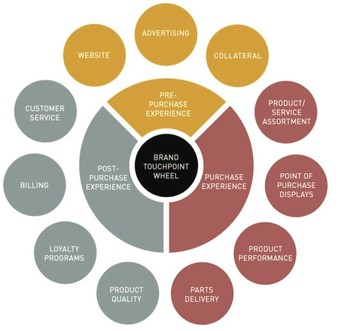
Brand Touch-point Wheel
As a supplement to the various strategies listed above, these touch-points indicate where the tactics of these strategies will come into play. Understanding where the organization will be in direct communication with a prospective consumer is imperative to ensuring messaging is clean, consistent, and clear across the board.
15.7.6: Packaging and Labeling
Packaging refers to the physical appearance of a product when a consumer sees it, and labels are an informative component of packaging.
Learning Objective
Explain the important features of packaging
Key Points
- The role of packaging in marketing has become quite significant as it is one of the ways companies can get consumers to notice products.
- A common use of packaging is marketing. The packaging and labels can be used by marketers to encourage potential buyers to purchase the product.
- Packaging is also used for convenience and information transmission. Packages and labels communicate how to use, transport, recycle, or dispose of the package or product.
- Labels serve to capture the attention of shoppers as well as provide useful information regarding the product.
- Labels are attached on the product package to provide information such as manufacturer of the product, date of manufacture, date of expiry, its ingredients, how to use the product, and its handling.
Key Term
- Packaging
-
Physical appearance of a good prepared for retail sale
Example
- The packaging of perfumes, for instance, attempts to appeal to the sensibilities of its target consumer. For instance, a perfume geared towards younger females may have colorful, feminine packaging, but a perfume for older professional women may have more subdued and sophisticated packaging.
Packaging
With the increased importance placed on self-service marketing, the role of packaging is becoming quite significant. For example, in a typical supermarket a shopper passes about 600 items per minute, or one item every tenth of a second. Thus, the only way to get some consumers to notice the product is through displays, shelf hangers, tear-off coupon blocks, other point-of-purchase devices, and, last but not least, effective packages. Considering the importance placed on the package, it is not surprising that a great deal of research is spent on motivational research, color testing, psychological manipulation, and so forth, in order to ascertain how the majority of consumers will react to a new package. Based on the results of this research, past experience, and the current and anticipated decisions of competitors, the marketer will initially determine the primary role of the package relative to the product. Should it include quality, safety, distinction, affordability, convenience, or aesthetic beauty?

Various Packaging Designs, including labeling
Packaging refers to the physical appearance of a product when a consumer sees it, and labels are an informative component of packaging.
Common uses of packaging include:
- Physical protection: The objects enclosed in the package may require protection from, among other things, mechanical shock, vibration, electrostatic discharge, compression, temperature, etc.
- Information transmission: Packages and labels communicate how to use, transport, recycle, or dispose of the package or product. With pharmaceuticals, food, medical, and chemical products, some types of information are required by governments. Some packages and labels also are used for track and trace purposes.
- Marketing: The packaging and labels can be used by marketers to encourage potential buyers to purchase the product. Package graphic design and physical design have been important and constantly evolving phenomenon for several decades. Marketing communications and graphic design are applied to the surface of the package and (in many cases) the point of sale display, examples of which are shown here:.
- Convenience: Packages can have features that add convenience in distribution, handling, stacking, display, sale, opening, re-closing, use, dispensing, reuse, recycling, and ease of disposal.
- Barrier protection: A barrier from oxygen, water vapor, dust, etc., is often required. Permeation is a critical factor in design. Some packages contain desiccants or oxygen absorbency to help extend shelf life. Modified atmospheres or controlled atmospheres are also maintained in some food packages. Keeping the contents clean, fresh, sterile and safe for the intended shelf life is a primary function.
- Security: Packaging can play an important role in reducing the security risks of shipment. Packages can be made with improved tamper resistance to deter tampering and also can have tamper-evident features to help indicate tampering. Packages can be engineered to help reduce the risks of package pilferage.
Labeling
A label is a carrier of information about the product. The attached label provides customers with information to aid their purchase decision or help improve the experience of using the product. Labels can include:
- Care and use of the product
- Recipes or suggestions
- Ingredients or nutritional information
- Product guarantees
- Manufacturer name and address
- Weight statements
- Sell by date and expiration dates
- Warnings
Symbols Used in Labels
Many types of symbols for package labeling are nationally and internationally standardized. For consumer packaging, symbols exist for product certifications, trademarks, and proof of purchase. Some requirements and symbols exist to communicate aspects of consumer use and safety. For example, the estimated sign notes conformance to EU weights and measures accuracy regulations. Examples of environmental and recycling symbols include the recycling symbol, the resin identification code, and the “green dot.”
Labeling Laws
In some countries, many products, including food and pharmaceuticals, are required by law to contain certain labels such as ingredients, nutritional information, or usage warning information (FDA). For example, a law label is a legally required tag or label on new items describing the fabric and filling regulating the United States mattress, upholstery, and stuffed article industry. The purpose of the law label is to inform the consumer of the hidden contents, or “filling materials” inside bedding & furniture products. Laws requiring these tags were passed in the United States to inform consumers as to whether the stuffed article they were buying contained new or recycled materials. The recycling logo,, needed to be displayed on the label. The Fair Packaging and Labeling Act (FPLA) is a law that applies to labels on many consumer products that states the products identity, the company that manufactures it, and the net quantity of contents.

Labels Indicating Recycled Material
Laws were passed in the United States to inform consumers as to whether the stuffed articles they were buying contained new or recycled materials.
